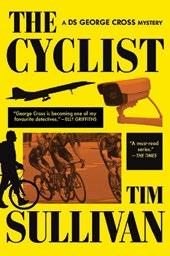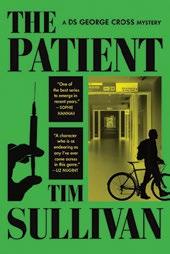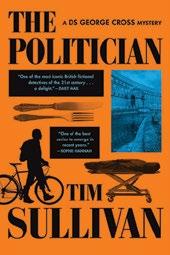FEATURING 284 Industry-First Reviews of Fiction, Nonfiction, Children’s, and YA Books



FEATURING 284 Industry-First Reviews of Fiction, Nonfiction, Children’s, and YA Books


The prolific novelist headlines our special Mystery, Thriller, and Horror Issue

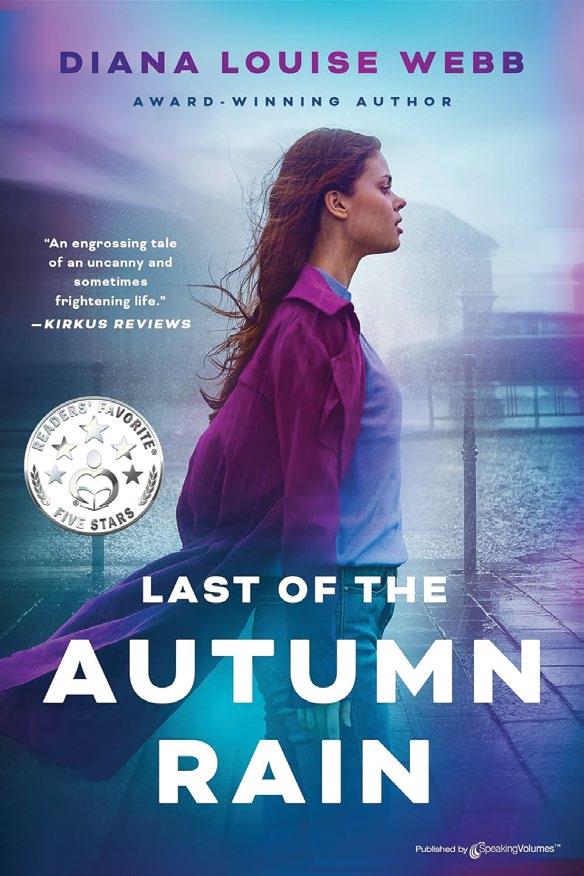



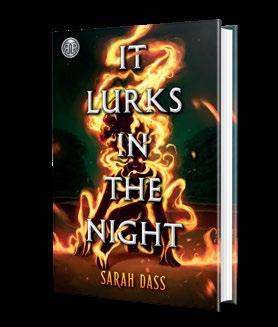

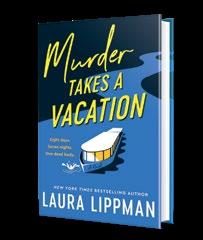
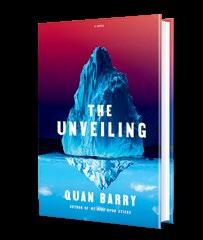
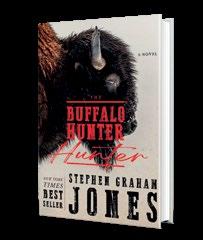
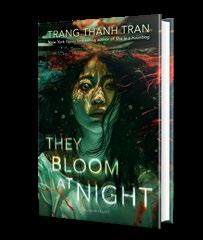
FROM THE EDITOR’S DESK
SOMETIMES YOU HAVE to break out of your comfort zone. For novelist Laura Lippman, whose portrait is on the cover of this Mystery, Thriller, and Horror Issue, that meant putting aside her penchant for dark suspense fiction— she’s best-known for her tough-minded Baltimore PI, Tess Monaghan—and trying something new: a cozy mystery. The result is Murder Takes a Vacation (Morrow/HarperCollins, June 17), which our starred review calls “another gem from Lippman, with a heroine who elevates being ordinary to an art form.”
“I want to pretend this was a conscious act of rebellion in which I write a genre that has been derided by men in my field,” Lippman tells contributor
Connie Ogle in the cover story on page 14. But no. Lippman happened to be watching the film Charade, a delightful 1963 caper in which Audrey Hepburn (in her 30s) encounters Cary Grant (almost 60) in the Swiss Alps, then sets off with him to solve the murder of her husband, flirting all the while. Lippman wanted to try a lighthearted story with an older woman and a younger man—and thus she sent Mrs. Blossom (Monaghan’s assistant) on a Seine River cruise where she encounters not one, but two, mystery men. And one of them ends up dead.
Think writing a cozy mystery is a breeze? Lippman did. “The joke was one me,” she says. “It was the hardest book I’ve ever written in my life.” And yet: She’s already
Frequently Asked Questions: www.kirkusreviews.com/about/faq
Fully Booked Podcast: www.kirkusreviews.com/podcast/
Advertising Opportunities: www.kirkusreviews.com/book-marketing
Submission Guidelines: www.kirkusreviews.com/about/publisher-submission-guidelines
Subscriptions: www.kirkusreviews.com/magazine/subscription
Newsletters: www.kirkusreviews.com
For customer service or subscription questions, please call 1-800-316-9361
at work on a second Mrs. Blossom book, set at a posh resort in Tuscany.
As with writers, readers may find it useful to break out of their comfort zones, too. I haven’t read horror fiction since Stephen King’s Cujo scared the devil out of me at age 15, but in preparing this special issue, I’ve decided (gulp) that it’s time to try again. What better place to start than Quan Barry’s The Unveiling (Grove, October 14), which sends a Black film location scout on an Antarctic cruise with a bunch of privileged white tourists—and then strands a small group of them on a remote island as reality becomes increasingly warped. Our starred review calls it a “terrifying mustread set at the ends of the Earth.” I can handle that—right?
An author I’ve long been curious about—but quietly passed over because of the fear factor—is Stephen Graham Jones. Jones’ latest is The Buffalo Hunter Hunter (Saga/Simon & Schuster, March 18), what our reviewer calls an “ambitious, centuries-
spanning American gothic”—essentially a “vampire Western” that involves an actual historical event, the Marias Massacre of 1870, in which 200 Indigenous people were killed by U.S. Army forces. Our starred review dubs it “a weirdly satisfying and bloody reckoning with some of America’s most shameful history.”
In the interview on page 132, Trang Thanh Tran, author of the YA novel They Bloom at Night (Bloomsbury, March 4), tells contributor Ilana Bensussen Epstein that reading and writing horror fiction paradoxically gives her comfort. “I have a lot of bad scenarios in my mind, so being able to write them out is a form of catharsis for me.… You visit these horrors, and then you get to leave.” I can see the point—but I’m still avoiding Saint Bernards.

Co-Chairman
HERBERT SIMON
Interim Publisher & CEO
JUDY HOTTENSEN jhottensen@kirkus.com
Chief Marketing Officer
SARAH KALINA skalina@kirkus.com
Publisher Advertising & Promotions
RACHEL WEASE rwease@kirkus.com
Indie Advertising & Promotions
AMY BAIRD abaird@kirkus.com
Author Consultant
KEELIN FERDINANDSEN kferdinandsen@kirkus.com
Lead Designer KY NOVAK knovak@kirkus.com
Magazine Compositor
NIKKI RICHARDSON nrichardson@kirkus.com
Director of Kirkus Editorial ROBIN O’DELL rodell@kirkus.com
Kirkus Editorial Senior Production Editor
MARINNA CASTILLEJA mcastilleja@kirkus.com
Kirkus Editorial Production Editor
ASHLEY LITTLE alittle@kirkus.com
Copy Editors
ELIZABETH J. ASBORNO
JAIMIE KANWAR
NANCY MANDEL
BILL SIEVER
KENNETH WALSH
Mysteries Editor
THOMAS LEITCH
Co-Chairman
MARC WINKELMAN
Editor-in-Chief
TOM BEER tbeer@kirkus.com
President of Kirkus Indie
CHAYA SCHECHNER cschechner@kirkus.com
Fiction Editor
LAURIE MUCHNICK lmuchnick@kirkus.com
Nonfiction Editor
JOHN McMURTRIE jmcmurtrie@kirkus.com
Young Readers’ Editor
LAURA SIMEON lsimeon@kirkus.com
Young Readers’ Editor
MAHNAZ DAR mdar@kirkus.com
Editor at Large MEGAN LABRISE mlabrise@kirkus.com
Senior Indie Editor DAVID RAPP drapp@kirkus.com
Indie Editor ARTHUR SMITH asmith@kirkus.com
Senior Editorial Assistant NINA PALATTELLA npalattella@kirkus.com
Senior Indie
Editorial Assistant
DAN NOLAN dnolan@kirkus.com
Indie Editorial Assistant
KATARINA YERGER kyerger@kirkus.com
Contributing Writers
GREGORY McNAMEE
MICHAEL SCHAUB

Contributors
Colleen Abel, Jill Adams, Reina Luz Alegre, Paul Allen, Jenny Arch, Kent Armstrong, Mark Athitakis, Kit Ballenger, Audrey Barbakoff, Nell Beram, Elizabeth Bird, Ariel Birdoff, Christopher A. Biss-Brown, Nastassian Brandon, Jessica Hoptay Brown, Cliff Burke, Abby Bussen, Kevin Canfield, Charles Cassady, Alec B. Chunn, Carin Clevidence, K.W. Colyard, Rachael Conrad, Adeisa Cooper, Katherine Daly, Whitney Danhauer, Cathy DeCampli, Dave DeChristopher, Elise DeGuiseppi, Amanda Diehl, Steve Donoghue, Anna Drake, Eamon Drumm, Robert Duxbury, Jacob Edwards, Lisa Elliott, Tanya Enberg, Chelsea Ennen, Ilana Bensussen Epstein, Makana Eyre, Rosalind Faires, Joshua Farrington, Brooke Faulkner, Margherita Ferrante, Katie Flanagan, Catherine Foster, Jenna Friebel, Jackie Friedland, Jackie Garcia, Laurel Gardner, Amanda Gefter, Melinda Greenblatt, Tobi Haberstroh, Dakota Hall, Zoe Holland, Ashley Holloway, Terry Hong, Julie Hubble, Kathleen T. Isaacs, Darlene Ivy, Wesley Jacques, Jessica Jernigan, Danielle Jones, Betsy Judkins, Jayashree Kamblé, Lavanya Karthik, Colleen King, Stephanie Klose, Lyneea Kmail, Jennie Knuppel, Andrea Kreidler, Susan Kusel, Alexis Lacman, Megan Dowd Lambert, Chelsea Langford, Christopher Lassen, Tom Lavoie, Seth Lerer, Elsbeth Lindner, Coeur de Lion, Sarah Lohmann, Patricia Lothrop, Wendy Lukehart, Dylan Mabe, Michael Magras, Joan Malewitz, Gabriela Martins, Zoe McLaughlin, Cari Meister, J. Elizabeth Mills, Chintan Modi, Clayton Moore, Rebecca Moore, Andrea Moran, Christopher Navratil, Randall Nichols, Ari Nussbaum, Katrina Nye, Tori Ann Ogawa, Hannah Onstad, Mike Oppenheim, Emilia Packard, Nina Palattella, Bethanne Patrick, Deb Paulson, Tara Peck, Alea Perez, Rebecca Perry, John Edward Peters, Jim Piechota, Shira Pilarski, Kathy Price-Robinson, Margaret Quamme, Carolyn Quimby, Kristy Raffensberger, Kristen Bonardi Rapp, Jasmine Riel, Erica Rivera, Amy Robinson, Lloyd Sachs, Bob Sanchez, Caitlin Savage, Meredith Schorr, Will Schube, Sadaf Siddique, Linda Simon, Wendy Smith, Margot E. Spangenberg, Andria Spencer, Allison Staley, Sydney Stensland, Allie Stevens, Mathangi Subramanian, Jennifer Sweeney, Desiree Thomas, Renee Ting, Jenna Varden, Francesca Vultaggio, Barbara Ward, Vanessa Willoughby, Paul Wilner, Kerry Winfrey, Marion Winik, Bean Yogi, Jean-Louise Zancanella, Natalie Zutter

I BELIEVE IN starting a series—of whatever genre— at the beginning, the better to catch all the nuances. It’s wonderful, of course, to pick up one that’s been going on for years, knowing that if you like it, you’ve got a huge stack of books ready to enjoy. But there’s something extra exciting about falling in love with a brand new series and having no choice but to wait eagerly for the author to write and publish the next book, no matter how long it takes.
With The Dentist (Atlantic Crime, October 21), you’ll get the best of both worlds: Hopping on a new series right at the beginning, with the knowledge that there are more installments to come very soon. British author Tim Sullivan has written eight novels about Detective Sergeant George Cross, a white Bristol cop who’s on the autism spectrum, and his partner, DS Josie Ottey, a Black single mother, but they’ve never been published in the U.S. before. Now Atlantic Crime will now release all his books to date through the middle of 2026. Our review says that “Sullivan’s series kickoff is deeply character-driven and
moves both deliberately and briskly through the steps of the case.…a multifaceted murder puzzle anchored by a compelling pair of sleuths.”
Sherry Thomas, known for her exquisitely nuanced romance novels and Lady Sherlock series of historical mysteries, makes a splash with her first contemporary crime novel, The Librarians (Berkley, September 30). Hazel Lee has moved to Austin, Texas, from Singapore to escape her husband’s shady financial dealings. Just days after starting her new job at a local library, though, two patrons are found dead, and she finds herself bonding with her new colleagues as they try to solve the murders. “This knockout mystery mixes the camaraderie of The Thursday Murder Club with the chic family and romantic drama of Crazy Rich Asians,” according to our starred review.
For more of that Thursday Murder Club atmosphere, how about a new series that’s set in a retirement community? In Tamara Berry’s Murder Runs in the Family (Poisoned Pen, April 29), a young woman named Amber Winslow is out of
places to go—so she decides to take a chance on the grandmother she’s never met, hoping she won’t turn out to be as bad as her mother always said. When Amber arrives at Arizona’s Seven Ponds Retirement Community, she discovers that grandma is a true-crime podcaster— and you can guess what happens next. “Despite Berry’s breezy tone and drop-dead-funny japes at Seven Ponds and its eccentric residents and staff, she tells a heartrending tale of how complicated families can be,” according to our starred review. “A knockout series debut.”
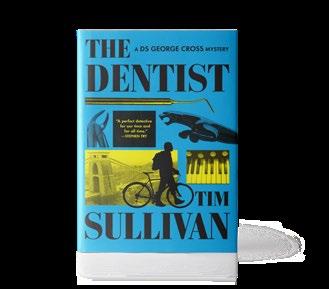

The last series I fell in with at the beginning was Elise Bryant’s tale of suburban single mother Mavis Miller, who finds danger at the PTA and on the sidelines of her daughter’s soccer games. Her second outing, The Game Is Afoot (Berkley, July 8), shows that “this is a series with legs,” according to our starred review. “Mavis’ witty… narration lends a solid sense of stakes to the multifaceted plot’s assorted mysteries, and her burgeoning love triangle injects a fizz of romantic tension.” I can hardly wait for the next installment.
Laurie Muchnick is the fiction editor.

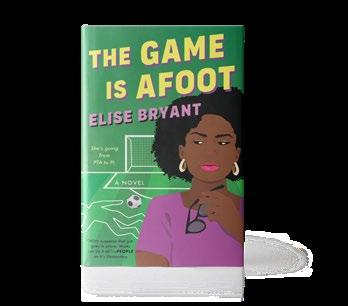
A book burning leads to murder in this comedic mystery.
Sandlin set his cultfavorite novel Skipped Parts (1991) in fictional GroVont, Wyoming, and he returns to the small town in his latest novel. This one opens with Kasey Cobb, a 49-year-old man who owns a coffee kiosk called the River Runs Through It Espresso Shack (one of many literary references in the novel), coming across a book bonfire in front of the local library. The son of the pastor responsible for the book burning tries to shove Kasey into the fire, but he’s saved by Judge Joubert, a delusional local novelist with an ego the size of
Grand Teton. (The son isn’t as lucky, falling into the fire himself.) Kasey and Judge book it to Kasey’s cabin, where they learn that Judge’s house, containing his latest manuscript, has been burned down; not long after, the firebug pastor is found dead near the remains of Judge’s house, a copy of Toni Morrison’s Song of Solomon beside him. Judge becomes a suspect, as do Kasey and Darla, the librarian on whom he’s nursing a crush. Sandlin is no stranger to oddball characters, and there are a ton of them here; he doesn’t engage in mockery of any of them except the book banners whom he clearly loathes. (“Anyone who reads a book
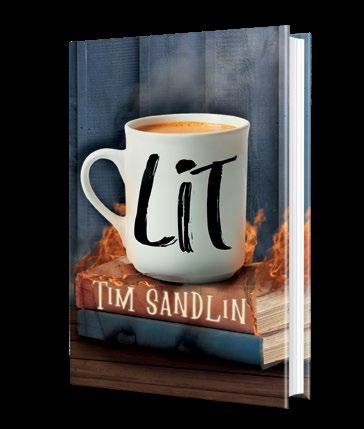
is better than anyone who doesn’t,” Kasey opines.)
The book can feel a bit heavy-handed, but Sandlin isn’t going for delicate satire here, just wacky fun. And his humor remains intact: At one point, Kasey reflects that his two
employees “give me the comatose stepfather treatment most of the time.” Mystery fans with a love of the quirky will find much to enjoy here. Think Kinky Friedman, if he lived in northwestern Wyoming.
The author’s knowledge of all things royal adds texture to this fun debut.
THE HEIR APPARENT
Kirkus Star
Alonge, Giaime | Trans. by Clarissa Botsford Europa Editions (416 pp.) | $19 paper August 5, 2025 | 9798889661283
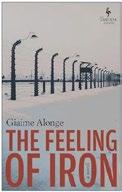
Nearly 40 years after having been tortured in a German prisoner of war camp, two Jewish survivors pursue the SS officer responsible for their torment.
Shlomo Libowitz, a Polish native now living in Israel, and Anton Epstein, a Czech doctor, were victimized as young men in a converted castle in East Prussia, where Maj. Hans Lichtblau, a leading Nazi scientist, conducted gruesome medical experiments on children and adults alike. Born to German immigrants in Chicago, Lichtblau offhandedly compares the screams coming from the death chamber to noises coming from meatpacking plants in the Windy City. Flash forward to the early 1980s when Libowitz and Epstein, with the financial backing of an international coalition of Jewish businessmen, team up (awkwardly) with a young female KGB agent to track down and assassinate Lichtblau. Lichtblau turns out to have been captured in Italy in 1945 by partisan forces and turned over to the British, only to be drafted by the U.S. Department of Defense along with other Nazi scientists. Now going by Victor Huberman, he’s a CIA operative in Honduras who’s running guns and dealing cocaine with the Contras— when not hanging out in the U.S. with celebrities including Timothy Leary. Lichtblau/Huberman knows all about
LSD, having produced it for Himmler as a miracle drug that supposedly would enable German soldiers to fight the encroaching Red Army for days on end without tiring. With its dispassionate tone and unhurried approach, the novel takes a while to sink in. But Alonge’s detailed efforts to trace the gradual development of the Nazis’ “final solution” are chilling. And as Libowitz and Epstein close in on their target, the novel gains speed and page-turning intensity, with a crushing irony that casts new light on the revenge motive. A powerful Holocaust novel that goes to unexpected places.
Armitage, Rebecca | Cardinal (416 pp.) $29 | December 2, 2025 | 9781538776308
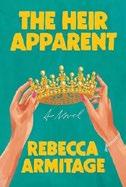
A British princess who’s stepped away from her royal role finds herself suddenly next in line for the throne.
As Armitage’s debut opens, Lexi Villiers is a medical resident in Australia, estranged from her family since she slipped away several years earlier to pursue a career. She’s been living on the grounds of a beautiful Tasmanian vineyard owned by the family of a man she is about to become more than best friends with—when a helicopter touches down to tell her that her father, the heir to the throne, along with her twin brother and his best friend have been killed by an avalanche while skiing. She’s whisked back to Britain at the behest of her grandmother the queen, landing instantly in the hornet’s nest of tabloid coverage, family secrets and
resentments, and implacable protocol that is royal life. Will she accept her role as the heir apparent or let the crown pass to her scheming, power-hungry uncle?
The queen gives her a year to decide. While her decampment to Australia left her with a very low approval rating from the British public, her reinvolvement in public life wins favor, engineered with the help of a savvy assistant. Though she feels the call of duty, it’s lonely at the top—her bereaved sister-in-law, once a close friend, is angry about her defection; a handsome aristocrat who might make a suitable mate doesn’t hold a candle to the man she left behind. Fortunately, she has a very nice dog. To the author’s credit, the suspense of the decision lasts right up until the final pages, though one of the main issues creating all the drama—the circumstances of her mother’s drowning when Lexi and her brother were not yet 18 and on vacation with her in Italy, slowly revealed in sections set in the past—never quite makes sense. The author’s deep knowledge of all things royal adds realism and texture to this entertaining debut.
Bak, Sulmi | Mulholland Books/ Little, Brown (160 pp.) | $27 November 11, 2025 | 9780316594486
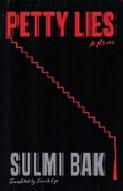
A young tutor seeking to avenge the death of her mother and brother gets drawn into a web of treachery and betrayal. Mira can neither forget nor forgive the Moon family and its cruelties. Both pushed her impoverished mother to open the gas in her apartment, dying by suicide and killing her son, leaving Mira utterly alone. So, when she finagles a job tutoring Yujae, the youngest Moon son, she finds herself well-positioned to seek revenge. Her role allows access to Yujae’s elder brother, Yuchan, whom she believes killed her mother’s dog and started the chain reaction that led to the vicious confrontation with
Moon Jiwon that precipitated her mother’s suicide. Mira’s plan seems perfect. But as Bak reveals in an epistolary-style narrative that shifts among three people—Mira, Jiwon, and Yujae—the reality behind what Mira thinks she knows about the Moon family is far more complicated than it appears. Motivations are often cloaked in lies and/or cruelty; when characters are not engaging in some form of deceit, they are undermining each other. Mira, for example, lies that she seeks only to tutor Yujae while Yujae falsely tells everyone—except Mira—that his brother is a dog-killer. But as animal and human deaths pile up, the reader becomes privy to a chilling story involving sibling rivalry, maternal callousness, and vengeance exacted without regret. Bak skillfully weaves the themes of guilt, family, and retribution to create a psychologically potent story that is at once compelling and profoundly disturbing. A provocative thriller that probes the dark side of the human heart.
Black, Cara | Soho Crime (320 pp.) | $29.95 December 2, 2025 | 9781641294492
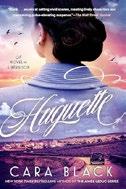
A brave young woman navigates the dangers of postwar France. The Libération brings nothing resembling freedom to Huguette Faure. First, she gives birth to a baby boy conceived in an encounter that was anything but consensual. When the nuns rip the newborn from her side and sell him to a wealthy couple, she flees to Paris, where she’s hunted by vigilantes who consider her a collaborator. Her father is murdered, but instead of seeking his killer, the police try to arrest her. She lives by her wits, engaging in one shady enterprise after another, always pursued—by American soldiers, French patriots, and even the criminals with whom she freely associates. Like Kate
Rees, heroine of Three Hours in Paris (2020) and Night Flight to Paris (2023), which are set in wartime France, Huguette is crafty enough to evade danger repeatedly. But as in Black’s stand-alones, the pace is punishing. The few times Huguette enjoys some measure of safety pass in the blink of an eye. In August 1945, she flees Paris, believing she’s been betrayed. When she next appears two years later, she’s somehow become a successful director at a film studio in Lyon. By the end of this chapter, she’s on the run again, this time headed to a war tribunal in Frankfurt. It seems as if Black has invented her with the sole purpose of testing her mettle over and over. The only saving grace is that Huguette’s tale also introduces the reader to Det. Claude Leduc, future grandfather of franchise sleuth Aimée Leduc. He can’t return soon enough. Exhausting.
Boon, Louis Paul | Trans. by Adrienne Dixon Dalkey Archive (340 pp.) | $17.95 paper October 21, 2025 | 9781628975192
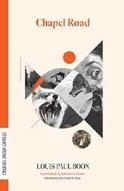
A pioneering work of metafiction by a little-known but masterful Belgian writer. Begun in German-occupied Belgium in 1943, this multilayered story by Boon (1912–1979) was first published 10 years later—but in any event, surely before its time. It’s set in a backwater town in a backwater part of Flanders, not especially far from Brussels but far enough away for the capital to be a kind of dreamland, a place to which only an adventurous few villagers escape. One is ondine (Boon’s proper nouns are lowercased), introduced at the start of the novel, whose narrator promises that it will concern not just that blond-ringleted 19th-century social climber but also her wayward brother valeer, “with his monstrous head wobbling through life this way and that,” who manages to
infuriate ondine for a cardinal sin: “in his tiredness and shabbiness he looked happy.” Ondine is the Candide of the tale, if Voltaire were Céline and ondine lived in the worst of all possible worlds: She steals from the chapel’s offertory box, affects saintliness (“She couldn’t bear it that anyone was holier than she”), despises her working-class but aspirational father and his illiterate fellow millworkers, and tries not to realize that “the root of her wretchedness…was her own nature.” Atop and throughout all this, Boon layers a satirical history of European politics and its “nazi, marxist and encyclicalist regimes,” weaves in a lively retelling of the medieval tale of the randy and larcenous reynard the fox, and plays with the conceit that this is a novel within a novel that’s certainly no holiday in Bruges to read: “who the devil almighty can make sense of this book? Nobody, except me, boon, and maybe I’m only pretending to myself that I can.” And that’s just so.
A perplexing but intriguing addition to the library of proto-postmodernism.
Bunn, Cullen | Gallery Books/Simon & Schuster (352 pp.) | $19 paper November 11, 2025 | 9781668065273
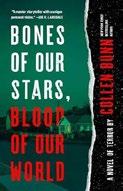
A serial killer—or maybe something else —stalks the denizens of an isolated community on an island off North Carolina. Bunn is one of the most prolific comics writers around, but while he’s only dabbled in fiction, he’s no stranger to horrible things. Drawing on pulpy imagery and influences ranging from H.P. Lovecraft’s Cthulhu Mythos to Stranger Things, his first adult novel drives a touristy town in the American South to the brink of madness. There’s a formula at work here but readers who have spent time in towns like Castle
Rock or Derry will be plenty comfortable with it. Wilson Island is a prototypically wholesome, touristy town populated by good hardworking folks (read: a whole bunch of victims) and a few bad apples. Among the sizable cast, we meet knocked-up teenager Willa Hanson, who’s hiding her pickle from her father, Wade, a small-town gangster. There’s also hard-nosed Sheriff Bartholomew Buckner; plucky reporter Rachel Lang; Madhouse Quinn, the local nutcase; and Denny Danvers, a sword-wielding Dungeons & Dragons legend and weed dealer with a heart of gold. More importantly, Bunn follows along as a serial killer begins butchering the townsfolk at the behest of his mother, all while wearing some kind of bone-based mask and babbling about his “harvest.” The first half reads closer to psychological horror before the killer is, to our surprise, revealed completely. Only then does the book take a giant left turn into a much bigger, weirder, and hard-to-explain story. The threat veers toward the vague, nameless “dark forces” common to this flavor of horror, but what follows is vicious, graphic, and largely nonsensical—closer to John Carpenter’s The Thing than any procedural investigation. By the end, the gory set pieces and lurid imagery are carrying more weight than the plot, but readers of Grady Hendrix, Paul Tremblay, or Stephen Graham Jones will find themselves right at home. A grotesque apocalyptic fantasy that can’t quite shoulder its own cosmic weight.

Butler, Robert Olen | TCU Press (252 pp.)
$25.95 | October 31, 2025 | 9780875659381
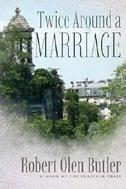
A married couple revisits their best and worst moments while under lockdown. This literary pas de deux from the veteran author and Pulitzer winner Butler is ostensibly set in Paris in 2020. That’s where novelist Amanda Duval and literary scholar Howard Blevins had hoped to revisit the places they first met in 1968—before they married, divorced, and remarried back in the U.S. But with Covid forcing everyone indoors, the novel largely takes place in their rented apartment, and more precisely in their memories. To pass the time, they encourage each other to write and share stories about their courtship, split, and reconciliation. Litigating the past is fraught for the two—an infidelity, acknowledged but not discussed in detail, prompted their divorce—but Butler’s goal is more subtle than staging he-said-she-said debates. Rather, by having them write out their recollections, Butler plays with their distinct styles—Amanda more literary, Howard more bluntly factual—to show that while a couple might agree on the facts, their meaning and the intensity of feelings they evoke can differ substantially. There are silly moments that feel forced, like Howard’s tryst with a fellow modernist scholar determined to precisely reenact the closing pages of Ulysses, but Butler’s approach is generally sober, built on less explosive vignettes about the couple’s past romances and relationship with their daughter. While the overall mood is generally tender and affectionate—the two are in their 70s and disinclined to fly solo again—Butler
also adds enough tension to suggest that a marriage involves navigating and reconciling a lot of miscommunication, regardless of the couple’s stage in life. A tender yet spiky study of a long marriage, broken but enduring.
Carlsson, Christoffer | Trans. by Rachel Willson-Broyles | Hogarth (432 pp.) | $29 December 2, 2025 | 9780593733059
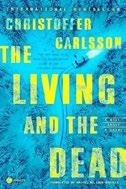
The related murders of two teenagers following a pre-Christmas, pre-millennium party shakes up a southwestern Swedish town where the aftershocks are still felt 20 years later. The first victim is 18-year-old Mikael Söderström, a rich kid who abused a female classmate; he gets his head bashed in. Another partygoer, Killian Persson, is subsequently found dead in the crashed, fire-consumed car of a neighbor. Killian’s gloomy best friend, Sander Eriksson, who can’t wait to get out of tiny Skavböke to study law in Stockholm, thinks he caused Killian’s death by saying mean things to him after catching him in flagrante with Sander’s crush, Felicia Grenberg. In a closed-in community where adulterous couplings have led to animosities (“the whole village saw its own reflection in a dark pool”), the town’s sole cop, Gerd Pettersson, and her imported young backup, Siri Bengtsson, have their work cut out for them limiting suspects. A massive landslide caused by the detonation of dynamite in the Söderströms’ basement intensifies their efforts. Twenty years later, when the now-retired Siri is making cabinets for a living, there’s another related murder with grave repercussions. Stolid police officer Vidar Jörgenssen can only hope he will succeed where his predecessors failed in digging up the truth. With all the book’s twists, turns, and delayed reveals, the reader
may be grateful for the opening list of characters. As with Carlsson’s excellent previous efforts, including Blaze Me a Sun (2023), this “novel about a crime” goes beyond clever plotting to examine Swedish identity, life in a new era, and the ties between living and dying: “There was no end, and it was impossible for anyone or anything to cease to exist one day, to be erased from this life.” Carlsson’s reliance on a familiar trope is initially disappointing, but the book’s deep, daring complexity brushes that concern aside. Brooding and brilliant.
Champine, Justine | Dial Press (256 pp.)
$29.99 | December 2, 2025 | 9780593447239

A woman who grew up in a tiny Washington state logging town recounts the disturbing events of the year after her slightly older cousin came to stay. Fourteen-year-old Ida lives with her mother, Anne, over their convenience store in isolated Mineral, Washington. Not only is Ida different from other teenagers—for example, she’s obsessed with maps and flags—but she’s got a heart condition that prohibits her from physical activity. Still, she has her geography flash cards and occasional early-morning swims at the lake, as well as some dreams of her own that she shares with no one, including her attraction to other girls. But when Anne’s troubled sister, Candace, enters rehab again, Anne agrees to let Candace’s daughter, 17-year-old Elna, stay with them. Elna has clothes, jewelry, and cosmetics that intrigue Ida, as well as daring behaviors, like bumming a smoke from some of the loggers Anne takes in as boarders. While there’s plenty of plot once Elna starts manipulating and deceiving everyone around her, the heart of this coming-of-age novel beats in Champine’s careful and thorough depiction of a girl on the spectrum who
also has great, yet misunderstood, academic gifts. “The only part of school I didn’t hate was my time in the library,” Ida says. However, Ida’s late-developing social skills make her easy prey for Elna’s schemes, like searching a boarder’s room for his stash of pills. Unfortunately for Ida, who can’t tear herself away from Elna’s daring behavior, each action leads to another. Readers might predict the climax, but it doesn’t matter. The point is that Ida finds her way forward, sharing a happy, stable future that doesn’t always occur for people on the spectrum. A standout; authentic voice and gritty detail give this novel power.
Cousens, Sophie | Putnam (352 pp.) | $18.99 paper | November 18, 2025 | 9780593718926
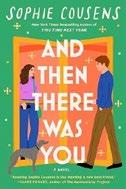
Desperate to impress her classmates at their college reunion, a woman brings a robot boyfriend as her plus-one. Chloe Fairway feels like things couldn’t get worse. At 31, she’s living with her parents in the London suburbs, working as an assistant rather than a screenwriter, and stuck in the dating trenches. But then an old colleague recommends a mysterious dating service called Perfect Partners. Chloe figures it can’t hurt to try, so she books an appointment and is set up with Rob Dempsey, a gorgeous man who seems ideal. He’s kind, courteous, and can quote Brideshead Revisited , her favorite book, from memory. But then she finds out the truth—Rob is a “state-ofthe-art AI humanoid robot. An android. Physically, practically indistinguishable from a real person.” He’s been crafted to meet the exact specifications Chloe detailed in her 42-page questionnaire, the one where she said her ideal men were Fitzwilliam Darcy, Anthony Bridgerton, and Friedrich Bhaer, all men who are,
notably, fictional. Chloe could never date a robot—that is, until she thinks about attending her college reunion in Oxford solo. Everyone else has an important career, like her old friend Sean Adler, now a big-time Hollywood director. Chloe resolves to bring Rob to her reunion and introduce him as her boyfriend, impressing all her Oxford friends (and, most importantly, Sean). Rob is the perfect partner, but as the weekend rolls on and she reconnects with people from her past, Chloe begins to wonder if perfection is all it’s cracked up to be. Cousens takes a truly bonkers premise and imbues it with the warmth and humor she’s known for in her romantic comedies. The idea of an AI boyfriend feels scarily real, but Cousens manages to keep things light even while examining what it means for humans to find deep connections with robots instead of each other. Rob is a character who elicits both sympathy and laughs, and the romantic plotline is surprising enough to keep things interesting. A science-fiction twist on romance that brings a whole lot of heart and humanity.
Grant, Tanya | Berkley (368 pp.) | $19 paper November 18, 2025 | 9780593954041
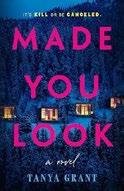
In this debut thriller, a Catskills getaway goes fatally wrong. A trio of social media influencers, their talent manager, a photographer, and a “style tastemaker” are off on a four-day photo-op and “in-person strategy session” at a Catskills retreat; one of the influencers calls the destination “a super-exclusive vacation rental where you get all the amenities of a hotel but with the privacy of being in your own space.” The amenities are swell, but what the group doesn’t bargain for is a snowstorm severe enough to strand them and, worse, knock out the Wi-Fi, and they couldn’t have foreseen that there would be
no emergency landline. Also not anticipated are the weird things that start happening soon after the group arrives: One of the influencers can’t find the drone he swears he packed, a gunshot rings out while everyone is headed to a photo shoot by a waterfall, and so on. It isn’t until practically the book’s halfway mark that one of the characters dies (it’s not from natural causes); by this point, readers may have been finding themselves not wishing anyone dead but hoping that at least one of the looks-obsessed, self-absorbed influencers would fall into a snowdrift. Fortunately, the photographer, who is best friends with one influencer and splits narrative duties with another, is a reliably levelheaded audience surrogate (“What’s the point of beauty if everything else is falling apart?”). Grant is a spry writer, and her book’s gangbusters last hundred-odd pages justify the seemingly discursive but, it turns out, carefully calibrated scenes leading up to the denouement. Given how things shake down, readers who chide people who live their lives on social media may end up thinking twice. An avalanche of suspense once things get rolling.
Greene, Matt | Henry Holt (176 pp.) | $17.99 paper | December 2, 2025 | 9781250399342
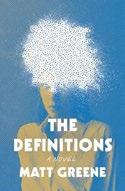
A group of patients at an isolated rehabilitation center work to recover language and memory after having had them wiped out by a mysterious virus. At the beginning of Greene’s slim novel, the nameless protagonist has passed through a required period of quarantine and is taking medications to counteract the effects of a virus that neurologically ravages its hosts. The narrator—telling events retrospectively from a future readers are eager to see arrive—is a resident of what is called only “the Center” and doesn’t remember anything about the past. The goal is that the residents will eventually, through a regime of instruction and socialization,
“graduate” and re-acclimate to an outside world they are assured exists. Given names from “cartridges” they watch of old sitcoms (there are numerous patients called “Joey” and “Chandler”), the residents take courses like “Grammar,” “Politeness,” “The History of the Twenty-first Century: A Story of Progress,” and “Art.” But how can they relearn humanity and society without the benefit of a narrative on which to draw? It is this notion around which Greene forms the book’s core. “It had been explained to us in Orientation: the world was a hand and language was a glove,” notes the protagonist. But what happens when the glove does not fit—and when the world has shrunk to the size of a fenced-in facility? Greene’s novel belongs to a lyrical tradition in the vein of Never Let Me Go, but eschews typical worldbuilding or backstory. These gaps create an eerie effect, but they allow for characters who themselves are blank slates of identity and meaning, while focusing less on plot than on moments of symbolic power that show how language shapes us, our relationships, and our sense of the world. An elliptical and unsettling entry into the canon of contemporary dystopias.
Handke, Peter | Trans. by Krishna Winston Farrar, Straus and Giroux (176 pp.) | $26 December 2, 2025 | 9780374616151

The Austrian novelist returns with a characteristically enigmatic story. Gregor Werfer— we learn his first name a couple of dozen pages in, his last only near the end of Handke’s latest—is a
cipher who has been “living and working for ages—his own—on another continent, or, as he called it, ‘part of the world.’” Just what he does there is something of a mystery, but there are plenty of clues that link him to the literary wanderer of old, Odysseus, “who from a young age had been obsessed with the unknown, the foreign, especially with experiences he could have all by himself, on his own.” Rather than fend off Circe or battle Polyphemus, however, Gregor has a more mundane task to perform: He’s returned to his family farm, a once-quiet place now being swallowed up by an encroaching city, the nearby chapel “surrounded by office towers, some of which grazed the sky.” There Gregor is supposed to take on the role of godfather at his infant nephew’s baptism, but beforehand he has to wrestle with the odd dynamics of his kin—and with the terrible news that his much younger brother has been killed while serving in the French Foreign Legion. Given that “it was an unspoken rule in the family, going back generations, that no questions were to be asked,” Gregor is in no hurry to get home and finds plenty of reason to hang out in local bars and hotels, albeit with a kind of Meursaultian indifference to his surroundings and fellow humans. Handke moves slowly, deliberately through the proceedings, occasionally taking potshots at the “couch potatoes, nook- andcranny crouchers, shithouse stowaways, idiot-box starers,” and other manifestations of modern life. It’s not his most memorable work, but it’s still of some interest to the neoexistentialists in the audience. Nothing much happens in these pages, though Handke fans will admire the moody atmospherics.
Handke fans will admire the moody atmospherics.
THE BALLAD OF THE LAST GUEST
Harrison, Rachel | Berkley (332 pp.) | $30 September 9, 2025 | 9780593642573
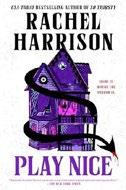
Harrison turns her attention from vampires and werewolves to the ghosts of childhood trauma.
Stylist and fashion influencer Clio Barnes has been estranged from her mother for years, as have her sisters. When their mother dies, she leaves her house to Leda, Daphne, and Clio. The elder two want nothing to do with the house, but Clio has visions of renovating the place, turning her DIY into content, and flipping it for a profit. One more detail: The house is possessed by a demon. In So Thirsty (2024), Harrison wrote a book about vampires that was also a novel about best friends trying to figure out what to do with their lives. Here, Harrison mines the potential of the haunted house to excavate the abuse that Clio and her sisters suffered as children. Clio is a terrific protagonist. She’s sharp and funny and a little less self-aware than she thinks she is. As she tries to reconcile her own memories with those of her family—including her mother, who left behind an annotated copy of the book she wrote about living in a demon-plagued split-level in the suburbs—and questions her own sense of reality, Clio unravels. But it’s a necessary unraveling, the kind of annihilation that makes real change possible. This novel delivers truly chilly scenes while also exploring the emotional depths that make horror meaningful. There’s a climactic scene at a family barbecue where Clio sees echoes of her mother in herself, Leda, and Daphne and thinks, “Her ghost is us.” There are many emotionally devastating moments in this novel, but this one captures the essence of them all. Harrison knows that we are, all of us, haunted. Harrison has earned a place among a vanguard of women reinventing horror that includes Mona Awad and Julia Armfield.
Hassan, Aisha | Scout Press/ Simon & Schuster (368 pp.) | $29 December 2, 2025 | 9781668043288
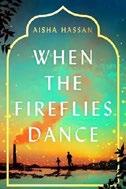
A young man plots his family’s escape from slavery in modern Pakistan.
Hassan’s debut novel centers on Lalloo, a young man living in the outskirts of Lahore.
When he was 7, his older brother, Jugnu, was killed under mysterious circumstances on the grounds of the bhatti, or labor camp, where his family made bricks to work off an insurmountable debt. To earn money for the family and escape the bhatti’s degradations, he was soon sent to work at a garage; now in his 20s, he works as a driver for a wealthy family. Lalloo’s lifelong determination to get his family out of the bhatti accelerates when his father falls ill and his sister is engaged, prompting a need for more money. The plot of the novel turns on Lalloo’s ill-fated attempts to secure funds, ranging from begging to blackmail to outright theft. In the process, he exposes the corruption of the system he’s been trapped into. Hassan, a playwright, poet, and Lahore native, has a gift for lyricism and metaphor, particularly around the fireflies of the title, symbols of a freedom that seems remote to the point of otherworldliness. But she’s also careful not to sugarcoat a narrative that uses various euphemisms—“peshgi,” “indenture”—to rationalize slavery. (One early scene has Lalloo literally mired in muck and sewage.) This is all embedded in a dense but speedy plot as Lalloo schemes for cash, explores the circumstances of Jugnu’s murder, and negotiates a budding romance with a childhood friend. Some plot twists defy believability, and some characters deliver cardboard dialogue, but throughout, Hassan cannily reveals the ways that a broken financial and caste system in “an upside-down world” thrusts its poorest people into making rash decisions.
A socially savvy study of caste and its abuses.
Infante, Catalina | Trans. by Michelle Mirabella | World Editions (118 pp.) | $19.99 paper | November 4, 2025 | 9781642861594
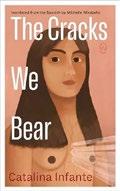
A Chilean woman loses her mother, gives birth to a daughter, and attempts to understand the fragile threads that bind generations in this slim yet sturdy novel. Laura, an art history professor, lives a comfortable life in 21st-century Santiago with her partner, Felipe, and their newborn, Antonia, but Laura’s late mother, Esther, was a communist who fought against a repressive government and took her thenadolescent daughter to visit Cuba. Now Laura, who is clearly experiencing some postpartum depression, alternately ruminates on her faults as a mother and her dislike of her new role: “Motherhood hit me blindside,” she says. She makes some halfhearted attempts at going out with single friends but finds she’s more interested in thinking about Esther than she is in smoking weed or sleeping with a woman named Daniela. Her memories of her family’s time in Europe (her mostly absent father, Michel, is French) and of her longtime friend Blanca’s kind, bourgeois parents swirl around the void Laura feels from her own mother, whose revolutionary dreams were subsumed by parenting and teaching. “My mother could never wrap her head around the idea of working less,” says Laura, at once proud and ashamed of herself for reducing her own course load. When Esther grew ill from cancer, she told Laura bluntly, “You have a house, and you have your things, and you’re going to be fine, don’t cry.” Toward the end of the novel, Laura asks the visiting Michel for directions to Esther’s childhood home. When she and Felipe and Antonia make the trip, Laura has a realization that may or may not make things better for her little family. What remains true are her therapist’s words
about relationships, that they’re “full of cracks…pieced back together over and over again.”
A straightforward voice guides a complex exploration of upheaval— political, maternal, and familial.
Jacobs, John Hornor | Putnam (336 pp.) $30 | October 7, 2025 | 9780593853436
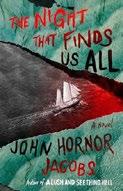
A nautical yarn soaked in horror and doom.
Narrator
Samantha Vineyard, aka Sam Vines, accepts an invitation to join a crew to sail a century-old wooden ship from Puget Sound to England. From the outset, she foreshadows unspeakable loss. The ivory-white Blackwatch is powered both by sails and a Rolls-Royce engine nicknamed Rollo. Sam is a quickwitted, salty-tongued alcoholic who maintains Rollo and is intrigued by the baroque inside of the ship. Her friend and crewmate, a guy named Loick, has told her the ship is haunted, and she gets creeped out by some of the gibbering sounds and ghostly shadows. Among the others aboard are three Steves, collectively the Threves; a female first mate nicknamed Seabees; and Hank Huntington—whom Sam calls Hank Fucking Huntington. (OK, f-bombs fit the genre, but they tend to wear thin after the first hundred or so.) Trouble arrives early and often—a crewman dies, and even a stop in the calm waters of the Panama Canal
brings a ghastly demise. Sam’s storytelling style grabs readers’ attention with vivid, imaginative prose. On the deck one night, “it’s as dark as Satan’s bunghole.” A strange simile, yet apt. “I’m on the razor’s edge of batshit,” she says once, though it’s true throughout the story. And her “mind skitters around like drops of water on a smoking hot pan.” Sam’s discovery of an old journal, half mildewed and rotted but still partially readable, suggests the Blackwatch is indeed haunted and always has been. Meanwhile, the tension builds without letup: Whatever godforsaken disaster happens, matters will only get worse.
The author, an established horror writer, looks like he’s done his nautical homework from mizzenmasts to bilgewater. Readers not normally given to the genre might want to give this yarn a try, because it’s also a good sailing story and an exciting thriller. Great fun if you don’t require a happy ending.
Kardos, Michael | Severn House (208 pp.) $29.99 | December 2, 2025 | 9781448317233
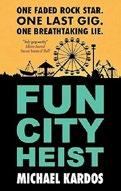
A dedicated beach bum finds his chill world upended by folks from his past— and his future.
Mo Melnick wants nothing more out of life than to plop down on his beach chair every day and rent umbrellas to Jersey Shore visitors. But Johnny Clay has a different idea about how Mo should spend his admittedly limited energy. Johnny wants to gather
Here’s hoping Kardos provides his unlikely hero with a well-deserved encore. FUN CITY HEIST
the members of the long-disbanded rock group Sunshine Apocalypse for a one-night reunion extravaganza at Fun City amusement park on July Fourth. Resistance proves futile—Johnny’s a force of nature, especially when he confides that he’s terminally ill—so Mo begins an awkward reunion with guys he hasn’t seen for decades, and they start rehearsing. He also has a more surprising reunion with his daughter, Janice, who’s working at the shore for the summer. Since Janice’s mom was an Apocalypse groupie who was only briefly in Mo’s life, he has little investment in the teenager. His attachment grows, however, when he learns that she’s a talented guitarist whose interest in music was sparked by listening to his old records. To no one’s surprise, Johnny’s interest in the band’s reunion takes a larcenous turn. By then, though, Mo is hooked, both by his renewed connection to his bandmates and his burgeoning paternal feelings. His tale, both funny and touching, reminds you that murder isn’t the only crime worth writing about. Here’s hoping Kardos provides his unlikely hero with a well-deserved encore.
Kellerman, Jonathan & Jesse Kellerman Ballantine (352 pp.) | $30 | October 28, 2025 9780525620174

A floater in San Francisco Bay keys up a tough case in this fifth Clay Edison thriller. Adam Valois, 33, floated ashore a year ago at Coyote Hills, a park on the edge of the Bay. Not a homicide, say the coroner and police, but Adam’s parents are suspicious and hire PI partners Clay Edison and Regina Klein to investigate further. You’re wasting your time, the cops tell Clay, himself an ex-coroner. Officially, Adam wasn’t a homicide victim
at all, but a drug user deemed responsible for his own death. But other bodies wash up, and the PIs look for common drug profiles. They even enlist a scientist to write a computer program to analyze the Bay’s complex tidal currents and try to find a common dumping ground for the bodies, if one exists. And it turns out they are homicides after all. There’d been bad blood between the troubled Adam and his successful attorney sister, Kirsten, and she becomes one of several suspects. On a par with the solid plot are some of the character relationships. Regina has a sharp tongue and loves to tease Clay, calling him Poirot. She both admires and challenges him. There’s no obvious sexual chemistry between them; she has another man in her life, and Clay is happily married with two kids who love “Auntie Regina.” Even his brother, Luke, who’d once done time for vehicular homicide, seems to be getting his act together. So Clay lives his life on two levels—other people’s troubles and his own happy family. He and Regina uncover computer messages that cause Regina to exclaim “Sweet baby Moses on a motorbike,” but then Luke visits Clay and teaches his kids how to become pancake ninjas. Like their PI partners, Jonathan Kellerman and his son Jesse make a great team. Dead bodies and pancakes—who could ask for anything more?
Lapid, Lihi | Zibby Books (200 pp.) | $15.99 paper | October 21, 2025 | 9798992427646
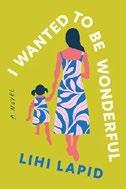
Two newly married women embark on the journey of motherhood, struggling with how expectations from others, and from themselves, alter their lives and identities. The book opens as the unnamed narrator reflects on how she has lost herself. In trying for years to meet everyone else’s needs, she has forgotten about what truly matters to her, and she resolves to take a new approach to finding happiness. Then the story
introduces its other main character, “the princess,” who has just recently married “the prince.” As they begin what is supposed to be a fairytale life, not everything is as easy as they expected. The book alternates between the perspectives of the princess and the narrator, both women giving birth to a son and a daughter. The princess’s children are called simply “the heirs,” while the narrator’s are her boy and her girl, never receiving proper names. As the women learn to care for their children, they realize they can’t devote as much time to their professions as they’d hoped, and they must adjust either their parenting strategies or their career goals. The husbands are busy trying to earn enough to support their families, but the children are hard work, and arguments between the spouses become frequent. As both marriages spiral further away from their romantic beginnings, the question at the heart of the story is whether the expectations on women to be perfect mothers are simply too much. Writing in haunting, introspective prose, the author captures the essence of early motherhood, from the hazy months of sleep-deprivation to the angst many feel about juggling careers with children. By alternating first-person narration with the story of the princess, the author also highlights how the lives of others often look more idyllic from the outside. The book is partially a commentary on the lack of support women receive when they become mothers, but it’s also an examination of how lack of communication in marriage can lead to deep fissures. While this poetic tale feels more like an allegory than a plot-driven novel, light on setting and character details, the insight into modern parenting is sufficiently insightful that the book becomes compelling.
A poignant and relatable exploration of adjusting to motherhood.

Levy,
Amy | Smith & Taylor Classics (150 pp.) | $17.95 paper | October 28, 2025
9781961884649
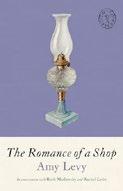
For more about Little Women, visit Kirkus online.
In late 19th-century London, four orphaned sisters go into business. British author Levy (1861-1889) is a fascinating figure of her time: Jewish and bisexual, she died by suicide at age 27 having already written three novels, three poetry collections, and more. It is haunting that this sweet and lively novel, sparkling with popular culture references that convey the spirit of its time and place, was published just a year before her death. The four sisters and their trials and triumphs cannot help but echo the paradigmatic Marches: Little Women had been a bestseller for decades at the time the Lorimers were invented. The “Jo” character, Gertrude, is also a writer, but when their father dies, leaving the girls in financial distress, she puts her literary efforts aside to open a photography studio with Lucy (Meg), Phyllis (part Amy, part Beth), and their rather untalented older half sister, Fanny (honestly, a case all her own). Along with their mostly successful attempt to achieve financial independence via commercial endeavor and other striking feminist elements—at one point, Gertrude remarks of a certain gentleman that if a woman were discussing “the motions of the heavenly bodies, he would be thinking all the time of the shape of her ankles”—the novel includes several marriage plots and a very Victorian death by consumption. It’s also a vivid look at the cultural life and mores of the urban middle class of the period. The publishers append an interesting postscript, an informal conversation between contemporary writers Ruth Madievsky and Rachel León in which they raise issues such as the identity of the never-named narrator, hints of queer and anticolonial subtext, and the insight that the four Lorimers opening a
Celebrated for her dark crime fiction, the novelist tried her hand at a cozy mystery.
BY CONNIE OGLE
LAURA LIPPMAN WISHES she could tell you that Murder Takes a Vacation, her latest novel and her first cozy mystery, was a highly intentional tribute to an often-disrespected genre that she loves.
But inspiration arrived in a different way.
“I want to pretend this was a conscious act of rebellion in which I write a genre that has been derided by men in my field,” she admits. “I do remember I was watching Charade [the 1963 movie with Cary Grant and Audrey Hepburn], and I thought, What about Charade as a story? Let’s flip the genders—have a woman be the older person and the man young and beautiful. Also, I had written two back-to-back books about pretty despicable people, three if you count my essays about myself. I needed to write a book about someone in whose company I would be happy.”
Author of 27 novels, six short story collections, and two essay collections— and a longtime resident of Baltimore—Lippman, 66, has always mined the dark side of crime fiction. She has examined criminal behavior through the eyes of her Baltimore private investigator, Tess Monaghan, and in stand-alone psychological thrillers that examine the insidious power of the past and how none of us are ever quite free from its grasp. Earlier this year, she was named a Grand Master by the Mystery Writers of America, an honor that puts her in the company of Agatha Christie, Mary Higgins Clark, P.D. James, and others. After a lot of time spent enmeshed in the troubled psyches of her characters, she realized her personal life called for a little uplift. In 2024, her divorce from screenwriter and producer David Simon was final (they split in 2020, and she wrote about it in the collection My Life as a Villainess). She also lost her beloved mother, who died at 93.
The joke was on me. It was the hardest book I’ve ever written in my life.

So Lippman focused her new novel on a character she created years ago but always felt she had neglected: Mrs. Blossom, Tess Monaghan’s assistant. Lippman hasn’t published a Tess novel in 10 years, but the time was ripe, she felt, for Mrs. Blossom to do a little sleuthing of her own.
In Murder Takes a Vacation, the widowed Mrs. Blossom has come into some money via a lottery ticket and has decided to indulge herself and embark on a European cruise. The novel’s cheeky first line—“Mrs. Blossom had never been upgraded in her life”—is an indication of the delightful, breezy style of the murder mystery, in which a friendly, attractive man on Mrs. Blossom’s flight from Baltimore to London befriends her. When he winds up dead, and a second mysterious man, Danny, pops up on arrival in Paris and doesn’t let her out of his sight, Mrs. Blossom knows this trip will not be the relaxing vacation she envisioned.
Lippman, long a fan of cozy authors like Margaret Maron and Donna Andrews, thought the writing would be relatively easy. She was wrong.
“The joke was on me. It was the hardest book I’ve ever written in my life,” Lippman says.
And yet, even after a maddening slew of revisions, Lippman is unwilling to let go of Mrs. Blossom. She’s already working on a second novel about the widow.
“Even on days when I’m banging my head against the wall, I realize I kind of like banging my head against the wall,” she says. “I’m so puzzled by people who want to skip the process of writing. It’s actually what I love most.” We recently spoke by phone with Lippman about the new book; our conversation has been edited for length and clarity.
What was so hard about writing a cozy? You have to create a huge cast. In psychological thrillers or PI novels, you don’t need that many people. In a cozy, everyone has to come from this closed community. The person who’s killed has to have a personal connection to the killer and to the amateur sleuth. And you want there to be a lot of suspects. On my first try, my editor said, “This isn’t working. We need more people on this
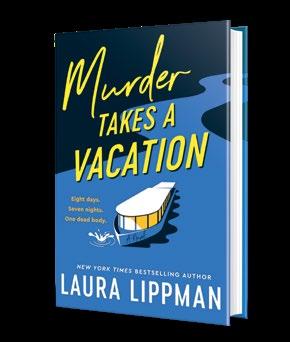
Lippman, Laura Morrow/HarperCollins | 272 pp. $27 | June 17, 2025 | 9780062998101
boat.” The things people are so quick to dismiss are often quite hard to do.
What is it about Mrs. Blossom that drew you back to her?
Mrs. Blossom is very much an amalgam of the three Lippman women. My sister is shy, someone who got married in her 20s and is still married to the same man. My mom loved to travel and would’ve liked to have gone on that trip Mrs. Blossom went on. And I am a woman in my 60s not expecting to be single, but I am. Mrs. Blossom is much kinder than I am and much sexier, though. I did have a lot of fun with her evolving fashion sense, because I love clothes, and my daughter and I could watch the big montage from The Devil Wears Prada all the time. There’s also a big overlap between [Mrs. Blossom and me] in her feelings about the artist Joan Mitchell. Mrs. Blossom’s discovery of Joan Mitchell is straight-up my discovery of Joan Mitchell.
You also took on writing from the point of view of a plus-size woman. How did you approach that?
I was paying attention to conversations about antifatness, the work of people like Aubrey Gordon [What We Don’t Talk About When We Talk About Fat] and Virginia Sole-Smith [Fat Talk]. I
would describe myself as a midsize person—the term is midsize queens, which is awful; it’s supposed to be women sized 10-14. I know appropriation is always a hot-button topic. You have to be prepared to be told you’ve failed, and I feel like I’m prepared to be told I’m wrong. What I wanted to do was write a fat character who’s a self-conscious person, but she’s fine with her size. What’s bruising to her is to come upon people who are not. She’s happy in her body. I did have a sensitivity reader, but I do think curious, empathetic people who are not fat can write about a fat person if they’ve been paying attention to the culture we’re in.
I have a teenage daughter, and when I found out 15 years ago my child was going to be a girl, the only thing I wished for was to bring up a kid free of the body image issues I had. And now, it’s worse than ever, with TikTok and social media. It’s important to me to always say Mrs. Blossom is fine with herself. What she’s not fine with are the people who are cruel to her.
You say cozy mysteries are often derided by male crime writers. Why do you think that is?
The general problem in our culture, and I have said this a lot, is that men think something that makes them cry is profound and what makes women cry is simply sentimental. Books about men are seen as universal, while books about women are highly particular. Yet women are the backbone of fiction, commercial and literary. It’s so bizarre to me that this is the way the world works.
Do you think you’ll ever write about Tess Monaghan again?
I always want to bring Tess back. But I haven’t found the right story. She probably won’t even appear in the second Mrs. Blossom book, which is set in Tuscany at a posh resort cooking school. I’m always looking for the right idea for Tess. She’s dear to me and very much alive to me. Writing about Mrs. Blossom is the next best thing I can do.
Connie Ogle is a writer in South Florida.
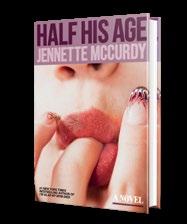
The actor’s first book was the bestselling 2022 memoir I’m Glad My Mom Died.
Jennette McCurdy will follow up her bestselling memoir with a new novel.
Ballantine will publish the actor’s fiction debut, Half His Age, next year, the press announced in a news release. It calls the novel “startlingly perceptive, mordantly funny, and keenly poignant.”
McCurdy, known for her roles on the television series iCarly and Sam & Cat, rose to literary fame in 2022 with the memoir

For a review of I’m
I’m Glad My Mom Died, which chronicled her experiences as a child actor and her relationship with her abusive mother. The book was a huge hit, and in a starred review a critic for Kirkus called it “the heartbreaking story of an emotionally battered child delivered with captivating candor and grace.”
Half His Age will follow Waldo, a teenage girl who embarks on an affair with her creative writing teacher.
“Writing Half His Age has been the most creatively fulfilling experience of my life,” McCurdy said in a statement. “Waldo’s story is ultimately about finding yourself in a world designed to make you lose yourself, and that felt profoundly meaningful for me to write. I can’t wait for people to read this novel.”
Half His Age is slated for publication on January 20, 2026.
—MICHAEL SCHAUB

Jennette McCurdy
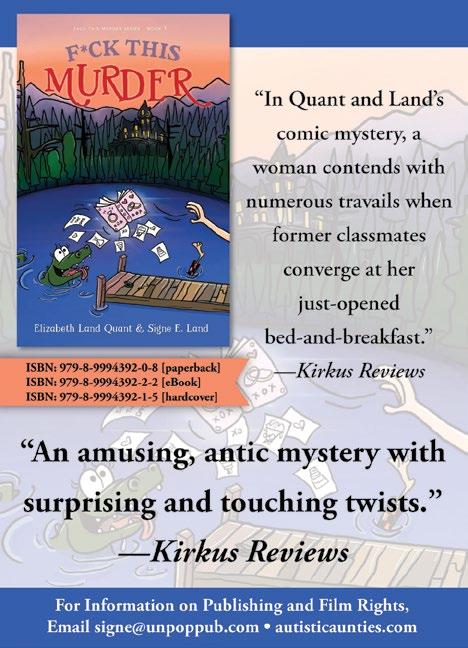




Bloom Books will publish the romance author’s Love Song. Elle Kennedy will return to her Briar universe with a new novel coming next year, People magazine reports. Bloom Books will publish the popular romance author’s Love Song in the spring. In the novel, the press says, Kennedy delivers “her signature heat and humor.” Kennedy is the author of several romance series, including Out of Uniform and Killer Instincts, but she is best known for her hockeythemed Off Campus novels, which launched in 2015 with The Deal and continued with The Mistake, The Score, The Goal, and The Legacy The books are being adapted into a television series starring Ella

For reviews of Elle Kennedy’s books, visit Kirkus online.
Bright, Belmont Cameli, and Steve Howie.
A spinoff of the Off Campus series, Blair U, began in 2018.
Love Song introduces a new series of characters, including Wyatt Graham and Blake Logan, whose parents were featured in The Deal and The Mistake, respectively. The two encounter one another in Tahoe, California.
Kennedy told People, “Love Song means so much to me because it is my first true next-gen romance. It was such a joy to write because I got to revisit two of my favorite O.G. Off Campus characters (the iconic Garrett and Logan) via their son and daughter getting their [happily-ever-after].”
Love Song is slated for publication on March 17, 2026.—M.S.

photography business is the Victorian equivalent of a “Girls Gone Wild” video. How is it that Victorian novels never get old? A lovely addition to the canon.
Madrid, L.L. | Creature Publishing (350 pp.) | $20 paper | October 14, 2025 9781951971342
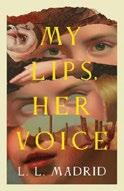
In a former mining town with a bloody history called Copper City, the most haunted place in North America, four young women—Audrey, Mara, Zadie, and Shirley—are inextricably connected through time itself by the sudden and mysterious disappearance of a local high school student. Days after Mara is brutally murdered and her body is found in the long abandoned—and reportedly haunted— Copper City mines, her restless and vengeful spirit takes up residence in her cousin Audrey’s mind. While neither girl is particularly thrilled by this sudden possession, especially Audrey, the two are forced to work together when a growing string of disappearances threatens the livelihood and safety of their home town. With the help of Mara’s ex-girlfriend, Zadie, and haunted by their grandmother Shirley’s connections to the supernatural, the girls race to piece together the truth before the killer who took Mara’s life strikes again. Using alternating points of view, Madrid does a flawless job at helping readers to differentiate between each young woman as their collective story unfolds. Each have distinct voices, and all four are deeply flawed and feel
undeniably like teenagers trying to find their place in the world. Audrey is insecure and bends to Mara’s will; Zadie is often self centered and unfaithful to Mara; Mara is manipulative and borderline abusive to Audrey; and Shirley struggles to balance her prophetic visions with real life. (Shirley’s chapters unfold 55 years in the past, gradually revealing that she’s Mara and Audrey’s grandmother, though she’s a teenager for most of the story.) Copper City feels like a character in itself, packed with small-town lore and a bloody history that haunts its inhabitants. The result is a sharp and atmospheric whodunit and a queer ghost story packed full of twists that will leave readers guessing.
An intriguing and atmospheric queer mystery that’s peppered with the supernatural.
Maizes, R.L. | Ig Publishing (280 pp.) $18.95 paper | November 4, 2025 9781632462114
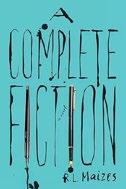
A writer’s accusation of plagiarism turns lives upside down and spawns plenty of discourse.
P.J. Larkin is a 35-year-old rideshare driver in Colorado who fears the sun is setting on her life goal: to become a published novelist. P.J.’s agent has been with her through multiple books that have failed to sell, but P.J. has high hopes for her latest, Halls of Power. The novel is “loosely based on the sexual assault of her sister, Mia, by the state senator she’d interned for while in college.” That loosely is debatable and will
The murder of a financial adviser sparks questions that aim everywhere.
get P.J. in a whole lot of trouble, especially with her family. When P.J. sees an announcement that a novel called Up the Hill has sold for $1 million, she’s furious, not only because this book has similarities to hers, but also because the author, George Dunn, is an editor at a small press who’d rejected P.J.’s own book more than a year ago. P.J. posts a “nibble” on social media site Crave accusing George of stealing her book, which sets off a cascade of speculation, frozen contracts, protests, renewed interest in P.J.’s book, and, of course, social media backlash. George’s book is based on his own assault by a female senator while working as a page when he was a teenager. His parents did not believe him, and he told no one else, though attacks on his credibility now force him to reconsider his silence; his long-delayed journey to processing his assault is poignant despite his flaws. Author Maizes aims for biting commentary on the state of the publishing industry, #MeToo, power imbalances (particularly between men and women), and who has the right to tell a story. Unfortunately, the prose is too wooden and heavy-handed to adequately address these topics. P.J. is an unlikable and profoundly selfish protagonist, and while these traits in a main character can sometimes make for successful satire, this book can’t handle that challenge. An unsuccessful attempt at skewering the lives and dramas of writers.
Margolin, Phillip | Minotaur (304 pp.) | $29 November 11, 2025 | 9781250356895
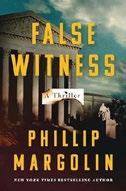
The murder of a skeezy financial adviser sparks questions that aim everywhere you can imagine in Multnomah County, Oregon. To hear dimwitted Jack Blackburn tell it, Billy Kramer, the chauffeur to Terrance Cogen, asked him to take Billy’s girlfriend, Cindy, home from a bar in Cogen’s Jaguar because Billy was drunk, and when Jack returned
to the bar to drop off the Jag, Billy wasn’t there. That’s important because a beer glass found inside Cogen’s home with Jack’s prints links him to what turns out to be a murder scene. The case is assigned to attorney Karen Wyatt, who ever since she was framed for professional misconduct, disbarred, jailed for a year, freed, reinstated, and awarded a hefty settlement has had an eye out for other defendants in the frame. There’s no shortage of alternative suspects. Apart from all the clients Cogen swindled, his fourth wife, Rosemarie, is delighted to be spared the trouble and expense of divorcing him. And Oregon Congressman Thomas Horan, who’d gone missing just before the murder, produces the world’s unlikeliest alibi: He’d been abducted by aliens who kept him in their custody that night. Karen and her investigator, Morris Johnson, the ex-cop who arrested her four years ago, quickly tie Cogen’s misdeeds to Walter Zegda, the sociopathic second-in-command of the gang Lucifer’s Disciples. But they’re forced to tread carefully by the news that the Disciples have a mole in the Multnomah D.A.’s office and a dying message from a Disciple in the know that seems utterly useless in identifying that mole. The final surprise isn’t all that surprising, but readers who’ve been caught up in all those complications won’t mind. A stand-alone with as much energy as Margolin’s franchise tales of defense attorney Robin Lockwood.
Kirkus Star
Only Son
Moffett, Kevin | McSweeney’s (216 pp.) $28 | November 4, 2025 | 9781963270303
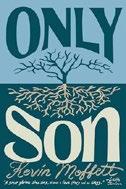
A man navigates childhood and fatherhood, first as an only child and then as the parent to one. How does one be a good son? How does one be a good father? These are the questions that animate Moffett’s solo debut, a powerful and deeply funny
exploration of how the things that happen when we’re young shape our lives. Moffett circles this concept during the novel’s first section, which deals with the unnamed narrator’s childhood in the wake of his father’s death. In the book’s first pages, he recalls how one of his classmates, Darlene, offered her sympathies, noting that her dad was also dead, though it was immediately clarified that, “He just ran off to Ohio with some woman he met on an airplane.” The blows are always dealt with a dose of the surreal, a wink and a nod toward the absurdity of life. The lingering trauma, though, makes its way into the relationships he fosters during the book’s most powerful sections. In adulthood, he’s a writer living in the desert outside of Los Angeles with his wife and son. Despite an awareness of his own shortcomings, he can’t help but have a tension-filled relationship with his son, one that mirrors his own angsty relationship with his mother. Big drama cedes to the mundanity of raising a child and growing into middle age. Little anecdotes, like how his son prays to Zeus instead of God because Zeus is probably less busy, give the story its momentum. At its core, it’s a novel of observations. Moffett does, however, give his narrator some catharsis when he’s able to clearly express feelings through a letter that he can’t seem to tell his son through words: “I tell him he’s the best thing that ever happened to me.”
Humor gives this stirring meditation on the nature of familial relations a playful, biting edge.
O’Hare, Gráinne | Crown (288 pp.) | $28 November 4, 2025 | 9798217088997
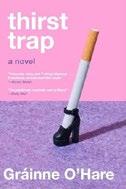
Three housemates in Belfast deal with their grief after the death of a fourth friend, relying on alcohol, cocaine, sex, and even a few therapy sessions. The three young women at the center of O’Hare’s debut—Róise,
Maggie, and Harley—are closing out their 20s with a bang. Though “Róise assumed they would evolve naturally from twenty-something buck eejits into secure and self-actualized young women who had skincare regimes and remembered to pay the council tax on time,” this is definitely not on the agenda during the time period covered by the novel, which sees more than one 30th-birthday celebration. Since they moved in together as a foursome years back, both the rundown house itself and their friend group have suffered great depredations, with the biggest blow being the death of their fourth friend, Lydia, in a car crash. This loss was complicated by the fact that it happened very shortly after a drunken betrayal involving Róise’s boyfriend had everyone on the outs. Though Maggie sees a rather unhelpful therapist, the women’s approach to grief relies largely on self-medication and casual sex; there is so much drinking and partying in this book that readers may themselves begin to feel a bit hungover. Maggie sleeps with women, Róise sleeps with her sort-of boss, Harley sleeps with their landlord, who is also their coke dealer; all are grimly aware that nothing is as fun as it used to be, though the effect is somewhat lightened by O’Hare’s insightful and humorous depiction of their weltschmerz: “The music has been turned down low in the living room to accommodate a game of Never Have I Ever, which, when everyone is in their thirties, becomes less of a light-hearted drinking game and more of an informal support group.” It’s a little harder than it should be to keep the characters and their supporting cast straight, and the witty writing works better than the more serious aspects of the story, but these are forgivable flaws in a promising debut.
The New Sobriety will have to wait—the party novel is not dead. At least in Ireland.

Kirkus Star
Packer, Ann | Harper/HarperCollins (256 pp.) | $28.99 | November 11, 2025 9780063421493

A woman with terminal cancer stops treatment— and it gets complicated from there.
Don’t expect a have-a-good-cryand-catharsis tale from Packer, who excels in diamond-hard dissections of tangled personal relations. She embeds the narrative in the perceptions of Eliot, who is blindsided when his wife, Claire, tells him that she wants her two best friends to take care of her in these final months, “instead of you.” It seems an unbelievably cruel demand; Eliot has been her caretaker through nearly nine grim years. He agrees, confident that “Holly and Michelle would need him for the bad moments…Claire would need him. She couldn’t see it now.” This thought should be a clue that there’s more going on here than a dying woman’s caprice, and the hints pile up from there in stray comments by friends, the couple’s adult children, and Eliot’s own recollections of past moments of tension in what was unquestionably a loving marriage. A retired management consultant, he wants to manage situations and avoid conflict: “You’re like…amenable,” says son Josh. “Except when you’re not.” Packer mercilessly prods Eliot toward enlightenment about his character and Claire’s feelings. Readers are likely to share his frustration with his wife’s attitude, which can be summarized as, “If you don’t get it, I
can’t explain it,” until they realize she’s just too sick to deal with other people’s issues. Nothing is simple in a Packer novel: Emotional and power dynamics among Eliot, Holly, and Michelle shift on a near-daily basis, while Claire at the center keeps insisting that her decision has nothing to do with her love for her husband, and Josh and sister Abby referee from the sidelines. The final pages are as deliberately unresolved as the rest of the novel. Packer’s unsparing gaze would be hard to take if her characters weren’t so believably, messily, hurtfully human. Harrowing, but brilliant.
Parris, Rachel | Little, Brown (384 pp.) $19.99 paper | November 4, 2025 9780316602358
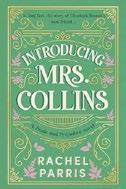
In her debut, Parris imagines what Pride and Prejudice character Charlotte Lucas’ life might have been like after her marriage to Mr. Collins.
Charlotte is known to readers as Elizabeth Bennet’s best friend from Pride and Prejudice. Unlike Elizabeth, who marries for love, Charlotte is not quite so lucky. She marries Mr. Collins, the stable but slightly awkward clergyman she describes as “tall, dark, and…pious.” Charlotte knows her prospects are slim, and she’s determined to marry well to provide a future for herself, even if that future doesn’t involve passion. With Mr. Collins as her husband, Charlotte lives a life that is safe and calm—but unexciting. While Mr. Collins treats her well, their relationship never feels particularly
romantic. And then Charlotte meets Col. Fitzwilliam, Mr. Darcy’s cousin. Sparks fly instantly, and soon Charlotte finds herself sneaking around to spend more time with Fitzwilliam. Their attraction shouldn’t grow into a full-blown love story for many reasons, chief among them Charlotte’s marriage. That doesn’t stop them from developing feelings that may very well lead to heartbreak. A happily-ever-after seems nearly impossible, and to be sure, not every character here will end up happy, which may be a point of contention among some Pride and Prejudice fans. Staunch Austenites might blanch at this depiction of the characters they’ve come to love, although the book will be welcome to others who longed to see Charlotte take center stage and find her own happiness. It’s also satisfying to read the inner thoughts of Mr. Collins and come to view him a less mockable character. Parris gives Charlotte’s quest for happiness a more modern romance-novel feel than the original text—for example, Charlotte defends her feelings for Fitzwilliam by saying, “If God made me capable of love, then it must be his will that I find it.”
While some of the characters’ actions may seem surprising, there have been enough Pride and Prejudice retellings that there’s plenty of room for one where Charlotte follows her bliss. An interesting and surprising look at a classic story and an often-forgotten character.
Schaefer, Brian | Atria (304 pp.) | $28 November 4, 2025 | 9781668086896
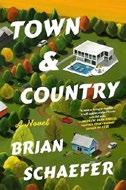
The race for a congressional seat in a trendy rural town brings many tensions to the surface. Recently proclaimed “The Best Big Small Town in America” by a glossy travel and lifestyle magazine, the fictional town of Griffin
has “transitioned from one expression of itself to another, with the old toy and candy stores eventually replaced by this gourmet tea shop and that high-end hair salon.” Schaefer’s impressive debut picks up a lot of sparkling, interesting threads that have shown up in other recent novels—the gentrification of New York’s Hudson Valley (fictionalized here), queer candidates entering politics, the opioid crisis as it affects the middle class—bringing insight and texture to these issues. It opens with Griffin’s classic Memorial Day parade and continues through Election Day. On one side of the ballot is Chip Riley, a longtime local who owns a bar called the Lucky Buck, and on the other is Paul Banks, new to the area, his campaign financed by his wealthy older husband, Stan Banks. Caught between them are two other members of the Riley family. Chip’s wife, Diane, is a religious woman who once campaigned against same-sex marriage and has now become the real-estate agent of choice for the influx of gay men from the city. His son Will is home from his first year of college and newly out, and though he works at his father’s bar and on his campaign, he meets the urban gay crowd through a catering gig, and is drawn to their sophistication and freedom. Will’s sexuality is a bit of a sore spot for his family, particularly his older brother, Joe, who is reeling after the overdose death of his best friend and is still into drugs himself. Schaefer does a masterful job delineating these and a large set of supporting characters, ending his novel with a grace note involving two of the latter group, choosing to emphasize new connections rather than old divisions.
A thoroughly engaging and intelligent debut, brimming with insight and a sense of place.
Sutanto, Jesse Q. | Berkley (352 pp.) | $19 paper | November 11, 2025 | 9780593816875
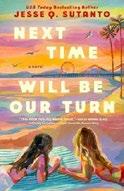
A grandmother reveals the secret of her long-ago forbidden love. In a near-future Jakarta, Indonesia, secretly gay teenager Izzy Chen doesn’t fit into her societyconscious family. Her grandmother Magnolia, the family’s matriarch, knows the story of her own hidden life will help Izzy blossom, so she unfurls her saga. In mid-1990s Jakarta, Magnolia is the obedient daughter, a stark contrast to her rebellious older sister, Iris. The two are sent to Los Angeles for college, where they grapple with the residue of their rigid upbringing: What does it mean to be a good Chindo—ethnically Chinese from Indonesia—girl? On her first day of class, Magnolia meets a girl named Ellery O’Shea, and everything she thought she wanted—a respectable boy and her parents’ approval—disappears in the face of real love. Ellery is openly queer, but Magnolia always thought of herself as straight. The two are in love but keep their feelings hidden, and then Ellery goes to London. Returning to Jakarta, Magnolia falls in line: marries a man named Parker, sets up house, and secretly writes Ellery heart-wrenching letters she never sends. The novel offers a biting
A mother and daughter have their minds merged as a form of population control. THE MERGE
examination of a traditional patriarchy in the Chindo community, its status-driven social scene and a culture less tolerant of queer lives. As such, Magnolia finds it easier to conform than to question. Meanwhile, Iris becomes a tech trailblazer in Jakarta, but when she becomes pregnant by an abuser, she returns to LA followed by Magnolia and Parker. And who should be there waiting to stir everything up but Ellery? Sex, tragedy, and vindication follow. This is at times a frothy rom-com, at others an absorbing portrait of South Asian women hemmed in by impossible expectations. A queer Chinese Indonesian tearjerker: a winning combination.
Walker, Grace | Mariner Books (320 pp.) $28 | November 11, 2025 | 9780063446731
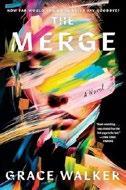
In a climateravaged future, a mother and daughter from London plan to have their minds merged as a form of governmentsponsored population control.
In this taut thriller, a new kind of technology enables a person’s mind to coexist in another’s body. The two minds in one body are then called Combines, identifiable by their double names, mandala neck tattoos, and green clothing. A governmentcorporate enterprise, also called Combine, the process is marketed as a way of reducing the population and reversing climate change, but people who don’t merge are punished through government mandates: Most are forced from their homes into government apartment buildings, menstrual cycles are monitored, prison inmates are involuntarily merged, Oxford will only accept Combines. Of course, if you have the money, you can remain as you are. Amelia Anderson, a videographer, and her mother, Laurie, have signed up for an experimental merge group
of risky cases—Laurie has Alzheimer’s disease, which will be cured when she merges into the body of her daughter. However, even with her failing cognition, Laurie is against the merge, as are many in London who protest in the streets and outside the Combine clinics. Secretly, Amelia volunteered them both as a form of gonzo journalism to have access to the inner workings of Combine during their three-month preparation period. She plans for them to escape before the merge, but doesn’t realize how difficult that will be. Walker has produced an inventive exploration of climate change, class disparity, corporate influence, and biotech “enhancement,” all of which converge in this frightening vision of a totalitarian Britain. Amelia and her mother discover Combine’s deadly secrets, in a world where individuality takes on a new meaning. Whether they will be able to escape is another matter. An excellent addition to the growing catalog of 21st-century dystopian nightmares.
White, Erin O. | Dial Press (320 pp.) | $29 November 4, 2025 | 9780593978559
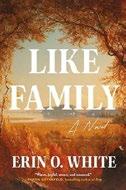
Secrets, jealousies, flirtations, and suspicions test the love and friendship among six friends living overlapping lives in the Hudson Valley. Three couples— one straight and two lesbian—form the core of White’s debut, which begins with a
death but then dwells significantly in the interiority of her characters. Caroline Caruso, married to Mike Gallagher, has one child, Luca, and worries constantly that he’s doomed to the loneliness that has marked her own existence. Caroline’s best friend, Ruth Schwartz, is married to wealthy farmer Wyn Huntley. They have four children, the eldest of whom, 16-year-old Siddha, was fathered by Elliot Shepkins, who recently died. Ruth had not yet revealed to Siddha her father’s identity, and as it emerges now, after any chance for the girl to know him, a family rift develops. The third couple is Tobi Fynch and Evie Gold, who run a wildly successful pottery business. Everyone lives in Radclyffe, “nestled between the Hudson River and the Catskill Mountains.” Tobi is Mike’s cousin and, having grown up in the same household, they are very close, so much so that Mike donated his sperm to the pair, resulting in their twins, Nina and Jules. This tangled scenario, with its various backstories, can confuse and takes some time to establish, after which events are few. Tobi is increasingly drawn to undergoing top surgery but doesn’t tell Evie. Ruth reconnects with Florence, a mutual friend of hers and Elliot’s, and a secret affair of sorts begins. Caroline has sessions with a therapist, supposedly for Luca’s benefit but which expose her own issues. And Siddha begins a clandestine relationship with her father’s family. White shifts capably among her characters, edging their concerns forward, but the book’s navel- gazing can seem claustrophobic and repetitive. As a crucible for mature relationships, the book is tidily done, but easy resolutions
compound a sense of small-scale domestic drama.
A heartstring-strumming paean to family.
Woods, Lauren D. | Autumn House Press (184 pp.) | $18.95 paper | October 21, 2025 9781637681091
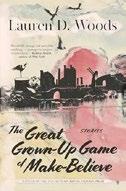
An imaginative collection about the joy and sorrow of growing up. Woods’ tender and resonant debut features 28 pieces of short and micro fiction. Imbued with magic and the absurd, these stories explore the ways that childhood wonder informs our lives. In the very funny and satirical “Randomized Trial,” a group of overachieving children perform a scientific experiment to figure out why their classmate—a quirky dreamer unencumbered by ambition—is so good at headstands. Woods writes beautifully about motherhood, nostalgia, and the pleasure and pain that can be found in dreaming of alternate lives for ourselves. In “Proportions,” a mother shrinks and grows in relation to how much of herself she gives to her oblivious family: “Everything had a cost, a measurement, a gain somewhere that was a loss somewhere else.” The narrator in “The Shape-shifter” feels caught between the shape she wants to be and what her husband wants for her. As she changes herself over and over again, she questions who she is beyond his gaze: “She began to feel the tiniest sliver of doubt and wonder, deep down, whether she had a true self.” Woods also plays with form to great effect in “It Wasn’t a Fit,” which explores the dissolution of a marriage through dictionary definitions, and “The Long Brew,” which follows a mother as she tries to care for her daughter
and finish a cup of coffee. Other standouts include “Evening by the Lake,” a sorrowful story about a mother and daughter who briefly return to their former secret life (“But here Mom and I are together, just the two of us, stuck in the in-between”)—and “Timetable for Learning to Eat Alone,” a melancholy yet hopeful ode to moving through heartbreak. Though some stories feel more flimsy and underdeveloped than others, the collection offers a unique vision into the ways we learn to live with our past, present, and future selves. An inventive and heartfelt short story collection.
Zalapì, Gabriella | Trans. by Adriana Hunter Other Press (176 pp.) | $16.99 paper November 25, 2025 | 9781635425635

An 8-year-old girl kidnapped by her father lives on the run with him in 1980s Italy in the English-language debut from a Paris-based author and visual artist.
Hanging upside down on the playground by her knees, Ilaria pictures her favorite gymnast, Nadia Comăneci, while waiting for her sister; since Ilaria’s parents separated, the girls have been living with their mother in Geneva. Instead, her father, Fulvio, arrives, saying there’s been a change of plan. What follows is the upending of Ilaria’s life. Her father drives her from Switzerland to France, and then to Italy, stopping constantly to make telephone calls but never letting her talk to her mother.
“Phone booths are cages on the frontier between three worlds. When Dad starts talking, I see all three dancing around inside that little box: Mom’s world, Dad’s world, and the world of the freeway.” He buys her lemonade at bars,
takes her shopping for toys, pinches her cheek, asks, “Are you happy?” Writing from Ilaria’s first-person perspective and in the present tense, Zalapì keeps the focus tightly on Ilaria’s experience as her father drives from town to town, avoiding the police. “We live in profile, Dad and me. I know the outline of his nose really well, the oval shape of his ears, the hairs that stick out from his eyebrows, just above his glasses frame.” She feels a responsibility for him even as he sends telegrams to her mother like: “Passing on your daughter’s disappointment for not talking to you STOP I reject all accusations of abduction STOP.” Short on money, he uses Ilaria to help claim luggage lost by strangers at train stations. He drinks more and more, “sweats, splutters, gesticulates, yells.” Yet even as he grows increasingly erratic, Ilaria can’t hate him. A nuanced portrayal of a child’s lost years with a flawed and irresponsible parent.
Zarin, Cynthia | Farrar, Straus and Giroux (144 pp.) | $25 | November 4, 2025 9780374610166

A woman works through the tangle of her life in this impressionistic follow-up to Inverno (2024).
“I had begun writing a long letter, a letter to a man with whom I was in love…” begins Caroline, the narrator of Zarin’s
second brief novel. She’s middle-aged, lives in New York, is estranged from her husband, Frank, and is the mother of three children—George, Louie, and Pom. She’s writing to Lorenzo, an Italian man with whom she’s having an extended affair, who is himself a paramour to two other women. Caroline’s letter is the work of several months and not something she ever intends to send; rather, it is a way to parse her own feelings and uncover how she became “the person who might write such a letter, and behave in such a way, behavior of which I deeply disapprove.” In the pages that follow, she explores not only the highs and lows of her current romance, but a previous one with a man named Alastair (the focus of Inverno), a friendship with a man named Daniel who struggled with bipolar disorder, and her preoccupation with the disappearance of Michael Rockefeller in New Guinea in 1961. As readers wade into Caroline’s stream of consciousness, they are treated to stunningly precise bits of prose (“I am thinking that one day I will learn to live without the sound that you make in the back of your throat, that difficult h. A small thing”), but it is often hard to find one’s footing. The novel is thick with allusions and quotations—William Shakespeare, Lewis Carroll, Leonard Cohen, Greek myth—some with more sign-posting than others. Readers with considerable familiarity with the Western canon may find this literary sleuthing rewarding, while others may find the bar to entry frustratingly high.
A dense, dizzying exploration of desire and the mystery of the self.
A dense, dizzying exploration of desire and the mystery of the self. ESTATE
This review originally ran in the May 1, 2021, issue.
A Texas sheriff copes with murder, attempted murder, and a returning ex-girlfriend in this third mystery series installment.
Clayton Shoot, now sheriff of Brewster County, Texas, isn’t expecting to have to deal with more than the usual rowdy crop of tourists in the area during spring break. That changes when the headliner for an annual cowboy poetry event is murdered, two septuagenarians are attacked on the Lost Mine Trail in Big Bend National Park, and Clayton’s former girlfriend, college professor Claire Harp, is back in town after a book tour and a walk on the red carpet with her 18-year-old, Oscar-winning brother. In this latest book in the enjoyable Big Bend
Country Mystery series, Rusz again places fresh characters and inventive, parallel plots in the sprawling and diverse Trans-Pecos region of Texas with the deft touch of someone who knows the area well.
Among the author’s returning, lively cast members are newly minted deputy sheriff Alonso Rangel, 24, and his 40-ish wife, police chief Fiona Tusk-Rangel, who was once a thorn in Clayton’s side but is now mellowed by marriage and impending motherhood; attack victims Ella Danton Nixon, who’s an anti-fracking, pro-gun screenwriter, and her dour husband, Barney; Clayton’s matchmaking sister, Beatrice Shoot; chief ranger Velma Furcron at Big Bend National
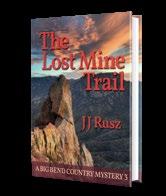
Park; and FBI special agent Lee Perciak. New faces include wealthy businessman Andrew Crane, who’s oddly interested in Ella and Barney’s radical activism in the 1960s. Unexpectedly, the reasons behind Ella’s strange reaction to her own assault and the near-fatal assault on Barney come to light early on; so does a revelation from a surprising source in regard to the event. Unusually for a mystery, Rusz also doesn’t keep the primary
culprit, or their motives, secret. A country singer’s fate may be rooted in the past, as well; the author informs readers of that motive for murder with genuine pathos. Meanwhile, Clayton and Claire’s mutual interest in solving the mysteries hints that a spark remains between them—and that a fourth book may be in the offing. A thoroughly entertaining tale in an authentic setting that’s as colorful as its characters.

These new audiobooks will get under your skin and keep you on edge.
BY CONNIE OGLE
THREE BRILLIANT readers team up to narrate V.E. Schwab’s mesmerizing sapphic supernatural novel, and each homes in on what makes the characters get under your skin in powerful and disturbing ways.
In Bury Our Bones in the Midnight Soil (Macmillan Audio, 18 hours and 26 minutes), three women are linked across centuries. Maria, poor but crafty and valued only for her ability to produce heirs, is sentenced to wed a wealthy, brutish man in 16th century Spain. Countrydwelling Charlotte is shipped off to London in 1827 to find a husband after a scandalous attachment to a friend.
Twenty-first- century Alice,
quiet and grieving, has left her home and tragedy behind in Scotland for a Boston university. In their attempts to escape societies that denigrate them, each finds that freedom comes with an unthinkable cost.
Veteran performer Julia Whelan takes on the role of Maria, who is at first resourceful and bold, then grows into a terrifying and malignant presence. Marisa Calin reflects Charlotte’s desperation over her future, which blinds her to the dangers ahead, while Scottish-born Katie Leung elicits waves of compassion for once-meek Alice, who is shocked to learn the sacrifices her new existence requires.
This is a supernatural novel, but it’s also a story about love and hunger, about the lengths to which women will go for revenge, to be valued, and to be at the mercy of nothing but their own desires.
Whelan is also one of two narrators on Taylor Jenkins Reid’s riveting love-andscience story Atmosphere (Random House Audio, 9 hours and 52 minutes), undoubtedly one of the best audiobooks of 2025. Atmosphere doesn’t fall into the thriller genre, but its suspense is almost unbearable, as Whelan and Kristen D. Mercurio bring their characters alive with deeply affecting emotions.
Set at the dawn of the space shuttle program in the 1980s, the narrative follows two storylines. In the first, would-be astronaut Joan Goodwin works her way through training, longing to be assigned to a space mission and bonding with fellow pilots and scientists, in particular Vanessa Ford, a magnetic engineer who dreams of flying the shuttle. In the second, a terrifying botched mission endangers its crew and threatens to destroy all Joan’s dreams.

The action alone will keep you on edge, but Whelan
and Mercurio’s performances infuse the dangers with gut-wrenching anxiety.
Listening to the 11th and final installment of Martin Cruz Smith’s Arkady Renko crime series is bittersweet, but for fans of these intelligent, intriguing novels about a Moscow detective, it’s an absolute must. The series, which began in 1981 with Gorky Park, ends with a chilling glance at life—and death—under Vladimir Putin.
Narrated by the terrific Jeremy Bobb, Hotel Ukraine (Simon & Schuster Audio, 6 hours and 16 minutes) takes place during the Russian invasion of Ukraine. Arkady, whose Parkinson’s disease is worsening, is trying to hide his physical deterioration from his superiors while investigating the murder of a diplomat that may be tied to a violent paramilitary group. Arkady’s illness and Putin loom as imposing twin dangers, one or the other sure to fell the detective before he’s ready. Bobb invests Arkady with a blend of world-weary pessimism and gallows humor, balancing his pragmatism with an unquenchable hope and helping Smith, who died in July, end his series on a perfect final note.
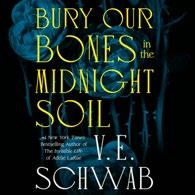
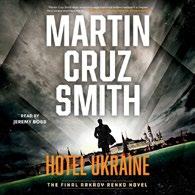
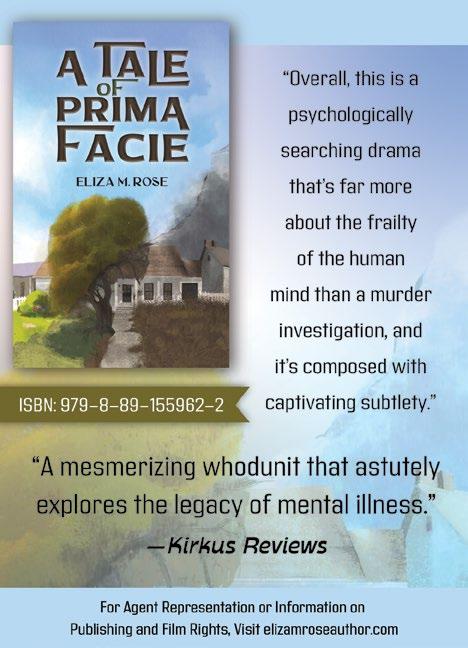
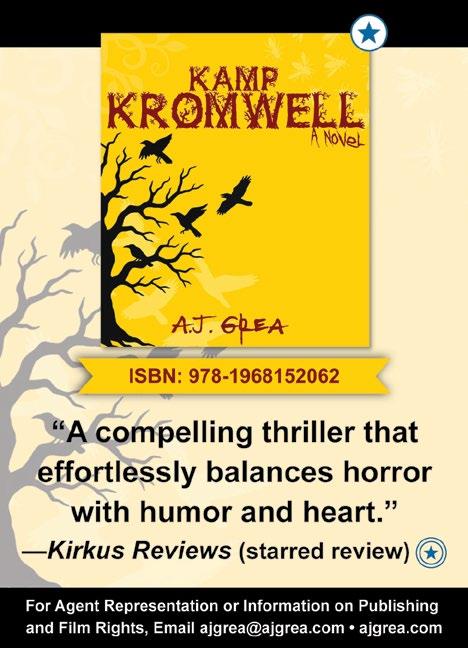
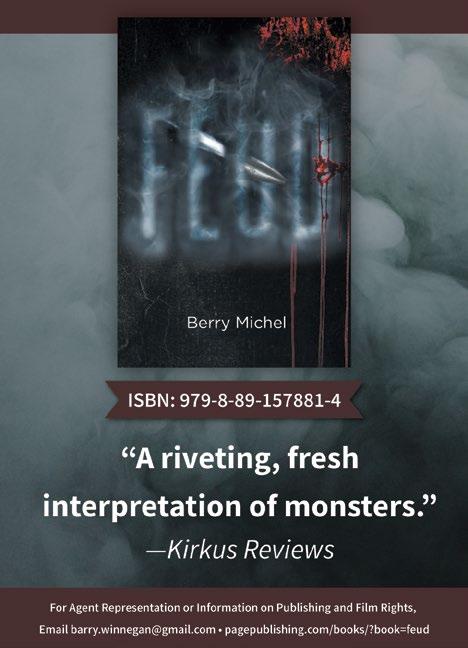

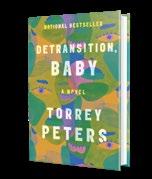
Tommy Dorfman will produce the adaptation of Torrey Peters’ debut novel.
Torrey Peters’ Detransition, Baby is headed to the big screen, with actor Tommy Dorfman set to produce, Deadline reports.
Peters’ novel, published in 2021 by One World/Random
House, follows three characters, both cisgender and transgender, whose lives intersect after one of them becomes pregnant. In a starred review, a critic for Kirkus called the book “smart, funny, and bighearted.”
The book, a national bestseller, won the PEN/ Hemingway Award and was shortlisted for the Gotham Book Prize, the Lambda Literary Award for transgender fiction, and the National Book Critics Circle Award’s John Leonard Prize for the best first book in any genre. Peters’ second book, Stag Dance, a collection of stories and a short novel, was published earlier this year.
The film adaptation will be produced by Dorfman’s Good Girl Productions, which launched in June. The company is also working on screen adaptations of Allie Rowbottom’s Aesthetica, Mariko Tamaki’s Laura Dean Keeps Breaking Up With Me, and James Frankie Thomas’ Idlewild
“When I read Detransition, Baby, Torrey Peters’ story instantly resonated with me,” Dorfman told Deadline. “The novel is smart, accessible, and filled with complex characters and plot lines never explored on screen. And like all the

For a review of Detransition, Baby, visit Kirkus online.
greatest stories, the story finds universality in its specificity.”
Dorfman shared news of the adaptation on her Instagram account, writing, “detransition, baby ! the movie ! seeking: writer/director”—M.S.
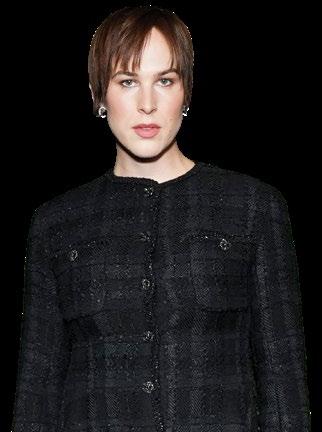

dive into the meaning of love adds gravitas to a complex mystery.
GULL & BONES
The Fracture
Cry, Morgan | Severn House (304 pp.)
$29.99 | November 4, 2025 | 9781448315550
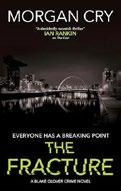
Ex–Glasgow copper Blake Glover, back in his depressing hometown of Fraserburgh driving a cab, finds himself in the middle of three different mysteries. The first involves Ray Cocklestone, whom Glover dropped off near the beach of Kinnaird Head a few minutes before the man drowned himself. Why did an aging farmer feel such a need to die? Was he simply unable to recover from his grief over the death of his only son in a car crash in Bulgaria three weeks earlier? The second comes into Glover’s view when he thinks he’s spotted a crack in the late Margaret Duthie’s coffin that the gravediggers seem unusually eager to conceal as she’s buried. How could the solid oak coffin Davie Duthie bought for his mother have been damaged so quickly and easily? Glover’s participation in both these cases is incidental, but he’s front and center when Mitch Campbell, another ex-cop whose friendship with Glover ended when he started to deal drugs on a grand scale, summons him to the prison visiting room and informs him that he plans to reduce his impending sentence by implicating Glover in his schemes unless Glover does him a little favor that turns into a big mess. Will “the Ray Riddle, the Coffin Curiosity and the Mitch Madness” turn out to be connected to each other? Against all odds, they will, and in a way that will work the seemingly impossible task of making
Glover’s disillusionment with Fraserburgh even deeper than before. Cry’s businesslike pace, which gathers steam as his hero moves from reflecting to reaping, makes every fracture worthwhile.
Goldenbaum, Sally | Kensington (352 pp.) $27 | November 25, 2025 | 9781496747211
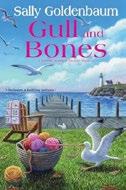
The Seaside Knitters investigate the murder of someone close to their hearts. Angus McPherron, a beloved resident of Sea Harbor, Massachusetts, who used an unexpected inheritance to benefit the town, is approaching his 100th birthday. A huge birthday party has been planned, including the whole town but especially his closest friends, Harry Garozzo, Gus McGlucken, Henry Staab, and Jake Risso, who with Angus are known as the fab five. When Angus is found dead just before his birthday, everyone seems devastated. But his party goes on until the knitters find Angus’ friend Father Lawrence Northcutt wounded and clinging to life. The attack encourages police Chief Jerry Thompson to order an autopsy on Angus to confirm that he died of natural causes, but it discloses instead that he was poisoned. Enter the Seaside Knitters: Birdie Favazza, an octogenarian whose wise counsel has helped solve many a murder; Nell Endicott, a retired nonprofit director; her niece, Izzy Perry, whose store, Sea Harbor Yarn Studio, provided the impetus for the knitting group; and Cass Brandley, who owns a
lobster company. Although the Knitters have been involved in several murders, this one may prove their most difficult, since most of the suspects are old friends. The exception is Annie Smith, an attractive and talented woman who showed up in Sea Harbor and grew close to Angus. Annie, who shares a house with Izzy’s younger brother, nurse Charlie Chambers, is an enigmatic figure who made special teas for Angus. When the knitters start looking into other residents, they find cracks in what seemed like perfect friendships. A deep dive into the meaning of love and friendship adds gravitas to a complex mystery.
Grisham, John. | Mysterious Press (504 pp.) $17.95 paper | September 23, 2025 9781613166840
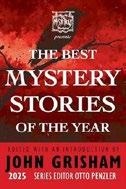
This year’s collection offers tales that capture the readers’ attention with “colorful, poetic, and original” takes on one of the oldest human pursuits—crime.
Editor Grisham points out that as “mankind’s first crime,” murder holds a fascination for readers that no other misdeed can match. So it’s appropriate that no less than 18 of the 20 stories include a killing, contemplated or committed. But murder is not always the main event. Often the tricky part is figuring out how not to get killed, as in Casey Stegman’s “Effie’s Oasis,” Tracy Falenwolfe’s “Jamming at Jollies,” and Billie Livingston’s “Same Old Song.” And as series editor Otto Penzler points out, deduction and detection have in recent years taken a back seat to what he calls “the psychology of crime.”
Stories like Erika Krouse’s “Eat My Moose” and April Kelly’s “The Art of Disappearance” place the delicacy of human relationships front and center. Family ties also loom large, as in
Shelagh Smith’s “Snapshot” and Tom Larsen’s “The Other Brother.” And marital strife is always a motivator for misbehavior, as in James Hearn’s “Totality,” Craig Faustus Buck’s “Home Game,” and Sean McCluskey’s jolting “The Secret Menu.” This year’s volume fulfills its promise of originality while honoring the time-tested formula for good mysteries: It shows readers characters they feel they know and care about doing things they couldn’t possibly have anticipated. Hits the spot.
Hall, Traci | Kensington (304 pp.) $17.95 paper | November 25, 2025 9781496754677
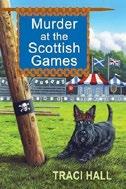
A young woman’s business is in better shape than her private life. In addition to dealing with her moody teen son, Brody, and her stubborn granddad, Paislee Shaw finds her shop, Cashmere Crush, busy with the summer influx of tourists to Nairn, in the Scottish Highlands. As a volunteer for the upcoming Highland Games, she’s lucky to have part-time help: Her newest hire, Rhona Smythe, is working to repay her parents for the speeding tickets she’s amassed. Rhona’s into Highland Dance, and her boyfriend, Artie Whittle, is involved in several events, including the caber toss, which involves throwing a tapered log of about 16 feet long. At the games, all kinds of last-minute problems arise, including rumors of steroid use. When someone gives Artie a bit of slippery oil instead of resin for his hands, his toss ends in disaster and his caber splits. Artie’s older brother was on his way to becoming a professional strongman before he died in a car accident, and their father is a rage-filled taskmaster who constantly puts Artie down. A couple of days later, Paislee takes Rhona to Artie’s house when he fails to answer repeated
phone calls, and they find him unconscious on the lawn, covered in the blood of his father, who’s dead in the kitchen. Artie is naturally a suspect, but he has plenty of competition, for Joseph was not only a bad father but also a serial cheater and a seller of steroids. DI Mack Zeffer, who’s met Paislee on other murder cases, listens attentively when she says that Artie’s innocent. Although Paislee’s in love with the handsome, wealthy detective, she refuses to become involved until Brody turns 18. Unexpected revelations long before then break the case and change her life.
Scots lore, a bit of humor, and plenty of suspects make for a lively mystery.
Hobbs, Elizabeth | Crooked Lane (336 pp.) | $29.99 | November 11, 2025 9798892423236

Marigold Manners is determined to make her way in a world that devalues women. After meeting a family she never knew she had, solving a murder, and escaping death in Misery Hates Company (2024), Marigold returns in 1894 to Wellesley College, where she hopes to complete her dream of a college education using the money she made selling her story to The Argosy magazine. Her friend Isabella, a high-end couturier, still wants her to wed Jonathan Cabot Cox, a well-connected lawyer she’s already turned down despite her love for him because she refuses to be hemmed in by the strictures of marriage. Invited to row for the seniors, she joins them at the lake, where she discovers a body partly hidden in the water. Spotting a hat she thinks belongs to a friend, she bravely enters the frigid water to bring the body to shore, where nobody recognizes the young woman. Marigold’s accused of murder by her distant cousin and enemy Sarah Appleton, who knows of her tangled family history, but the campus doctor notes that the victim was strangled by
someone with much larger hands. Marigold feels impelled to investigate the death, which soon becomes well-known after a story in a tabloid paper suggests that the girl killed herself because she was pregnant. Since the local watch officers are useless, Marigold makes a bargain with the handsome, charming reporter who wrote the story, but he doesn’t hold up his end of the deal. The body is finally identified as that of a brilliant local girl, niece of a Wellesley professor, who was thought to have run away to England with an unsuitable man. With the help of many people, Marigold unravels a complicated plot. A fascinating sleuth whose dramatization of the dilemma of an educated woman in the 1890s adds to the allure.
Kelly, Vanessa | Kensington (416 pp.) | $27 November 25, 2025 | 9781496746009

Murder and mayhem in Jane Austen’s world. Emma Woodhouse Knightley has given up matchmaking for marriage and a peaceful life catering to the whims of her father, who imagines that sickness and death lurk around every corner. When Mr. Woodhouse announces that he’s marrying Miss Bates, it’s a major shock to Emma; her sister, Isabella; and their husbands, brothers George and John Knightley. Although they’re not pleased, they go along with the couple’s plans, including a ball at Donwell Abbey, George’s home, which is in the process of being upgraded so that he and Emma can live there. Donwell’s staff is currently limited to Mr. Larkins, the estate manager; Mrs. Hodges, the housekeeper; chambermaid Prudence Parr; Harry Trotman, a rather dim footman; and a few stablehands. With some outside help, however, they manage to pull together a dinner and ball for a disparate group of guests. Except for one drunken visitor, all goes well until Prudence apparently falls to her death
from the window in her room. The coroner and Constable Sharp smell spirits on her body even though Prudence did not imbibe. They think her death an accident or suicide, but Emma’s not convinced. When smugglers are discovered to be using a path through Donwell’s lands, Constable Sharp gets an anonymous note accusing Larkins of being involved. He arrests him after a search turns up evidence of smuggling and possibly the murder of Prudence. George, a magistrate, and John, a lawyer, set out to prove Larkins innocent. But it’s Emma, with the unlikely help of Miss Bates, who uncovers the truth, at risk to their lives.
Plenty of interesting Austen-inspired characters make for a charming read.
Klavan, Andrew | Mysterious Press (312 pp.) | $26.95 | October 28, 2025 9781613166864
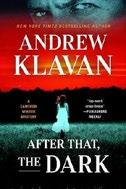
A retired hit man’s wish to impress his new love leads him back into a thicket of crime and corruption. During the dinner date they’re finally going out on, Chicago area therapist Gwendolyn Lord shares with English professor Cameron Winter a story she’s just heard from forensic psychologist Livy Swain, an old school friend, of an impossible crime. Owen McKay, arrested six months ago for killing his wife and son and crying, “It’s still there! Still there!,” was shot to death with a nail gun inside his closely watched prison cell. Though his initial reaction is idle curiosity, Winter resolves to show off his prowess to Gwendolyn by solving the mystery. Dr. Billy Whitefield, the pathologist who conducted the postmortem on McKay, shares with Winter a monstrous revelation that he’s been blackmailed into concealing: He removed a spidery attachment from McKay’s brain whose existence was deleted from the official
report. After a friend at his college links the implant to Thaumatix—a company whose motto is “We’re in the business of miracles”—Winter learns of another case that sounds eerily similar: the kidnapping, rape, and murder of a Connecticut high school student by a previously inoffensive carpenter who’s killed before Winter can question him. Surrounded by assassins and amoral corporate overlords, Winter leans more and more into his relationship with Gwendolyn, though the person he most wants to talk to is the Recruiter, the nameless boss he trusted to make life-or-death decisions when he worked as a contract killer. Miraculously, the Recruiter, who’s vanished, returns to Winter’s life. But what if he can’t be trusted any more than everyone else? Fans will relish every high-energy moment without demanding rational explanations for every detail.
The Red Scare Murders
Lehane, Con | Soho Crime (400 pp.)
$29.95 | November 4, 2025 | 9781641297202
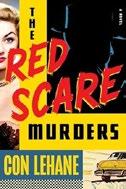
Leaving behind the quiet yet murderous settings of Murder at the College Library (2024) and its predecessors, Lehane’s most impassioned and ambitious novel plunges into the anti-communist frenzy of 1950. Mick Mulligan was fired from his job as a Disney animator when he refused to name names to the FBI. Now that his wife has left him and taken their toddler daughter, he’s hung out his shingle as a private eye. When Duke Rogowski, president of the United Taxi and Limousine Drivers, asks Mick to reopen the case of Harold Williams, a Black communist on death row for shooting his boss, cab company owner Irwin Johnson, Mick’s intrigued by the call. But he has questions of his own. What possible leads can there be that the police haven’t already investigated? Why did
Duke wait a year after Williams’ conviction to make this move, only two weeks before his scheduled execution? And how can Mick tack between the wishes of Duke’s two vice presidents, self-identified communist Sol Rosen, who’s eager to see Williams exonerated, and mob boss Vincent Forlini, who’s firmly opposed to troubling the waters?
The more deeply involved Mick gets with the richly detailed cast of interested parties—rabid anti-communists, communists and socialist organizers of every stripe, FBI informers, and three beautiful women: Duke’s wife, Cynthia; Johnson’s widow, Eva; and Elena DeMarco, the sister of Williams’ co-worker and friend—the more he realizes that the conflicts that led to Johnson’s murder are a lot more complicated than J. Edgar Hoover evidently assumes.
Consistently more powerful in its exploration of the Red Scare than in its invocation of contemporaneous noir tropes.
Lindsey, Erin | Severn House (336 pp.) $29.99 | December 2, 2025 | 9781448315222
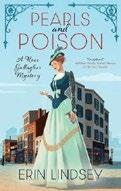
Former housemaid Rose Gallagher, now a Pinkerton agent, is on her own this time as she investigates criminal paranormal activity in New York.
In 1887, Rose is drawn into a dangerous new case with no help from her mentor—Thomas Wiltshire, her professional partner and the man she loves, has suddenly transferred to San Francisco, leaving her adrift in Manhattan. Luckily, the friends she’s made among wealthy society people through her previous investigations include Thomas’ best friend, Jonathan Burrows. She’s learned that many of the elite New York families have what they call “luck,” a psychic talent that enables them to succeed where others fail. Now Sgt. Chapman of the NYPD comes to Rose with a case involving several suicides
that he thinks are murders involving paranormal activity. The victims—who don’t seem to have any connection to each other—apparently died from drinking poison in an empty building on Pearl Street, which has some very odd symbols built into the wall. The clients paying Rose’s bill are the wealthy parents of one of the victims, Deckland Woods. As Rose begins investigating, she asks Jonathan for help because he has “luck” and many useful contacts. The next person she approaches for help is Nikola Tesla, who’s alarmed by the possibility of real danger resulting from electromagnetic radiation in the building. Also of use are her friend Mei Wang and her father, who are being harassed by the Italian mob. As Rose looks for answers in the mean streets of New York and the parlors of high society, she realizes that she’s not the only one trying to discover what the symbols mean and what power they possess.
Nicely combines history, mystery, romance, and paranormal thrills.
Malliet, G.M. | Severn House (256 pp.) $29.99 | November 4, 2025 | 9781448314737
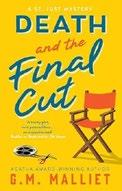
A film crew comes to the hallowed city of Cambridge, England, bringing in its wake disruptions, secrets, lies, and murder.
The most notable feature of the team making Viking Bride is the number of failed actors it includes. One of them, Ernest Eastman, is producing the film. Another, Alain Vernon, is directing. Still another, Devon Ashleigh, is the prop master—or, as he prefers to be called, the properties director. All of these are upstaged by Agnes Dermont, the star, whose failure is in the present tense: “She was never a great actress, but she was turning into a terrible one.” The only reason Agnes, who’s pushing 50, was cast as the Viking bride is that she’s married to Alain Vernon, who’s clearly miscalculated badly in seeking to
Matsumoto’s 1958 debut is credited with launching the mystery genre in Japan.
TOKYO EXPRESS
establish himself as a force in the industry by helming a vehicle for his over-the-hill wife. So Agnes’ fatal stabbing by a prop knife while she’s in full costume in Cambridge’s Round Church proves a stroke of luck for many participants who’d feared she’d sink the production. The most obvious beneficiary is Magritte Grimes, the bride’s younger sister, Agnes’ unofficial understudy, and the performer who should have been cast in the title role from the beginning. Cambridgeshire DCI Arthur St. Just, who’s looking forward to his wedding to crime novelist Portia De’Ath, questions the interested parties fully aware that they differ from the suspects in most of his investigations because they’re “such renowned, professional liars.” Soon enough, the obligatory jealousies, rivalries, hidden romances, and blackmail attempts rise to the surface, making everyone look guilty. But fans will have no trouble spotting the killer even before the seasoned St. Just.
A routine, professional whodunit providing yet more evidence that filmmaking is murder.
Matsumoto, Seichō | Trans. by Jesse Kirkwood | Modern Library (176 pp.) | $18 paper | October 14, 2025 | 9780593979044

Police rule it a double suicide. Investigators are not so sure, and probe. Several servers at Tokyo’s comfy Koyuki restaurant are surprised to see co-worker Toki engaged in intimate conversation with a
handsome young man on a train platform. True, it’s customary for waitresses to meet with customers outside the restaurant, but Toki keeps to herself at work and never flirts with customers, not even her dedicated regular, industrialist Tatsuo Yasuda, who always requests her. Not long after, Toki and a man identified as Kenichi Sayama are found dead on Kashii Beach, many miles from the city. The undisturbed corpses and the presence of cyanide seem to indicate a double suicide. Police Detective Torigai, who’s skeptical of that ruling, moves forward in small, measured steps. When Kiichi Mihara, investigator with the Second Investigative Division of the Tokyo Metropolitan Police, which examines white-collar crimes, offers to work with Torigai, the inquiry gains traction and accelerates. A key piece of evidence is Sayama’s involvement in a bribery case that’s been compromised by his death. Originally published in 1958 and sometimes called Points and Lines, Matsumoto’s debut novel is credited with launching the mystery genre in Japan. The story is built on the meticulous examination of data; timelines and maps and train schedules figure prominently. Its underlying message about malignant corporate growth in the aftermath of World War II adds poignancy and raises the novel above the genre’s parameters.
A tidy vintage whodunit with a forensic flavor.

For more mystery reviews, visit Kirkus online.
McPherson, Catriona | Severn House (256 pp.) | $29.99 | December 2, 2025 9781448312863
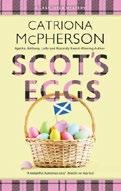
A loopy, lovable Northern California crew stops arguing among themselves just long enough to solve a baffling double murder.
Marriage counselor Lexy Campbell, newly wed to amiable ornithologist Taylor Aaronovitch, is barely awake when she hears the clumsy cop Plocky knocking on the bathroom door of the houseboat the couple calls home. Close behind is Molly Rankinson, Lexy’s friend and a sergeant with the Cuento Police Department. For readers new to this long-running series, McPherson helpfully introduces a coterie of quirky sidekicks in the opening pages. The houseboat sits behind the Last Ditch Motel, owned by Noleen and her wife, Kathi, who moonlights as a private investigator. There’s also boisterous Todd and his pediatrician husband, Roger, and a third couple, Della and Devin, blessed with children but living a hardscrabble life in the motel. And there’s the late tourist couple Bill and Billie Miller, whose murder is shrouded in mystery or, more accurately, in the confusion provided by the comic intrusion of the pack of amateur detectives. The tart first-person narration of Scottish immigrant Lexy provides much of the humor, but the supporting cast does what they can to support her wackiness. In short order, the couple’s children, twins Phil and Jilly, arrive along with Tilly the dog. A turning point comes with the discovery of the Millers’ abandoned car at the newly opened Patsy Denoni Museum of Art car park. The mystery is tangled but clever, with more offbeat characters arriving at every juncture. It all culminates with the threat of a shootout that’s avoided by the timely arrival of police cars. A brisk, clever whodunit that bubbles with banter.
Mitchell, Saundra | Morrow/HarperCollins (352 pp.) | $18.99 paper | January 6, 2026 9780063439290
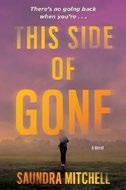
A Maryland teenager’s disappearance coaxes a retired cop back into the chase.
Vinnie Taylor has good reason to choose an isolated cabin in the woods outside of tiny Wills Harbor as her retreat after testifying against her corrupt fellow officers back in Indianapolis. Her former colleagues’ threats of violence have proved all too real. But a conversation she overhears in Henk’s general store between high schoolers Hannah Candlewood and Tyler Purnell puts her on notice that danger can lurk even in a small town. When she gets home, Vinnie finds a note from Hannah scribbled on her receipt accusing Tyler of killing their classmate Avery Adair, who disappeared weeks ago. The local police have written Avery off as a runaway. But Vinnie’s big-city-cop instincts tell her that if Avery is still alive, she’s in grave danger. Little by little, she gets drawn into an investigation she has no legal right to conduct. Mitchell’s writing is crisp and sharp. Her lively dialogue brings her characters to life, warts and all. But her loose plotting can leave readers feeling lost. Is Vinnie ever going to pick up that stray cat she left at the vet chapters ago? What about that drug deal Avery was about to do with her cousin Red? Will the suspects she interrogates realize that she has no official standing? Wait…what? That missing teenager seems not to be the only thing lost in the woods.
Shames, Terry | Severn House (256 pp.)
$29.99 | December 2, 2025 | 9781448316281

A small-town Texas police chief has his hands full with problems both personal and professional. Samuel Craddock is still reeling from his breakup with girlfriend Wendy Gleason, who recently rekindled her romance with Marshall Pritikin, an old flame from high school. But the appearance of mysterious trucks carrying loads of assorted waste and dumping them on land just outside his Jarrett Creek jurisdiction is also a concern, sending danger signals he can’t ignore, yet doesn’t have the authority to investigate. All he can do is poke around the site and ask questions the people who seem to be in charge don’t have to answer. While he’s keeping an eye on the dump site, he hears some gossip that a woman named Lily Barnes has been accusing her twin sister, Jewel, of poisoning her, so he checks in with their older sister, Hannah, to see what he can find out. Add to the mix Wendy’s daughter, Jessica, who thinks Pritikin may be scamming her mom. Samuel’s problems come to a head when Jewel, not Lily, dies by poisoning. It takes a bit of time, but Samuel is eventually able to decide where to focus his energy. In an age of unreliable narrators and conflicted narration, his straightforward approach to sleuthing is a breath of fresh air. He interviews suspects with admirable objectivity and collects evidence wherever he can find it, uncovering a plot as credible as it is complex.
Another win for patience and persistence over flash and clash.
A Maryland teen’s disappearance coaxes a retired cop back into the chase. THIS SIDE OF
At Midnight Comes the Cry
Spencer-Fleming, Julia | Minotaur (320 pp.) $29 | November 18, 2025 | 9780312606862
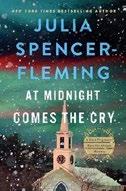
Upstate New York Episcopal priest Clare Fergusson and her husband, Russ Van Alstyne, observe the four Sundays of Advent by hunting for missing persons, seeking justice for a murder, and neutralizing an unusually well-planned example of domestic terrorism.
“Keep America’s Christmas white,” announces a banner unfurled at the height of the Greenwich Tractor Parade. Millers Kill alderman Ron Tucker tussles with Rick Smith, the white nationalist contractor responsible for the offensive message, but of course that doesn’t solve anything. Neither does the civil conversation Clare attempts with Rick’s wife, Meghan. Since Russ has been forced to resign from his job as Millers Kill police chief, he has no official standing in the conflict. Nor is he eager to join Officer Hadley Knox’s search for Kevin Flynn, her ex-colleague and secret lover, who vanished from his new job in the Syracuse PD more than a month ago. But Hadley talks him into joining her, and they learn from Assistant State Attorney Yíxīn Zháo that Kevin isn’t AWOL but undercover with Knox’s Noble Train, a local militia linking Rick Smith to some seriously bad guys. Soon after they cross paths with ranger Paul Terrance, who’s searching for his uncle, ranger Pierre Laduc, they get hard evidence that not every search for a missing person has a happy ending. Working separately in their very different ways, Clare and Russ cobble together whatever alliances they can to help them thwart a violent act of sabotage the Noble Train plans to unleash on a holiday crowd.
Both franchise heroes, far from their comfort zones, are outshined by teams that aim to stop a startling holiday surprise.
Van Dine, S.S. | Pushkin Vertigo (394 pp.) $18.95 paper | November 25, 2025 9781805335368
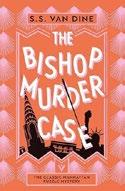
Philo Vance’s fourth case, originally published in 1929, features a serial killer whose playbook is from Mother Goose. In case there was any doubt that Joseph Cochrane
Robin’s death by arrow was inspired by the fictional death of Cock Robin, a note makes the connection explicit and implies that the killer was Raymond Sperling, whose last name means “sparrow.” Who is THE BISHOP, the phantasm who signs this and later messages? Vance’s friend and amanuensis Van Dine, the most self-effacing narrator in the mystery genre, reveals in advance that this sobriquet has nothing to do with religion. Most of the leading suspects—Sperling, retired Prof. Bertrand Dillard, his adopted son Sigurd Arnesson, his niece Belle Dillard, and scientist Adolph Drukker—pass the time till the next fatal incarnation of a nursery rhyme chatting about mathematics and theoretical physics. It’s particularly helpful that Arnesson talks himself into an active role into the investigation along with Vance, Sgt. Ernest Heath, and D.A. John F.-X. Markham, who casually accept his participation. Arnesson takes the edge off detective fiction’s most irritating sleuth by managing to be even more flippant about murder than Vance, who calls the series of homicides that follow “a kind of Juvenalian lark” and finds time to entertain his companions with a long list of virtuous suicides that includes Aristotle and Judas Iscariot. Despite all the implausibilities, the plot here is Van Dine’s strongest, with clues that are logical (though not always readily accessible to the unlettered), a plausible motive and a compact windup with a highly satisfying final twist. All in all, the finest of the dozen whodunits that mysteriously catapulted their author to the bestseller list.
Wegert, Tessa | Severn House (288 pp.) | $29.99 | November 4, 2025 9781448315062
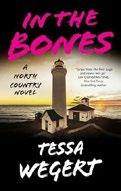
Wegert launches a new series exploring the seamy underside of Cape Vincent, a village in New York’s Thousand Islands. It begins with a rash of inconsequential burglaries from vacation homes whose owners have just returned for the summer—a bikini and two pairs of jeans from one house, a bottle of wine and a jar of peanut butter from another. Although it’s hard for New York State Police Investigator Tim Wellington and his colleagues to take the outbreak seriously, things seem very serious indeed for housecleaner Nicole Durham, whose Realtor friend Stacy Peel has helped land a big fish new client, ex–hockey star Mikko Helle, who’s about to move into a princely place contractor Terry Martino has renovated for him. Like Mikko’s girlfriend, Eva Ki, Nicole hears suspicious sounds as she moves from room to room. Then she finds a message scrawled in the dust she’s cleaning: “I’m watching.” When Tim arrives and flushes out the intruder, who calls herself Jenny Smith, she leads them to an even creepier discovery in a secret compartment in the basement—the decaying body of another woman— before she disappears again. As Tim marshals his forces to track her down and find out what else she knows, Nicole struggles to put on a happy face for Blair and Alana, her teenage daughters, and Woody, the husband who’s jeopardized the family’s future by engaging in all kinds of questionable behavior that are slow to emerge. Wegert expertly casts suspicion on one character after the next, but the climactic reveal is likely to take even the canniest readers by surprise. The piercing family melodrama and all-too-human detective provide deep roots for the mystery. Here’s to the promised sequels.
This review originally ran in the January 15, 2024, issue.
A former CIA operative enjoying a well-deserved respite is drawn back into the treacherous world of espionage in Scott’s thriller. This second installment in the Max Geller series begins in January 2020: Max has returned to Russia, risking his life to save Vanessa, the woman he loves, when Rodney, his former CIA boss, uses her as a pawn to manipulate Max into smuggling out a potential defector with critical information vital to U.S. national security. Max, a wanted man after his exploits during his previous incursion into Russia, is hunted by the Russian authorities, and whether the defector truly exists is
uncertain—could he be a lure to draw Max into the clutches of his archnemesis, FSB Lieut. Col. Konstantine Zabluda? After Max takes the mission to save Vanessa, he’s thrown back into a game of cat and mouse in which his survival and the very fate of the world hang in the balance. Scott’s spy thriller is a sequel to The President’s Dossier (2020), Max’s previous adventure, but it can be read as a stand-alone story. The plot-driven novel is propelled by a web of intrigue that spans continents, with plenty of twists and turns (who, exactly, is Max’s true enemy?). The tension grows palpable as Max navigates a labyrinthine world of defectors, blackmailers, and adversaries both within
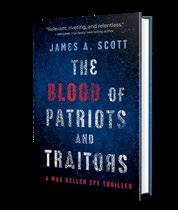
Scott, James A.
Oceanview Publishing | 320 pp. | $27.95 | $18.99 paper
February 21, 2023 | 9781608095261 | 9781608096053 paper
Russia and the United States; the narrative provides a roller-coaster ride of action sequences and narrow evasions (“Spying is a game of using people. Nobody escapes, not even the puppet masters”). Less enthralling is the somewhat superficial romance subplot. The relationship between Max and Vanessa, while presumably central to the storyline, is not developed sufficiently for readers to understand Max’s
motivations. Their connection, though pivotal in guiding Max’s decisions, lacks depth and emotional resonance. The novel’s strength lies in its excellent pacing and intricate construction of shadowy geopolitical machinations—a strength that ultimately proves to be rather topical.
A plot-driven thriller that misses deeper emotional nuances but hits the sweet spot of global intrigue.
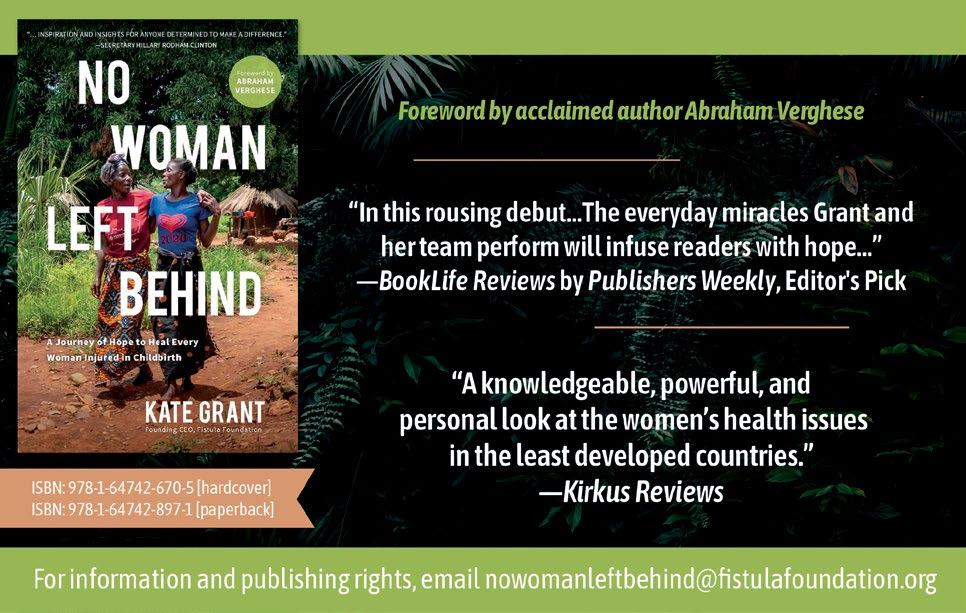
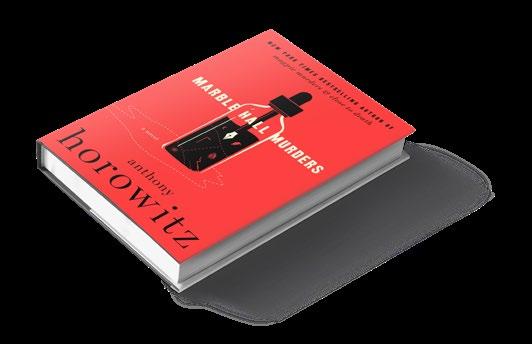
1 Marble Hall Murders
By Anthony Horowitz
Horowitz’s most extended and intricately plotted yet—at least until next year.
2 The Mysterious Case of the Missing Crime Writer
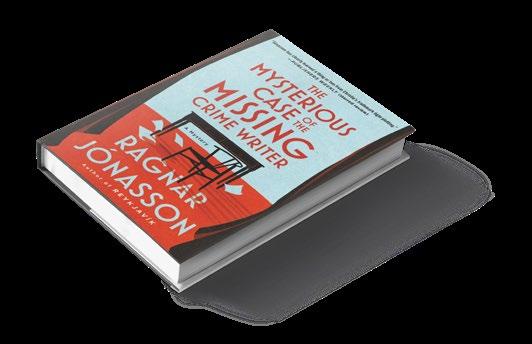
4 A Novel Murder
By Ragnar Jónasson;
Cribb
A lightning-fast read for fans willing to keep turning the pages till the crucial clues drop. 3 Grave Words
By Gerri Lewis
An engrossing mystery with plenty of engaging characters and a romance fraught with trust issues.
By E.C. Nevin
An appealing cozy star is born.
5
Buried Above Ground
By Mike Ripley
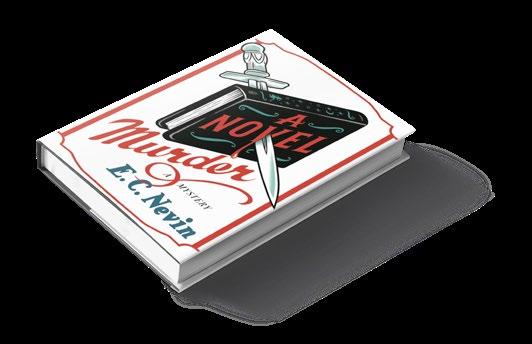

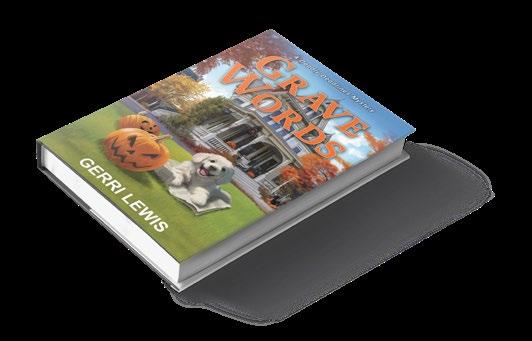
Ripley’s best book: a wickedly funny sendup of the clichés behind all those classic mysteries and their successors.

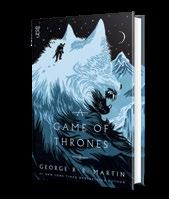
The Game of Thrones author was asked if he’d allow another writer to finish the fantasy series.
A Game of Thrones fan confronted author George R.R. Martin at the science fiction convention Seattle Worldcon, asking if he would consider letting someone else write the remaining books in his popular series, Screen Rant reports.
A Song of Ice and Fire, which kicked off in 1996 with A Game of Thrones,
is one of the most celebrated fantasy series in the world. Martin has published five novels to date, most recently A Dance With Dragons in 2011, and has two more planned: The Winds of Winter and A Dream of Spring
The novels were adapted into the blockbuster HBO show Game of Thrones , which ran from 2011 to 2019. Fans have long clamored for the next book installment; Martin has repeatedly said he’s still writing it.
Martin was part of a Worldcon panel of fantasy authors including Brandon Sanderson. Toward the end of the event, a fan addressed Martin, 76. “Here’s the thing. George, you’re not going to be around for much longer.” The audience, stunned, reacted with dismayed gasps.
“And this is a tough question that I wanted to ask,” the fan continued. “This is more directed at Brandon, I was wondering, like, how would you feel about someone else taking over and finishing the books?”

Sanderson said, “Not me,” as the panelists stood up and left.—M.S.
George R.R. Martin

For reviews of the Ice and Fire books, visit Kirkus online.
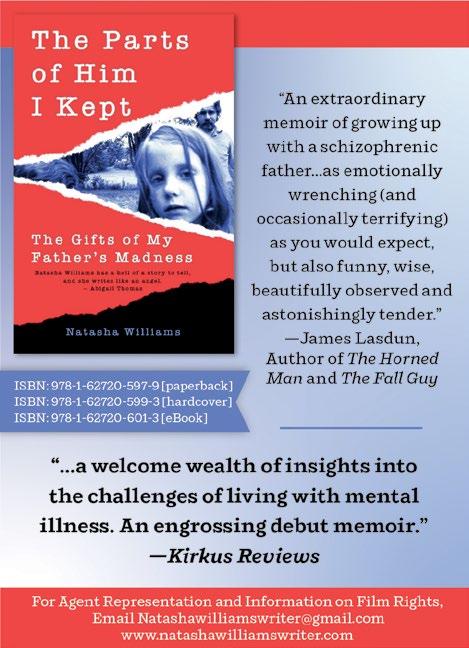
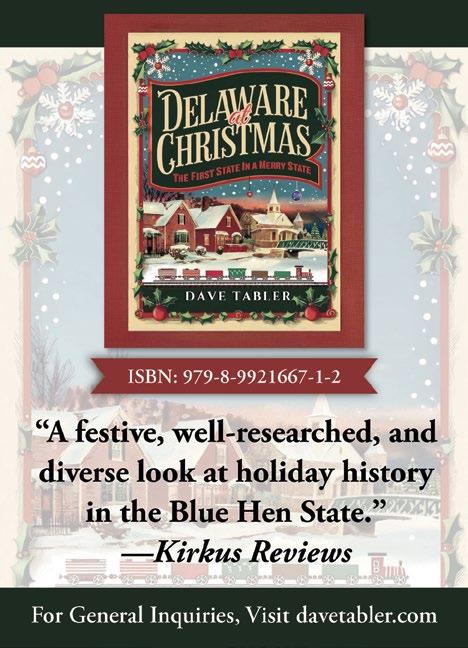
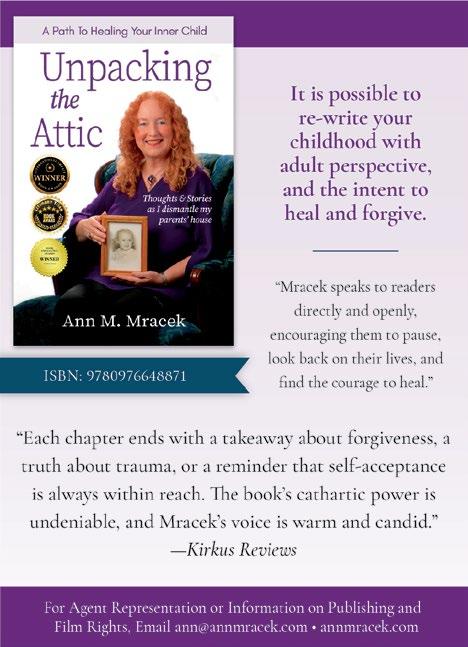

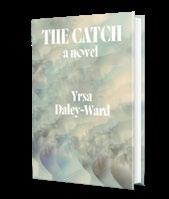
The first novel by poet Yrsa Daley-Ward was published this summer.
Yrsa Daley-Ward’s The Catch is headed to the small screen, Deadline reports. Daley-Ward’s novel, published in June by Liveright, is the first novel in the Well-Read Black Girl Books series. It follows twin sisters, Clara and Dempsey, who were raised in different families after their mother’s disappearance; they reconnect after Clara spots a doppelgänger of their mother shoplifting at a department store. In a starred review, a critic for Kirkus called the book “elegant and unpredictable in the best possible way.”

The production company Osun Group (Stay Close, Supacell ) optioned DaleyWard’s novel. The author will be among the series’ executive producers.
“The Catch asks, ‘What if the person you fear most and the person you long for most were the same?”
Daley-Ward told Deadline “I’ve often wondered what it would be like to meet my mother again, not as she was, but as I am. The TV adaptation takes that unsettling question and spins it into an edgy, psychological suspense about family, obsession, and the terror of recognition.”
Sheila Nortley of Osun Group said, “Yrsa’s storytelling has a way of getting under the skin and holding a mirror up to our most uncomfortable truths. To have such a bold and inventive novel as our first scripted adaptation at Osun Group is both an honor and a statement of intent. I can’t wait to bring it to the screen.”—M.S.

Yrsa
Daley-Ward
Kirkus Star
Ashing-Giwa, Kemi | Saga/Simon & Schuster (480 pp.) | $20 paper November 4, 2025 | 9781668061015
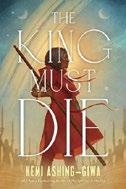
Three rebels and the heir apparent to a corrupt, globe-spanning empire team up to save the world. The crimes of her fathers have colored Fenyyang Mekantai’s whole life. She was 6 years old when the rebellion her parents attempted to foment went awry, leaving them under house arrest. After 20 years spent training as a bodyguard under a magistrate, Fen decodes a message containing a horrible truth: Her fathers are dead, and the Sovereign wants her foster father to kill her. The message launches Fen down the path to rebuilding her parents’ legacy, starting with joining the Broken Masks—the handful of freedom fighters who remain after the quelled rebellion two decades ago. After months of training, she winds up one of only two survivors in a deadly clash between the Masks and a troop of imperial soldiers. The other is Alekhai, the Sovereign’s younger brother. Gifted with the ability to revive the dead, the princeling agrees to resurrect some of Fen’s fallen comrades in exchange for her assistance with his own mission, one aimed at getting his brother off the throne and ushering in an age of democracy. Ashing-Giwa has created a world run by imperial technocrats who bleed their planet dry of its resources at the expense of their poorer neighbors’ lives. Although the technology sometimes feels indistinguishable from magic, the novel is deeply rooted in science fiction, and it never strays too far from those roots. The author’s prose is crisp and clean, even when the story meanders toward the gory. The cast is diverse; Fen and most of her friends are coded as Black. One secondary character is Asian-coded, although there is no “Asia” on Fen’s home planet of Newearth.
Alekhai is of indeterminate race and is trans-coded. A bold and refreshing new SF adventure from one of this generation’s writers to watch.
Emshwiller, Carol | Third Man Books (290 pp.) | $19.95 paper | August 5, 2025
9798989908936
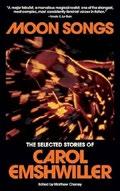
A greatest hits collection of unclassifiable speculative fiction. How do you condense a 60-plus-year writing career into just 19 stories? For this lovingly curated retrospective of short fiction from Emshwiller (1921-2019), you identify the motifs that make these tales stunningly prescient (especially those published in the 1950s), and then you put your personal mark on them. Kelly Link’s foreword shares fond memories of the writer, while Matthew Cheney contextualizes his keen choices in an editor’s preface. Duos drive much of the tension and catharsis here, from siblings competing over ownership of alien creatures in “Moon Songs” and “Mrs. Jones” to shadowy doubles stalking their neighbors in the equally creepy “Sex and/ or Mr. Morrison” and “I Live With You and You Don’t Know It.” Rescue is a key theme for child soldiers (“Boys”), the eponymous “Bird Painter in Time of War,” and for the retired superhero “Grandma,” who struggles to pass on her ethos to an unremarkable granddaughter. The book’s sections are set off by quotes from Emshwiller. One proclaims her love for unreliable narrators; another disclaims any intention to provide “meaning,” asserting, “I just try to write a good, well-formed story.” And she does just that, establishing eerie atmospheres in mere handfuls of words, often and most effectively through a set of characters encountering something out of
their norm—alien, or wrong, or just different—which in turn draws the inhuman out of them. Her final published story, the post-apocalyptic “All I Know of Freedom,” closes the collection with grim hope that resonates long after its 2012 publication. This compellingly assembled retrospective gives longtime Emshwiller fans a chance to savor her unique sensibility again, while lucky newcomers enjoy the thrill of discovery. Wickedly astute and surreally funny.
Stewart, Andrea | Orbit (448 pp.) | $30 November 4, 2025 | 9780316564830
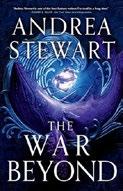
The second installment in Stewart’s Hollow Covenant trilogy continues the impressively epic narrative set on a world where magic has been all but destroyed and gods and mortals battle for survival, supremacy, and freedom.
After mortals selfishly—or ignorantly—“broke the world” (called the Shattering) by the deforestation of all the giant Numinar trees for their magic (and inadvertently destroyed the gods’ subterranean realm of Unterra), the self-proclaimed “one true god” Kluehnn set out on a mission to kill all the other gods, punish the mortals, and restore the world in his vision. But not all the gods are dead—some have been in hiding for centuries—and Kluehnn’s bloody grand plan has increasing opposition. Revolving in large part around the fractured relationship between two sisters, Hakara and Rasha, who were separated when their realm was restored—killing half of the inhabitants and turning some into “altered” beings (with any combination of fur, wings, horns, tails, etc.)—the storyline gains scope and depth with multiple points of view, which also includes Mullayne, an explorer and scholar who, failing to find a safe passage to the gods’ mythical underground realm, is bent on unearthing the mystery surrounding Kluehnn’s origins, and Sheuan, Mull’s scheming
cousin who knows how to make the filters needed to survive the magical but poisonous aether of the underworld. The complex dynamism between characters and stand-up-and-applaud plot intricacy are obvious strong points, but the originality and rich description of the worldbuilding are arguably the most memorable aspects. Here Stewart gives readers a glimpse into Unterra before the Shattering: “But those who have returned described masses of glowing roots from the Numinars above, birds with iridescent feathers, equine creatures with cloven hooves and shimmering green coats. And above it all, in the very center of our world, the inner star.”
The sheer amount of jaw-dropping plot twists and bombshell revelations make this a must-read for fans of grand-scale fantasy.
Waddell, Mark | Ace/Berkley (384 pp.) | $19 paper | October 7, 2025 | 9780593818404
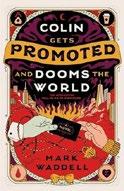
W hen Colin Harris—a selfloathing low-level employee at Dark Enterprises— meets a shadowy figure at work, he strikes a deal to fulfill his heart’s desire (a promotion) and accidentally kick-starts the end of the world.
Located deep in the heart of New York City, Dark Enterprises is unique when it comes to multinational corporations. To start, there’s a people-eating monster living in the stairwell, and human tears and screams are harvested for all kinds of questionable uses. It’s hell—literally—but the people who work there love it. After years of toiling away trying to make a name for himself while sustaining emotional abuse from his co-workers, Colin is positive that his head is, quite literally, on the chopping block. When he meets a strange shadowy figure in the halls of Dark Enterprises who promises to fulfill
COLIN GETS PROMOTED AND DOOMS THE WORLD
his heart’s desire in exchange for a few drops of blood and a simple, unspecified favor, he asks for the one thing he knows will save his skin: a promotion. “The Thing studied me—that was what it looked like, anyhow—while my knees shook. You will have what you desire, it finally said. And once you do, I will return to claim my part of our bargain.” As promised by the terrifying, faceless entity, Colin’s dreams come true in the blink of an eye (and a drop of blood). He’s almost immediately promoted, and while everything seems to go smoothly at first, his life swiftly begins to fall apart when New Yorkers start to go missing en masse. Worse still, Colin’s best friend, Amira, is determined to set him up with a guy in her yoga class, and while Eric is undeniably handsome, he asks a lot of questions. The humor throughout this novel is delightfully witty in a way that fans of dry satire will greatly enjoy. Filled with top-notch worldbuilding, entertaining antagonists, and tongue-in-cheek charm that’s reminiscent of Douglas Adams, Terry Pratchett, and TJ Klune’s The House in the Cerulean Sea (2020), this novel is not to be missed for fans of urban fantasy that gently toes the horror line.
A charming corporate horror novel with a whole lot of heart.
Whitten, Hannah | Orbit (480 pp.)
$30 | July 15, 2025 | 9780316435598
Series: Nightshade Crown, 3
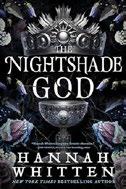
Exiled to the Burnt Isles, Lore is the farthest from saving the world that she’s ever been.
Bastian, now Sainted King, has been completely overcome by the god in his head, Lore doesn’t know
what’s happening with the magic she was born with or the magic she’s gained, her friends are grappling with their own gods and scattered throughout the land. With ash thickening the air, Lore must fight just to survive, but she will never be satisfied with mere survival when she might still be able to save the world. So, with her friends and some allies (who may or may not be trustworthy) she begins to work toward a solution that could fix everything. But striving for salvation means anything might have to be sacrificed: Bastian or his disenchanted former Priest Exalted Gabe, her magic, or even her sense of self. As the Nightshade Crown trilogy draws to a close, its scope expands beyond Lore but ultimately remains focused on her journey. The increased presence of secondary characters, particularly Bastian’s half sister Alienor, makes this finale truly feel like an extension of the previous installments rather than simply a rehashed version of similar plot points. As the world expands, so too does the representation, with characters of different sexualities and gender identities incorporated with little fanfare, as their presence does not require remark. Lore’s moral journey is particularly compelling; alongside her self-sacrifice, she makes bad choices and, often enough, suffers the consequences. Infusing the wonder of myths and magic with the desperation of a fight for survival and earth-shattering doom, this conclusion lives up to the trilogy as a whole.
Dark and intense, but not without bursts of light.

Donovan, Bryn | Berkley (352 pp.) | $19 paper | December 9, 2025 | 9780593816615
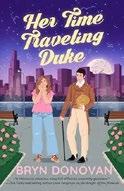
A love spell whisks a Regencyera English duke to contemporary Chicago. At her best friend’s wedding to an actual knight in shining armor (the couple featured in Her Knight at the Museum , 2024), art museum employee Rose Novak finds herself wishing she had her own “old-fashioned gentleman” to love her—someone like the man from the museum’s newly acquired portrait from 1818. Rose, who dabbles in witchy pursuits, decides to do a love spell for herself but never expects a man to suddenly appear in her apartment—especially not Henry Leighton-Lyons, Duke of Beresford, the man from the painting. In his era, Henry was an astronomer researching the possibility of time travel in hopes of returning to a period when his wife was still alive. He’s exasperated to find himself in the future instead, with this vexing—albeit attractive—woman. Thinking the spell must have gone wrong, Rose agrees to help him find his way back. Unfortunately, that means getting their hands on a historical artifact in the possession of a dangerous, wealthy man. As Henry learns more about this new world, he softens toward Rose, and she discovers his protective, kind heart, making them both start to question if maybe the original spell actually was on the right track. This feel-good romance incorporates humorous fish-out-ofwater scenarios and entertaining hijinks in a vibrant, detailed Chicago setting. Rose and Henry are a wonderful showcase of the opposites attract trope as his scientific mind struggles with her penchant for the occult, and she’s the sunshine to his grumpy. Some scenes feel more like filler rather than actually propelling the story, and the plot’s trajectory borders on too obvious and therefore lacks tension, but the book
HER TIME TRAVELING DUKE
is so joyful throughout that it successfully makes for a fun, fluffy, escapist read. A lighthearted, wish-fulfilling romance.
Emezi, Akwaeke | Avon/HarperCollins (320 pp.) | $30 | November 4, 2025
9780063323186
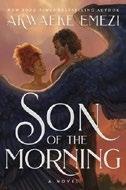
An esteemed author tries romantasy. All the Kincaid women are powerful, but even these exceptional women regard Galilee with awe and, sometimes, resentment. It’s only after venturing out into the world beyond her hometown of Salvation that Gali begins to discover who she is, and it’s only after a brief, mind-blowing sexual encounter with Lucifer—yes, the devil—that she gets a sense of what she is. Nigerian author and visual artist Emezi has an eclectic bibliography. They’ve written awardwinning, critically acclaimed novels for adults and young adults that range from realism to speculative fiction. Emezi has flirted with romance tropes before— notably in Little Rot (2024) and You Made a Fool of Death With Your Beauty (2022)—but this is quite straightforwardly a romance novel. How readers react will largely depend on how and why they pick up this book. Fans of The Death of Vivek Oji (2020) will appreciate that the author’s voice is as vibrantly lyrical as ever. Fans of paranormal romance will be pleased that they have embedded a forbidden romance within a high-stakes conflict, and the sex scenes are undeniably hot. The author’s deft way with queer characters and queer
relationships should please both audiences. The plotting, though, doesn’t quite work for romance, both because the timeline is too short and the pacing is too slow. The main action takes place over the course of a couple of days, during which time Gali and Lucifer experience what romance fans call—generally derisively—“insta-lust” and “insta-love”; Emezi asks readers to invest a lot in leads who are basically archetypes. This might also prove to be an obstacle to those who are new to this genre.
The right readers will love this book, but those readers might be in the minority.
Geissinger, J.T. | Bramble Books (368 pp.) | $32.99 | November 4, 2025 9781250379139
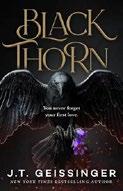
A young mother returns to the gothic manor of her childhood to dust off the family secrets and face her old flame. Maven Blackthorn hasn’t been home since her mom died under suspicious circumstances 12 years ago, but the death of her grandmother, Lorinda, forces her return to Solstice, Vermont. Maven’s daughter, Beatrix, has never seen where her mother grew up, but she quickly learns the Blackthorns have a reputation for witchcraft, largely fueled by a centuries-long feud with the powerful Croft family, whose heir apparent, Ronan, was Maven’s forbidden teenage love and “worst nightmare.” Maven hopes to bid farewell to her grandmother and visit with her aunts without running into Ronan, but he
proves hard to avoid. Maven’s hatred for Ronan runs deep and she believes the feeling is mutual. From Ronan’s perspective, it’s clear their painful unraveling was full of misunderstandings. When Lorinda’s body goes missing from the funeral home, Maven is forced to accept Ronan’s help in discovering what happened. While Maven dives into her family history and the many unfortunate events befalling Blackthorn women, Ronan is forever in her ear, seducing her back to him. The push and pull of their romance feels immature, which isn’t helped by the first-person present narration. At times, it’s easy to forget Maven and Ronan aren’t still teenagers, until the erotica is punched up a thousand percent in the final third. Controlling lines from Ronan like “Don’t test my patience, woman” might read better if his perspective were explored more, though fans of Geissinger’s dark erotica, including Brutal Vows (2025), may not be fazed. Maven’s perspective dominates, and though her investigation into family lore and increasing paranoia are the most compelling arc, the million and one ways in which she threatens Ronan with physical violence—“What I really want to do is tie you to a tree, disembowel you with my bare hands, feed your guts to the wolves, and cut off your head”—is a bit one-note. Trigger warnings abound. If you like your romance the darker the better, this one is for you.
Greenlaw, Rachel | Delacorte (384 pp.)
$30 | October 7, 2025 | 9780593984833
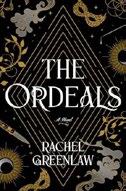
A young woman must navigate a series of deadly tests to be fully admitted to a secretive school of magic. Sophia DeWinter is no stranger to danger. An orphan, she was raised by a man called the Collector, whom she’s been
told is her uncle and who controls her with an enchanted bracelet that tracks her movements. Her only hope for freedom is to gain entrance to Killmarth College, the school that trains wielders, people who can use magic. Sophia knows she has a small talent for illusion magic, and if she can get into Killmarth, the enchantments on the school’s grounds will destroy the Collector’s bracelet, and therefore his control over her. The time and location of the entrance exam, known as the Crucible, is secret, but Sophia manages to overhear a man in a bar talking about it. The man, Alden Locke, happens to be gorgeous, so it’s no hardship for Sophia to flirt the information out of him. Sophia is, of course, paired with Alden for the Crucible, and she manages to pass and gain a spot among the Killmarth hopefuls. But while she’s able to move to the grounds of Killmarth, and is freed of the Collector’s bracelet, she’ll have to pass another series of deadly tests, meant to whittle the hopefuls down to the best of the best, before she can secure a place for herself as a scholar of magic. The romance between Alden and Sophia is rather perfunctory and unsurprising. Greenlaw’s magic system, where wielders are separated into categories depending on their abilities, could be interesting, but without giving any spoilers, it’s always a little boring when the heroine just happens to be the most special of all the special magical people. Fits a bit too neatly into romantasy tropes.
Hall, Alexis | Sourcebooks Casablanca (448 pp.) | $17.99 paper | December 9, 2025 9781464226076
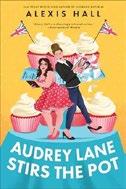
It’s a new season of a famous British baking show, and among the contestants are an inquisitive journalist and an elderly woman with a personal history related to the grounds where the show is filmed.
Working for Shropshire’s second largest regional newspaper isn’t exactly exciting for Audrey Lane—and for sure wouldn’t impress her ex-girlfriend—but her life becomes more interesting when her drunken application to appear on Bake Expectations is accepted. Soon she’s spending her weekends at Patchley House, where the baking challenges are far more complicated than the “back to basics” theme of the season would suggest, and the hot-headed, foul-mouthed producer, Jennifer Hallet, quickly gets under Audrey’s skin. It’s not all bad, though, as Audrey connects with her fellow contestants, including 96-yearold Doris Rice. Always fascinated by people’s stories, Audrey learns Doris was a World War II evacuee who lived at Patchley House as a child and later returned to work as a housemaid. During that time, she had a secret romantic relationship with the daughter of the house. Audrey wants to publish Doris’ story, but that means getting permission from prickly Jennifer. Despite how much Audrey and Jennifer exasperate each other, there’s clear sexual tension between them, and they begin to see just how well they complement each other. Curvy, crafty Audrey is a delightful lead. While at first it can be hard to comprehend why she’s attracted to Jennifer, as their romance develops it becomes clear she’s good for Audrey, especially compared to Audrey’s controlling ex. The plot flows steadily through the weeks of the show, interspersed with snippets of Doris’ past, and Jennifer’s role lends itself to a compelling behind-the-scenes look at the competition. The importance of stories as a touchstone for human connection is adroitly emphasized. Two charming romances in one humorous and earnest tale.

Kann, Claire | Berkley (368 pp.) | $19 paper
November 11, 2025 | 9780593820179
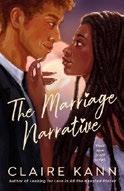
An analytical businesswoman and a man who comes from reality-TV royalty agree to a mutually beneficial marriage of convenience.
Zinnia is a small-business owner who’s given up on the dating scene. Instead, she decides to get straight to the point with what she calls a “marriage-merger,” treating the dating process more like a job interview. Selected applicants will be subjected to screening calls and in-person meetings with the goal of marrying within a month. Her friends aren’t quite sold on the idea, but Zinnia feels this is the most efficient way of ticking the nuptials box. Jordan comes from a famous family of reality television stars, whose lives are recorded for salacious entertainment on a show called Zaffre Hours —think Keeping Up With the Kardashians —though he’s never been part of the cast. The producers have now cooked up a storyline that would entail Jordan officially joining the show, which would include reuniting with and marrying his ex. Jordan would prefer to have more of a say in his love life when he sees Zinnia’s marriagemerger dating profile, it strikes him as the perfect opportunity for a mutually beneficial arrangement. This a slowburn romance, but it’s hard to tell if the romance is slow because the main characters start as strangers or because the romantic tension is frequently interrupted and overshadowed by Jordan’s toxic family members and drama-hungry TV producers. Meanwhile, Zinnia isn’t looking for love, but more of a business partner in life; to her, marriage seems like just an obstacle to overcome. Why she feels this way isn’t fully explored, aside from not wanting to be left behind while her friends are getting coupled up.
A half-baked setup that’s surprisingly low on romantic tension.
A trip to Guadalajara
learn about tequila-making promises a new chapter.
MY FAIR SEÑOR
Lea, Amy | Berkley (432 pp.) | $19 paper December 2, 2025 | 9780593641781
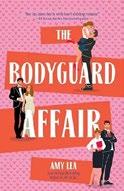
A former Canadian special forces cinnamon-roll hero helps a writer find her own happy ending. Andi Zeigler is the personal assistant to the Canadian prime minister’s wife, but her real love is writing romance novels—which she’s been doing under a pen name. The only person she confided in was a stranger with whom she had an embarrassing encounter a few years ago—you couldn’t quite call it a one-night-stand because they didn’t end up having sex. Nolan Crosby has returned to Ottawa to help his sister take care of their mother, who has Alzheimer’s disease. But he didn’t expect his temporary stint as a bodyguard to Prime Minister Eric Nichols to bring him back to Andi, the funny and sweet woman he met fleetingly three years ago. Just as they start to become (re)acquainted, a media firestorm started by a misleading photo of Andi with PM Nichols erupts; worse, someone discovers one of Andi’s novels, adding fuel to the speculation. Desperate to counter the rumors, Andi asks Nolan to be her fake boyfriend. Inevitably, they catch feelings as they travel with their respective bosses, share one bed, and pose for acquaintances and the media. Lea takes a popular plot device and adds enough individuality to both her characters and the incidents that bring them closer for them to be pleasing. Nolan and Andi’s chemistry,
especially as they become lovers, sizzles. These episodes are sometimes interspersed too quickly with ones involving his mother’s health and his unresolved anger over her uneven parenting of him and his sister. Meanwhile, chapters from Andi’s point of view contain one too many passages about how the romance genre gets no respect, which feel heavy-handed. More gumption and less physical and verbal bumbling on her part—a trait that should be phased out in romance—would also have raised this enjoyable novel one tier higher.
A secret romance novelist and a faking-dating plot will hit the spot for most readers.
Quintana Albertson, Alana | Berkley (304 pp.) | $19 paper | November 25, 2025 9780593336267
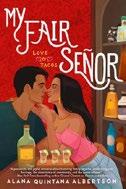
The latest installment in the Love & Tacos series takes readers on a tequila journey with a slice of secondchance romance. Jaime is the 25-year-old baby of the wealthy Mexican American Montez family in La Jolla, California. A bit lost despite his successful career as an influencer, he decides to jump into the tequila business after being asked to promote a brand owned by an actor who’s definitely not Mexican. The problem is, he knows just as little about tequila or Mexican culture as all those non-Mexicans profiting from cultural appropriation. But while he’s trying to
figure out his new plan, the thought of his college girlfriend, Alma Garcia, pops into his head, and he looks her up on his phone—and it turns out that she’s no longer a sommelier but the owner of a tequila bar in Marin County. Could she teach him what he needs to know? Cue problem number 2: He broke up with Alma because he wasn’t ready to commit to one woman after graduation. Alma is full of passion—a word that crops up frequently in the novel—for educating people about tequila, Mexican culture, and making her bar a success. When Jaime shows up with his request, feelings of love, lust, hurt, and anger swirl into a cocktail that brings the former lovers together and apart in dizzying succession. A trip to Guadalajara to learn about traditional tequila-making promises a new chapter but Alma has doubts about whether Jaime has matured enough for her to trust in his love again. Readers might share her skepticism despite the happy-for-now resolution, including news that he’s generously sponsoring a youth soccer club in an under-resourced neighborhood.
A New Adult romance that showcases Mexican and Mexican American life in broad strokes.
Riley, Lia | Avon/HarperCollins (304 pp.) | $18.99 paper December 2, 2025 | 9780063412361
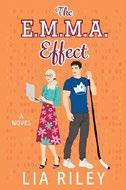
A tech genius and a professional hockey player test their compatibility in this heartfelt romance.
Twenty-nineyear-old Harriet Smythe has created the next big thing in AI—a hopeless robot romantic. The Empirical Machine for Maximizing Athletics, E.M.M.A. for short, is expected to help coaches make informed training decisions and optimize an athlete’s performance...if only it would stop playing matchmaker. When Harriet’s boss at
TrainTech, a Texas-based AI startup, asks her to find a real-life guinea pig to test E.M.M.A.’s capabilities, she knows that sooner or later she’ll have to contact Gale Knight. Gale is a struggling member of the Austin Regals starting lineup, and he’s also the kid brother of Harriet’s best friend, Brooke. Though at 25, he isn’t so little anymore, with muscles even a STEM geek like Harriet can’t help but appreciate. Out of respect for Brooke, Gale has always been off limits to Harriet, even if she’s always harbored a crush on him. Enter the AI! E.M.M.A. predicts that Harriet is the perfect match for Gale, the solution to his problems on and off the ice. Unluckily for Harriet, Gale is all too willing to work with her, making it harder and harder for her to keep things strictly professional. Can Harriet continue to deny the scientific proof in front of her, or will she finally accept that the algorithm doesn’t lie? Riley’s romance is a treat for fans of Ali Hazelwood and Elle Kennedy, and readers will appreciate the modern nod to Jane Austen’s beloved matchmaking heroine. Harriet and Gale’s friendship evolves throughout the story in a vulnerable, heartfelt way, with the just the right amount of spice to make the ice melt. Eerily sentient E.M.M.A. is a standout character, offering plenty of sass in her aptly named “Duchess mode” voice. A charming story about logic, love, and labs.
Roux, Madeleine | Dell (320 pp.) | $18 paper November 4, 2025 | 9780593499412
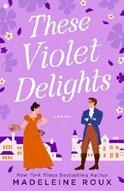
Star-crossed lovers must contend with a family feud and threatening fires. When aspiring artist Violet Arden gets caught up in a scandal, she retreats to Pressmore, her cousin’s
English country estate, which neighbors the ruins of Clafton, once home to the Kerrs, longtime nemeses of her family. The Kerr patriarch perished in the fire that decimated the house, leaving behind his wife and two sons. Alasdair Kerr has now returned home after years of traveling and acquiring art, ready to rebuild, take up residence at Clafton, and hopefully rend his mother from her complete devotion to a shifty clergyman. Violet and Alasdair were briefly friends as children, but now Violet would happily steer clear of hulking, handsome Alasdair. When romance brews between his rakish brother and her cousin’s new sister-in-law, they must join forces to stop the lovers from making rash decisions. They’re further thrust together when mysterious fires endanger Violet. They grow in each other’s esteem during this time spent together and soon find themselves falling in love. Following Much Ado About Margaret (2024), this Regency romance features another Arden sister and has similar Shakespearean influences and lovely prose. There are too many moving pieces that don’t fully gel, though—the secondary romance starts strong but peters out, the mystery of the fires doesn’t add much tension when it’s obvious who’s behind it, and the leads’ former romantic dalliances take up too many pages for how little they add to the story. Violet and Alasdair are both winsome, but the unnecessary padding distracts from their cute love story. Still, a theme woven throughout about the purpose, power, and simple delight of art and fighting back against those who would try to silence it is timely. Prettily written but too unfocused to entirely captivate.

This review originally ran in the July 15, 2025, issue.
Severin’s debut novel follows a doctor whose cutting-edge research gets him entangled in a conspiracy involving artificial intelligence, an upcoming presidential election, and the use of virtual reality.
San Francisco–based Taylor Abrahms, the lead researcher for the Virtual Heart Project, is preparing to introduce revolutionary advancements in surgical methodology through virtual reality, “a new age” in operative procedure: “Soon, a new breed of doctor will emerge, not in surgical scrubs or white coats, but wearing a virtual reality headset and a sensor suit wired to a supercomputer,” Abrahms says on live TV. However, as he finalizes
an upcoming presentation, his own father-in-law— presidential front-runner U.S.
Sen. Randolph Henry McIntyre, a Georgia Republican—is preparing to gut the healthcare system, promising to reduce the costs of care nationwide by half. That means putting a moratorium on cutting-edge biotechnology research, such as the VHP, which the senator perceives as wasteful spending. As election day looms, McIntyre and his cronies set out to discredit Abrahms and destroy his groundbreaking advancements at any cost. Thriller fans will be impressed with the novel’s breakneck pacing and consistently high tension level,
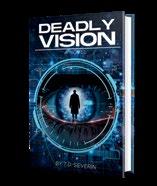
Severin, T.D.
Penmore Press | 466 pp. | $21.50 paper March 6, 2025 | 9781957851945
as well as its knotty storyline involving the FBI, assassins, and hospital politics. It’s no surprise that the medical setting and terminology feel so authentic, as Severin is a surgeon himself. However, the greatest strength of the book is in the author’s deep character development. Abrahms isn’t merely a cardboard hero with unbreakable ideals—his traumatic childhood, during which he dealt with his
mother’s death from heart disease, an alcoholic and abusive father, and his younger brother’s suicide, make him a character that readers will understand, identify with, and root for. The book’s subtle political commentary as it tackles timely issues is a clear plus, as well.
An up-to-the-minute thriller that entertains and enlightens.
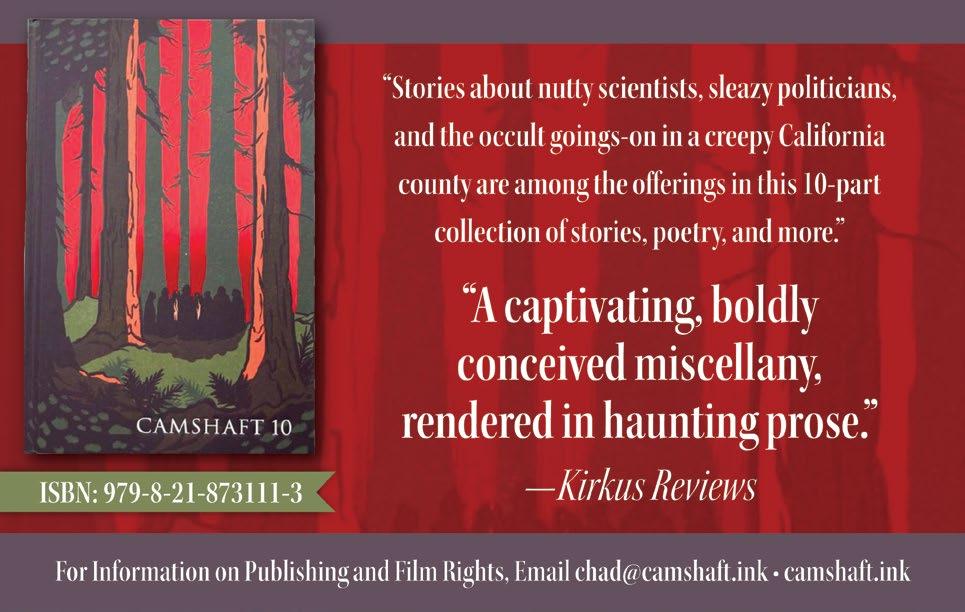


EDITORS’ PICKS:
The Loneliness of Sonia and Sonny by Kiran Desai (Hogarth)
A Fine Line Between Stupid and Clever: The Story of Spinal Tap by Rob Reiner, with Christopher Guest, Michael McKean & Harry Shearer (Gallery Books/ Simon & Schuster)
Cat Nap by Brian Lies (Greenwillow Books)
Sisters in the Wind by Angeline Boulley (Henry Holt)
THANKS TO OUR SPONSORS:
Feud by Berry Michel
Fully Booked is produced by Megan Labrise and Cabel Adkins Audio.

Of lunar ambition and star-crossed love: Eliana Ramage’s To the Moon and Back BY MEGAN LABRISE
On this episode of Fully Booked , I’m joined in conversation by Eliana Ramage, author of To the Moon and Back (Avid Reader Press, September 2), a bold, buzzy debut novel that reaches for the stars. “As gifted as she is driven, a young Cherokee woman powers through trauma and turbulence to realize her astronaut dreams,” Kirkus writes in a starred review.

To listen to the episode, visit Kirkus online.
Ramage holds an MFA in fiction from the Iowa Writers’ Workshop. She has been a Lambda Literary fellow and writer-in-residence, a Harpo Foundation Native American Residency Fellow at Vermont Studio Center, a Tin House Scholar, and a Kimmel Harding Nelson resident. A citizen of the Cherokee Nation, she lives in Nashville with her family. Here’s a bit more from our review of To the Moon and Back : “Ramage’s [novel] begins in June 1987, with 6-year-old Steph Harper in the back seat of a car driven by her mother, Hannah, picking shards of glass out of her little sister Kayla’s hair. The three are on the run from an incident that we won’t fully learn about till the end of the book, about 30 years and 450 action-packed pages later. The threesome stop and resettle in Tahlequah, Oklahoma, part of the Cherokee Nation, and it’s there that Steph begins to dream her big dreams, applying to Phillips Exeter Academy, begging her mother to send her to Space Camp, and having to settle for a homemade version put on by Hannah and her boyfriend, Brett.…There’s much, much more packed into this John Irving–esque tragicomic saga.…This author is as ambitious as her protagonist: There are three novels worth of material here, all good. The moon or bust!”

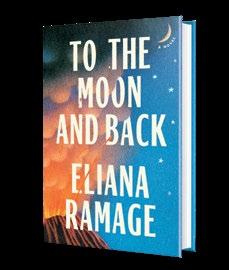
To the Moon and Back Ramage, Eliana Avid Reader Press | 448 pp. | $30.00 September 2, 2025 | 9781668065853
Ramage and I discuss maximalist fiction, characters, the Indian Child Welfare Act of 1978, what it’s like to attend the Iowa Writers’ Workshop, the importance of choosing the right agent, my recent interview with Joseph Lee ( Nothing More of This Land ), and much more.
Also: I’m joined by editors Laurie Muchnick, John McMurtrie, Mahnaz Dar, and Laura Simeon to share their top picks in recent releases.
Editor at large Megan Labrise hosts the Fully Booked podcast.

ISBN: XXX-X-XX-XXXXXX-X

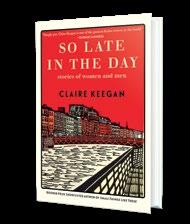
The movie will be based on Claire Keegan’s 2022 short story.
Claire Keegan’s “So Late in the Day” is headed to the big screen, Deadline reports.
Keegan’s short story, published in the New Yorker in 2022, tells the story of the
collapsing relationship between an office worker named Cathal and his fiancée, Sabine. It was collected in Keegan’s 2023 book, So Late in the Day, which received a starred review in Kirkus. A critic called the stories “compact but deep explorations of human vulnerability from a master of the form.”
Sara McFarlane (Love, Brooklyn) will produce the film, which will be written and directed by Maria McIndoo ( A Love Letter to M ). Keegan will executive-produce.
Keegan’s novella Foster was adapted into the 2020 film The Quiet Girl, directed by Colm Bairéad and starring Catherine
Clinch and Carrie Crowley. Another of her novellas, Small Things Like These, formed the basis for the 2024 film of the same name, directed by Tim Mielants and starring Cillian Murphy and Emily Watson.
“There are so many things that I love about this short story: the subtlety,
the nuance, that every word is written with intent and that it stays with you long after you’ve read it,” McFarlane told Deadline “At a time where equality is treated as an imposition on the other, Claire’s careful and considered story feels more relevant than ever.”—M.S.


For a review of So Late
Claire Keegan
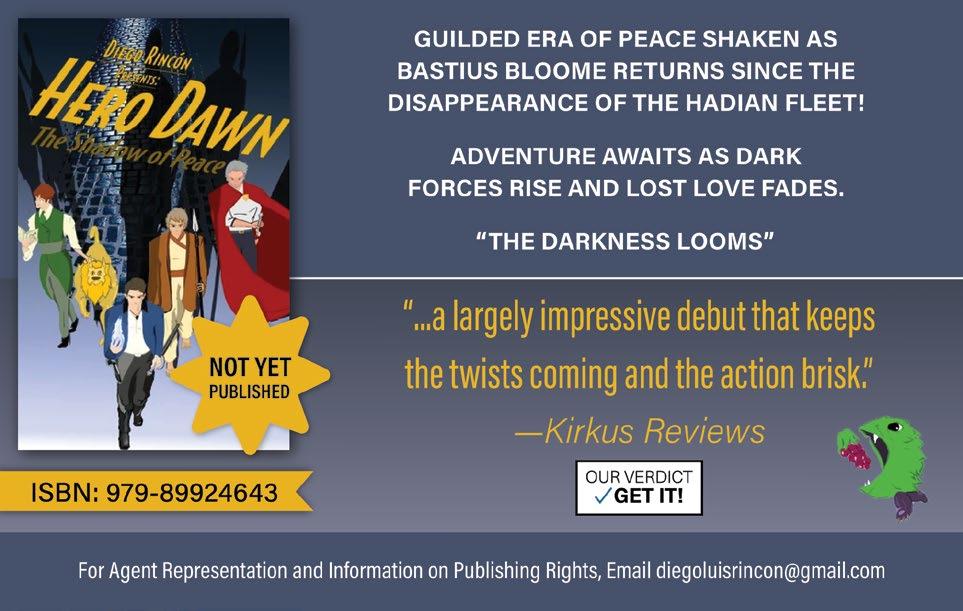

JOHN McMURTRIE
IN 1989, a young man by the name of Bill McKibben introduced much of the world to the concept of global warming with his groundbreaking debut book, The End of Nature. McKibben, who’s now 64, has written 20 books warning of the dangers of climate change. “If I have a literary reputation,” he writes in his latest book, “it’s for a kind of dark realism.” McKibben remains a realist—“we’ve already done fundamental damage to the planet’s physical systems,” he writes—but he’s also seen a glimmer of hope in recent years. As he explains in his new book, “Right now, really for the first time, I can see a path forward. A path lit by the sun.” That new book is Here Comes the Sun: A Last Chance for the Climate and a Fresh Chance for Civilization (Norton, August 19).
Like the Beatles song of the same name, Here Comes the Sun is refreshingly optimistic. In the book, McKibben describes much of the progress that’s been made in cutting back on fossil fuels. He writes, “Sometime in the early part of the 2020s, we crossed an invisible line where the cost of producing
energy from the sun dropped below the cost of fossil fuel.”
The book is full of facts that back up the author’s sunny outlook. For instance: “The solar cell was invented in 1954, and it took from then until 2022 to install the first terawatt [one trillion watts] worth of solar power on this planet.” By contrast, it took only two years to reach the second terawatt. China, which is poised to become the world’s first “electrostate,” produces a whopping 70 billion solar cells a year. Thanks to many of those cells, California now uses 44% less natural gas than it did two years ago.
Here Comes the Sun is one of many new books that celebrate scientific advances. Another is by the popular
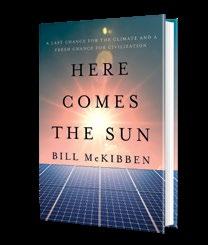
science writer Mary Roach: Replaceable You: Adventures in Human Anatomy (Norton, September 16) is “a lively treatise on the human body as an endlessly interchangeable set of parts,” says our starred review.
Despite disasters at Three Mile Island, Chernobyl, and Fukushima, nuclear power has been embraced by many scientists of late. Isabelle Boemeke, a science influencer from Brazil, makes her case for the controversial power source in Rad Future: The Untold Story of Nuclear Electricity and How It Will Save the World (Thesis/Penguin, August 12). She argues that the world needs “a whole new era…of energy abundance for everyone” and that nuclear electricity has “the smallest environmental footprint” of any energy source.
Alan Lightman and Martin Rees are well suited
to address scientific and technological advances—the scientists have written numerous books for general readers—and they’ve joined forces for their first collaboration, The Shape of Wonder: How Scientists Think, Work, and Live (Pantheon, September 2). The book is “a strong case for public involvement in science,” says our review, and it’s also a fascinating window into a world that might await us. Yes, expect robots, but likely not the kind looking to hunt you down, Terminator-style. In fact, the authors write, in half a century or less, what tiny robots might hunt down—once injected into our bodies—will be cancer cells and faulty DNA. As for any side effects? We’ll just have to wait and see.
John McMurtrie is the nonfiction editor.
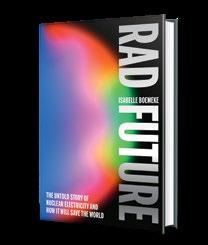
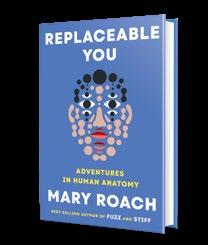
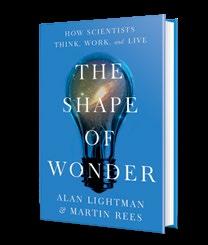
A greatest-hits collection by the journalist and prolific author.
Frazier was born to be a magazine writer, quick to discern between a meaningful vignette and a subject for a long-form story. Here he gathers examples of both, originally published in venues such as the New Yorker and the Atlantic. The vignettes are everywhere, sketches that probe littleknown corners of the human experience, such as a prize-winning rodeo bull rider from Kingston, New York, who didn’t have to travel far to win again at “Loretta Lynn’s Longhorn World Championship Rodeo,” held at Madison Square Garden way back in 1974. “Each bull has his own set of statistics,”
Frazier writes, “just like a baseball player: how many people he’s bucked off, how many times he’s been ridden, how many times he’s made the national finals—things like that.” His visits with the plainspoken NPR commentator Kim Williams, the doyenne of Missoula, Montana, yield dozens of elegant observations, some well ahead of their time, as when she stands in Trump Tower on a visit to New York and declares, “I think someday all the rich people are going to take our resources and go live in a big, warm dome high above us somewhere.” Her takeaway: It’s inevitable, so make do with less. Among the longest pieces are a sardonic examination of life in Russia in the early years of
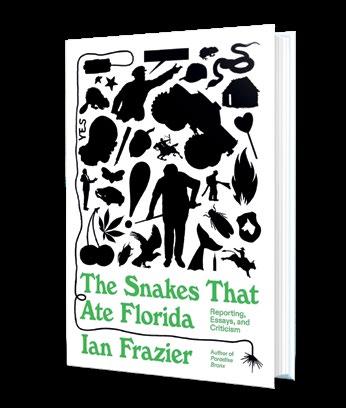
Frazier, Ian | Farrar, Straus and Giroux | 384 pp. $32 | January 13, 2026 | 9780374603106
the Putin regime, with Putin himself somewhat at a crossroads about how to celebrate the overthrow of the last tsar: “The example of, say, the civil unrest of early February 1917 may not appeal to a leader who faced widespread protests against his own autocratic rule.” It’s all highly readable,
with some great turns of phrase (“Russian humor is slapstick, only you actually die”). And if you want to know how prisoners score contraband cell phones, here’s where to turn.
Frazier is an exemplary prose writer, and aspiring practitioners couldn’t ask for a better textbook.
“We are still trying to make peace with racism’s incompatibility with democratic life.”
MURDER ON THE MISSISSIPPI
Ambar, Saladin | Diversion Books (224 pp.)
$29.99 | October 7, 2025 | 9798895150214
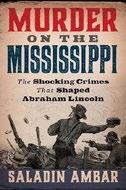
Historical account that locates the roots of Abraham Lincoln’s anti-slavery views in a horrific frontier crime.
On April 28, 1836, a young free Black man, ashore in St. Louis from the riverboat on which he worked as a steward, was falsely arrested. On the way to jail, Francis McIntosh, told that his fate was prison or death, tried to escape, killing a sheriff’s deputy in his failed attempt. A crowd lynched him, chaining him to a tree and burning him alive. In Rutgers University political scientist Ambar’s telling, the incident directly inspired Lincoln’s first major political address, in which the future president spoke of the fracturing of civic order on the frontier and, in that “growing lawlessness,” the threat to democracy. In that context, Lincoln also evoked the Founders, who by that point had mostly passed from the scene, leaving their descendants to work out the solution to problems of republicanism, slavery, and self-government. Ambar examines that violence, which often targeted Blacks free and enslaved, prostitutes, and white gamblers, all subject to “creeping mob violence.” The audience for Lincoln’s 1838 Lyceum Address would have heard echoes of Jacksonian populism, but also his increasing advocacy of federalism and his growing sympathy
for the rising abolitionist movement— the latter not a safe position to stake out even in free Illinois. Ambar convincingly explains that by then Lincoln “simply abhorred” slavery, even while being careful to frame it as a matter of “bad policy.” The mob violence would grow to civil war, of course, and its legacy haunts us today; as the author meaningfully writes, “We are still trying to make peace with racism’s incompatibility with democratic life, a fusion of values Lincoln thought to be essential from the very start of his political career.”
A fresh investigation of antebellum politics and the era’s foremost champion of equality before the law.
Amore, Anthony M. | Pegasus Crime (272 pp.) | $29.95 | November 4, 2025 9781639369959
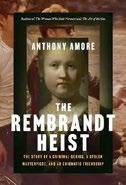
The art of the steal.
Amore, co-author of Stealing Rembrandts (2011) and head of security at the Isabella Stewart Gardner Museum in Boston, here describes the colorful life of Myles Connor, a rock musician who turned to a life of crime throughout New England in the 1960s and ’70s. The author details many of Connor’s early exploits, including impersonating an art expert, stealing works from museums, escaping from a jail cell in Maine (“using a fake gun he fashioned from a bar of soap and
some shoeblack”), and exchanging gunfire with the police. The book is steeped in Greater Boston lore; Amore name-drops people and venues as well as bands managed by Connor’s best friend, Al Dotoli. The book vividly recounts Myles’ dramatic 1975 theft of Rembrandt’s Portrait of Elsbeth van Rijn from Boston’s Museum of Fine Arts, a risky attempt to secure a reduced sentence, and the heist’s aftermath. Although the book offers much in the way of insider baseball as to how law enforcement, the FBI, and criminal gangs operated in the area at the time, Amore’s regard for Connor and Dotoli overshadows the seriousness of Connor’s crimes, as though Connor and his co-conspirators were merely juvenile delinquents pranking family friends. Amore writes: “Is there anything more complex than a man with a genius-level IQ whose love for Japanese swords would consume him to the point where there was no risk too great to keep him from consuming them? Someone gifted enough to impress art curators with doctorates about their shared passions only to entrust millions of dollars’ worth of his beloved objects to obvious scoundrels who would betray him. In my line of work, I can’t think of anything more complicated.”
An admiring portrait of a notorious thief, written by a security professional who revels in his subject’s cunning.
Baier, Bret | Mariner Books (400 pp.)
$32.99 | October 28, 2025 | 9780063360754
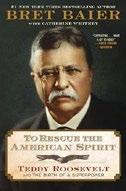
Roosevelt’s forceful life is portrayed as the embodiment of America “as it was meant to be.”
Baier, chief political anchor for Fox News, is a prolific biographer whose volume on Theodore Roosevelt joins his works on George Washington, Ulysses S. Grant, Dwight Eisenhower,
and Ronald Reagan. The author’s portrait of the 26th president draws on Roosevelt’s writings, diaries, letters, speeches, and other biographies. Baier sketches Roosevelt’s transformations to politician, president, soldier, writer, and naturalist. Propelled into the presidency following President McKinley’s assassination, Roosevelt himself later survived an assassination attempt in 1912. The book touches on intriguing, contradictory aspects of his trajectory. Though devoted to his large family, Roosevelt left his wife, Edith, during a difficult pregnancy to fight in the 1898 Spanish-American War. Emerging as a national hero—leading to the vice presidency—Roosevelt won the Nobel Peace Prize for brokering an end to the 1904-05 Russo-Japanese War. A staunch Republican, Roosevelt battled his party’s corrupt power brokers and powerful corporate trusts controlling railroads and coal mines. His love of western wilderness led to the 1905 establishment of the Forest Service and national forests. After helping William Howard Taft succeed him, Roosevelt was so dissatisfied with Taft’s policies he ran against him as Progressive Party candidate, handing Democrat Woodrow Wilson the victory. Roosevelt railed against Wilson’s inaction in confronting World War I, proposing to recruit his own volunteer army. Henry Cabot Lodge captured Roosevelt’s imprint on the national imagination, observing: “He never by any chance bored the American people.” A fascinating figure, Roosevelt merits a deeper examination and additional social and political context. Though this account touches the bases, readers seeking a fuller picture can choose from numerous other acclaimed biographies. This portrait of an iron-willed president digs only so deep.

Barrera, Jazmina | Trans. by Christina MacSweeney | Two Lines Press (264 pp.) $18 | November 11, 2025 | 9781949641875
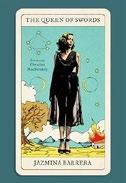
“Who on earth was Elena Garro?” Mexican writer and publisher Barrera confesses she has fallen in love with her enigmatic subject, Garro (1916-1988), a prolific writer of plays, prose, and poetry who is considered a founder of magical realism. Translated by MacSweeney, Barrera’s investigation is no biographical narrative, but rather a collage of “stories, ideas, facts, and cats.” The facts include Garro’s growing up wealthy in Mexico, meeting Octavio Paz at a ball at her aunt’s house, marrying him against her parents’ objections (they threatened to send her to a convent), and enduring his womanizing and cruelty. Right after they married, she dropped out of college to accompany him to a writers’ congress in Spain, a difficult trip that she turned into an “endearing, charismatic” memoir decades later. A much more difficult fact was Garro’s recurring poverty; Barrera chronicles Paz’s refusal to support his wife and their daughter, Helenita. At the age of 4, the girl, living with Paz’s mother, was raped and infected with gonorrhea by his stepfather. Yet Paz sent her back to live there, and she was raped again. Garro and Paz separated, reunited, and lived in the U.S., Mexico, and Europe. In Paris, Garro’s friends included André Breton, Picasso, and Sartre; she had an affair with Argentine writer Bioy Casares (among others), but still she was desperately lonely and attempted suicide several times, once drugging Helenita, too. In the end, her daughter was her only companion, along with as many as 13 cats. Both mother and daughter turned into chronic invalids, suffering from agoraphobia and paranoia. Tarot became a comfort, “almost always corroborating their misfortunes and attributing them to a destiny over which they had no control.” Barrera admits that spending more than two years inside
Garro’s life—even dreaming about her—was exhausting, so why she fell in love with her remains a mystery.
A prismatic portrait of an elusive woman.
Benner, Katie & Erica L. Green
Metropolitan/Henry Holt (272 pp.)
$29.99 | January 13, 2026 | 9781250759108

How a “school’s deception illuminated the persistence of a racial caste system.”
Two New York Times reporters invite readers to look under the hood, so to speak, of a small private school in Louisiana that placed poor Black children into the country’s top schools. Relying on dozens of interviews with students, parents, and staff who were willing to go on the record, the authors share many troublesome findings about the T.M. Landry College Prep, founded by Tracey and Mike Landry. “In texts and whispered exchanges, students talked about the abuse they suffered at T.M. Landry,” the authors write. “But they still did not tell authorities or other adults. They assumed this was the price they had to pay for a shot at the kind of life they thought was out of reach.” The book tells of a host of enablers, including college admissions staff—who were eager to believe “tales of black suffering” that fit a clichéd narrative—and the state of Louisiana, which has no mechanism for oversight of private schools. In a clear and nuanced account, the authors dig deep into the schools’ red flags. They describe the tension between the ideal of personal responsibility and the structural inequities in American society. The playing field of college admissions is ripe for manipulation: “The most elite institutions admit a tiny fraction of applicants, making the pressure to exaggerate, embellish, lie, and cheat on college applications
relatively common.” This explains why so many families chose to stick with the program even after the authors published their exposé in the Times. The authors write, “What Mike and Tracey gave [the students] was a set of connections and a time-tested playbook, created in service of the American aristocracy, for acceptance to the Ivy League.” In other words, the school promised results in a Byzantine system that the families knew they couldn’t navigate on their own.
An alarming story of a private school that achieved improbable outcomes.
Bird, Mike | Portfolio (336 pp.) | $32 November 4, 2025 | 9780593719718

A searching history of land as a measure— and mismeasure— of wealth. They’re not making any more of it, barring dredging operations off Holland or Japan. So it is that, Economist editor Bird writes, land remains enormously valuable, accounting for “about 35 percent of the $520 trillion in real wealth on earth,” twice the value of all the publicly traded corporations on the world’s stock markets. But whereas most markets are regulated, land is less so—it’s just there, it seems, an asset that “does not really decay,” that is, depreciate. It is thus the basis for hereditary wealth and present-day inequalities, since those who own land can use it as collateral, commanding loans unavailable to tenants and the landless poor. By Bird’s wide-ranging account, this very fact has propelled such movements as the westward expansion of America, with seekers scrambling for real estate to call their own. Against this, the author chronicles a powerful 19th-century economic-reform movement led by activists such as Henry George, who called for steep taxes on landownership,
and especially on land that was rented out, inasmuch as the landowners “needed to do nothing more than collect the income”—and besides, benefited disproportionately from publicly funded infrastructure improvements. Naturally, Bird writes, the wealthy were strongly opposed to such reforms. Among other cases, the author examines a tax on China’s landowners propounded by the country’s first president, Sun Yat-sen, so that building an urban industrial economy “could be paid for by the uplift in the value of the land around it.” In another intriguing instance, Bird looks at McDonald’s as a real estate business fronted by hamburger sales, with the company making “more money from rent…than it does from royalties on Big Macs, Happy Meals, and all its other… menu items put together.”
A thought-provoking look at the little-examined role of land in making the rich richer and the poor poorer.
Somewhere, a Boy and a Bear: A.A. Milne
and the Creation of “Winnie-the-Pooh”
Brandreth, Gyles | St. Martin’s (416 pp.) $28 | December 2, 2025 | 9781250429902
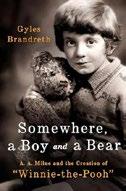
It’s always sunny.
The British writer A.A. Milne (18821956) is best known today as the author of the children’s classic Winnie-the-Pooh. At the heart of author and broadcaster Brandreth’s book is the making of the work, the bear, and the boy hero. Behind it is Milne’s own longing for the Edwardian world of his young adulthood, just before the First World War. Writes Brandreth, “His twenties and early thirties were magical to him, too—the time he spent in the happy, innocent, everyday world he depicted week in, week out, for more than a decade in the pages of [the humor magazine] Punch.” It was not just war that changed Milne, though. He
married Daphne de Sélincourt in 1913, and they had a child, Christopher Robin (born in 1920), who would become the basis of the famous character of the same name. That son is the subject of this book’s second half. Despite fame and attention (or even exploitation), writes Brandreth, Christopher “survived it….He and Winnie-thePooh had something very special in common. Both the boy and the bear believed in ‘living gratefully.’” That is the lesson of this book. The story of the Milne family is the story of holding the temptations of a pastoral imagination together with the traumas of the real world. Winniethe-Pooh endures because he faces each day unmaimed by war or wilderness. “What day is it?” he famously asks Piglet. “It’s today.” It is always a sunny today in the Hundred Acre Wood, though in this book, sunniness often turns to sentimentality. In the end, this is less a work of biographical literary criticism than it is a personal journey of rediscovering childhood in all its glossy nostalgia.
The family life of A.A. Milne as a lesson in childhood innocence, its loss, and its recovery in storytelling.
Burden, Belle | Dial Press (256 pp.) | $30 January 13, 2026 | 9780593733318
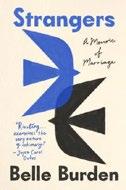
The story of a woman’s surprising divorce and her attempt to build anew.
After Burden’s husband of 20 years walked out during the Covid-19 pandemic lockdown, her stepmother tried to explain the checkered response of their wealthy community: “There is no script for divorce, especially one as dramatic as yours.” The author’s debut expands and fine-tunes the piece she submitted to
SLEEPLESS PLANET
“Modern Love,” the New York Times column, tracing her ex-husband James’ transformation from reliable partner to detached stranger to legal adversary. This more complete narrative reveals the amplified stakes surrounding the collapse of Burden’s marriage: financial, familial, and societal. The latter half of Burden’s book, which describes grappling with the logistics of disentangling from James and finding new independence, strength, and compassion, lacks some of the raw emotional vulnerability that marked her Times contribution. But these chapters do expose the reaction of her wider circle, both the cold comments and the surprisingly supportive ones, and the expectations of women of her social status. (The author is a descendant of the Vanderbilts, with media founders, international style icons, and hedge fund executives scattered through her family tree.) It is difficult to completely erase all hints of society-page voyeurism—this is, after all, the world of keyed beach access passed down through generations, where private club membership is an item negotiated in marital separation. However, if Burden’s privilege remains in the frame, so does its attendant social elegance. In reclaiming her voice and story, Burden refuses to keep the silence and make the excuses as implicitly expected by society and explicitly demanded by her ex, and she remains charitable and gracious even when she does not have to be. This balance imbues her story with a certain power as both the missing script for would-be commenters and a radical extension of kindness toward herself.
A measured, empathetic, and modern response to an enraging callousness.
Burdock, Maureen | Graphic Mundi (240 pp.) | $27.99 paper | November 4, 2025 9781637790939
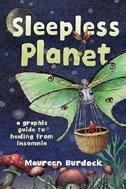
A graphic artist lays out at least some of insomnia’s causes while recording her own journey toward getting a better night’s sleep. Having finally recognized the fallacy of measuring success by productivity alone, Burdock sets out to explain how she found ways over three years to “rewild” herself through changes in diet and behavior as a means of countering the constant high anxiety that kept her awake. In sections titled after the four classical elements, she recalls, for instance, learning breath control by playing a didgeridoo, controlling her sleep apnea by simply laying a piece of tape across her lips, and leaving all of her devices, even her smartwatch, in another room at night to get a better handle on her circadian rhythms. What the author is really offering here, though, is less a catalog of practical techniques for insomniacs than a set of scorching indictments against modern Western practices and values that lead to those long nights—most particularly the evils of bottle feeding, junk foods, and big pharma. As the makers of Crisco, Procter & Gamble “became the first corporation to market industrial waste as food,” writes the author, while condemning the modern nutritional privileging of carbs over fats. Is it any wonder that 70% of all Americans are overweight, as she claims, when so much of what they
eat comes from the “Golden Starches”? Even readers reluctant to join her in saying no to “capitalist time and corporate food” should agree with her insight that obesity is more often a symptom of public and personal health issues than their cause. Too many talking heads and relatively static selfies in her dark, technically adept monochrome images only add further heaviness to the narrative’s lecture-some language and tone. Still, color pictures at the section heads do provide some visual relief—and closer examination reveals a puckish sense of humor best expressed by an embodiment of menopause as a leering, heavyset termagant perched on the suffering author’s shoulders. A wake-up call for nonsleepers, message driven but with saving glints of humor.
Callanan, Frank | Princeton Univ. (856 pp.) $45 | February 3, 2026 | 9780691227979
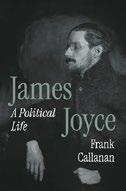
An author’s political views, on and off the page. This massive, meticulously researched biography by the late Irish historian Callanan reveals the political and social worlds of the novelist James Joyce (1882-1941). Valued today as one of the founders of Modernist prose style, as an author of allusive difficulty, and as a great reader of the classics, Joyce emerges here as a man deeply engaged with lived politics. At the heart of the book is the life, work, and death of Charles Stewart Parnell (1846-1891), one of the founders of Irish nationalism. Callanan sees Parnell’s rise and fall as the “primal scene” that shaped young Joyce’s view of Irish culture. Joyce’s writings, in this sense, are not political in a straightforwardly polemical way. Rather, they engage with the central themes of late-19th-century Irish awareness: What does it mean to live in a colonized country; how does the Irish language
intersect with English; what is the place of the individual in an oppressed society; how does the history of famine, poverty, the Catholic Church, and the deep class fissures of Irish social life enable the creation of literary protagonists struggling to find their voices, dealing with sexual longing, and looking for a place in the landscapes of inequality? Joyce’s brilliant creations—Stephen Daedalus and Leopold and Molly Bloom—come alive as people living on the axes of class and erotic desire. And, with Joyce living away from Ireland, in the cosmopolitan Italian city of Trieste, Callanan raises questions about how Italian political unification and the relations between church and state influenced his understanding of his homeland. Finally, Callanan offers this lucid interpretation of the famously cryptic last novel, Finnegan’s Wake: “Men and women, in the cycle of the year and of the generations, find themselves existentially compelled—doomed—to hope.”
A revisionary account of a great Modernist writer as a nationalist political thinker.
Campbell, Hilary Fitzgerald | Andrews McMeel Publishing (384 pp.) | $24.99 paper October 7, 2025 | 9781524876456
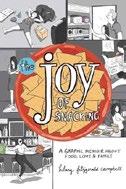
In this graphic memoir, complete with recipes, a New Yorker cartoonist looks back on years of eating her way into adulthood. Opening and closing with scenes from a gig as a 33-year-old burlesque dancer, Campbell shows off her experience as a stand-up comic with a quip-laden narrative in which she chronicles both her youth as a picky eater from childhood through college and a yearslong, riotously contentious, on-again, off-again relationship with a sometimes pushy, sometimes disturbingly sensitive foodie
she dubs “E.” “My truest self is a 5-year-old,” she starts out, “legitimately terrified” of most food from a young age. But “I fucking LOVE Kraft cheese,” and so throughout ensuing trials and tribulations she inserts frequent recipes for comfort foods like Burnt Potato Chips (“pairs well” with gin and tonics and M&M’s). In art as busy and disheveled as her life, she crams friends, family, foods, and winningly ungainly images of her own figure, along with handlettered commentary and dialogue, into panels and montages that teem with informal line work and pop with colored highlights. Reflecting the classic stand-up’s truism that “people think it’s funny when I’m sad,” even when she’s listing her fears or turns to bulimia while wrestling with shame and depression at her weight, her tone is at its lowest only self-deprecatory. Anyway, it’s the high moments that best capture attention—from a wonderfully epiphanic sequence of reaction shots in the wake of her first primary school teacher’s announcement of “Snack Time!” and the mind-bending discovery that cream cheese wrapped in salami actually tastes good to a final view of her triumphantly twirling her pasties onstage while declaring a well-earned determination “to live my life the way that I want!” Salty, crunchy, delicious fun.
Extraordinary Conservation Effort To Save the Americas’ Legendary Cat
Campbell, James | Norton (336 pp.) | $35 November 4, 2025 | 9780393867619
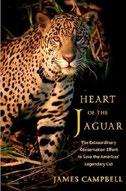
On the struggle to protect the Americas’ largest cat. As author Campbell notes throughout, the fortunes of the “New World’s most dominant apex predator” would be considerably diminished
absent the work of the late biologist Alan Rabinowitz. George Schaller, the eminent zoologist and world traveler, sent Rabinowitz to Central America to track the disappearing cat, its habitat being constantly eroded by human development. Rabinowitz returned with the conviction that contiguous corridors, safe ground constituting “a single ecological unit,” was needed to give the jaguar room to roam. He also courted controversy when a few individual jaguars were spotted in Arizona and New Mexico, arguing that conservation efforts needed to be concentrated south of the border. Yet, as Campbell observes, the cat, whose ancestors crossed the Bering land bridge from Siberia a million years ago, has a historic range that includes much of the western U.S. as well as Mexico and points south. While the Southwestern deserts may be a future sanctuary for the big cat, jaguars thrive best in more tropical settings, as Campbell reports from prey-rich regions such as the Amazonian rainforest and the Pantanal and Iberá wetlands of South America. In fact, the deserts are now the setting for extensive legal struggles to declare the jaguar a native and endangered species—a designation most ranchers oppose, having already lost the battle against reintroducing the Mexican gray wolf. As Campbell adds, the struggle to preserve jaguar habitat sometimes overlaps with the struggle to preserve Indigenous homelands, as with the Maya people of the Yucatán, their historic territory threatened by tourism and the construction of a high-speed train. At the same time, the Trump border wall is preventing the migration of jaguars north from Mexico, yet another obstacle to the conservation of the species. A good overview of the complexities behind keeping a threatened species alive in a world overrun by humans.

Corera, Gordon | Pegasus (336 pp.) | $29.95 January 6, 2026 | 9798897100262
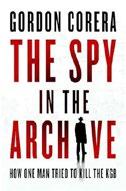
Stealing Soviet secrets.
Journalist
Corera’s account is the kind of real-life espionage on which John le Carré based his spy novels. Set behind Soviet lines during the Cold War, the story delivers codes, secret signals, doublecrossing, and moles. We also have a problematic hero, Vasili Mitrokhin, once bound for the glamorous life of a spy in the West, but demoted to running an archive in the bowels of Moscow’s notorious Lubyanka prison—turned KGB headquarters. Disillusioned by Stalin and the collapse of the Soviet Union and influenced by fellow dissident Alexandr Solzhenitsyn, Mitrokhin takes the opposite path to Vladimir Putin—himself a security official in Dresden—and begins to regard his country as a gulag, particularly after the 1956 invasion of Hungary and the crushed hopes following the Prague Spring. The bones of the story are straightforward: Top secret files, archived at Lubyanka, are to be rehoused in a new KGB complex outside Moscow. One man is responsible for summarizing the files, which name both former and active spies and the names of operatives embedded in U.S., British, and French intelligence. The man responsible takes secret notes over a period of years, then visits embassies in Vilnius as a “walk-in,” offering the notes first to the Americans—who refuse him—and then the British, who facilitate his defection. That man is Mitrokhin. What Corera makes clear is how unglamorous espionage can be, and how unwelcome its findings. Since Mitrokhin copied rather than stole the files, the Russians had to assume everything was compromised. Similarly, Western
intelligence agencies discovered moles themselves and purged not only the agents, but those failing to detect them. It is to Corera’s credit that he brings a journalist’s detailed narrative to historical events. Yet the lives of all concerned are so bleak—and the unrewarding, labyrinthine lives so grimly dull—that by book’s end we not only understand their world, but gladly flee it.
A true-life spy thriller in relentlessly gruesome detail.
Drayson, Elizabeth | Pegasus (576 pp.) $35 | December 2, 2025 | 9798897100019
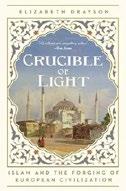
Fourteen hundred years of substantial Islamic influence.
“There is no doubt that contemporary Europe is at political, religious and cultural loggerheads with Islam.” So writes Drayson, a fellow in Spanish at the University of Cambridge and author of The Moor’s Last Stand, among other works. What she aims to do with her new book, she says, is to “trace the emergence of a common European identity forged in the burning crucible of religious and political strife, the deep significance of which this present-day saga brings into the light.” The author begins her history with Islam’s spectacular emergence from Arabia after 600 C.E. Europe was a backwater at the time, so a century passed before Islam swept over the Iberian Peninsula and ruled for 800 years. In the 15th century the
Ottomans swept in from the east to conquer eastern and central Europe as far as Vienna. Islam’s artisans produced magnificent cities and art, and its scholars fulfilled a vital role in preserving ancient literary and scientific documents while making their own contributions. Much of this is conventional history, but Drayson excels when she analyzes specific examples. Three chapters illuminate Cordoba, the jewel of Islamic Spain that attracted a steady stream of medieval Christian and Jewish scholars. Sicily benefited from two centuries of Islamic rule. Mustafa Kemal Atatürk rescued the collapsing Ottoman Empire from the clutches of England, France, and Russia to create modern Turkey. Drayson concludes with a plea for “new ways of thinking and better kinds of social, cultural and political interaction between Christians, non-Muslims and Muslims.” Most readers will agree, although the tide seems against them.
A convincing appreciation of civilizational encounters.
Easterly, William | Basic Books (448 pp.) $32 | November 4, 2025 | 9781541675759
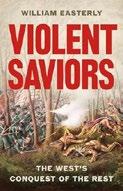
Of humanitarian enterprises that don’t take humans into account. Half a century ago, a young Ugandan, expelled from the country for being of Asian origin and a refugee in England, refused to be relocated from London to a distant camp, saying, “We protest at being treated as objects or, at best, as
Exploring the history of Islam back to 600 C.E., when Europe was a backwater.
How the thriller writer stumbled on a fascinating real-life cold case and wrote a true-crime book.
BY MICHAEL SCHAUB
CHUCK HOGAN KNOWS his way around a crime novel.
The author made his literary debut 20 years ago with The Standoff and followed that up with several more novels, including Prince of Thieves, the 2004 bank-robbery thriller that was adapted into Ben Affleck’s critically acclaimed film The Town. He also tried his hand at horror, collaborating with filmmaker Guillermo del Toro on the Strain trilogy of novels, which formed the basis for an FX television series.
Hogan’s latest book, The Carpool Detectives, is another thriller designed to keep readers guessing. It tells the story of four women in Southern California who become obsessed with a cold case: the suspicious death of a couple found near an SUV at the bottom of a canyon. The women, all mothers navigating their lives during the early days of the Covid-19 pandemic, go to work investigating the case, talking to detectives and family members of the dead husband and wife, and painstakingly going through records, desperately trying to find who might be responsible for the slayings. Eventually, to the astonishment of law enforcement—and themselves—they solve the case.
Here’s the twist: It’s a true story. The mothers-turned-detectives are identified in the book by their real first names, although the identities of everyone else involved, and specific details about the crime, have been changed.
The women are still friends, and Hogan says that their relationship is just as remarkable as the fact that they were able to solve the case. “Two years earlier, three of them were stay-at-home moms,” he says. “One of them was still working, but they weren’t doing anything like this. Finding friends, finding themselves, and taking on this entirely new persona as a bona-fide investigation team is really extraordinary. They have a really special connection.”
Hogan talked about the book via telephone from his home near Boston. Our conversation has been edited for length and clarity.
How did you first come to learn about these four citizen detectives on the other side of the country?
It came from my literary agent, who is also my manager. The moms had a friend who was a televi -


sion director who’d been following the case from afar and eventually convinced them to tell some people about this. He and I were at the Edgar Awards, and he told me about it. Anybody could see this is a one-of-a-kind story. It’s almost too incredible. I think if I had pitched it as a novel, editors would have said, I don’t know; that seems like a bit of a stretch . On top of that, I Zoomed with the four women, and they’re very impressive people themselves. They pursued this completely; they just became obsessed with it. They weren’t Instagramming their investigation; they weren’t trying to get a podcast going. They just really wanted to find out what had happened. I honestly never saw myself writing a nonfiction book ever, but
the story was just too amazing not to be a part of it.
Were they initially receptive to the idea of you writing about it? They were concerned about their safety and their families’ safety. Two of the women weren’t sure that they wanted to go along with it at all. But part of my job, as I saw it, was to make sure that they were comfortable and to obscure the actual details of the original case while preserving precisely their investigative steps along the way. That was a challenge but also a big responsibility of mine to see that through.
What was the process like, having come from a background of fiction and screenwriting, to research a nonfiction book?

There was a real learning curve for me. They had done a lot of the research and basically preserved it for me. I thought I would have an easier time of it, but I had to go through all of it and find my own way through their investigation, not by reinvestigating it but by tracing their footsteps. In terms of practical things, they took me to some of the actual crime scenes and other locations, which was really helpful. And they made hundreds of pages of their own contemporary text messages available. I could really feel at times their exultation at a break in the case, as well as their frustration. We reproduce some of that in the book, which was really helpful in
terms of charting their course through this long, at times frustrating, but ultimately successful investigation.
What was your relationship with the true-crime genre before you heard of this case?
I think I’m like most people: A good true-crime documentary? I’m in. I don’t read a lot of true-crime books, and I’m not much of a podcast person. I’m more of an audiobook person. Obviously, there are some incredibly interesting crimes out there, but I’m always more interested in what’s behind them. Normally, that has to do with the perpetrator, but here I was much more interested in the four women. They had no
personal attachment to this case whatsoever. What was it about this case that spoke to them? What were they looking for as they were trying to bring answers to this other family with whom they became emotionally involved in the course of investigating? There was no money changing hands. No one had hired them. They didn’t know anyone involved in it.
A lot of people who read true-crime are women, so I thought it was interesting to see four women on the other side of it, only one of whom was a true-crime fan—that’s Samira. The others were interested in a good story no matter what form it takes, but to have these women actually doing
Anybody could see this is a one-of-a-kind story.
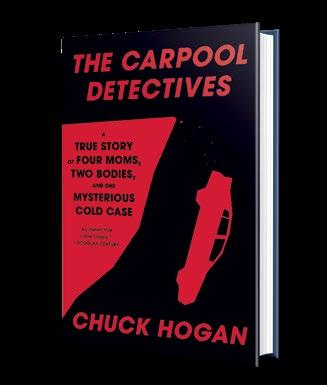
interviews and canvassing really interested me.
Do you think that this investigation would have happened in the same way without the Covid-19 shutdowns? No, I don’t, and neither do they. I think in a strange way they benefited from it, because people wwere at home and available—they would answer their phone, and they were looking for something to do. In other words, Sure, I’ll spend an hour with you on the phone talking about this strange thing that happened to my boss 15 years ago that I’ve never forgotten and that I would love to get answers to It was limiting in terms of [not] being able to physically visit certain places they wanted to travel to, but I think it allowed for much more. It gave them time, as busy as they were, being stay-at-home moms, at a time when everyone was staying at home. It was also something, I think, that they really looked forward to as a distraction from that terrible period in everyone’s lives.
Do you think this will be your last nonfiction book? I do. [Although,] the four women have been working on this other case for quite some time, and if they solve it and were interested in doing something else, there’s no way I could say no to them because we’ve been through this together. But no, this very much feels like a one-and-done for me. I’ve scratched that itch, and I’m looking for the next challenge.
Michael Schaub is a contributing writer.
William Shatner To Crowdsource New Memoir
The actor is asking fans to share their stories for William Shatner…and You.
William Shatner is asking fans to help him write his new memoir, People magazine reports.
The actor will publish William Shatner…and You late next year. On a website for the book, Shatner writes, “It’s a cosmic journey where you, my incredible fans, can become part of the story!”
Shatner is best known for his role as Captain James T. Kirk in the pioneering science fiction television series Star Trek ; he reprised the role in a series of films. He also starred in
the series T.J. Hooker and Boston Legal. He is a prolific author, having written the TekWar series of science fiction novels as well as several memoirs.
His new book will be co-written with Joshua Brandon and incorporate stories from fans. On the book’s website, Shatner writes, “And hold onto your phasers, because a select few of you will be personally interviewed by me to share your story in the book! This isn’t just a chance to own a piece of history: it’s an opportunity to make history, to have your voice echo across the galaxy alongside mine.”
Fans will be eligible to share their stories with Shatner if they preorder the book for $29.95. A panel will review the applications to determine which stories to include.
“My greatest joy has been the connection I’ve shared with fans over the years,” Shatner told People. “William Shatner…and You is a celebration of them: their stories, their passion and the bond we’ve built together.”—M.S.


William Shatner

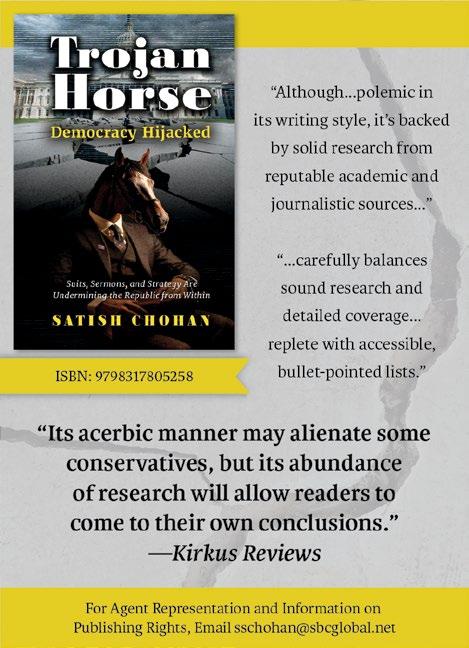


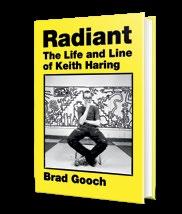
Working Title will develop Brad Gooch’s Radiant as a TV series.
Brad Gooch’s biography of artist Keith Haring is headed to the small screen, Deadline reports.
Gooch’s Radiant: The Life and Line of Keith Haring is being developed as a series by Working Title Television. The biography of the artist was published last year by Harper; a critic for Kirkus praised it as “a sympathetic and well-researched portrait.”
Haring first rose to fame in the early 1980s as a graffiti artist in New York City. He painted vibrant murals that reflected his interest in social themes, including safe sex and LGBTQ+ rights. His work remained popular after his

1990 death from complications from AIDS. His artwork is still widely seen in museum exhibitions and through collaborations with brands such as Pandora, Reebok, and Uniqlo.
The series will be written and directed by Andrew Haigh, known for helming the films Lean on Pete and All of Us Strangers , as well as the HBO series Looking. Executive producers on the series include Haigh, Gooch, and the Keith Haring Foundation.
“Haring’s work, while profoundly personal, speaks to something deep in us all,” Haigh told Deadline “Radiant is a joyful call to action, a celebration of life even in the midst of adversity and struggle.”
Gooch shared news of the adaptation on Instagram, writing, “Breaking News: anyone I’ve told about this asks the same question: Who’s going to play Keith Haring?”
Commenters had several suggestions for the role, including Paul Mescal, Joe Cole, Harris Dickinson, and Barry Keoghan. —M.S.

Keith Haring
Iraq’s Mizrahi Jews once numbered some 150,000; now the number is just a handful.
ALWAYS CARRY SALT
cattle.” This affords development economist Easterly a starting point addressing the question of agency: Do the recipients of aid not deserve some voice in the aid they receive and what they do with it? The violence of his title speaks to assumptions made under the rubric of the “Development Right of Conquest”: I conquer your land, you refuse to develop it to Western industrial standards, and you are displaced so that, if you will not be improved, the land can. Thus the European conquerors of the Americas “could then justify the replacement of the unprogressive people by progressive people in the name of progress.” Easterly, in a spritely text, invokes Adam Smith, a hero throughout, for his insistence that the right of choice in trade is fundamental, and a fundamental check against the illiberal tendencies of those urging conquest, such as the French philosopher Condorcet, who “put Enlightenment intellectuals in charge” of deciding the fates of non-European peoples. A few twists of metaphor, and one might say that slavery was a kind of developmental aid—more anti-Smithian violence, but a point vigorously argued by the Southern elite before the Civil War. As Easterly charts, most development aid is less draconian than all that these days, although there is still plenty of politics: The post–Cold War Washington Consensus, for instance, offered financial aid only if the recipient country “agreed to reforms decreed by [World] Bank and [International Monetary] Fund staff.” Easterly concludes that aid is one thing, but agency and dignity in the face of systemic paternalism are quite another. A nicely contrarian work of interest to aid organizations and policymakers everywhere.
Ellis, Samantha | Pegasus (288 pp.)
$28.95 | January 6, 2026 | 9798897100286
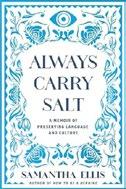
An immigrant daughter retraces her family’s origins in a sometimes pensive, sometimes humorous memoir. There’s an old Jewish joke, writes Ellis, that goes, “They tried to kill us. We survived. Let’s eat.” But not just any food, she adds: The foods are those of survivors from other lands, so that “maybe this is what we pass on: not just the eating but eating together. The let’s part.” In Ellis’ case, the survivors, her parents, were Mizrahi Jews from a community in Iraq that once, in the 1940s, numbered some 150,000; at the time the author writes, the number is now just a handful, the rest having been killed, imprisoned, driven into exile, most to Israel. The survivors remember their homeland, their culture, and their language, called Judeo-Iraqi Arabic. Some of that language survived in Ellis’ vocabulary as a child, but now, she writes, “I could never really speak it…and soon there would be no one to talk to.” Even the original family name, Elias, changed because “my father thought it would be easier to have a name that sounded less Jewish.” Fortunately, as Ellis recounts, she was able to enroll in an endangered languages program and learn something of the ancestral tongue. Along the way, she also read deeply in the matter of endangered languages of all kinds, noting that of the 7,000-odd languages on earth,
most people speak just 13, with so many other languages suppressed, forgotten, and overwhelmed by the world languages on the internet, especially English. “Language loss haunts memoirs and fiction by Iraqi Jews,” writes Ellis, “which, severed from my language, I can only read in translation.” All the same, she offers pleasing lessons in Jewish Iraqi language and culture, often by way of food—let’s eat—celebrating such dishes as the “dense, cataclysmically cheesy omelettes called ajjat b’jeben, which means ‘cheese storm.’”
A lovely evocation of a language and culture that stand just this side of oblivion.
Farmer, Ashley | Pantheon (496 pp.) | $32 November 4, 2025 | 9780593701546
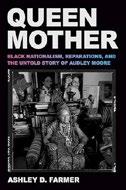
Well-crafted biography of a forgotten founder of the Black Liberation movement.
“If Rosa Parks was the mother of the Civil Rights Movement, then Queen Mother Audley Moore midwifed modern Black Nationalism.” So writes historian Farmer, who adds that the distinction between the two lies in the question of assimilation; where Martin Luther King Jr. pressed for the full integration of the Black community into American society, Moore advocated separatism. Indeed, rebuffed as a speaker at a signal event, Moore denounced King’s movement, saying, “The Negro Revolution of 1963 with its anti-climax March on Washington on August 28th resulted in little or no gains for the Negro masses.” Moore grew up as part of the privileged Creole class in New Orleans, her parents having bought a home in a neighborhood between Black and white communities “with the hope that, over time, they could move closer—both physically and socially—to white folk.”
Segregation and Jim Crow foreclosed on that possibility, and when Moore’s half-brother threw her and her sisters out of the family home on their father’s death, she became an activist in the Garveyite movement, where she became an initiate in Black history, consciousness, and “contemporary struggles for liberation.” Falling in with communist activists on moving to Harlem, Moore built up a Black political movement that formed a popular front against Nazism; when war came, she advocated vigorously for the “Double Victory” campaign, “the first V for victory over our enemies from without, the second V for victory over our enemies from within.” In the postwar era, Moore was a mentor to Malcolm X, received the title “Queen Mother” from the Asante people of Ghana, and was a pioneer in the demand for reparations, all believing that there could be “no true self-determination until Black people had built a nation of their own.”
A vigorous contribution to Black political history that restores an overlooked figure to the narrative.
Fox, Michael J. | Flatiron Books (176 pp.) $20.99 | October 14, 2025 | 9781250866783

Celebrating the 40th anniversary of Back to the Future and the author’s glory days as a 23-year-old rising star.
Fox’s fifth memoir is “the story of an extraordinary period in my life when I was making a magical movie, more magical than if it had been sprinkled with stardust,” a detailed behind-thescenes look at the challenges that made it “a miracle that it came together at all.”
Six weeks into director Robert Zemeckis’ filming of Back to the Future, the actor Eric Stoltz, who was playing Marty McFly, was released from the film. He was replaced with Fox, who was then
working full daily on the set of the television sitcom Family Ties. To make this work, take two of Back to the Future was shot almost entirely at night and Fox was rushed from one soundstage to the next, taken home and stuffed in his bed, woken a few hours later, stuffed in a car, and so forth. Reminiscences about this challenging schedule and the unfolding of the shoot are the foundation of the memoir, which also includes discussion of Fox’s working-class Canadian roots, his early struggles in Los Angeles, his approach to acting, his gift for comedy, his passion for rock ’n’ roll (these parts read a bit on the self-congratulatory side), and portraits of the other cast and crew, several of whom he contacted for comments during the writing of the book. To enjoy it properly, a viewing of Back to the Future is highly recommended. Fox considers it “a near-perfect movie”—it’s hard to argue with him—and much of the joy of the book comes from matching the final product with the effort expended in creating it. The inside of the DeLorean-based time machine, for example, was very roughly made, causing Fox and the stunt drivers many lacerations, bruises, and contusions. “As they say in show business, Pain is temporary, film is forever.”
A fun read for fans of the billion-dollar franchise.
Freston, Tom | Gallery Books/ Simon & Schuster (320 pp.) | $30 November 18, 2025 | 9781668089798

An account of one executive’s rise in the entertainment industry, with a long stint at MTV. Freston’s memoir starts with a low point in his career: being fired as CEO of the mass
media conglomerate Viacom by Sumner Redstone, the company’s mercurial chair. “On Redstone’s CEO firing scoreboard, I’d set a new speed record: eight months on the job,” he notes, wryly. Readers will
be forgiven if they therefore expect a book full of score settling and bitterness, but this book is something different: a cheerfully optimistic look at the life and career of a man whose path to the business world was somewhat unconventional. Freston did get an MBA degree after his undergraduate career, which he readily admits was in order to escape the Vietnam War draft, and he worked in advertising before embarking on a peripatetic journey across the world, making stops in Morocco and Greece, and then Afghanistan and India, which inspired him to found a company that imported garments from the two countries for the American market. Music and pop-culture fans will appreciate Freston’s account of the origins of MTV, for whom he worked as a “marketing guy” before rising through the ranks to become president: “To me, over in marketing, MTV was a lot like Kabul. An exotic new place with a crazy cast of wild characters and few rules…and fun as hell.” He owns up to the network’s early neglect of Black artists, and notes that the show Yo! MTV Raps “saved our white asses.” Freston is impressively self-aware, at one point urging readers to take one of his rare grudges “with a grain of salt and a handful of sour grapes.”
An unexpectedly charming and self-effacing business memoir.
Fussell, Betty | Counterpoint (256 pp.) $26 | December 2, 2025 | 9781640097384
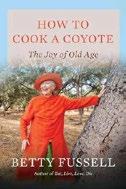
The noted food writer contemplates life as she nears the century mark. Born in the Los Angeles area in 1927, Fussell has been living in a retirement home in Santa Barbara, California, for a decade, having finally gotten
Fussell is happy throughout, even as she notes “how weird it is to live without a future.”
HOW TO COOK A COYOTE
away from New York, where she’d made her name as a food writer and critic. From that vantage point, “the one place in California where mountains run east to west along the sea to leave a strip so narrow there’s no land left for the ticky-tacky developers who gulped down my earlier home and spat out the Inland Empire,” she remembers a life very well lived. Perhaps surprisingly, a good part of her narrative concerns lovers past and sex generally gone (though she does admit to a continuing interest in it); a tiny bit of venom is reserved for her ex-husband, the noted literary historian Paul Fussell, though more is directed toward Fussell’s next wife, who, she writes, “estranged Paul from his own children and disinherited them by shifting their promised inheritance to her own children.” The title’s promised recipe materializes bit by bit throughout Fussell’s elegant and often funny narrative; thankfully, it seems mostly a metaphor (though one with tasting notes, suggesting that the meat of a California coyote in the suburbs would have “a hint of small dog or cat”). More direct are Fussell’s observations on what happens as one ages, when life becomes a sequence of pill-taking rituals, “an exact sequence of steps, no improvisation allowed,” and the sad fact that our elders “become all but invisible” to the outside world. Another lamentable reality is the constant loss of friends, with her coffee klatsch now on its second set of members. Yet Fussell is stout-hearted and happy throughout, even as she notes “how weird it is to live without a future.”
A pleasure to read, although, as Fussell warns, we know how it’s going to end.
Gardner, Mark Lee | Dutton (336 pp.) | $35 November 11, 2025 | 9780593471890
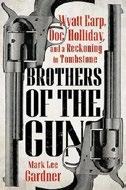
Revisionist history of the Brothers Earp and their adventures and misadventures throughout the American West. The shootout at Tombstone’s O.K. Corral has been worked to the point of exhaustion in the literature of the Wild West, but Gardner—who’s plowed over muchtilled ground in books on the Little Bighorn, Jesse James, and Billy the Kid—adds small details that make the narrative subtler. “The street fight, as it was called at the time, had lasted no more than thirty seconds,” Gardner writes, and while only 25 or 30 shots were fired, three men who would be remembered as desperados died. But, as Gardner notes, the truth of the matter was more complex: The Clanton gang, as they’ve come to be called, represented an economic hindrance, quite apart from the fact that they rustled cattle throughout the southwestern borderlands, and gang warfare it truly was, with three Earp brothers and their pal Doc Holliday making up what might be called the pro-progress faction. Interestingly, as the author writes, leaders Ike Clanton and Wyatt Earp may have relied on guns in the end, but they were no strangers to backroom negotiations and a kind of unlikely diplomacy. Whatever the case, the stories multiplied about the O.K. Corral as the central episode in the Earp story, when there were really many other climacteric moments, including
Wyatt’s cold-blooded shooting of Frank Stilwell, the murderer of his brother, Morgan, “sending a load of buckshot into Frank’s stomach and making a mess of his internal organs.” The legal implications of that killing—and late in life Wyatt admitted to other extralegal executions—finally sent the Earp faction out of Tombstone, with Doc Holliday dying of tuberculosis at a Colorado resort and Wyatt winding up lionized and mythologized in Hollywood. A revealing account that adds shades of gray to black-and-white legends of the Wild West.
Gillingham, Paul | Atlantic Books (752 pp.) $35 | November 18, 2025 | 9780802164841

Superb history of a nation that deserves far more recognition on the international stage than it receives.
“Poor Mexico, so far from God, so close to the United States.” So lamented Porfirio Díaz, the Mexican leader who “reelected himself seven times” while demanding strict term limits for any political figure other than himself. Yet, as Northwestern University historian Gillingham notes, Díaz was an agent of his own downfall, having eventually run afoul of “two of the elemental forces in Mexican political culture: the goal of representative local government, and the hatred of caciques who impeded it.” Gillingham notes that Mexico has always seen a strong revolutionary streak, from one of the very first Spanish arrivals, Gonzalo Guerrero, who was shipwrecked on the coast in 1511 and soon helped lead an anti-Spanish rebellion among the Maya people who took him in. The Spanish who followed were conquistadors and entrepreneurs, power players all, but also, preeminently, they were settlers, “coming to the New World to found towns and stay” and, in time, forging a
people who represented “the world’s greatest melting pot,” with Europeans, Africans, Asians, and Indigenous peoples all contributing to the mix. Granted, to get there, the Spanish killed an awful lot of people; as Gillingham notes, one priest described the effects of an epidemic among the Native peoples, who “died in heaps, like bedbugs.” Violence has also been a strong presence in Mexico—and the author does a great service to confront head-on the near-military dictatorship that flourished in the late 1960s and 1970s, when, just as in Argentina and Chile, leftists were massacred: “Between 1974 and 1980 the army began disappearing people by throwing them out of airplanes over the Pacific.” Still, as Gillingham also notes, Mexico is in many ways more democratic today than its northern neighbor, thanks to the efforts of “the peoples who made the first truly global society.”
Essential, lively reading for anyone wishing to understand Mexico and contemporary geopolitics alike.
Guyotat, Pierre | Trans. by Peter Behrman de Sinéty | NYRB Classics (208 pp.) | $17.95 paper | October 28, 2025 | 9781681379197
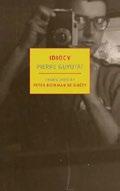
The horror, the horror.
Pierre Guyotat (1940-2000) was an experimentalist French writer whose autobiographical essays, novels, and plays were so graphically explicit that some of his work was banned by the French government. His service in the Algerian War in 1960 shaped his politics and personality: anti-authoritarian, pushing the French language to its limits of meaning, and fascinated by the filth of fighting, illness, and recovery. This memoir of his experiences from the late 1950s to the early 1960s won the 2018 Prix Médicis, an award for authors “whose fame does not yet match their talent.” The book’s descriptive grotesqueness will tax even
the most open-minded of readers. Excrement is everywhere. Body fluids ooze. Dreamscapes of a rural French childhood stand alongside nightmares of war. The long, central essay of the book, “Exodus,” begins with soldiers lounging, the writer coming out of imprisonment, and the very landscape taking on a threatening, bodily form. Who knows what is happening here? “Pieces of Barbary fig limbs in long heaps ahead of us, their rotting fruit covered in flies, thorns untouched: Should we walk over them to continue on?” Someone or something is always being violated. “The light reddens, the shadows hasten over the groves, the rocks…a bosom pokes forth, half out of its camisole, a shoulder bare beneath the strap, a cheek, a profile; eyelashes blink, a mouth half opens, nostrils flare, a scent of fresh shampoo, a hand descends between a pair of thighs, against light shorts: dangerous days, everything that can be cut, gouged, slashed, tugged out from inside the body, beaten, cut to pieces, ripped, burnt, must be defended.” Without an introduction from the translator, and with no notes to guide us through this writing, the book remains a weathered, almost illegible signpost on the desert pathways of the avant-garde. An ugly, terrifying memoir of childhood, war, and violation, rendered into nightmarish English.
Run Zohran Run!: Inside Zohran Mamdani’s Sensational Campaign To Become New York City’s First Democratic Socialist Mayor Hamm, Theodore | OR Books (160 pp.) $17.95 paper | October 14, 2025 9781682194461
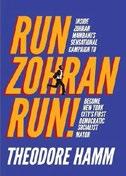
Shaking up Gotham politics. The subject of this knowledgeable, timely, proudly partisan portrait—a millennial, Democratic Socialist state legislator from
Queens—“upended” the establishment in June, defeating well-known opponents in the Democratic mayoral primary in America’s biggest city. The author, an academic and journalist, doesn’t pretend to be objective, and his support for Mamdani informs some debatable assertions. But Hamm’s impressive command of granular details and broader trends makes this a key text for understanding contemporary left-of-center politics and New York City’s upcoming general election, in which Mamdani, who turns 34 in October 2025, tries to become New York’s youngest mayor in a century. Hamm interviewed Mamdani at length and attended many campaign events, noticing how the “always…onmessage” candidate’s pledge to freeze rents, make city buses free, and provide universal child care resonated with voters. Tens of thousands of volunteers, lots of them young, pitched in. Backing from many small donors unlocked millions in matching funds from the city. Leveraging its “top-flight social media game,” Mamdani’s team orchestrated buzzy events. A video of his ride with a cabbie friend has been viewed more than 300,000 times. The Ugandanborn Mamdani also reached out to residents “in dozens of native languages, from Arabic to Vietnamese,” winning votes from oft- overlooked communities. Meanwhile, he withstood attacks on his Muslim faith, false charges of antisemitism, and death threats. Hamm makes big claims, stating that Mamdani’s “outreach operation” was “far more genuinely committed to its candidate than that of any mayoral contender in New York City history.” Maybe so, but the author offers no hard evidence. More persuasively, he argues that unlike some prominent Democrats, Mamdani triumphed by paying “close attention to the struggles faced by countless workingclass people,” radiating “vitality” and “optimism” along the way. An informative, adulatory look at a grassroots candidacy galvanizing young voters and reshaping urban politics.
Welcome to the Family: The Explosive Story Behind Fast & Furious, the Blockbusters That Supercharged the World
Hertz, Barry | Grand Central Publishing (448 pp.) | $30 | November 25, 2025 9781538771037
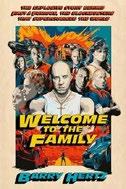
A behind-thescenes look at an action movie franchise has captivated the world.
It was supposed to be, in the words of Universal Pictures’ Scott Stuber, “a small kids and cars movie for spring break.” But in the hands of director Rob Cohen, and stars Paul Walker and Vin Diesel, the 2001 movie The Fast and the Furious became something else—a massive, iconic blockbuster that turned into an unstoppable franchise, one that is still going strong. In his book, film critic Hertz aims to take readers behind the scenes of the Fast & Furious franchise, which has stretched across 11 films and starred notable actors, including Dwayne Johnson, Tyrese Gibson, and, improbably, Helen Mirren. Based on more than 170 interviews, Hertz’s book takes readers behind the conception and shooting of all of the car-centric action films, which, he says, “serve as a rebuke to the kind of mushy modern blockbuster that values pixels over people, safety over sensation.” Hertz does a great job explaining the innovations that brought the films to life and exploring the various dramas that have plagued the franchise for years, particularly the long-running feud between Diesel and Johnson that reached a crescendo with Johnson’s Instagram post with the #ZeroToleranceforCandyAsses hashtag. The franchise was threatened by the death of Walker in a 2013 car crash, which Hertz handles sensitively: “No longer was the Fast team simply finishing a movie; they were honoring a life.” Hertz’s prose is muscular, matching the tone of the films, and he understands the movies’ appeal, which has extended beyond their initial planned
audience of young men. Anyone interested in the history of modern popular film will get lost in Hertz’s well-told story. Readers who can’t get enough of speed and steel will find this a ride worth taking.
Ho, Thien | Third State Books (280 pp.) | $29.95 November 11, 2025 | 9798890130358
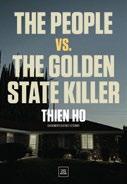
A first-person account of the long quest to bring a serial rapist and murderer to justice. As district attorney of Sacramento County, California, Ho spearheaded a complex prosecution against Joseph DeAngelo, dubbed the Golden State Killer for his 13 proven murders in the 1970s and ’80s. As Ho reveals, his quarry’s crimes took an unsettling trajectory. As a teenager, DeAngelo thrived on bullying and petty crimes. He graduated to animal abuse, killing a dog with fireworks, and then turned his attention to humans. At first it was burglary in the small city of Visalia, 120 break-ins in a single year, 11 in a single night. He graduated to kidnapping, rape, and murder—some of his crimes committed while serving as a police officer; he was so prolific that he would be pegged the “East Area Rapist.” In the late 1980s DeAngelo’s decades-long pattern of crime quieted in Northern California, though only because he moved on to other California locations. He was finally apprehended more than 30 years after the fact through DNA and
other identification technologies along with sheer logic. There Ho’s difficulties multiplied. For one, there was the question of where DeAngelo would be tried, since his crimes crossed many jurisdictions; as Ho recounts, one source of aggravation in particular was Orange County, its prosecutors jockeying for position in an election year. (“It ain’t gonna fucking happen!” Ho responded.) There were evidentiary issues, since many police departments had discarded relevant crime-scene materials decades earlier. Finally, there were legal concerns, some of which, as Ho lays them out, were complex technicalities. But in the end, as Ho’s careful, well-written account chronicles, DeAngelo was brought to justice, with one rape survivor saying at trial, succinctly, “Some people are wired wrong, and DeAngelo is one of them.”
A disturbing real-world procedural about “the bogeyman who couldn’t be found—until we found him.”
Huet, Ellen | MCD/Farrar, Straus and Giroux (432 pp.) | $30 | November 18, 2025 9780374604196

A surpassingly strange tale of an “orgasmic meditation” company. Nicole Daedone, by Bloomberg News reporter Huet’s account, was a young woman at constantly loose ends with “a taste for methamphetamines and psychedelics.”
“A rebuke to the kind of mushy modern blockbuster that values pixels over people.”
WELCOME TO THE FAMILY
Along her unstructured way, Daedone became acquainted with a sexual practice that she would eventually brand as “orgasmic meditation,” the short-form “OM” pronounced “ohm,” with a multitiered company behind it called OneTaste. As Huet writes, Daedone’s timing, though accidental, was fortuitous, for the “wellness industry” was growing into a $4 trillion leviathan, funded and populated largely by people who were abandoning traditional medicine and religion for its alternative and New Age variants. Early on Daedone presciently noted, “There’s a high potential for this to be a cult,” and that’s just what it became, Huet says, with members performing sex acts and giving the group their “money, time, professional work, and energy.” The more money and effort given, the higher the person’s status within the organization— and given, as Huet notes, that people crave status, it was just the right incentive. Daedone had undeniable skills as both a leader and a businessperson, building OneTaste into a small San Francisco–based empire that, by 2016, was bringing in more than $11 million annually through a network of about 500 full-time adherents who in time developed their own private language (“Feeling compressed in a good way… Money is one of the biggest scarcity hexes”). After having collected millions through sales of courses and deluxe memberships at $60,000 a year, OneTaste saw a wave of defections—and soon after, an FBI investigation and federal trial on the charge of conspiring to force their members to labor without pay. In June 2025 the trial ended, as the author chronicles in her epilogue, in a guilty verdict that Daedone’s attorney “vowed to appeal”—so stay tuned. A carefully written exposé of an “infinite game” built on lust for wealth and power—but on mere lust, too.

Kirkus Star
Ireland, Josh | Dutton (384 pp.) | $35 February 24, 2026 | 9780593187104
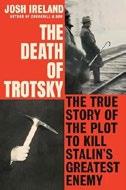
An arresting narrative about the assassination of Leon Trotsky. In his latest book, Ireland takes a well-worn story and transforms it into a tale as gripping as the best novels of espionage. Much of the book unfolds over the 10-year period that precedes Trotsky’s murder, when Stalin’s agents hunted the revolutionary across Europe and ultimately to Mexico City. Using the great abundance of accounts that already exist, Ireland has written a book that is thick with plot and swift in feel, placing at the heart of the work a large cast of characters made intriguing by their unwavering fidelity to either the house of Stalin or Trotsky. Stalin’s crusade to slay his most bitter enemy is riveting fodder for any author. Yet it’s in the characters Ireland has chosen—and more crucially his deft presentation of their contradictions, desires, and flaws—that the book flows with life. Above all, he gives us a penetrative profile of Ramón Mercader, the man who, after several others failed, succeeded in assassinating Trotsky. Mercader, a Spaniard of a petty aristocratic stock, became an ardent and then hardened communist who, Ireland tells us, spent years infiltrating Trotsky’s world. As the book reaches its final third and Stalin’s agents draw close to the kill, Ireland’s writing reaches a crest, and the spycraft, gun battles, and Soviet schemes land like torrents. Some authors write their books from a thousand feet up, failing to get close to their characters and scenes. Good books get closer, bringing readers within a few yards of the narrative. Ireland puts us within an inch of his characters, offering such acute intimacy that you can hear Trotsky’s
terrible scream when Mercader drives the ice pick into the back of his skull, and you can see his blood splattering across the papers on his desk.
Narrative history in fine form: thrillingly paced, deeply researched, told through the people at the center of it.
Islam, Yusuf | Genesis Publications (560 pp.) | $32.55 | October 7, 2025 9781917734004
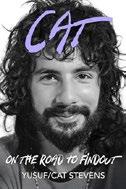
The renowned singer-songwriter recounts a life of making music and following a religious path. Cat Stevens is known for several things, among them anthems such as “Wild World,” “Morning Has Broken,” and “Peace Train.” Those songs, he writes, came to him after a shattered first career as a pop singer, which left him “all burned out at the age of nineteen, after only sixteen months: show business had done its worst and had made me well and truly sick to death.” Ill with tuberculosis, he read up on Asian religions, following in the path of George Harrison, a strong early influence, then retreated to his parents’ home and began to pour out the songs that would make him internationally famous. As Stevens recounts, that fame never quite sat well with him, and his spiritual wanderings brought him to Islam in the late 1970s, when he changed his name to Yusuf Islam and took a long hiatus away from music, including selling all his instruments in the belief that music was “un-Islamic and downright sinful.” It was in this third phase that Stevens became known for something else: his apparent support for the clerical fatwa that condemned Salman Rushdie to death for his book The Satanic Verses. Stevens protests that he was misunderstood: “Even if the generally accepted view of capital punishment for the crime of
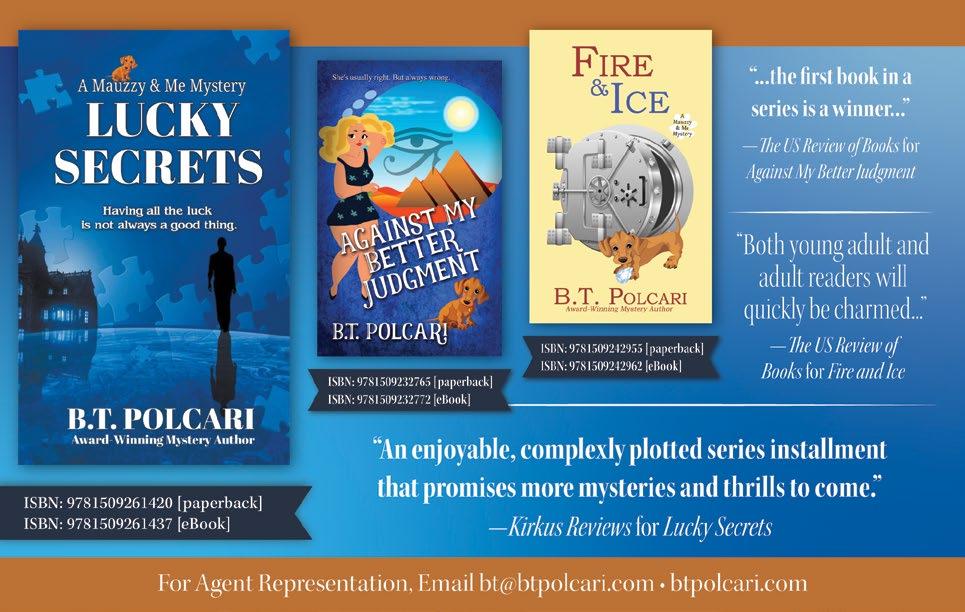
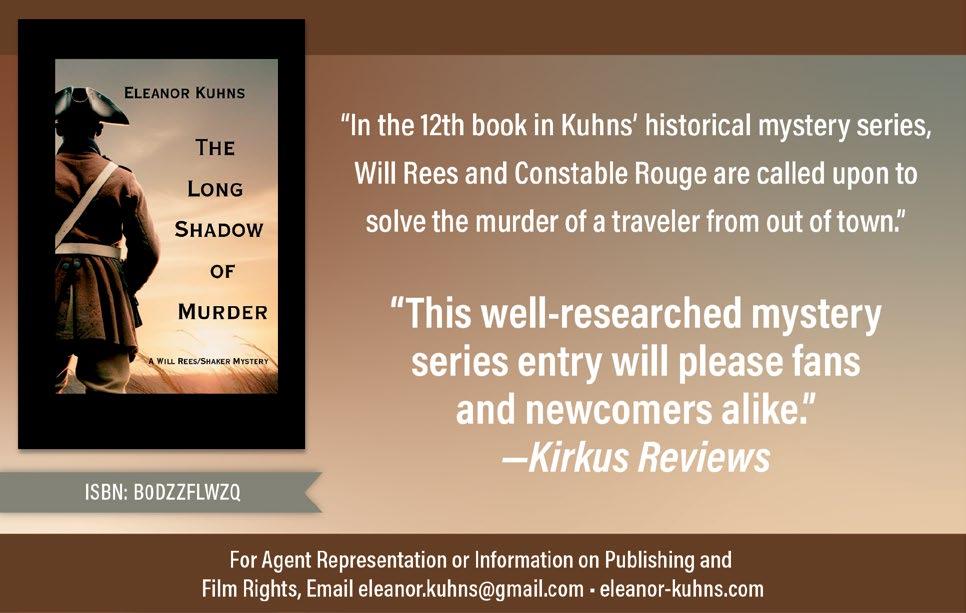
Whether read by the author—or by a talented actor—these memoirs captivate.
BY MARION WINIK
E. JEAN CARROLL is the longtime advice columnist for Elle magazine who was sexually assaulted by Donald Trump in a dressing room at Bergdorf Goodman in the mid-1990s; she sued him both for assault and for defamation of character in 2022. The suit resulted in a guilty verdict and an award of $88.3 million in damages. In Not My Type: One Woman vs. a President (Macmillan Audio, 9 hours and 2 minutes) the gifted humorist delivers a blow-by-blow account of the trial, with killer descriptions of everyone from Trump’s lawyer Alina Habba Esq., she of the stiletto heels and “stupendous” cheekbones, to Judge Lewis
Kaplan, whose eyebrows become a character in their own right. Now 81, Carroll gives her all to the narration of the audiobook, sometimes exulting, sometimes near tears, engaging the reader in every detail of her experience—which began with a makeover, as she had to convince the jury that she was once just the type of woman who would inspire the president’s predation. In fact, when shown a photo that included Carroll and his then-wife Marla Maples, Trump identified Carroll as his spouse. To relive these moments of triumph with her is a rare delight.
Keith McNally, founder of the famous Manhattan bistros

Balthazar, Pastis, Odeon, Minetta Tavern, and more, hates the term restaurateur What happened to the “n”? he’d like to know—and this is a man unafraid to lay it on the line about his feelings and inclinations. He is also brave enough to begin his memoir I Regret Almost Everything (Simon & Schuster Audio, 11 hours and 3 minutes) at the lowest point of his existence— a failed suicide attempt, made in response to the devastation wreaked on his career and his marriage by a stroke in 2016. The stroke left him partly paralyzed, with serious speech difficulties, so his audiobook is read by the British actor Richard E. Grant, whose versatile delivery captures the author’s many moods: “Rueful, self-aware, chatty, entertaining, dazzling, and harrowing: a book that contains multitudes,” according to our critic. As delectable and dishy as the food-biz material may be, it’s only part of what’s here— McNally has worked as an actor, screenwriter, and director, has backpacked around the world, and did significant time at the famous McLean psychiatric hospital in Massachusetts, where he was repeatedly caught raiding the refrigerator at 3 a.m.— and where he started this life-reclaiming book.
A first-rate reader like Grant could probably do justice to any audiobook, but in some
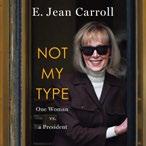
cases the unique qualities of an author’s own voice really add to the effect. Mike Albo’s audio original, Hologram Boyfriends: Sex, Love and Overconnection (Macmillan Audio, 6 hours and 14 minutes) begins with Albo’s assertion that he knew he was gay from the moment he was born, and he’s pretty sure the listener has already figured it out, too, from what he calls his “gay accent.” Said accent is perfect for his stories of looking for not just love but also inner peace online: mostly funny but sometimes quite moving, too. And readers who encounter Jill Bialosky’s elegant, time-traveling narrative The End Is the Beginning: A Personal History of My Mother (Recorded Books, 9 hours and 17 minutes) on the page might never imagine the author’s strong Midwestern accent, so evocative of the Cleveland setting of her mother’s life, or the girlish register of her voice, particularly suited for childhood experiences shared with three sisters, often recounted using the collective “we.” “Our mother,” as she is usually referred to, dies in the first chapter of the book and returns eloquently to life in the chronology-reversing vignettes that follow.
Marion Winik is the author of The Big Book of the Dead and hosts the Weekly Reader podcast on NPR .


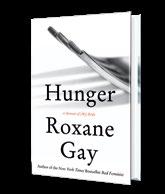
Gay will be honored with the National Book Foundation’s Literarian Award.
Roxane Gay will receive the National Book Foundation’s 2025 Literarian Award for Outstanding Service to the American Literary Community, the organization announced in a news release.
Gay, the Gloria Steinem Endowed Chair in Media, Culture and Feminist Studies at Rutgers University-New Brunswick, published her first book, the short story collection Ayiti, in2011, and followed thatup three years laterwith the novel AnUntamed State and
the essay collection
Bad Feminist. The latter was a bestseller, launching Gay’s career as a public intellectual.
Her other books include Difficult Women, Hunger, and Opinions. She is the editor of Roxane Gay Books, a Grove Atlantic imprint.
David Steinberger, chair of the board of directors of the National Book Foundation, said in a statement, “As a writer, professor, editor, and cultural critic, Roxane Gay has intentionally and artfully carved out spaces to create opportunities for writers, readers, and emerging publishing professionals of all backgrounds in the literary world, and we will continue to reap the benefits of her achievements for generations. It is an honor to recognize Roxane Gay’s extraordinary contributions to the literary community at the 76th National Book Awards Ceremony this November.”
The Literarian Award was established in 2005. Previous winners include Lawrence Ferlinghetti, Dave Eggers, Maya Angelou, and Nancy Pearl.

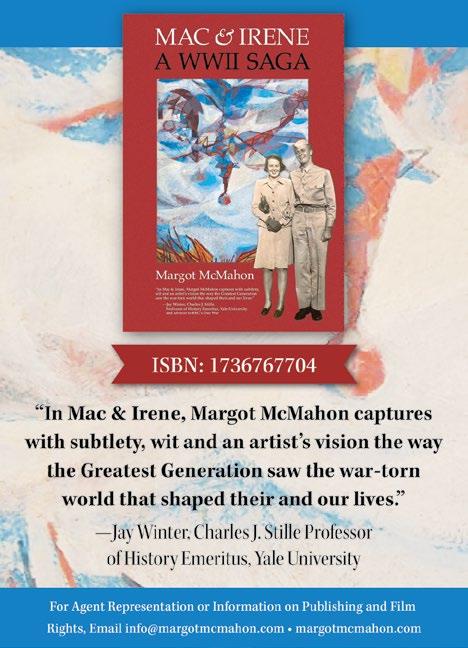
Roxane Gay
—M.S.

For
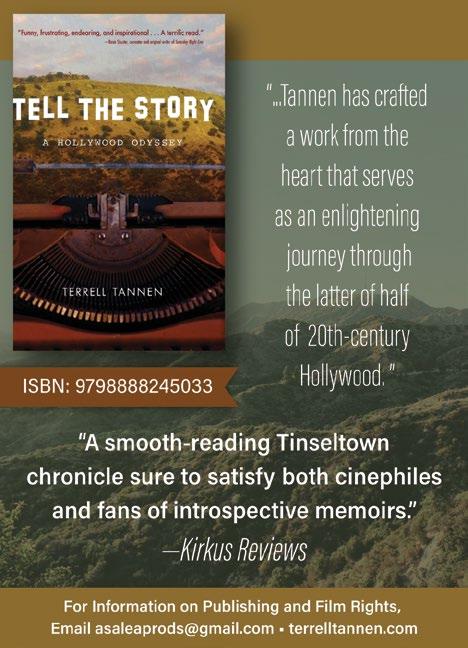

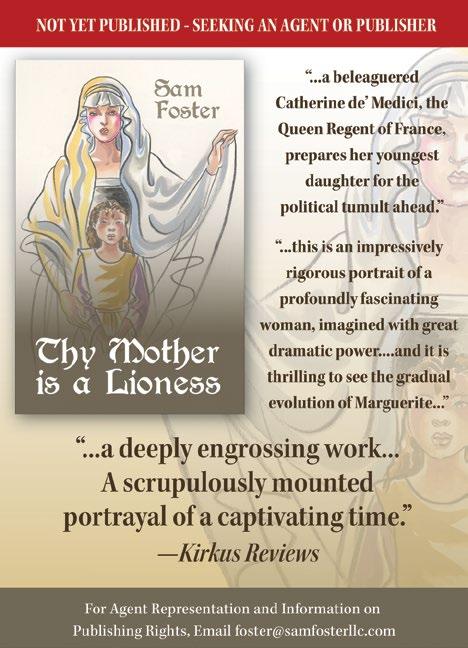
Marc Maron’s podcast, scheduled to end this fall, will be chronicled in a new book.
Marc Maron’s phenomenally popular WTF podcast is getting a graphic novel treatment, Deadline reports.
Maron’s show, launched in 2009, is one of the most influential podcasts in the history of the medium. The stand- up comedian has interviewed guests including President Barack Obama, Robin Williams, Mandy Moore, and Louis C.K.
In June, Maron announced that WTF would end this fall. On the podcast’s website, Maron wrote, “WTF was there at the beginning of the podcast invasion. We weren’t the first, but in terms of making it a viable medium we were certainly one of the OGs. We changed the world, literally. We showed the world that it was possible to create a specific type of show on one’s own terms.”

For reviews of Marc Maron’s books, visit Kirkus online.
Z2 will publish WTF Is a Podcast, written by Maron and producer Brendan McDonald and illustrated by cartoonist Brian Box Brown. There is as yet no publication date for the book. A Kickstarter campaign allowed listeners a chance to preorder the book and gain access to WTF memorabilia and deluxe editions.
“The success of WTF still seems unreal to me, so it makes sense for the definitive story to be told by a great cartoonist and Box Brown is the perfect guy to do it,” Maron told Deadline. “This is a fantastic way for fans to relive the entire run of the podcast without needing to listen to thousands of hours of material again.”—M.S.

insulting the Prophet was absolutely valid, vigilantism was inimical and outlawed by the teachings of Islam.” The “absolutely valid” bit is a little troubling, but suffice it to say that the singer eventually decided that music wasn’t so evil after all, now in the belief that “one main aim of music, as I see it, is to make the world a happier, more harmonious place for us to live in together.”
A thoughtful memoir that goes a long way in explaining the author’s evolution as musician and religious seeker.
Jean-Pierre, Karine | Legacy Lit/Hachette (192 pp.) | $29 | October 21, 2025 9781538777084
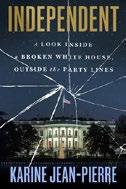
A former Biden press secretary bids farewell to the Democratic Party.
“The first Black person, immigrant, and openly queer woman to be a spokesperson for the president of the United States,” Jean-Pierre represented Joe Biden, his administration, and, at some remove, the agenda of the president’s party. Now, free to speak critically, Jean-Pierre excoriates the leadership of the Democratic Party for fumbling the matter of Biden’s mental acuity after his disastrous debate performance against Donald Trump, its halfhearted treatment of Kamala Harris, and, more than anything, “the way it has responded to the Republican assault on our democracy in a shockingly weak manner.” Being a Republican is out of the question, she adds, but so is being a Democrat: “The Democrats’ blue tent that once felt big enough to hold all the pieces of a Black, queer, immigrant woman like me has collapsed,” she writes, adding that “choosing political independence is a revolutionary act.” Whether Biden, as Jean-Pierre seems to suggest, could and should have remained the party’s candidate is debatable, but her disdain for several named leaders is clear,
as is her view that the party failed to connect with its constituency. More usefully, from the point of view of practical politics, Jean-Pierre urges a personal policy that favors utility over purity, which “may mean fighting to protect immigrants side by side with someone who believes in more restrictions on abortions than you do.” She also advocates for independents to be able to vote in open primaries while at the same time pointing out the inadvisability of voting for a third party. Jean-Pierre’s call for a more engaged citizenry is welcome. Still, given the unlikelihood that enough states will allow for those open primaries to admit independents, some might be tempted to read this as an exercise in self-defeat; for all her longing for a polity “beyond red and blue silos,” that’s exactly where we are.
A heartfelt critique that seems unlikely to land where it’s needed most.
Johnson, Sophie Lucido | Atria (288 pp.) $29 | November 11, 2025 | 9781668060650
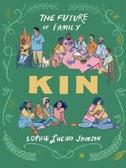
Cartoonist and writer Johnson considers the ways our lives are enriched by relationships with those outside our nuclear families. Following up an earlier memoir of polyamory ( Many Love), Johnson here touches on the subject as it plays out in her life, but for the most part, she concerns herself with more platonic relationships. The term “kin,” as the author somewhat confusingly redefines it, doesn’t have anything to do with “bloodlines and lineage,” but stands in as a substitute for noncasual friendship. (“I like the word kin . It’s tidy and reminds me of other words with which I have positive association,” she explains.) Using the structure of an encouraging, downto-earth self-help book and addressing the readers to whom she imparts advice familiarly as “you,” Johnson rambles through a wide range of
studies on varied aspects of friendship and community to make the unsurprising points that raising infants often feels overwhelming, having friends close by is more satisfying than if they’re thousands of miles away, and asking for help is essential. She often pauses to suggest small actions readers might take to move in the direction of greater kinship: “Share meals with friends or neighbors” or “Swap play dates.” Some may find Johnson’s broader proposals for relationships more idealistic than practical. “Communities need individuals who are emotionally resilient as a result of rigorous self-inventory and intentional healing,” the author maintains, and she continually stresses the importance of therapy as a tool for maintaining friendships. The volume includes several of her cartoon illustrations, though fewer than those familiar with her earlier work might expect. Johnson’s thoughtfulness and compassion shine through, even if the reader comes out with only a few concrete plans for change. A sensible, encouraging, and well-intentioned treatise on the importance of community.
Kirkus Star
Kaplan, Carla | Harper/HarperCollins (576 pp.) | $37.50 | November 25, 2025 9780061578946
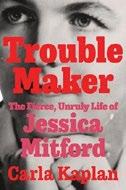
Rebel daughter. Based on dozens of interviews and abundant archival sources, scholar and author Kaplan’s book offers a perceptive, sympathetic biography of activist, unabashed communist, and muckraker Jessica Mitford (1917-1996). Jessica, known as Decca, was defiant even as a child—
A
“savage little tribe” of sisters, two of whom became Nazi sympathizers.
unlike her sisters Nancy, who became a well-known novelist; Nazi sympathizers Diana and Unity; Deborah, who married a duke; and Pamela, who retreated to the countryside. Growing up, the Mitford girls formed a “savage little tribe,” overseen by nannies they exuberantly terrorized. Their parents “called everything outside of their home ‘Elsewhere’ and pronounced themselves against it.” Critical of privilege, Decca kept a “running-away” bank account, which she used to join her second cousin, Esmond Romilly, a nephew of Winston Churchill, to fight fascists in Spain. She was 21 when they married. Never having lived on her own, she did not know how to cook, clean, or even wash her underwear. Nevertheless, she took on challenges with charm, optimism, and a “stubborn embrace of difficulty, contradictions, and mess.” And there were many difficulties: Her first child died of measles; Esmond, a Royal Canadian Air Force pilot, was shot down during World War II; a son was hit by a truck and died. But Decca rallied. After Esmond’s death, she got a job in Washington, D.C., at the Office of Price Administration, where she showed a talent for “in-depth research, joy in exposing corruption, [and] delight in involving collaborators,” all of which she used to great effect in her first book, a bestselling exposé of the funeral business, The American Way of Death. Her second husband was a Jewish lawyer from the Bronx, as committed an activist as she was. Kaplan captures Decca’s energy and verve, her complicated relationship with her aristocratic family, and her unwavering devotion to fighting injustice, racism, and inequality. A brisk, engaging biography.
Kass, Sam | Crown (256 pp.) | $30 October 7, 2025 | 9780451494962
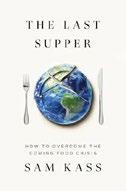
Former Obamaera White House chef Kass looks at the difficulties that lie ahead in putting food on the table. Kass allows that he’s a more privileged eater than most: He buys his meat from an organic farm, with a whole chicken costing a whopping $40. “While I love that chicken and believe it tastes better and is better for the planet,” he concedes, “this is not a model that will work to feed the world today.” Given that big agriculture and big business “exert enormous influence over what and how Americans eat,” difficult choices confront the food system, and changing that system will require an overhaul of American culture to favor, for instance, consumption of less meat and more homegrown veggies. It will also require getting food companies to be proactive, including recognizing the central role of big agriculture in a growing cause for food crises: climate change. Positive models help, whether Walmart’s efforts to reduce E. coli in field vegetables or Michelle Obama’s White House food garden. Critical, too, by Kass’s account, is the work that chefs have done and can do to educate the dining public, as they once did with sea bass and swordfish to replenish natural stocks and are now doing with local farm- and garden-totable menus. “People are more likely to adjust their food choices when they
feel emotionally understood, supported, and engaged,” he observes, an aperçu that may not mean much to food stamp recipients or residents of famine-ridden lands in the developing world. For all that, there are some big-picture reforms in the works, including global carbon markets, regenerative agriculture, and climateadapted seed stocks—and, as Kass notes, “this stuff already exists and is being used on real farms.” There’s a lot to chew on here, some of it bitter. It’s a good call to action all the same.
Lafon, Lola | Trans. by Lauren Elkin | Yale Univ. (184 pp.) | $25 | November 18, 2025 9780300275889

A writer reflects on Anne Frank’s diary, attentive to its ongoing significance for the world. In her 2022 novel Reeling, French author Lafon explored the lives of young female dancers in the 1980s, exploited by middle-aged men purporting to help them, and the aftermath of their abuse. In her 2016 novel The Little Communist Who Never Smiled , she wrote a fictional account of gymnast Nadia Comaneci’s childhood in Romania, which ends with the gold medalist’s daring defection to the U.S. Here, Lafon explores the circumstances surrounding another young woman in peril: the writer Anne Frank. Blending historical fact, interviews, Frank’s writing, and personal rumination, the book chronicles a night that Lafon spends at the Anne Frank House in Amsterdam, with full access to its exhibits and the annex where the Franks lived in secret for two years evading the Nazis. Lafon is unflinching in her observations of the museum—
“Everything here wants to be as authentic as possible, and yet none of it is, except for this oppressive feeling of absence”—and in her questions: “When did Otto Frank finally realize that the faith he had placed in their adoptive country was a tragic mistake?” One of the most striking revelations is how normal the Franks’ lives seemed shortly before they went into hiding—Anne posed with her sister at the beach for a photo—and how that sense of normalcy was something they strived to maintain—Anne pinned her favorite film stars to the walls in the annex—as their world unraveled. We learn that after the Nazis captured the Franks, it was Miep Gies, one of Otto’s employees, who not only cared for them while they hid, but who, at great personal risk, saved Anne Frank’s diary from being destroyed. The Franks’ story and the author’s quest to investigate her own experience intertwine to create a testament to the power of words. A poignant historiography of Anne Frank’s writing and the author’s response to it.
Laughland, Rick | Lyons Press (256 pp.) | $22.95 paper February 3, 2026 | 9781493092734

Glory days in Gotham. Sportswriter Laughland’s account of the contests between the Yankees, Giants, Dodgers, and Mets—before the Giants and Dodgers moved to greener pastures— starts ambitiously with an epigraph from The Great Gatsby about the “wild promise” of the city as seen from the Queensboro Bridge. The author resurrects long-forgotten history. The Brooklyn team, for instance, was initially dubbed the Trolley Dodgers because pedestrians “were forced to bob and weave to avoid the borough’s countless
trolley cars.” And former Giants owner Charles A. Stoneham had business dealings with Arnold Rothstein, the infamous “fixer” of the 1919 World Series. The nascent origin stories of the national pastime are nicely sketched out, with nods to the socioeconomic factors that led to its success—the completion of subways that made it easier for fans to get to Yankee Stadium, Ebbets Field, and the Polo Grounds. The rivalries between the Giants and Yankees are a pleasure to read about, with the Giants—led by Hall of Fame pitcher Christy Mathewson—facing off against the Yankees’ Murderers’ Row of Babe Ruth and Lou Gehrig and, later, Joe DiMaggio and Mickey Mantle. Well portrayed, too, are the Giants’ nurturing of epochally great centerfielder (and noted Harlem stickball player) Willie Mays, under the ministrations of the volatile Leo Durocher. The tale starts to sag when midseason bouts between the Mets and Yankees (and occasional fall classic contests) are elevated to the stature of the “Subway Series” of old. Also weakening the text are an abundance of cliches (such as athletes “taking the sport by storm”) and coy references to the Mets as “the Amazin’s.”
A promising account of a bygone era loses steam when moving into modern times.
Reich: A Murder in Orange County, Neo-Nazis, and a New Age of Hate
Lichtblau, Eric | Little, Brown (352 pp.) $30 | January 6, 2026 | 9780316564717
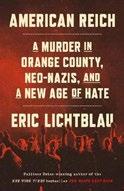
A study in the workings of white supremacist hatred as it surges across the land. Pulitzer Prize–winning journalist Lichtblau focuses on Orange County, California, “a petri dish for young white supremacists anxious to take back their culture from minorities they see as an existential threat.” There,
one young man—disaffected, taught by his conservative father to despise gay people, obsessed with Nazi ideology— targeted a classmate, gay and Jewish, and murdered him. Sam Woodward, now imprisoned for life, wasn’t the first neo-Nazi killer on the block. Indeed, Southern California abounds in white nationalist gangs, for, as neo-Nazi/KKK leader Tom Metzger declared, “This may not be the Mecca of white separatism… but it is the breeding ground.” The neo-Nazi drama plays out, in Lichtblau’s fast-paced account, against a backdrop of national politics and demographics: Enrollment in white supremacist organizations accelerated dramatically with Barack Obama’s election, and violent action spiked with Trump’s. “While Trump always denied any suggestion that his ugly, racist rhetoric was fueling violence,” writes the author, “dozens of his supporters made that connection explicit in unprovoked hate crimes that invoked his name and mimicked his language.” Emboldened, supremacist groups are spilling out of Southern California and the Deep South and growing nationally. Perhaps ironically, Lichtblau notes, those very places are becoming less white and more ethnically mixed, giving rise to the “Great Replacement Theory” and the fervent support for Trump that led to the January 6, 2021, insurrection, most of whose participants “hailed from counties where the proportion of the white population was shrinking rapidly compared to that of non-whites.” The author’s thorough reporting makes it plain that things are likely to become still worse, for, with Trump’s second term, supremacists’ numbers and actions are rising, while violent hatred has become “the sad state of normalcy in modern-day America.”
A deep investigation into the plague of white nationalism.

Luzzi, Joseph | Norton (256 pp.) | $29.99 November 11, 2025 | 9781324065784
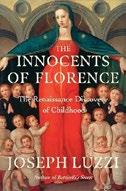
An eye-opening history of Europe’s first orphanage. Italian scholar Luzzi delves into Florence’s famous orphanage, the Hospital of the Innocents or Innocenti, which would eventually house, feed, and educate unwanted children. Flourishing Florence felt it had a religious, civic, and financial duty to care for them. In 1348 a young orphan, Francesco Datini, worked hard to become successful, in turn helping Lapo Mazzei, a professional rotary, to make a way for himself. Mazzei wanted to combat childhood misery in Florence. When older, Datini bequeathed a vast sum to the hospital where Mazzei worked, the Santa Maria Nuova, for the sole purpose of providing for abandoned children. The wealthy Silk Weavers Guild decided in 1419 to build a home for foundlings. The architect of the Duomo, Filippo Brunelleschi, created its dazzling portico. The first baby left in its foundling wagon wheel died early; 90 were left the first year, just one legitimate. Luzzi deftly explores what this difference meant socially for children and the fates of enslaved women who had illegitimate babies. Mortality rates among famine babies taken in soared, as did the need for wet nurses. In 1483 Francesco Tesori became the Innocenti’s unpaid director. He hired noted artist Domenico Ghirlandaio and others to paint works in the orphanage, thus increasing its notoriety. When Borghini became prior in 1552, he improved the education boys received and sanctioned castration. Some orphans even went on to have artistic careers. When Fra Niccolò Mazzi took over in 1581, he focused on finances while instituting repressive reforms for
girls. In the mid-19th century, the numbers of new arrivals were exploding when prior Carlo Michelagnoli established farms to employ boys. A kindergarten was created in 1948, and in 1959 invaluable social workers were hired. Innocenti is now a museum and study center with a nursery school. More than a history of a building—a fascinating portrait of Renaissance life.
Mann, William J. | Simon & Schuster (464 pp.) $31 | January 27, 2026 | 9781668075906
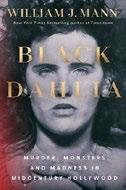
A meticulous study of an infamous murder, and a debunking of its conspiracy theories. On January 15, 1947, Los Angeles police began investigating the death of Elizabeth Short, a 22-year-old woman who’d been killed the night before in grotesque fashion: Her face and genitalia were mutilated, while her body was bisected across the torso, drained of blood, and left in a vacant lot. Nicknamed the Black Dahlia due to her striking head of black hair, Short became an avatar of postwar American noir and the subject of bottomless speculation about her (still-unsolved) murder, to the point of being unrecognizable as a person. Novelist and Hollywood journalist Mann (Bogie & Bacall, 2023, etc.) doesn’t aspire to solve the murder—though he does float a theory—so much as attempt to understand what it might be like for a young woman to struggle to navigate the seedier streets of Hollywood in the ’40s. She arrived in L.A. from the Boston suburb of Medford, seemingly eager to find work as an actress, but hand-tomouth living made that difficult; she relied on the kindness of strange men for her next meal and bed, though she had a story about a fiancé to keep such men in line. What should’ve been a tragic story
about a woman whose luck ran out instead became a study in the media’s eagerness to paint single women in the big city as untamed and promiscuous; soon enough, self-declared experts like LAPD psychiatrist Dr. Paul de River offered dubious and lurid claims about the killer’s motivations. Mann has plenty of admiration for the detectives working the case (which remains open, making the LAPD files inaccessible to the public), but less for the society determined to blame the victim. As a true-crime story, Mann’s approach may dissatisfy, but as sociology and an indictment of America’s misogynistic, bloodthirsty instincts, it’s a valuable book.
A sober, well-researched study of a case whose notoriety obscured its subject.
Marin, Sanna | Scribner (256 pp.) | $29 November 4, 2025 | 9781668069639

Finland’s former prime minister recounts a progressive vision of social democracy as a blueprint for global progress. In her inspiring but curiously pallid memoir, Marin chronicles her swift ascent from working-class origins to become Finland’s—and the world’s—youngestserving head of government at age 34. Raised unconventionally by her mother and her mother’s female partner, Marin had a political awakening that grew from the conviction that circumstances of birth should not determine life’s trajectory, leading her to embrace social democracy as both personal mission and governing philosophy. The memoir explores her evolution within Finland’s Social Democratic Party, driven by ideals focused on climate, human rights, and social justice. Her commitment to gender equality runs throughout, noting with pride that a majority of her cabinet ministers were women. Marin’s deep pride in Finland’s progressive
foundations permeates the narrative, celebrating the country’s social welfare system that fosters trust and solidarity. She argues that social democratic policies provide true freedoms—to live securely, be educated, work for fair wages, and enjoy family and friends. “When we start upholding traditions over values, we stagnate,” she writes, “but when we stand up for our values, we pave the way for change.” Her story as prime minister encompasses truly historic achievements: leading Finland’s Covid-19 response, which earned 85% approval, and spearheading the country’s dramatic pivot to NATO membership following Russia’s invasion of Ukraine. She candidly addresses the unique pressures facing contemporary politicians, particularly women, who must navigate constant scrutiny, such as the 2022 dancing video controversy in which critics branded her behavior unprofessional while supporters dismissed such criticism as sexist. While Marin provides thoughtful insight into her transformative leadership and progressive vision, her narrative suffers from flat, humorless prose that reveals little personality; despite compelling subject matter and clear convictions, her writing style rarely brings to life the drama of her unprecedented rise.
A thoughtfully articulated political memoir weakened by lackluster storytelling that struggles to fully engage.
Mazzeo, Tilar J. | St. Martin’s (288 pp.) $30 | December 9, 2025 | 9781250352583
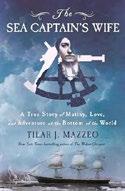
A rip-roaring, seafaring adventure with a twist. Mazzeo, the author of The Widow Clicquot , has fashioned a captivating role-reversal tale. In crisp prose, it begins in Maine’s Penobscot Bay,
home to hundreds of sea captains, including Joshua Adams Patten and his 19-year-old wife, Mary Ann. In 1854 he secured the captainship of a massive clipper, the dozen-sailed Flying Scud . He sailed from New York to Liverpool and back, earning a fine salary and a handsome race wager. In 1855 he was chosen to captain the clipper ship Neptune’s Car to circumnavigate the globe. If successful, he would receive a massive payout. He and Mary Ann agreed that she would accompany him. For the first time, he confronted dangerous waves in Drake’s Passage, between South America and Antarctica. Mazzeo does a fine job explaining how the waves affect ships and the nuances of celestial navigation. Despite an impressive 101-day voyage to San Francisco, Patten lost a $2,000 race wager by hours. In Hong Kong, he took on tea for cargo and sailed to London, where it would bring high prices. Once back home, Patten quickly received another commission for the same voyage, including a five-ship race wager and a new, disgruntled first mate. Patten had to demote him, so when the captain became ill, it was Mary Ann, who was pregnant and had no sea training, who scoured navigational maps and medical texts to steer a course through Drake’s Passage amid foul weather and a questioning crew. On September 5, 1856, with a gun hidden under her oilskin, she addressed the crew with “one hell of a speech.” For the first time ever, a woman became captain of a merchant ship—with the crew’s approval. Awaiting them were terrible weather and icebergs—and the hope of returning home. A thoroughly entertaining, delightful story.
McKay, Sinclair | Pegasus (432 pp.) | $35 January 6, 2026 | 9798897100224
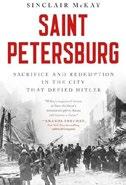
Chronicling courage amid “all-encompassing misery.”
British literary critic McKay, author of The Hidden History of Code-Breaking (2023), does not break new ground in his account of an event that is hugely significant in Russian history: the 900-day Siege of Leningrad. The author hurries over pre-Soviet history and emphasizes Stalin in what followed. He writes about Stalin industrializing the USSR in the 1920s, descending into inexplicable madness with mass purges in the 1930s, and foolishly believing that Hitler—as cruel, crafty, and dishonorable as himself—was an ally. Although surprised and routed by Germany’s June 1941 invasion, the Red Army gradually pulled itself together and by September had halted the Wehrmacht on the outskirts of Saint Petersburg, then known as Leningrad. It’s possible that a major effort would have conquered the city, but the Wehrmacht was overstretched, facing increasing resistance, and suffering badly from fall weather and poor logistics. With the city surrounded, the high command concluded that starvation would accomplish the same goal. Making generous use of diaries, memoirs, and letters from those involved, McKay delivers a disturbing description of the siege itself. Red Army offensives to break it often went catastrophically wrong until they finally made progress in January 1943—although another year passed before the Wehrmacht retreated from the
A rip-roaring sea adventure— around the world—with a role-reversal twist.
THE SEA CAPTAIN’S WIFE
city. In the meantime, there was a great deal of heroism. There was epic suffering, too, with perhaps a million deaths from starvation and disease—almost 2,000 people were imprisoned for cannibalism— and no shortage of corruption and crime. The horrors of war, skillfully told on an epic scale.
McPherson, Edward | Astra House (304 pp.) $28 | October 21, 2025 | 9781662602955
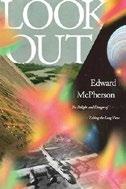
A robust inquiry into “seeking the bigger picture.”
The late philosopher Roland Barthes had a fear of heights and a hatred of mountains. Had he been around to read McPherson’s book, he might have reconsidered: Seeing from up high can yield awe, and while “awe often carries an undercurrent of fear,” it can provoke some, if you will, elevated thoughts. It can also yield awareness of what surveyors call “ground truth,” a point that McPherson, author of Buster Keaton: Tempest in a Flat Hat, addresses with his account of John B. Bachelder. An artist who arrived at the Gettysburg battlefield two days after the fighting there had stopped, Bachelder drew an aerial-perspective map that was so detailed that, after publication in 1864, thousands of military officers on both sides scrutinized it; in the end, after collating their findings, “only a single regiment was moved.” From there McPherson moves on to explore the 19th-century “mania” for bird’s-eye-view maps made by artists who “had learned well the perspective drawing of Renaissance masters.” McPherson darts from subject to subject, from the workings of aerial intelligence in modern spycraft to the AI targeting systems being used to bombard Gaza and the proliferation of drones. The narrative is thus rather diffuse—he himself admits to “attempting to keep many topics in view”—and the writing can sometimes drift into the purply abstract (“What is the length of a feeling?
Totality lasted minutes, or an eternity, or was nothing at all.”) And while there are better books and articles on perception from above, including Barry Lopez’s peerless essay “Flight” and William Langewiesche’s Inside the Sky, McPherson’s book has some fine moments, perhaps most memorably his slog up a Texas mountain to look at a clock that’s meant to tick away for the next 10,000 years, taking a long view indeed. Though somewhat disjointed, a book with plenty of high points.
Montgomery, Beronda L. | Henry Holt (320 pp.) $27.99 | January 20, 2026 | 9781250335166
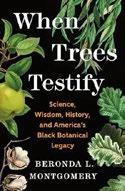
Reclaiming Black people’s botanical heritage. Plant biologist Montgomery melds scientific expertise with memoir and family history to reveal the multifaceted connections of trees and plants to the Black American experience. She focuses on seven trees in particular: pecan, sycamore, willow, poplar, oak, mulberry, and apple, each of which—along with the cotton shrub—bears witness to enslavement, emancipation, and a legacy of racism. Growing up in Little Rock, Arkansas, Montgomery was surrounded by trees in her neighborhood and in the woods where she and her siblings played. Some connections to trees came from childhood experiences, others from family stories. She discovered that in the segregated South in which her parents grew up, “Black Americans frequently were not allowed to purchase or consume vanilla ice cream—it was considered a ‘pure’ ice cream reserved for white Americans.” To flavor their homemade ice cream, Black people added pecans; butter pecan ice cream was a family favorite. Trees had tragic associations, too: throughout the South, many types were used for whippings and hangings. The connection between poplars
and lynchings appears in the popular song “Strange Fruit.” Sycamores, besides being hanging trees, also helped enslaved people to escape: Their girth was large enough to hide a runaway. In fact, Montgomery discovered, part of the Underground Railroad is known as “Sycamore Trail, so named due to the rows of sycamore trees growing on the banks” of a creek in Ohio. Blacks and Indigenous peoples developed sophisticated botanical knowledge, both in plant cultivation and medicinal uses. Leaves of the willow, for example, were made into poultices or infusions for the treatment of aches and swelling; bark extracts for treating dysentery; root infusions as an anti-diarrheal. Botanical knowledge, Montgomery argues persuasively, was intrinsic to Black people’s survival and sustenance before and after emancipation.
A fresh perspective on Black history.
Ed. by Muller, Lauren, Becky Thompson, Dominique C. Hill & Durell M. Calliers Haymarket Books (312 pp.) | $22.95 November 11, 2025 | 9798888904572
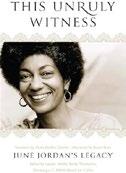
Homage to a beloved poet. This compendium of 38 essays, letters, and poems honors the poet, essayist, and activist June Jordan (1936-2002) with contributions from Jordan’s friends and students and the many educators and activists to whom she bequeathed a legacy of love: “an opportunity to love ourselves and each other more honestly.” Many, like Thompson, involved in grassroots activism, found inspiration in Jordan’s energy. “She lived her life,” Thompson writes, “as if it were a rushing river, with inlets for rest, and rapids where she insisted that she and all those she was around hold on for dear life.” Jordan’s political engagement reflected her deep empathy; poet E. Ethelbert Miller points to lines written in response to the Israeli bombing of Lebanon in 1982: “I was born a Black woman,” Jordan wrote, “and now / I am
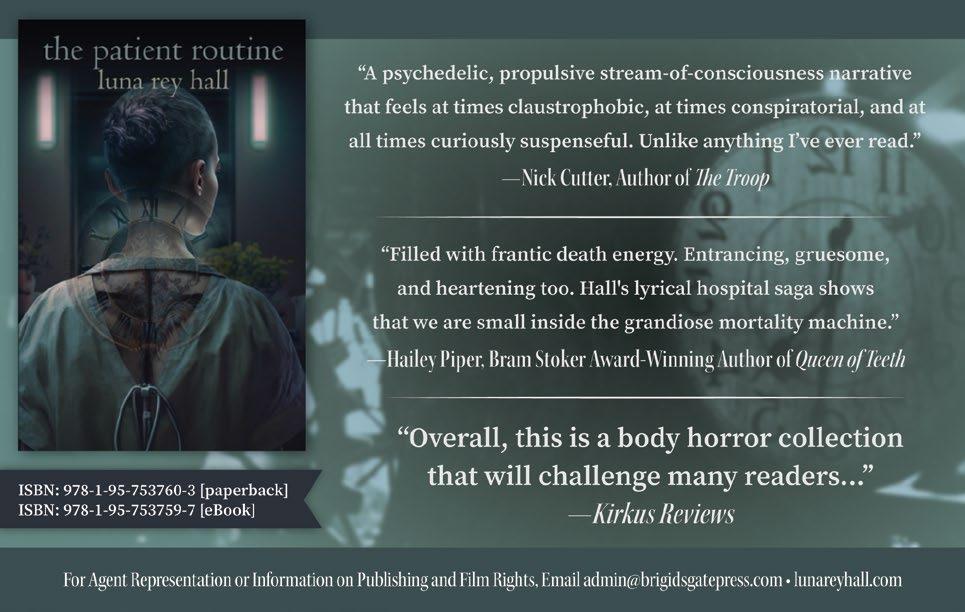
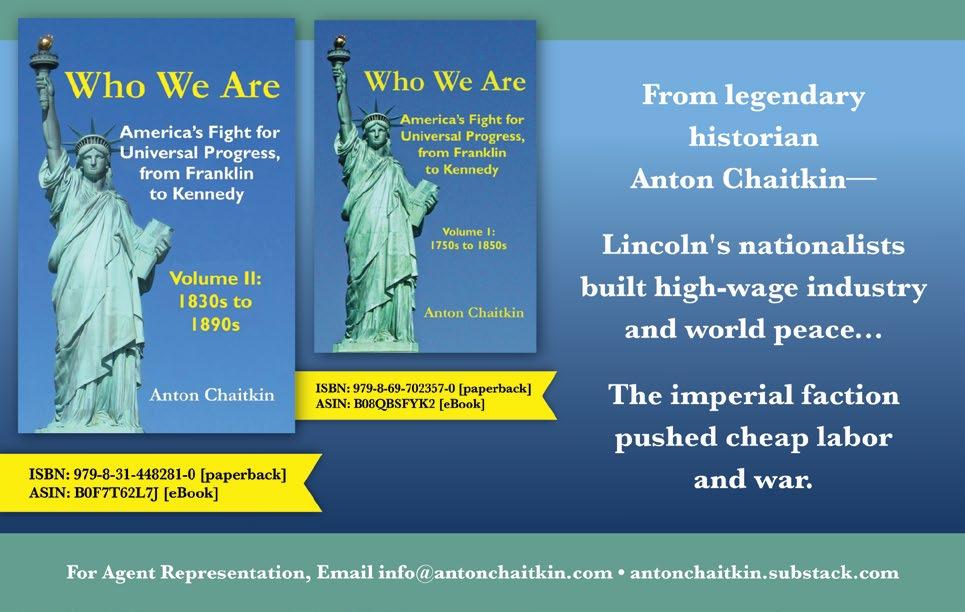







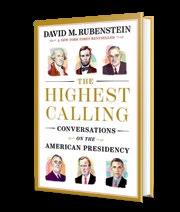
David M. Rubenstein will host the network’s new primetime series.
C-SPAN is launching a new primetime series focused on “the ideas that shaped America’s past, challenge the nation’s present, and inspire our future.”
The network will air America’s Book Club this fall, it announced in a news release. The series will be hosted by David M. Rubenstein, the lawyer and author of
books including The American Story and The Highest Calling
The show will be taped in front of live audiences at three cultural institutions. Guests appearing at the Library of Congress include U.S. Supreme Court Justice Amy Coney Barrett, John Grisham, Henry Louis Gates Jr., Arthur Brooks, and José Andrés. The National Archives will host Walter Isaacson and Stacy Schiff, while David Grann will appear at the Folger Shakespeare Library.
“C-SPAN is taking an ambitious step forward with America’s Book Club,” the network’s CEO, Sam Feist, said in a statement. “We are proud to launch a flagship series featuring guests of the highest stature in American letters and public thought, interviewed by David Rubenstein, a lover of history and an engaging interviewer. This program is a landmark cultural initiative designed to inspire, inform, and engage viewers with the ideas and thought leaders shaping our nation’s future.”

David M. Rubenstein

There is no premiere date for the series.
—M.S.

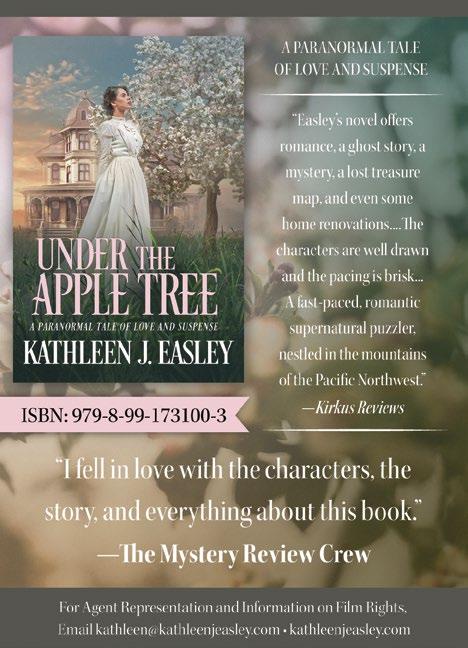
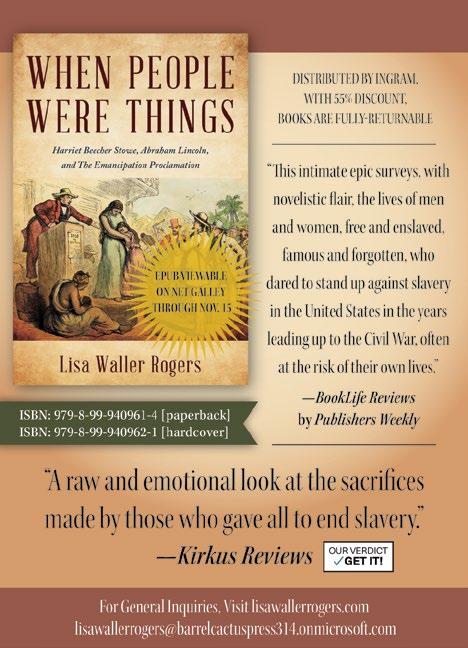

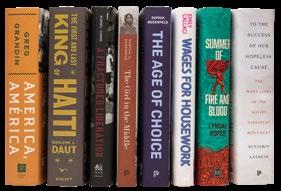
Greg Grandin and Marlene L. Daut are among the writers making this year’s shortlist.
The shortlist for the 2025 Cundill History Prize has been revealed, with eight books in contention for the annual award to a book that “embodies historical scholarship, originality, literary quality, and broad appeal.”
Greg Grandin made the shortlist for America, América: A New History of the New World, which covers 500 years in the history of North and South America. The book is a finalist for this year’s Kirkus Prize.
Marlene L. Daut’s The First and Last King of Haiti: The Rise and Fall of Henry Christophe was named to the shortlist, alongside Emily Callaci’s Wages for Housework: The Feminist Fight

For more literary awards news, visit Kirkus online.
Against Unpaid Labor ; Kornel Chang’s A Fractured Liberation: Korea Under US Occupation; and Benjamin Nathans’ To the Success of Our Hopeless Cause: The Many Lives of the Soviet Dissident Movement
Also making the shortlist were Lyndal Roper’s Summer of Fire and Blood: The German Peasants’ War ; Sophia Rosenfeld’s The Age of Choice: A History of Freedom in Modern Life; and Martha A. Sandweiss’ The Girl in the Middle: A Recovered History of the American West. Ada Ferrer, the chair of the prize’s jury, said in a statement, “The eight books on our list are all quite different from one another, but all share some essential characteristics: analytical sharpness, engaging writing, and a firm belief that what the past reveals must be urgently understood. The committee is so proud to present this slate of eight books to the world.”
The winner of this year’s award will be announced on October 30.—M.S.
become a Palestinian.” Her students attest to her generosity and encouragement. In her Poetry for the People class at UC Berkeley, students used Jordan’s “Guidelines for Critiquing a Poem” as a framework, a piece that several educators cite as an influence in their own teaching. For Jordan, poetry was art, craft, and a way of being in the world. As Xochiquetzal Candelaria recalls, “She described writing poetry as being like wrestling with an angel, letting us know that we were going to lose, but that the experience was blessed and transformational.” Interviewed about their relationship with Jordan, Angela Davis and British filmmaker Pratibha Parmar remember that after meeting her in Paris, they received on their breakfast tray a poem, “Solidarity,” celebrating their new friendship. A sense of solidarity informed Jordan’s life. She was compassionate, Davis recalls, “and felt deeply for everyone undergoing any form of oppression.” A deeply felt memorial.
Myers, Elyse | Morrow/HarperCollins (272 pp.) | $30 | October 28, 2025 9780063381308
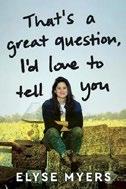
An experimental, illustrated essay collection that questions neurotypical definitions of what is normal.
From a young age, writer and comedian Myers has been different. In addition to coping with obsessive compulsive disorder and panic attacks, she struggled to read basic social cues. During a round of seven minutes in heaven—a game in which two players spend seven minutes in a closet and are expected to kiss—Myers misread the romantic advances of her best friend and longtime crush, Marley. In Paris, she accidentally invited a sex worker to join her friends for “board games and beer,” thinking he was simply a random stranger who happened to be hitting on her. In community college, a stranger’s request for a pen spiraled her into a panic attack but
resulted in a tentative friendship. When the author moved to Australia, she began taking notes on her colleagues in an effort to know them better. As the author says to her co-worker, Tabitha, “there are unspoken social contracts within a workplace that—by some miracle—everyone else already understands, and I don’t….When things Go Without Saying, they Never Get Said, and sometimes people need you to Say Those Things So They Understand What The Hell Is Going On.” At its best, Myers’ prose is vulnerable and humorous, capturing characterization in small but consequential life moments, and her illustrations beautifully complement the text. Unfortunately, the author’s tendency toward unnecessary capitalization and experimental forms is often unsuccessful, breaking the book’s otherwise steady rhythm.
A frank and funny but uneven essay collection about neurodiversity.
Pearson, Joseph | Pegasus (352 pp.)
$29.95 | December 2, 2025 9781639368587

A revisionist scrutiny of a humanitarian mission. Journalist and historian Pearson, author of My Grandfather’s Knife: Hidden Stories From the Second World War (2022), reminds readers that three years after their defeat, Germans were still hungry and their cities in ruins. Germany remained divided into four zones of occupation, as was its capital, Berlin, isolated and surrounded by the Russianruled eastern zone. For years, Stalin had pressured France, Britain, and the U.S. to withdraw from East Berlin, whose millions would join fellow citizens under Soviet rule. According to popular accounts, angered at the Allied refusal, he launched a blockade to starve the city into surrender, but a brilliantly organized airlift forced him to back down. This has been
portrayed as a victory of freedom over tyranny, and it was—sort of. Pearson’s Stalin remains the villain, but the Western allies do not get off scot-free. Aiming to rebuild the German economy (a low priority for Stalin), U.S., Britain, and France largely ignored denazification. In 1948 they planned to introduce a strong new Reichsmark that would devastate the feeble East German currency. Pearson maintains that the blockade was no such thing. Although Stalin blocked roads, rails, and canals from West Germany, this could be better described as harassment. The black market flourished. There was no rationing in the East, from which Berliners already obtained much of their food. Finally, the massive airlift required laborers, technicians, and construction workers; Western authorities paid them with money and food. “Even though they knew Berlin would not starve, the US and British authorities leveraged the illusion of a sealed city for propaganda.”
The dawn of the Cold War through a gimlet eye.
Rodrik, Dani | Princeton Univ. (280 pp.) $27.95 | November 4, 2025 | 9780691268316
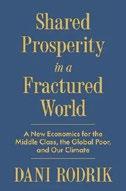
A thoughtful consideration of how to promote democracy, sustainability, and prosperity in a world riven by dislocation and conflict.
Harvard economist Rodrik identifies several existential threats to the modern world, foremost of them climate change, but also “democratic backsliding” and inequality, among other concerns. All are interrelated, he holds, and so are the solutions: Democracy requires a strong middle class; erasing global inequality requires alleviating poverty through economic growth; and saving the world from the worst ravages of climate change (which disproportionately affect
poorer countries) requires building green economies. The old means of growing prosperity through “export-oriented industrialization” no longer works, inasmuch as technology has done away with the need for manufacturing labor; thus calls to return manufacturing to the U.S. are misguided. In any event, Rodrick notes, the greatest job growth in the developed world lies in nonindustrial fields such as long-term care and food service, so the greatest need is for “more productive jobs for workers with less than a college education.” Advancing what he calls “productivism,” Rodrik also urges policymakers to stop looking for perfect solutions but instead settle for “second-best” approaches: “We might wish that free markets would generate a sufficient number of good jobs, but when they don’t, governments need to engage in interventions that will often look messy.” In his smart and generally nontechnical argument, the author considers the value of meaningful jobs, which provide not just a meal but also “dignity and social identity,” and he locates some of them in a greening of technology while also acknowledging that green jobs “are more skill intensive than the brown jobs they replace.” He also locates a revivified progressivism in this transformation: “The left must be an advocate for structural transformation, in the service of both good jobs and the green transition.”
A closely reasoned—and pragmatic—call for remaking the world’s economy.
Russell, Gareth | Atria (496 pp.) | $32 December 2, 2025 | 9781668049686
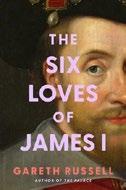
His majesty’s secrets.
If King James I (1566-1625) were alive today, he would probably be popular on social media and featured on TMZ. James was a genius linguist, poet, uniter of kingdoms, hunter, scourge of witches, translator of the Bible—even without the love affairs, he would have been a celebrity in any age. But the affairs are the focus of this book by
Russell, author of, among other works, The Emperors: How Europe’s Rulers Were Destroyed by the First World War (2014). Five of James’ six loves were men with whom he had homosexual relationships, beginning with adolescent crushes while James was James VI of Scotland. His longest love was Anna, the “dancing queen” he loved for the 30 years of their marriage. It was a complicated union, to be sure, but political and financial goals and the joint interests of the futures of their seven children made it a strong one. James grieved for months after Anna died. Loves No. 5 and 6 were homosexual affairs during the marriage. Robert Carr’s relationship with James began as a social one, with Carr eventually working his way into the political realm to steer the king into unpopular decisions favored by a faction in the court. Anna, distracted by the death of her newborn daughter and by the gynecological problems that would bring an end to her own sex life, eventually realized the need to halt Carr’s influence over James. In a surprising collaboration with the archbishop of Canterbury, she brought “one of the handsomest men in the whole world” to court and persuaded James to appoint him to the royal bedchamber crew, then to promote and eventually knight him. George Villiers, later the duke of Buckingham, quickly found his way to the king’s attention and from there to his bed. Until James died in 1625, he loved George.
A nuanced and compassionate portrait of a complex personality.
Serpell, Namwali | Hogarth (416 pp.) | $32 January 27, 2026 | 9780593732915
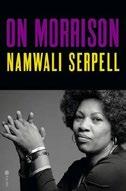
The Nobel laureate’s singular aesthetics. Award-winning novelist, essayist, and literary scholar Serpell offers a compelling elucidation of Toni Morrison’s notably challenging fiction, criticism, plays, and
poetry. “There are passages in Morrison’s works,” she has found, “that no reader I’ve ever met understands on the first go.” The source of Morrison’s “famed difficulty,” as Serpell sees it, was not “her intersectional identity, her prickly personality, or her contrarian politics,” but rather her complicated and sophisticated understanding of Black aesthetics. Serpell’s subtle textual analysis of 11 novels, “Recitatif”—Morrison’s only published short story—and several essays, plays, and poems is enriched by her prodigious literary background and insights she has gleaned from archival sources: letters, diary entries, notes, and manuscripts. Morrison, she asserts, “refused for her work to be reduced to her race and her gender, or to be forced to fit the expectations foisted upon her as a result.” Tar Baby (1981), Morrison’s fourth novel, seems to Serpell the first time in the writer’s career that she “directly addressed the white/black dichotomy” with characters who “are avatars for race.” Serpell gives extensive attention to “Recitatif,” a story in which “all racial codes” are vanished, yet one in which “racial identity is crucial” to its characters. The story emerges as “a kind of asymmetrical, contrapuntal, alternative dialogue” between its two female protagonists, “between an individual voice and the instruments of the social world, or between the reader’s experience and the story’s unresolved chords—or codes.” Celebrating Morrison’s “masterful difficulty and superb wit,” “her inscrutable yet perfect metaphors,” and “her unaccountable rushes of imagination,” Serpell affords ample evidence that she was “a writer whose deliberate difficulty—personal, political, and literary—defied classification…and made for brilliance.”
An impressive, nuanced work of scholarship.

Shone, Tom | Faber & Faber (448 pp.) | $45 November 4, 2025 | 9780571373222
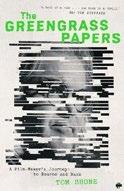
Interviews with and analyses of the films of Paul Greengrass. When 23-yearold Greengrass began his apprenticeship at the Granada TV program World in Action in England in 1978, a program controller gave him a piece of advice: “Don’t forget your job is to make trouble.” Shone, the author of previous cinema books about Quentin Tarantino and Christopher Nolan, documents the extent to which Greengrass heeded that advice. In this excellent work, a combination of critique and revealing interviews with the director, the author shows how World in Action sent him to various hot spots around the world and gave him important assignments. He covered hunger strikes at Maze high-security prison near Belfast, and an inquiry into Russian spies penetrating Britain’s security and intelligence departments led to his controversial book Spycatcher, “a prodigious feat of forensic research” that brought him to Hollywood’s attention. First, he directed several more documentaries and began developing his signature technique of the “unknowing camera,” a “rough, syncopated layering of zooms, reframings and racked focus that jolts the camera out of its traditional pose of omniscience and forces it to become a player in what it witnesses.” He has since used this technique in his Hollywood films, including United 93, Captain Phillips, and his trio of films about foreign service officer Jason Bourne. Shone does a nice job summarizing all of these works and dramatizing the challenges Greengrass faced, from disagreements with scriptwriters to his admission that he lost sight of his goals when shooting Green Zone, his 2010 film about Iraq. The book also contains amusing behind-the-scenes stories. For example, after the actor hired to play air traffic control manager Ben Sliney in United 93 didn’t work out, Greengrass
asked Sliney himself to take the role. Sliney’s reply: “I just want to say thanks for making me second choice to play myself.”
A well-informed peek into the career of a celebrated director.
Ed. by Shumway, David R. | Cambridge Univ. (400 pp.) | $35 | January 29, 2026 9781009350594
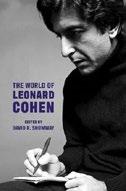
Critical essays on one of popular music’s most slippery songwriters.
Bob Dylan has nothing on Leonard Cohen (1934-2016) when it comes to cryptic musical personas. He was a successful singer-songwriter but came to it late, almost casually, after establishing himself as a poet and novelist in his native Canada. He wrote songs steeped in religious imagery—“Hallelujah” most famously—but kept his own faith vague. Though he was embraced by the counterculture, he had a nihilistic streak and was, as one writer here notes, “a long-standing member of the National Rifle Association.” The essays Shumway collects don’t pretend to make a coherent portrait—except, perhaps, as a man who tried to wriggle out of every attempt to categorize him. A trio of essays discuss his uneasy relationship with ’60s folkies like Dylan, ’70s singer-songwriters, and ’80s rock acts. (Eric Weisbard delivers a particularly thoughtful piece on Cohen’s ’90s revival, stoked by his music’s appearances in films like Pump Up the Volume.) Cohen songs are less sung than incanted, which leads many to dismiss them as simple; Alan Light’s appreciation of Cohen’s gift for melody offers an elegant, well-researched counterpoint. Numerous pieces touch on his uneasy relationship with the spotlight; his touring in his later years was less about ego than a desperate need for cash after a manager embezzled his funds. Some of the pieces have a strong whiff of academia about them, including explorations of his documentary appearances, “Hallelujah”
covers, and his songs’ relationship to Christian and Jewish musical traditions. But even at its wonkiest, the book feels celebratory toward Cohen, suggesting that his music and life offer rich material for cultural scholars. The closing essay, an overview of Cohen’s archives, offers a glimpse into the mass of notebooks, scraps of lyrics, and ephemera that still await the eager Cohen researcher. A well-curated set of considerations of an artist in all his diverse stages.
The Philosopher in the Valley: Alex Karp, Palantir, and the Rise of the Surveillance
Steinberger, Michael | Avid Reader Press (320 pp.) | $32.50 | November 4, 2025 9781668012956
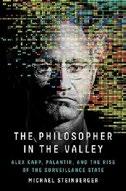
T he evolution of a selfdescribed “batshitcrazy CEO.” Alex Karp, the subject of Haverford College classmate Steinberger’s engrossing biography, fell into the orbit of libertarian and far-right activist Peter Thiel and became the CEO of Palantir Technologies, a data analytics giant. Indeed, although “an outlier in the tech industry” by any measure, in 2020 he was the highest-paid CEO of a publicly traded company, bringing down $1.1 billion in compensation, a level of wealth made possible by a nonstop string of huge post-9/11 government contracts. Granted, some of Palantir’s efforts have had broadly beneficial results: One of its software packages was used to develop new drugs, track foodborne illnesses, and help deliver food to refugees. But more, Palantir’s fortunes were closely linked to the U.S. intelligence community and military, even though, at the company’s start, writes Steinberger, “neither Thiel nor his associates had ever worked with the government…and had no clue as to how counterterrorism analysts wanted information presented.” Good
engineering made up for that. And while at first Karp held out for privacy controls by which, in the case of one program, “users were able to access only information that they were authorized to view,” those niceties fell by the wayside in time: “Palantir landed contracts with a number of federal agencies, including the FBI, the IRS, the SEC, the Department of Homeland Security,” writes the author. As for Karp? Despite having been a biracial student of the German social philosopher Jürgen Habermas who “had written his dissertation on the rhetoric of fascism”— and who indeed once told Steinberger, “My biggest fear is fascism”—the former “neo-socialist” is all in for Trump, denouncing the Democratic Party as “woke, pagan ideology.” But as MAGA champion Nick Fuentes said, “If Palantir isn’t the Deep State, then what is?” A chilling portrait of genius in the yoke of authoritarianism.
Turner, Gerry | Grand Central Publishing (224 pp.) | $30 | November 4, 2025 9781538772102
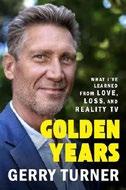
An unconventional reality television series contestant tells his side of the ordeal. Retired restaurateur Turner was 72 when the inaugural episodes of ABC’s Golden Bachelor aired in 2023. Widowed from his longtime wife, who had been his teenage sweetheart, he ultimately applied for the show’s senior spinoff version after realizing how much he truly needed “to move on after forty-three years of a wonderful marriage.” In amiable, conversational prose, the author retraces his bucolic early years growing up in the rural Midwest with hardworking parents. He met his late wife, Toni, in high school, and their youthful whirlwind romance resulted in a solid marriage and two daughters, despite early financial challenges that caused him to forgo law school and embrace restaurant
management. His televised search for a wife and soulmate began in the bachelor mansion in Los Angeles, where he was greeted by 22 zesty, eligible women with whom he shared weeks of melodramatic confessions, adventurous compatibility test dates, romantic hometown visits, and a “gut-wrenching” succession of rose ceremonies (often recorded in long overnight sessions). “Instead of Mr. Right, I felt like the villain, or the executioner releasing the rope on a guillotine,” he admits. Turner details all the connections, mishaps, and dating dilemmas with a smoothly written mixture of honesty and emotional maturity. From his first kiss with smitten contestant Theresa Nist, to another woman’s crushingly unexpected departure, to a marriage proposal in Costa Rica, Turner writes frankly about his regrets from the show, his newly uncovered bone marrow cancer, and, to fans’ delight, the intricacies and delicacies of the show’s “illusions of grandeur.” He also includes the shockingly sharp edges of his new marriage to Theresa, which ended in divorce after only three months. Despite that, his performance was enough to secure future installations of the spinoff, but for now, Turner writes that his focus will remain on his health and on being a proud grandfather and single father. An honest, if bittersweet, reality TV confessional.
Tyler, Gary with Ellen Bravo One Signal/Atria (288 pp.) | $29 October 7, 2025 | 9781668097328
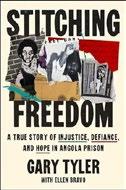
Freed at last. When Tyler was 16, the police in his Louisiana town falsely accused him of the murder of a 13-year-old white classmate. Although Tyler was innocent, his working-class Black parents mistakenly hired a divorce attorney to take his case. Tyler writes that the lawyer’s
incompetence and callousness, the police intimidation of witnesses, and the purposeful delay of his court date all resulted in the court’s sentencing him as an adult rather than as a juvenile. Facing the death penalty at the age of 17, Tyler was sent by the state to Angola, the Louisiana penitentiary that the author describes as “one of the bloodiest, most dangerous prisons in the country.” In prison, he became politicized when incarcerated members of the Black Panther Party took him under their wing, exposing him to writings by Malcom X, Karl Marx, and Ho-Chi Minh. He volunteered for a hospice program, joined a drama club—performing in plays about racial injustice—and earned his GED. After 41 years of working with lawyers, his death sentence was overturned, and he was freed from prison. Tyler infuses this devastating memoir with hope and passion, deftly using his story to shine a light on the racism embedded in the American prison system. Although he does not shy away from the horrific details of being sentenced to death as a teenager, he also refuses to be seen as a victim, taking control of his narrative through trenchant analysis and self-reflection.
A falsely accused inmate’s devastating tale of surviving incarceration.
Ullrich, Volker | Trans. by Jefferson Chase Norton (400 pp.) | $35 | November 11, 2025 9781324110545
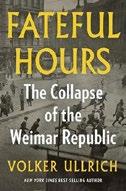
U llrich, the author of a two-volume biography of Hitler, examines Germany’s first, shortlived democracy. At the conclusion of World War I, in 1918, the German polity was mostly ready to be rid of kaiserism and was leaning well to the left, thanks in large measure to the return of disaffected, radicalized armies from two fronts. One key incident was a revolt among sailors
who refused to sail into battle against the British fleet, launching a vast mutiny during which “workers and soldiers everywhere formed revolutionary councils.” The radical movement eventually morphed into a moderate, center-left government that immediately faced several challenges, including periodic armed revolts by right-wing paramilitaries that would spawn a far-right opposition constantly engaged in plotting coups. Enter Adolf Hitler and his National Socialists, who, though decidedly a minority party, grew to become the vanguard of the right thanks in some measure to constant blundering on the part of the Weimar government—one mistake being not suppressing the Nazis in the first place. Yet, as Ullrich notes, “Hitler’s ascent to power was the product of a sinister game of behind-the- scenes intrigue in which a handful of players pulled the strings,” including industrialists and financiers who were all too glad to fund any effort that branded itself as anti-communist. The author argues throughout that nothing associated with Hitler’s rise was inevitable: Instead of making him chancellor, for one, President Paul von Hindenburg could have dissolved the Reichstag and postponed elections, which “would have meant a barely disguised military dictatorship,” but also would have allowed an improving, inflation-ridden economy to stabilize. The parallels to our own time, as Ullrich lays them out in this fluent narrative, are alarming, with new authoritarian parties and governments following the fascist playbook in every detail, from culture wars and book banning to anti-immigration decrees and the steady, willful “erosion of the constitution and democratic practices.”
An uncomfortably timely reminder that democracies are fragile things that can turn into dictatorships overnight.
Vedral, Vlatko | Basic Books (304 pp.) | $30 October 28, 2025 | 9781541604780
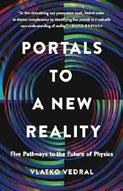
Quantum physics without limits. Physics is at a stalemate. Its two best theories—Einstein’s theory of gravity and quantum mechanics—can’t both be right.
Vedral, a physicist at the University of Oxford, is placing all his bets on the quantum. Our physics woes, he says, come from our failure to see quantum theory as truly universal, governing everything from atoms to people to the universe. For this he blames proponents of the so-called Copenhagen interpretation for placing observers outside the scope of the quantum, granting them a special status to affect what they observe. Despite what you’ve heard, Vedral insists, nothing depends on the observer. “The story I want to tell,” he writes, “is actually more beautiful, engaging, and convincing than the versions we have all heard for too long.” The bulk of the book is concerned with possible (if not plausible) experiments to test the reach of the quantum. Can the gravitational field exhibit quantum entanglement? How about living things? Vedral claims that one experiment has already produced quantum entanglement between tardigrades (adorable micro-animals also known as moss piglets) and the components of a quantum computer. (Others claim it merely produced cold tardigrades.) Erwin Schrödinger famously (and facetiously) described a cat in a superposition of both dead and alive. Vedral wants to put everything in superpositions: bacteria, physicists, clocks, the flow of time itself. Understanding how truly quantum everything is may require new language, new analogies, new mathematics—even then, Vedral says, we may only accept the truth of the quantum when we
rise was not inevitable.
ourselves can have quantum experiences. How? By redesigning our neurocircuitry to allow for “quantumly augmented perception.” These are wild ideas, which Vedral delivers with enthusiasm, technical know-how, and a few too many exclamation marks (“Heisenberg decided not to quantize time!” “Maybe the whole of mathematics just follows from the laws of physics!”).
Average readers will find the details too abstruse. Readers immersed in popular physics may enjoy a new perspective. Is it more beautiful, engaging, and convincing than the rest? That depends on the observer. An iconoclastic take on the laws that shape reality.
Vogel, Kenneth P. | Morrow/ HarperCollins (400 pp.) | $30 October 14, 2025 | 9780063341210

Influencers of a different kind. This is an impressive exposé of an industry that aims to connect “toxic” overseas clients with lawmakers from both parties. Some readers would happily forget this book’s infamous figures, but Vogel delivers an important message: The foreign influence business is “more rapacious than ever.”
Though the New York Times reporter is perhaps too permissive in letting his subjects spin suspect anecdotes, his book is full of small scoops backed by “previously unreported” memos, letters, and emails. Headed by Paul Manafort, Hunter Biden, Rudy Giuliani, and relative newcomer Robert Stryk—“rhymes with ‘trick,’” Vogel slyly writes—the cast of rogues gets help from erstwhile U.S. officials who wield their résumés for ethically hazy profit. Government documents show that authoritarian governments spent $150 million on “disclosed lobbying” in two recent years. Such efforts “can shape the treaties, tariffs,
and trade policies” that affect consumer prices and jobs. Vogel’s subjects are unembarrassed, openly repping warlords, kleptocrats, and dictators. “I helped fix an election in a very important African country based upon U.S. interests,” says Stryk. Hunter Biden alluded to his father’s power when negotiating with a Chinese businessman and “work[ed] against stated U.S. foreign policy interests” in Romania. Ex-FBI boss Louis Freeh has made money authoring “nominally independent reports” boosting the reputations of foreign leaders facing charges, the author writes. This isn’t a new phenomenon. Vogel helpfully notes that Jimmy Carter’s son and brother lobbied for overseas strongmen. The industry “didn’t slow during Obama’s administration or Biden’s,” and President Trump’s attorney general Pam Bondi—herself a former lobbyist for Qatar—has axed some of the FBI’s anti–foreign influence tools. As this smart, brisk book shows, there’s “never been a moment like this” for what one lobbyist calls their “shitbag world.”
A damning journalistic survey of the lucrative business linking despots and D.C.
Wit, Joel S. | Yale Univ. (560 pp.) | $38 October 28, 2025 | 9780300278774
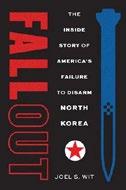
On American “miscalculations, misunderstandings, and myths.”
Wit, a fellow in Asian Security Studies at the Henry L. Stimson Center, draws on more than 300 interviews— and his own astute observations as a participant in decades of roller-coaster nuclear weapons negotiations—for his fast-paced and eye-opening account of North Korean–American nuclear weapons diplomacy. The author reveals a fascinating terrain of shifting priorities and players that are shaping an increasingly dangerous world. He brings considerable clarity and pithy writing to bear on a confusing muddle of ambivalent diplomacy, political
infighting, and changes in direction that have marked U.S. attempts to thwart North Korea’s efforts to join the ranks of nuclear powers. Process, politics, and personalities are foregrounded as the baton passes from president to president over six administrations, from Jimmy Carter to Donald Trump. The author’s adroit descriptions capture the flavor and pace of events. Throughout, the story circles back to the chilling consequences if diplomacy fails and the world tips into nuclear conflict—a possibility that motivates participants on all sides to continue the dialogue, even when it proceeds by fits and starts or stalls entirely. He writes, “Today, North Korea can inflict devastation on major American cities, killing hundreds of thousands and possibly millions of people in thirty minutes, a far cry from 1994 when it didn’t even have a single nuclear weapon.” Ultimately, Wit says, “two presidents, Barack Obama and Donald Trump, bear special responsibility since the greatest threat emerged during their time in office.” North Korean dictator Kim Jong Un is presented here in a nuanced portrait as the leader of a small country “engaged in provocative behavior intended to convince Washington to take it seriously.” This intriguing survey of a critical global struggle is readable and sobering. Those wishing to dive deeper will find ample footnotes pointing to primary sources. A lively, frightening peek behind the curtain at nuclear weapons negotiations between the U.S. and North Korea.
Ziegelman, Jane | St. Martin’s (240 pp.) $28 | January 20, 2026 | 9781250284334
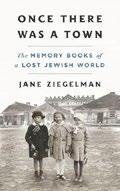
Lifting up their voices. For Jewish communities after the Holocaust, so-called Yizkor books were put together to recall the particulars of towns, the names of families, and the material culture of a vanished world. Ziegelman,
author of 97 Orchard: An Edible History of Five Immigrant Families in One New York Tenement , brings together stories of her family to re-create the everyday experience of that world. We get everything from the mundane to the sublime. “The potato occupied the base of the shtetl food pyramid,” she writes. Although men could escape the potato world of the senses by devoting themselves to lives of prayer and study, it was the women who lived in the here and now. “While the men were at synagogue singing and dancing, back at home, wives and daughters sat in total darkness, waiting for the first three stars to appear in the sky, the signal that Shabbos was over and the new week had started. They told stories and chatted with neighbors.” There is a poetry to this life, and the author points out the possibilities of beauty in a time of want. This is really a book about the place of women in creating beauty, a story of what might be called a shtetl sublime. Often silenced by judgmental men, women “commiserated with each other….Yizkor books provide flashes of what those conversations sounded like: Grandmother used to say, ‘Lift up your voice in front of the whole world and shout I am alive !’” Ziegelman offers such a shout, affirming the nature of Judaism not so much as a set of creeds but as a practice of storytelling. Jewish life centers on the word. But it centers, too, on the awareness that words are imperfect mirrors to the world. No words can describe past horrors. The author makes a valiant effort, evoking a world of song and story, faith and belonging. A moving collection of reminiscences of European Jewish life before the Holocaust.

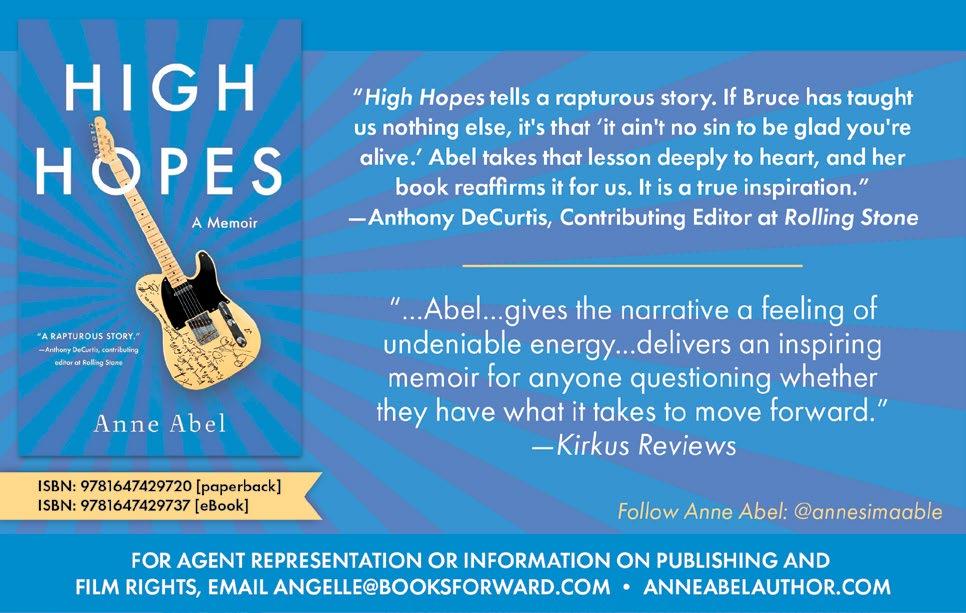
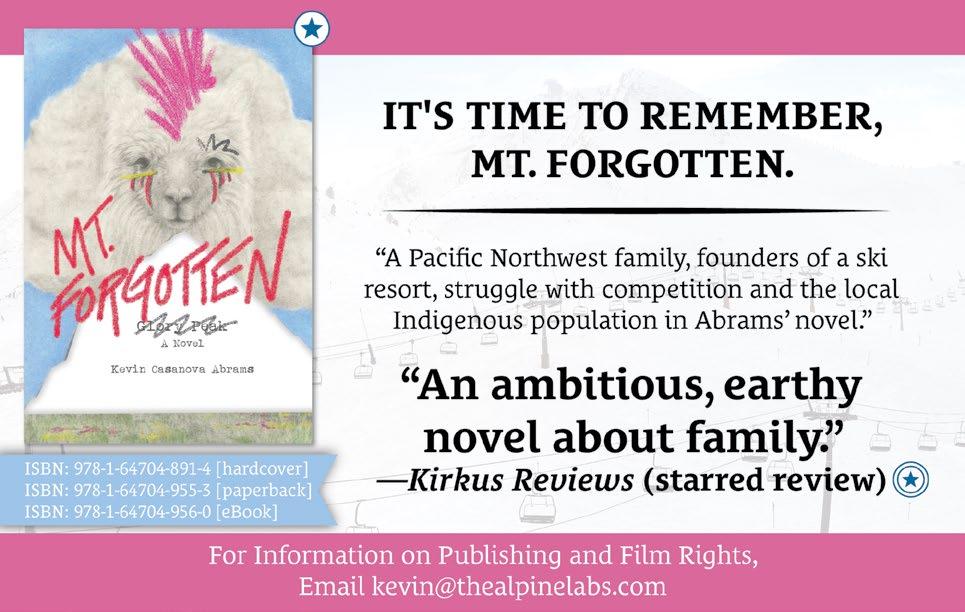


EDITORS’ PICKS:
Katabasis by R.F. Kuang (Harper Voyager)
Tonight in Jungleland: The Making of Born to Run by Peter Ames Carlin (Doubleday)
The Teacher of Nomad Land: A World War II Story by Daniel Nayeri (Levine Querido)
White Lies by Ann Bausum (Roaring Brook Press)
THANKS TO OUR SPONSORS:
Scorpions Ascent by Hollisa Alewine
Quiet Mind Crazy Heart by Suzi K. Edwards
Deadly Vision by T.D. Severin
Fully Booked is produced by Cabel Adkins Audio and Megan Labrise

An author offers a stunning account of their life as an elite firefighter. BY MEGAN LABRISE
On this episode of Fully Booked , I’m joined in conversation by River Selby, author of Hotshot: A Life on Fire (Atlantic Monthly, August 12), a powerful debut memoir chronicling their time as an elite firefighter. “With fortitude and admirable vulnerability, Selby brings readers directly into a tumultuous time and place,” Kirkus writes in a starred review. “Like fire, this book burns hot.” Selby was born in Los Angeles, grew up in the Pacific Northwest, and spent seven years working as a wildland firefighter, stationed out of California, Oregon, Colorado, and Alaska. They earned an MFA in creative writing from Syracuse University and are currently pursuing a Ph.D. at Florida State University. Their writing has appeared in the New Ohio Review, Bellevue Literary Review, Vox , and High Country News They live in Tallahassee.
Here’s a bit more from our review of Hotshot: “Selby had been a sex worker, a heroin addict, and a runaway by the time they began wildland firefighting at age 19. As much to their surprise as anyone’s, they found themself both loving and excelling in the firefighting ranks. In this debut memoir, they recount their years on the most elite—and male-dominated—firefighting crews in the country. With visceral prose, they bring readers directly to the heat and intensity of the front lines day and night, where in the darkness ‘coursing waves of embers shot upwards from conjoined flames as if the sky were reclaiming its lost stars.’…Shot through with their own challenges of bulimia, alcoholism, and relationships, the story is one of power and resilience, of someone



Hotshot: My Life on Fire Selby, River Atlantic Monthly | 304 pp. | $27 August 12, 2025 | 9780802149497
struggling to make a life for themself in the inhospitable and challenging career of wildland firefighting.”
Selby and I discuss the meaning of the term hotshot , the physical challenges of firefighting, the tools of the trade, and the sexism they faced on majority-male crews. We discuss the ecological consequences of fire suppression, and Indigenous practices of tending fire. They share their journey to becoming a writer, the importance of a supportive editor, and much more.
Then editors Laurie Muchnick, John McMurtrie, Mahnaz Dar, and Laura Simeon share some of their top picks in recent books.
HALLOWEEN IS NEARLY here, and that means it’s time to break out the scary stuff. But matching a reader with the right horror novel is tough. Recommend the wrong book, and you risk dooming a kid to weeks of nightmares. Luckily, we’re now experiencing a middlegrade horror renaissance; there’s something to entice both certified scaredy-cats and those eager to swap out R.L. Stine for Stephen King. Below are some appropriately eerie recommendations for spooky season, from slightly frightening to utterly disturbing.
MILDLY CHILLING (��): It’s never too early to introduce kids to body horror. In Aaron Reynolds’ spectacularly silly chapter book Troubling Tonsils! (Simon & Schuster, September 2), a young marmot arrives at the hospital for a
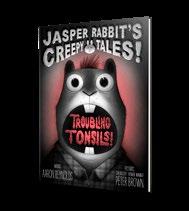
tonsillectomy, only to learn that his wayward organs have gone AWOL. Though the premise is creepy, the vibes are gleefully goofy as Reynolds’ narration cleverly riffs on The Twilight Zone Illustrator Peter Brown’s images convey both the “aww” and “eww” factors: The cast of anthropomorphic animals is downright adorable, while the tonsils are rather menacing.
SUSPENSEFUL BUT SWEET (����): Rory, the Japanese American protagonist of Ellen Oh’s The House Next Door (Harper/HarperCollins, September 30), is conflicted at the prospect of having new neighbors; he quickly befriends Korean American Jack and his little sister, Mira, but he knows that their home is haunted. The children must work together when malevolent creatures—perhaps yokai,
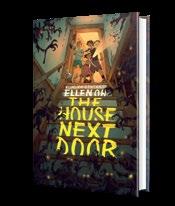
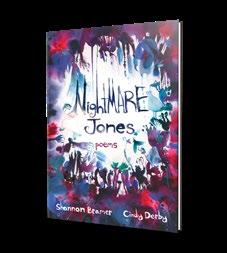
monsters from Japanese folklore—begin stalking Mira. Though Oh establishes a suitably ominous tone, she metes out the chills judiciously, folding in plenty of humor; the result is a tale ideal for newcomers to the genre.
EERIE AND UNCANNY (������): A dollhouse inhabited by spiders, a “drawer full of teeth”: Shannon Bramer’s Nightmare Jones: Poems (Groundwood, October 7) is rife with such haunting imagery, matched by Cindy Derby’s beautifully strange artwork. More surreal than truly terrifying, these poems invite contemplation. Intriguingly, Bramer writes about monsters—from a scorpion’s child to a mermaidlike creature with a hole in her head—with a rare tenderness and affection.
HIGH CHANCE OF NIGHTMARES (��������): Paul Tremblay’s Another (Quill Tree Books/HarperCollins, July 22), illustrated by Sam Wolfe Connelly,
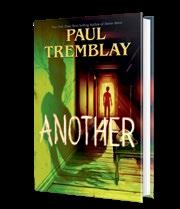
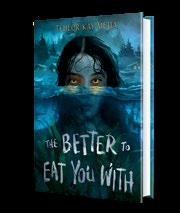

follows Casey as he befriends a most unusual boy: Morel arrives in a burlap sack, has claylike skin, and doesn’t eat or sleep. But Casey’s parents seem unbothered—and even happy—as Morel swiftly grows more like Casey. Drawing inspiration from Invasion of the Body Snatchers, adult horror writer Tremblay clearly knows how to terrify tweens; Casey’s fear that his family might prefer a new and improved version of him is far more unnerving than the admittedly unsettling Morel.
FOR THE BRAVEST OF THE BRAVE (����������): In Tehlor Kay Mejia’s The Better To Eat You With (Delacorte, September 23), Evan again spends the summer by the lake, but this year, her appearance-obsessed mother’s attitude toward food has left Evan too anxious to eat. Drawing parallels between an actual monster lurking around town and Evan’s burgeoning eating disorder, Mejia offers visceral descriptions of her protagonist’s turbulent psyche, marked by self-loathing and insecurity. Sensitive readers should heed the Kirkus review, which calls the book “not for the faint of heart,” but those willing to tread a dark path will be immensely satisfied.
Mahnaz Dar is a young readers’ editor.
In an old gymnasium in Massachusetts in 1891, the legendary game of basketball was born.
Invented by James Naismith, a white PE teacher tasked with keeping his energetic students active in the winter, “basket ball,” as it was then called, was initially a slow game played with lumpy leather balls and wooden baskets without backboards. The sport underwent an epic journey of transformation and innovation—with more than a dash of Black excellence—to become the fast-paced, high-scoring game we enjoy today. Jam-packed with wellresearched historical
context, each chapter is compelling; Caldecott Medalist Nelson writes in an invitingly conversational tone while including plenty of basketball slang and jargon, with definitions seamlessly incorporated in a glossary. This detailed work doesn’t shy away from the game’s history of racism, discrimination, and exclusion, though Nelson also celebrates Black players’ impact on the game. He combines thorough history with full-spread features on some of basketball’s GOATs, from Bill Russell to LeBron James. Nelson finishes with a section on the parallel history of women’s basketball, noting
Selina Alko
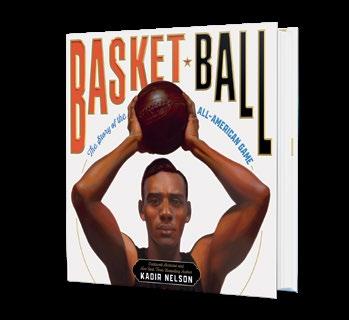
its groundbreaking influence and the challenges that female professional athletes still face. His breathtakingly realistic oil paintings give readers a courtside seat to the action; in the creative page design, text is wrapped
around stunning images of larger-than-life legends, some based on iconic photos of basketball history. A backboard-shattering slam dunk. (author’s note, timeline, notes, sources, index) (Nonfiction. 9-13)
OTHERWISE KNOWN AS JUDY THE GREAT
Adele, Amy | Magic Cat (32 pp.) | $18.99 December 2, 2025 | 9781917366892
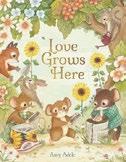
Kind, cuddly, communityminded critters keep a garden growing during the gardener’s prolonged illness. Mabel and Stan, a rosy-cheeked older couple, live in an “ordinary house,” but their garden, filled with curving paths, abundant plants, a greenhouse, and an apiary, is marvelous. It also contains creatures who fill Mabel’s days with cheer. She’s created a welcoming environment for all, even the mouse family that’s just moved into the shed. When Mabel is taken away in an ambulance, all the anthropomorphized creatures are concerned. As the days drag on and Mabel doesn’t return, not only does the garden fall into disrepair, but the mice recognize that Stan is suffering, too, seemingly lost without his beloved counterpart. The animals who were cared for so tenderly by Mabel return the favor by looking after the garden (and Stan) until she returns. With its focus on community care, neighborly love, and outreach to older adults, the story is both uplifting and important—forging bonds with our elders in their sunset years brings connection and combats loneliness for everyone involved. Though adult readers may find the narrative a tad saccharine, the child-friendly message is entirely appropriate for its intended audience. Bright, lively watercolor illustrations fill the pages with cheer. Mixes of full-page spreads and spotlighted illustrations surrounded by white space add dimension and variety to the layout. Human characters have pale skin. A heartwarming story with a timeless message. (Picture book. 3-7)
Agarwal, Namrata | Illus. by Parvati Pillai Holiday House (32 pp.) | $18.99 September 23, 2025 | 9780823454976
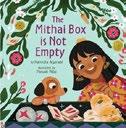
A girl of South Asian descent throws a chai party for her visiting grandparents. Young Ria and her faithful dog, Cheetah, are busy preparing to welcome Baba and Dadi, who are flying in from India. Ria greets them with warm hugs, and they ply her with presents and a mithai box bursting with her favorite sweets. As Ria makes an offering of a ladoo to the god Ganesha, her grandmother teaches her the phrase “Atithi Devo Bhava. Like God, we welcome our guests with warmth and respect.” As guests arrive, Ria offers them mithai, but when it quickly empties, she wonders if she’ll be able to taste one of the goodies herself. Happily, her grandmother points out that there’s one sweet waiting just for her—the ladoo she offered to Ganesha. Agarwal and Pillai easily capture a youngster’s warring impulses; Ria’s desires to be a good host feel as relatable as her mounting dread at missing out on her favorite treat. The scene where her kindness and generosity are at last recognized serves as a gentle reminder of the importance of sharing with others. The kaleidoscopic colors and floral patterns in bright oranges, pinks, and greens create a lively and bustling backdrop. Images of Ria’s diverse friends gathering around delicious food and steamy cups of tea create a cozy, warm, and welcoming tone. A sweet story that speaks to the joys of sharing. (author’s note, more about mithai, glossary) (Picture book. 4-8)
Alko, Selina | Christy Ottaviano Books (48 pp.) | $18.99 | February 17, 2026 9780316570633

In 21 poems, Alko celebrates the boundarybreaking writer. These beautifully crafted, deeply intimate entries brim with delighted reverence, reflecting Alko’s own comingof-age reading Judy Blume’s novels. The verse details Judy’s family relationships and seminal events in a loving, secular Jewish household in Elizabeth, New Jersey. Though her older brother David is rather naughty—reducing their mother to tears one April Fools’ Day—Judy adopts a quiet, “good girl” demeanor. Adults are distant and uncommunicative, so Judy takes refuge in her rich imagination, seeding her future authorship of books that will help kids navigate the uncertainties of growing up. “Fake Book Report” provides a lively example of that incipient imagination: Tired of boring kids’ books, Judy writes a report based on an imaginary story—and gets an A! Many titles riff humorously on Blume’s own books. “Tales of a Fourth Grade Reader” declares that “the very best gift” that Judy’s mother, Essie, bestowed “was letting her read whatever she wanted.” Five poems adopt the first-person, diarylike questioning of Blume’s Are You There God? It’s Me, Margaret. “World War II” begins, “Are you there God? / It’s me, Judy.” Experiencing the far-off war’s horrors via radio broadcasts with her family, Judy echoes Margaret’s bargaining voice: “God, if you end the War soon, / I don’t need to be a movie star.” In Alko’s charming illustrations, collaged text from newspapers and Blume’s own novels underpin bright, richly detailed acrylics. Most depicted characters appear white.
A sparkling introduction to a literary powerhouse’s oeuvre. (author’s note, timeline, sources, photographs) (Picture-book biography/poetry. 6-10)
Ambrosecchio, Laura | Illus. by Barbara Bongini | Clavis (32 pp.) | $16.95 August 19, 2025 | 9798890631213
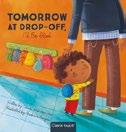
It’s the first day of school, but this youngster is most definitely not ready. As Mom and Dad leave, the child cries out, but the teacher offers a hug, sings a song, and reads a book aloud. Though the young narrator’s reluctant to join in, it’s tough to resist the fun, and eventually our protagonist is having a good time. Ambrosecchio acknowledges the fear and sadness that can ensue when children are separated from their parents, but she also believably traces the main character’s increasing ease and engagement as the day progresses. The book’s title reflects its upbeat message: Tomorrow the child will truly look forward to attending school. The rhythm and rhyme of the simple four-line stanzas set a slow and calm pace that leaves plenty of room for parent/child discussion and reassurance before turning the page. Each verse clearly captures the protagonist’s changing emotions while also showcasing a typical busy preschool classroom that’s led by a caring teacher and features activities such as storytime, blowing bubble dances, snack time, and outdoor play. Bongini’s illustrations, always colorful and full of energy, become slightly more vivid as the day progresses and the child becomes happier. The protagonist is brownskinned with curly dark hair, the teacher is pale-skinned with a reddish bob, and the students are diverse. A gentle tale sure to help children transition with ease to a new learning environment. (Picture book. 3-5)

Arnett, Robbie | Illus. by Luciano Lozano Viking (32 pp.) | $18.99 | February 17, 2026
9780593690635
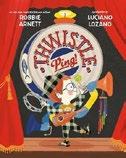
A n inventive lad with a wise teacher learns that there’s no such thing as being nonmusical. In stumbling rhyme, Arnett tells the tale of Lennie Fling, who “recited poems in Latin and spoke fluent French. / He read Steinbeck and admired Dame Judi Dench,” but he couldn’t play music. Dismayed to learn that he must participate in a recital at school, Lennie visits “groovilicious” musician neighbor Floretta Flynn. She invites him to listen inside himself, and in no time he’s not only pounding out a funky beat on a bucket, but also constructing an elaborate music maker from pots and pans and other household items. This is where the narrative and pictures diverge, since visually, Lennie’s makeshift “Thwistle Ping” doesn’t incorporate the items actually mentioned and also looks different on different pages. Lennie goes on to help his diverse group of classmates make musical inventions of their own from common if sometimes unlikely components, but readers are left in the dark about how some suggested “instruments,” particularly a lamb chop or meat loaf, might actually be played. Lennie, his mom, and Floretta have skin the white of the page, while Lennie’s dad has light tan skin.
Sloppy and discordant. (Picture book. 6-8)
Auld, Mary | Illus. by Hannah Bailey Red Comet Press (28 pp.) | $15.99
November 11, 2025 | 9781636551678
Series: Start Small, Think Big, 6
For more back-to-
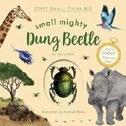
found on every continent but Antarctica, and “in forests, farmland, and deserts,” as well as in the savanna. Among the many books about the dung beetle, this one stands out for tracking a particular beetle’s life cycle, but without giving it a name or personality, or making poop jokes. The beetle mates and tunnels, and its offspring grow inside their dung balls, subject to possible predation. A page of life-size images shows some varieties among the 5,000 species. The language is clear and accessible, with Latin names supplied for many species. The art is detailed enough to be accurate about the small insects while also providing an impression of the savanna landscape. The glowing emerald beetle stands out among the soft-edged images in neutral browns. Small-type captions filled with information make the reading experience more suited to one-on-one; in addition, the book’s “find the animal” challenges require individual attention. Kids’ preoccupation with poop provides the perfect opportunity to learn about the important environmental work performed by the dung beetle. An edifying and attractive look at a fascinating insect.
(Informational picture book. 5-9)
Avery, Sean E | Walker Books Australia (144 pp.) | $15.99 paper | September 9, 2025 9781760659356 | Series: Ducky the Spy, 1
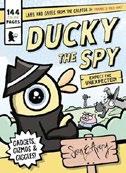
Poop-policing beetles help reduce pests.
Auld focuses on an African beetle, but as her informationpacked book notes, similar species are
A duck in a trench coat dispatches his duties as barnyard spy. Ducky is a wacky-looking spy, always seen in profile, his rounded beak poised for inquiry, one big blue-irised eye expressing every emotion, be it suspicion, confusion, or glee. His boss is the exasperated Mr. Pig, and Ducky’s surveillance sidekick is Donny, a wonky-eyed, usually drooling donkey. They form an unlikely team, often getting in their own way as they
conduct their investigations. Ducky’s spy skills, or lack thereof, are tested in two stories. First, Mr. Pig enlists Ducky to uncover who’s been eating from his slop trough, but they soon discover that the trough is doing double duty as Donny’s treat bag refill station. Reluctantly, Mr. Pig then asks Ducky to help retrieve his son (a goat, inexplicably) from the clutches of the Cat Gang. The spy content is secondary to the story’s comedic beats, with Ducky’s placid personality, Mr. Pig’s perturbability, and Donny’s clouded consciousness colliding on repeat. Employing high-paced absurdist humor akin to that of Aaron Blabey’s The Bad Guys series, Avery puts visual gags front and center, as when a poorly-put-on cat costume makes Donkey’s butt appear to be a feline face. Backgrounds simulating half-tone-style comic printing and bold foreground lines give the series an appreciably retro look. A lighthearted, slapstick series starter that’s sure to please. (Graphic fiction. 6-9)
Barton, Jen | Illus. by Felishia Henditirto Magination/American Psychological Association (32 pp.) | $18.99 October 7, 2025 | 9781433847462
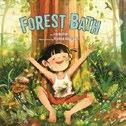
What could be better than a warm bubble bath with a favorite rubber ducky?
Why, a forest bath, of course. The East Asian–presenting young narrator of this tale soaks up the sights, sounds, and senses of the woods while the child’s watchful mother stands nearby. As dragonflies and butterflies zoom around, the child luxuriates in everything nature has to offer: “I wash between my toes” (an accompanying illustration depicts the youngster leaping barefoot through the mud) “and scrub my back” (with a branch); “I hunt for the sponge” (a lichen) “and pat my face.” By the time the child returns home for an actual soak in the tub, readers will wish they, too, could join this delighted family.
In the backmatter, Barton notes that forest bathing, or shinrin-yoku, was introduced by the Japanese government in the 1980s to encourage people to “take a break from technology” and “[immerse] yourself in nature as you might in a bath.” Readers will emerge just as “bright and sparkling” as the enthusiastic protagonist, who isn’t at all squeamish about getting wet or dirty. The clever use of terms associated with a traditional bath (“test the water”) makes the story even more relatable. Barton’s words and Henditirto’s luminous artwork combine for a sensuous experience that just might prompt readers to take a quick walk or dip into the woods or a nearby park. An enticing demonstration of nature’s simple healing pleasures. (Picture book. 4-8)
Belhassen, Nathalie | Little, Brown (40 pp.) $18.99 | February 3, 2026 | 9781523528592
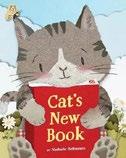
An orderly yet solitary reading experience pales in comparison to the joy of sharing literature. Cat couldn’t be happier. Our protagonist has a brand-new book and is absolutely reveling in the newness of this acquisition. “I love hugging its clean cover and stroking its smooth pages. It smells so good.” Plans to keep this book new “forever” are almost immediately upended, however, when Mole asks to read it. Cat reluctantly acquiesces but immediately regrets the decision when the book comes back wrinkled and sandy. Even so, Cat can’t seem to say no when Frog and Tortoise also ask to see it. While mourning the newness of the book, Cat reads it aloud to Squirrel and begins to see that sharing can be even more enticing than hoarding. The triumphant ending features both Cat and Squirrel reading the book aloud to a host of other creatures. Clean opening pages contrast nicely with the book’s mucked-up but amusing closing pages.
The cut paper and collaged art often cleverly blurs the lines between Cat’s book and the reader’s while including delightful details (like Tortoise’s flower cap or Squirrel’s bindle). In the end, the message to eschew purity in favor of community comes through loud and clear.
A gentle reminder that to give is better than to receive—but reading aloud is the most fun of all! (Picture book. 3-6)
Biddulph, Rob | Macmillan Children’s Books (384 pp.) | $8.99 paper | November 11, 2025 9781529040616 | Series: Peanut Jones, 3
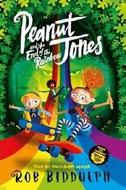
A plucky hero, her best friend, and her family face off against a fearsome foe. In this trilogy closer, precocious Peanut, older brother Leo, younger sister Little-Bit, and best friend Rockwell Riley find themselves up against the conniving Mr. White for the last time. Mr. White is the mayor of Chroma, the Illustrated City, and he’s determined to rid it of its color and creativity. The Jones children and their parents devise a plan, but they soon learn that there’s a mole within their ranks: Will they be able to stop Mr. White before Chroma is robbed of its vibrant inspiration? Biddulph’s latest Peanut Jones story is sprightly and busy, mixing lively pacing with facts about art. Although the plot zips along, the repetitive recaps interspersed throughout may prove frustrating to some readers. Ample illustrations— including some two-page spreads—in an appealing cartoonlike style appear throughout, but strangely the text at times describes the illustrations in a way that’s at odds with the somber brown, gray, and black palette: “Teal, indigo, magenta, violet. Crimson, lavender, maroon, butterscotch.” While this is Peanut’s adventure, she’s ultimately passed over in favor of a
boy’s ascendence. A spinoff for Little-Bit is hinted at: Perhaps she’ll be the strong female lead readers deserve. A glossary defines pertinent artists, artistic terms, and movements. The Joneses and Mr. White present white, and Rockwell appears to be Black. Disappointing. (Fantasy. 8-12)
Britt, Chris | Holiday House (40 pp.) | $14.99
January 13, 2026 | 9780823459490
Series: I Like To Read Comics
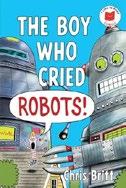
A humorous contemporary twist on the old story of the boy who cried “Wolf!”
On nearly every page of this tale, light-skinned, orange-haired Sam’s rather cavernous mouth gapes open as he laughs loudly at his own lies. His falsehoods start small but rapidly intensify—from his declaration to readers that his bike is yellow (it’s in fact blue) to his claim that a big hairy monster ate his homework to his excuse for not bathing (the tub has been invaded by gators). Sam’s fed-up classmates start avoiding him, and he decides to tell a whopper of a lie so he can stay home from school: “Evil space ROBOTS with fire-shooting eyeballs…are attacking my house!” The very funny result is much lighter—and goofier—than that of Aesop’s traditional fable, but the moral remains. Part of a series intended to “instill confidence and the joy of reading in new readers,” this graphic novel features speech bubbles and bright, funny, frenzied-looking art, giving youngsters plenty of visual help in making sense of the text. The sentences and phrases are short, with random vocabulary words poised to enter a new reader’s collection of sight words. At one point, when Sam’s classmates are rightly annoyed at his fibs, one of them uses the ableist word lame. A witty and entertaining cautionary tale. (Graphic early reader. 5-8)
Cardozo, Nat | Trans. by Ian Farnes & Layla Benitez-James | Red Comet Press (64 pp.) $25.99 | September 9, 2025 | 9781636551555
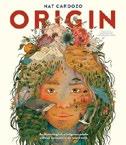
Introducing Indigenous children from around the globe.
The two-page spreads in this work translated from Spanish feature profiles of several paragraphs in the voices of Indigenous children who address an implicitly non-Native reader, alongside beautiful full-page color portraits with natural elements of their homelands superimposed across their faces. Author and illustrator Cardozo, the French-born daughter of Uruguayan refugees, includes 22 societies, such as the Orang Rimba of present-day Indonesia, the Cherokee of the present-day southeastern U.S., and the Tz’utujil of present-day Guatemala. The profiles name each of the peoples’ current territory, population, and spoken language. The backmatter touches on the impact of the forces of consumerism and imperialism and will require adult support for additional context and clarification. Although the author’s note indicates a desire to uplift those “whose ancestral wisdom has so much to teach us” and to help readers understand that “WE ARE ALL ONE,” the profiles too often flatten the Indigenous subjects through the use of romanticized language that evokes stereotypes (“I wonder if all Tuareg women, strong and wise, are descended from her”). The absence of details that would make the subjects
feel more like real, everyday children will likely undermine a genuine connection with young readers. Due to the text’s brevity, some information about the cultures is highly generalized. A QR code links to the book’s sources, predominantly materials by non-Indigenous peoples, including a source whose experiences in Africa came about through missionary work. A well-intentioned project that falls short of the illumination it promises. (Nonfiction. 9-12)
Chi, Kim & Stephan Lee | Illus. by Utomaru Walker US/Candlewick (192 pp.) | $17.99
September 30, 2025 | 9781536236705

When the town’s library faces demolition, who will save the day? None other than Donutella Hamachi!
Donutella is a sweets-and-makeup-inspired drag superhero of a comic book created by 12-year-old Korean immigrant Jae Han Kim. At school, Jae Han’s bullied by a group of jocks. At home, Jae Han’s parents dismiss his passion for drawing while heaping praise on his athletic older brother. But the tween has a diverse, close-knit group of friends, fellow misfits who take refuge at the library and hone their creative talents. When the mayor announces that the library will be razed to make room for a shopping mall, Jae Han deputizes his friends as the Library Avengers to save the day. While the storyline is fueled by power-hungry businessmen, unfair
Filled with sparkle, a tale of youngsters rallying to do what’s right.
DONUTELLA HAMACHI AND THE LIBRARY AVENGERS
Subtle but with an understated depth, much like its titular tiny worlds.
TINY WORLDS
parental expectations, and corrupt politicians, the creative kids—and their vivid imaginations—keep the pace light and lively. The pages of girl-inspired comics of Donutella are hilarious and help Jae Han process each serious situation with outrageous solutions. Co-authors Chi—star of RuPaul’s Drag Race —and Lee sensitively explore themes of identity (in particular, Jae Han’s love of fashion and beauty, which his parents don’t understand) while celebrating a loving community as it speaks truth to power.
Filled with sparkle and creativity, a tale of youngsters rallying to do what’s right. (Fiction. 8-12)
Choi, Sook-Hee | Trans. by Jieun Kiaer & Sarah Kiaer | Charlesbridge (32 pp.) | $16.99 September 9, 2025 | 9781623545642
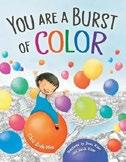
In this South Korean import, a child experiences a day full of big emotions, each represented by a color.
“Feelings are as colorful as a rainbow and change all the time.” An East Asian–presenting little one narrates the events of a day, from waking up (“The morning is dazzling white”) to going to bed (“Mysterious black looks forward to whatever tomorrow will bring”). The protagonist begins the morning “excited as bright yellow” and “curious as deep green.” Later, a new friend makes the youngster feel “tickled pink,” but when that friend plays with someone else, the child cycles through a “ruby red blaze,” “gloomy blue,” and “down-in-the-dumps gray.”
The two or three sentences of poetic text on each page tell the story while also describing various feelings; at times, the writing is a bit awkward (perhaps due to translation issues), but no matter—Choi’s illustrations are the star of this book. The colors pop off the pages, perfectly rendering each emotion with a combination of realistic detail and surreal elements. A scene where the young narrator sings the praises of “optimistic orange” depicts a group of balloons floating above a beautifully detailed grayscale city, with the child riding astride the largest balloon, while a fiery red page features the child, eyes narrowed in anger, along with a gorgeous dragonlike creature composed of delicate flames and feathers fanned out in the background. Arresting illustrations have a dramatic impact in this meditation on emotions. (Picture book. 3-7)
Cicchese, Brittany | Candlewick (32 pp.)
$18.99 | January 13, 2026 | 9781536236521
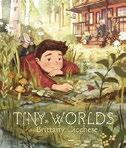
An introspective child sees beauty and wonder in the smallest of objects. While staying at Grandma’s house, the young narrator crafts the intricate and aptly named Tiny Town, complete with a road made of ribbon, a Popsicle stick bridge, and a pie tin for the park. The child is content, but Grandma proposes they go to the park (“It might be nice to play with some kids for a change”). The park is noisy and overwhelming, but the youngster
finds a quiet space and muses about how to incorporate found objects into Tiny Town. Undeterred, Grandma tries bringing the child to a petting zoo, the woods, and the beach. In each setting, the protagonist finds tiny items more appealing, and eventually, Grandma is drawn into the child’s imaginative world. The earth-toned digital illustrations evoke chalk drawings and oil pastels, giving this gentle, understated story an appropriately soft aesthetic. Children who enjoy fairy gardens or other creative pursuits involving miniatures will find a gratifying mirror here. In addition to celebrating introverts, this book is particularly welcome as an intergenerational story that proves that older adults can and should take the time to learn from younger people. The child has pale skin and short brown hair, and Grandma has pale skin and a white topknot.
Subtle but with an understated depth, much like its titular tiny worlds. (Picture book. 3-7)
Crosby-Fairall, Marjorie | Red Comet Press (44 pp.) | $24.99 | September 30, 2025 9781636551395
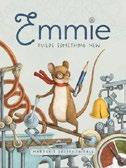
A scrappy rodent learns that logic can solve engineering dilemmas and social misunderstandings alike. In a colorful Victorian dollhouse lives Emmie, a soft brown mouse. Her home is surrounded by pulleys and contraptions, bits and bobs, and even a sunflower, all of which allow her to eke out a tranquil, though solitary, existence in the attic, unbeknownst to the house’s human owners. An engineer at heart, Emmie approaches every problem with a solution-focused mindset and creates designs to make her trouble disappear. But her peaceful life is thrown into chaos when the homeowners adopt a
fluffy black-and-white cat, who soon trots up to the attic. Though Emmie appears afraid, she bravely launches into problem-solving mode, sketching out designs for progressively larger and less feline-friendly robotic creatures to scare off the kitty. When the last creature gets the job done by dousing the poor cat in water, Emmie is briefly satisfied—until she realizes how frightened and sad she made her supposed enemy. The story resolves with Emmie apologizing before making amends. This strong messaging is reinforced through the illustrations, which introduce color gradually, beginning with Emmie and her home in the opening spread and ballooning to the entire attic space as Emmie’s world opens up to welcome her new friend, the cat. On the whole, it’s a welcome reminder that it’s just as important to be kind as it is to be smart.
A sweet social-emotional book that’s the cat’s (and the mouse’s) pajamas. (Picture book. 3-6)
Davey, Sharon | Penguin Workshop (32 pp.)
$18.99 | January 13, 2026 | 9780593887011

What’s a pampered pup to do when a new baby arrives?
Dorothy, a blue-spotted dog, loves her two dads. They do everything together, including taking “long walks” and throwing “splendid dinner parties,” until one day, the arrival of a “noisy, floppy, screechy, smelly baby” turns everything upside down. The new addition upends their routines, drawing attention away from Dorothy. Seeing her dads stressed and overwhelmed, Dorothy tries to help but only causes more chaos. When the baby gets a persistent case of hiccups and her dads are at their wits’ end, Dorothy’s unique brand of assistance helps her and the baby to bond. This variation on the new-sibling theme is a loving look at the growing pains of sudden changes in family dynamics that features a family with two fathers. Davey’s monoprint, gouache, pencil, and digitally collaged
art exudes energy, with the family’s expressive looks set against alternating warm blue and green tones and stark white backgrounds with rainbow pops throughout. The last spread features a vibrant Pride parade. The third-person narration from Dorothy’s point of view will make this story relatable to young readers in similar situations. The child and one adult are pink-skinned, while the other dad has tan skin and curly hair. A supportive look at the feelings and realities inherent to a new family addition. (Picture book. 3-7)
Daywalt, Drew | Illus. by Oliver Jeffers Philomel (32 pp.) | $9.99 | January 13, 2026 9780593694879 | Series: The Crayons Celebrate
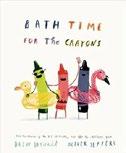
The Crayon crew, having happily starred in more than two dozen books, now cleans up. As the Crayons grab inner tubes and rubber duckies and prepare for bathtime, Daywalt keeps the laughs coming. Adult readers will be tickled by the many grown-up references: Prince’s “Purple Rain” and Gene Kelly’s “Singin’ in the Rain,” Herman Melville’s Moby-Dick, Sandro Botticelli’s The Birth of Venus. But there’s plenty for younger readers: Esteban (“Pea Green” is crossed out and corrected on his label) wears a cape and snorkel as he perches on a bathtub faucet (later, he’ll sport the cape while playing pirate with Neon Red); a big Green shields the eyes of a small Green who is excitedly pointing to the spectacle of a naked (i.e., label-less) pale tan crayon; alongside Mermaid Purple, Starfish Orange, and Sea Turtle Green, a chunky My First Crayon offers an uplifting bit of wisdom about kindness. Some Crayons see bathtime as an opportunity to party, while others prefer to shower, but “they all have a splash”— interestingly, while wearing their labels. Jeffers again contributes his reliably droll crayon sketches,
minimalist but with pleasing extras like a purple octopus popping up among the bathers.
Good clean fun for fans of this longrunning franchise. (Picture book. 4-8)
Diño, Yxavel Magno | Bloomsbury (288 pp.) $17.99 | November 11, 2025 | 9781547615162
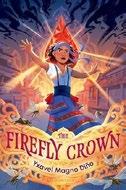
In this Philippinesinspired fantasy, a young sorcerer must find her magic and risk her life to save the empire from dark magic. In a world populated by mambabarang—sorcerers with the ability to communicate with and control insects—12-year-old Yumi is a lowly Cricket who can’t wield her powers. Yumi longs to be in the capital city of Tinanglawan, where the revered Fireflies, who can manipulate light, live. When the rajah, the husband of the ailing empress, calls all mambabarang to Tinanglawan for the Crowning of First Daughter Eyrin, Yumi jumps at the chance to leave the countryside. En route, her party is attacked by the Ghost Swarm, a horrific, destructive cloud comprising “the ghosts of all the insects that had ever lived,” which was created by dark magic when the magicless, bitter over their unfair treatment, sacrificed mambabarang. On the day of the coronation, the Firefly Crown— the only thing that can defeat the Ghost Swarm—is stolen, and Yumi is falsely accused. In the rajah’s dungeon, she makes new insect and human friends and must summon her courage and minimal magic skills to find the real thief and fight the Ghost Swarm. Infused with Filipino folklore, this fantasy is full of action and adventure. The empire’s robust worldbuilding includes distinct social classes based on types of magic; Yumi’s low status makes her an object of prejudice, and she struggles with finding respect and belonging. A page-turner set in an intriguing world. (Fantasy. 8-12)
THE GREEN MAOWUSU
Green Maowusu
Duan, Xuefei | Clavis (40 pp.) | $20.95 November 11, 2025 | 9798890632241

A remarkably tenacious girl inspires and incites her fellow villagers to turn their desert home into a fertile oasis. Baori lives in a tent village in northwestern China’s Maowusu Desert (the word means “bad water” in Mongolian). Difficult conditions— sandstorms, extreme temperatures, drought—force the other villagers to move as “the dry desert grows bigger and bigger, and the green meadows get smaller and smaller.” Long ago, the elders tell Baori, their land had been beautiful, “but because of the war and forests being cut down, the land got dry. Many people fled.” Baori intends to stay and “make the desert smaller and the green land bigger.” Sadly, the seedlings she plants blow away, sheep eat up the young plants, and sandstorms subsume new trees. But a single tree still standing offers enough hope to keep trying, especially when “everyone helps.” Baori and her community continue their efforts through the years: “Baori grows older and older, while the desert…gets younger and younger and greener and greener.” Golds, browns, and verdant greens dominate Duan’s palette, with spreads that bleed beyond the edges, mirroring the desert’s vastness; characters are garbed in traditional Mongolian flowing dress and headwear. Originally published in Belgium and the Netherlands and translated from Dutch, this is a radiant glimpse at environmental history—Maowusu is real, its transformation successfully
ongoing—into a heartwarming, heroic tale of unwavering persistence. One girl, one tree, one village changed their world. A powerful lesson in the rewards of nurturing nature together. (Picture book. 5-9)
Edge, Clare | Harper/HarperCollins (384 pp.)
$19.99 | November 11, 2025 | 9781335013866
Series: Accidental Demons, 2
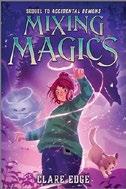
It’s been a few weeks since Bernadette Crowley’s Grandma Orla and friend Finley, a Mystery demon, vanished into the demon dimension. She’s left with only a cryptic prophecy from Fin and little hope of solving it. The other members of the Irish American Crowley family seem to have moved on from Grandma Orla’s disappearance. When a frustrated Ber takes the rescue into her own hands, she summons a stranger from her grandmother’s past and begins to learn about the true, complicated history of blood witch culture. The series opener, Accidental Demons (2024), established a lot of the worldbuilding around the magic system and the role of Ber’s diabetes; this entry focuses more on her home life. Ber’s relationship with gendernonconforming new boyfriend Cai, whose mind-reading abilities are growing more potent, puts a magically heightened spin on the awkwardness of young teens’ relationships. Though she’s still adjusting to her new insulin pump, Ber has made strides in
accepting herself as “a diabetic,” and her impulsive, strong-willed personality shines through. While the magical system is convoluted in places, the plot moves at a brisk pace. Ber uncovers family secrets, including one that brings about a satisfying twist; the exploration of the Crowleys’ history is the novel’s highlight. The earlier book established that Cai is of Japanese and implied-white descent.
A strong, brisk duology closer.
(Fantasy. 8-12)
Fagan, Kirbi | Millbrook/Lerner (32 pp.)
$19.99 | October 7, 2025 | 9798765627242
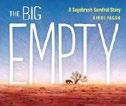
In a near-empty land, sagebrush survives. Sagebrush, home and food for wild creatures in the “nowhere land” of the American West, describes its world. As an RV passing through leaves dust in its wake, Fagan’s poetic first-person narrative carries readers through a slim story that documents the food and shelter sagebrush provides for desert-dwelling animals, as well as a devastating fire and subsequent recovery. “I am hope,” the sagebrush asserts, sending down long roots and “bloom[ing] bursts of yellow.” “I am life.” Fagan’s striking artwork is just as integral as her meditative text. The author/illustrator, who honed her equine-drawing skills with Rosanne Parry’s novel A Horse Named Sky (2023), includes wild horses on several pages. Readers will also spot pronghorns, greater sage-grouse, pygmy rabbits, and sage thrashers (identified and expounded upon in the backmatter). The two-level text— consisting of words in a smaller font and brief statements in a larger, seemingly handwritten font—takes up little space on these spreads, which reflect the vastness of the landscape. The images have the look of pastels, done mostly in shades of brown, culminating in a striking fire that
leaves the land gray and barren before the hardy plant returns. The words read aloud smoothly, and the images will show well, making Kirby’s auspicious authorial debut a good choice for small-group sharing. A dramatic depiction of an unusual ecosystem. (more about sagebrush) (Informational picture book. 5-9)
Finison, Carrie | Illus. by Brianne Farley Putnam (40 pp.) | $18.99 | January 27, 2026 9780593700174
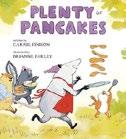
Good intentions prove little match for voracious ursine bellies. Topsy the opossum has a bold plan for her bear friend LouAnn. Since LouAnn has been hibernating all winter, the very start of spring is the perfect time for a massive pancake-based breakfast. Rhyming verse sets an upbeat tone as Topsy produces five delicious pancakes… which are immediately and mysteriously purloined when Topsy’s back is turned. Unfazed, Topsy makes a second batch, which also disappears. When a third and fourth batch meet the same fate, Topsy is utterly bereft. Fortunately, friends are nearby to lend a hand. By the time LouAnn awakens, there are plentiful pancakes on hand… and two stuffed cubs with suspiciously pancake-y faces by her side. LouAnn is the new mother of two very hungry little ones! In the end, everyone benefits, scarfing pancakes galore. As with this tale’s predecessor, the goodnatured Dozens of Doughnuts (2020), the fun lies in both the mischief and the food. The gentle rhyming text scans without flaw, while Farley’s delightful art brings to life not simply an evocative view of early spring, but also the fun and whimsy of a put-upon opossum. No good deed goes unpunished (and no good pancake goes uneaten) in this charming new take on post-hibernation. (Picture book. 3-6)
Finley, Allison | Orca (112 pp.) | $10.95 paper August 19, 2025 | 9781459840867
Series: Orca Currents
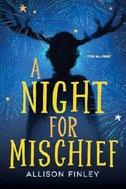
A disappointed fan of Halloween ends up with more excitement than anticipated. For 13-year-old Syd, Halloween has always been the best night of the year. After working for months on her costume, she’s beyond excited for the day to finally arrive, but when some older kids tease her, she gets rid of the costume and decides not to celebrate at all. Her friend Jake comes by her family’s pawn and antique shop looking for some costume help and discovers an old mask that he immediately dons. The movie night Syd has planned turns into something very different indeed, as strange things begin to happen in Jake’s orbit, like skeletons and giant plastic spiders coming to life, not to mention costumes becoming all too real. As people begin to turn into actual werewolves, pirates, and an alligator, Syd discovers that Jake has been possessed by a spirit called Mischief. Syd may be everyone’s only hope. This quick and well-balanced tale is a great choice for striving middlegrade readers and all those looking for a brief bit of scary fun. The pages are kept turning by just enough character development and setting to be engaging, alongside plenty of action. Theo has brown skin; other appearances are vague. A high-interest chiller with broad appeal. (Paranormal. 10-14)
Do I Love You? Yes I Do!
Forman, Ruth | Illus. by Raissa Figueroa
Little Simon/Simon & Schuster (40 pp.)
$19.99 | January 6, 2026 | 9781665939409
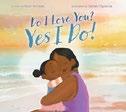
From sunrise to sunset, a Black mother and child spend a magical day together.
A child with two black buns, whom readers may recognize from Forman and Figueroa’s Like So (2024), is thrilled to greet the day. Accompanied by Mama, the young narrator frolics through lush grass, dances a butterfly ballet, and wades in the sea; at last, the two cuddle together by the shore. Magic and movement are all around, and the child’s body language reinforces the confidence, security, and pride that the little one feels. On one spread, mother and child recline on a blanket outside, surrounded by sparkly swirls (“I’m made of the same stuff as stars…the ancestors got together and each threw in their best dreams”); on the next, they’re brought back to reality. “I belong to this world now,” a world packed with affirming goodness. Forman’s poetic text has an irresistible rhythm that blends delightfully with Figueroa’s immersive illustrations. Rich tones of “pink and orange, peach and blue” and changing perspectives throughout make Mother Nature feel like another character in the story, inviting readers to draw connections to their own sensory experiences in nature. Whether adults read this one aloud with preschoolers or share it with a snuggler on their lap, little hearts will swell each time they chirp along to the refrain: “Do I love you? Yes I do!”
A vibrant, immersive celebration of infinite love that’s sure to fill young readers with joy. (Picture book. 2-6)
No good deed goes unpunished in this charming take on post-hibernation. PLENTY OF PANCAKES
Frenette, Lisa | Illus. by August Swinson
Owlkids Books (32 pp.) | $19.95
September 16, 2025 | 9781771476287
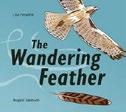
A feather from a red-tailed hawk has a long journey with many stops until it lands in just the right hands.
A diving hawk on the hunt for a mouse loses one of its beautiful feathers. When it lands on the ground, a squirrel snatches it up and uses it in her nest. The wind shakes it free, sending it high above the treetops until it lands in a woman’s hat. And so it goes, flying and floating until a girl spots the feather during her beach walk. She takes it home and uses it as a part of her handmade dream catcher, just the right permanent home for the wandering feather. An author’s note describes the cultural significance of the dream catcher to Ojibwe and other Indigenous cultures. Thanks to the feather’s constant relocation, the story bounces along with it from place to place, keeping the pace moving and readers curious. The illustrations nicely capture the feather’s sense of motion, from swirls as it falls to a tremble as it blows. The images are outlined in thick, black lines and make use of different layouts to great effect. The girl is drawn with light tan skin and long black hair in a single braid. The ending is lovely and unexpected; the feather’s final resting place is one of reverence and peace.
A meaningful introduction to an Indigenous object with captivating, movement-filled illustrations. (Picture book. 4-8)
Ganz-Schmitt, Sue | Illus. by Luke Flowers
Two Lions (32 pp.) | $18.99
October 14, 2025 | 9781662519673
Series: That Monster on the Block

A good party should be fun for everyone. Monster and Clown return in this sophomore story that follows That Monster on the Block (2020).
Monster, a tall, green-skinned behemoth reminiscent of Dr. Frankenstein’s creation, is delighted that autumn has arrived, because that means it’s almost time for Yeti’s annual block party. Clown, a short jester with puffy red hair and a bluish-white painted face, is new in town and is eager to attend his first of Yeti’s soirees…until the duo learn that the hairy hostess broke her leg playing ice hockey. The pair initially plan to throw a joint party in her stead, but tensions arise when they disagree over the theme (Monster wants something scary, while Clown prefers a funny soiree); ultimately, they decide to throw two competing parties. Stormy weather ends both their parties but leads to a reconciliation, and they decide to collaborate on an annual spring party next year. Like its predecessor, this fast-paced story may leave readers reeling, but those who like not-so-scary hijinks will enjoy it. Flowers’ digital illustrations are as overloaded as the text, which may be overwhelming for some and a visual treat for others. Although a sequel, the tale stands alone, so readers unfamiliar with the first book won’t miss out on the festivities.
Kooky and bold fun. (Picture book. 5-8)
Oozing in kid appeal, a tale youngsters are sure to regularly revisit.
Gauthier, Manon | Trans. by Michel Savard
Running the Goat (32 pp.) | $19.99
January 13, 2026 | 9781998802296
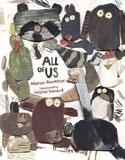
A variety of animals— familiar and unknown— pose in their native habitats. What every one of Gauthier’s winsome, humorous collage illustrations has in common are the eyes; the cream-colored, circular cutouts with dark pupils suggest attentiveness as the creatures gaze at readers (except for the bats, who are sleeping). Translated from French, most of the text is one long sentence, starting with the words “I am the koala who curls up into a ball when he’s cold, the snow leopard who leaps down steep hills.” As the pages turn, Gauthier provides more names and brief descriptions. The bharal (an Asian sheep) perches on a mountain peak; it “has no fear of heights.” The penguin is “a bird who does not fly.” Following the penultimate page (“the child who loves being told a story”), which depicts a diverse group of youngsters, Gauthier spotlights something that all living things share: the cell. Highly textured, painted, and mixed-media backgrounds foreground the paper and cardboard creatures that hail from around the world. The palette comprises the muted blues, greens, and browns of the natural world. The art practically begs children to reach for their scissors, and the book concludes with the loaf-shaped pattern that Gauthier used to depict each subject’s oversize head, as well as an invitation to invent.
Oozing in kid appeal, a tale youngsters are sure to regularly revisit. (Picture book. 3-6)

Gehl, Laura | Illus. by Alexandra Colombo
Apples & Honey Press (32 pp.) | $19.95
October 21, 2025 | 9781681156859
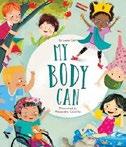
A diverse group of children celebrate the amazing things their bodies can do. Seven kids use their bodies in various ways, from riding a bike to eating a cake. The group includes one child in a wheelchair, one with a cochlear implant, and one without visible hair, all with a range of skin tones and gender presentations. Some characters wear kippot. The book begins by introducing each of the children by name with their favorite activities, helping to bring each character’s personality to life. The text is a simple rhyming refrain: the phrase “my body can…” followed by an activity. The singsong rhythm and repetition are toe-tappingly fun, encouraging readers to engage in the kind of exuberant movement the book portrays. Bright, clean illustrations show children beaming with joy and pride in their abilities, whether they’re boldly prancing or quietly healing from an injury. Each of the children participate in their own way; for example, a spread with the words “my body can hike” shows two children on a trail, one walking and one using a wheelchair. While the activities are things any child might do, like spinning, laughing, or sewing, many are illustrated in the context of Jewish holiday traditions. For example, a page with the words “my body can build” depicts children building a sukkah. A concluding author’s note encourages kids to identify some of the Jewish holidays and symbols and provides suggestions for related movement-based play.
Readers won’t be able to keep their own bodies still as they join in this joyfully intersectional romp. (Picture book. 3-7)
Goldfield, Anna | Illus. by Paula Zamudio Neon Squid/Macmillan (64 pp.) | $19.99 September 30, 2025 | 9781684494538
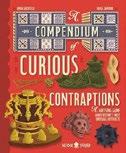
More than two dozen puzzling artifacts from the past await readers’ detective skills. Introductory pages explain just what archeology and anthropology can tell us about the lives of other cultures, and how objects speak of their makers and users. Clear, colorful, close-up illustrations of each object accompany tantalizing but clearly written clues about it, perhaps focusing on a detail, some information about the artifact’s use, or the materials it was made of. A “Fact File” box adds further information. Some medical inventions, however helpful, are deeply scary, while others, like the stethoscope, are still used in refined versions. Weapons are another frightening group. Objects from around the world and across centuries include Inuit snow goggles, gameboards from Ur, an earthquake detector from China, a Roman lamp, Tipu Sultan’s mechanical tiger, a leech barometer, an elaborate Turkish water clock, an Aztec “death whistle,” Moses Quinby’s 19th-century smoke dispenser for beekeepers, Viking chess pieces, and more. At least one object, the Roman dodecahedron, has not yet disclosed its purpose; readers are invited to speculate. The selection of items is excellent, and the information
about them expansive. We’re never too old for guessing games or lift-the-flap books, and here we also enter vividly into the realm of global cultures. An absorbing trip through an eclectic, fascinating museum of mostly ancient inventions. (glossary, index) (Informational picture book. 8-10)
Kirkus Star
Gutta, Razeena Omar | Illus. by Bassent Dawoud | Barefoot Books (32 pp.) | $17.99 January 6, 2026 | 9798888592366

Wanting to find a way to do good during Hajj, a young Muslim child shares water with fellow pilgrims from all over the world.
Mariam, Mama, and Dad are among the millions embarking on Hajj, the once-in-a-lifetime pilgrimage to Makkah (Mecca). Mama says, “Hajj is a time to do good, share, and be thankful.” Brainstorming ways to do good, Mariam thinks of the perfect idea: sharing Zamzam—water from an ancient, blessed well of the same name—with others. With each cup of water Mariam distributes, the young protagonist learns ways to express thanks in different languages and samples delicious foods like syrupy koeksisters from South Africa and Indonesian pandan cookies shared in return, each as unique as the pilgrims Mariam meets. But will Mariam have enough Zamzam for everyone? Gutta explores a potentially lesser-known pillar of Islam with text that both educates and entertains. Dawoud’s digital collage illustrations perfectly capture the essence of Hajj—the crowds, the awe-inspiring rituals, and the camaraderie that comes from sharing such an important spiritual event—all while portraying the cultural diversity of its attendees in a broad range of skin tones and physical abilities. Mariam is brown-skinned, though the child’s ethnic identity isn’t mentioned. The backmatter reinforces learning with
The Newbery Medalist launches a new mystery series that invites readers to do some sleuthing of their own.
BY SANDIE ANGULO CHEN

TWO-TIME NEWBERY MEDALIST Erin Entrada Kelly ventures into new territory with The Last Resort , the first in a cross-platform mystery series that combines traditional storytelling with interactive technology. The novel follows 11-year-old Lila as she encounters ghosts at her late grandfather’s Victorian inn, where she, her brother, and their new neighbor team up to solve the mystery of her grandfather’s death. QR codes embedded throughout the book, which is illustrated by Naomi Franquiz, let interested readers help resolve ghosts’ unfinished business. A second book in the series, written by Jasmine Warga, is due out in January.
On a Zoom call from a writing retreat in the Pocono Mountains of Pennsylvania, Kelly spoke about her lifelong love of thrillers, the importance of addressing family grief in middle-grade books, and the novelty of writing an extroverted protagonist. Our conversation has been edited for length and clarity.

good examples of that, because their books are so rich and textured. The anticipation is there on the page—just all the elements you want in a good spooky story.
The Last Resort is a new series starter. What makes it unique?
readers who don’t care about the gameplay element and just want to read the book.
I really appreciate that the siblings in the book are collaborative instead of adversarial. Why did you include the little brother, Caleb, in Lila’s mysterysolving gang?
What’s your favorite mystery or thriller?
Lately, I’ve really been into anthologies, especially thriller/horror anthologies. One of them is The Black Girl Survives in This One. I like We Only Come Out at Night, and I also love Our Shadows Have Claws. I definitely lean more toward thrillers and horror. More in the same space as me, I do love Mary Downing Hahn’s Wait Till Helen Comes and [books by] Lois Duncan.
What drew you to their books?
It’s the writing and the storytelling. One of the things I find most interesting about mysteries and thrillers is you are writing toward an audience that reads a lot of this genre, and a lot has been done in this genre many times. Like, how many haunted house stories are there, right? So I love the challenge: How can I embrace the tropes of thrillers and mysteries, but also make something original that will hook readers? Mary Downing Hahn and Lois Duncan are
When readers encounter a ghost on the page, they have the option to scan a QR code, and the ghost will rise from the pages of the book. Readers have to help the ghosts figure out how they died and also what they need to cross over. There’s a mystery, a puzzle-solving element for readers who enjoy that, but you don’t have to if it’s not your thing. One of the fun challenges of writing this book was introducing ghosts that readers might be interested in interacting with and solving their deaths, while also honoring the
There are a lot of only children in middle grade— and I’ve written only children, too—because once you introduce a sibling, that changes the dynamic of the house, and it just changes everything. But most kids have siblings, so Caleb is there to fulfill that role of the annoying little brother. But I also wanted this to be a story about family coming together. I tell my students in MFA programs that your secondary characters’ main function is to provide dimension for the main
character. Caleb does that for Lila.
The book is about ghosts and a haunted house, but also about grief, loneliness, and insecurity. Why is it important to expose middle-grade readers to these topics?
The first, obvious answer is that children experience those things, so books like this can help them work through it. But the less obvious answer is, for young people who have not
experienced those things, books allow readers to live in an uncomfortable place where they might be sad or they might be scared or they might be lonely, but it’s a safe space, so they don’t have to actually have a parent die. They can experience, empathize, and understand what it’s like without having to actually experience it. When they do experience grief and loss, they’ll have some context for it. What better space to experience
How can I embrace the tropes of thrillers and mysteries, but also make something original?
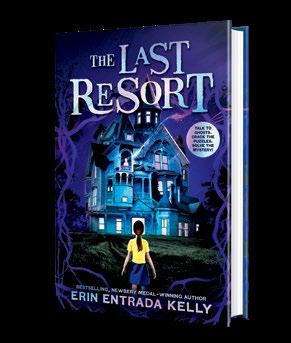
The Last Resort Kelly, Erin Entrada Illus. by Naomi Franquiz
| 240 pp. | $17.99 September 2, 2025 | 978154613231
uncomfortable emotions than in the pages of a book, where it’s safe? That’s why people love horror and thriller books and movies in the first place. Being afraid is, in a weird way, an energizing emotion that makes you feel alive. But I’m actually not running from a serial killer. I can leave the theater and go home. But I get to experience all the emotions of living.
Mystery novels often invite rereading. What do you hope readers notice while rereading The Last Resort ? One thing that’s so fun about reading books like this is that, once you’ve read the book and know how it ends, when you reread it, you can see how the narrative is leading you to that ending. It’s especially true for books like this, where there’s something to be solved, and then when you go back, you have the benefit of knowing what’s going on, and then you can see how the author manipulated—for lack of a better word—the storytelling to make that happen. The sentence that you read in a certain way the first time around all of a sudden reads very differently when you read it the second time, with the benefit of knowing the ending—which is really cool.
What’s the difference between a good mystery/ thriller for an adult versus one for a middle-grade reader?
I don’t think there is a difference. I think that the structure is the same. You still need great characters. You still need a great
storyline. I would say the only difference is content. Obviously, you want the content to be suitable for a younger reader, but other than that, the scaffolding is all the same. It’s all about characters that readers care about and want to root for, or, if they don’t care about them, they’re intrigued by them, and [they have] an intriguing story. Mysteries and thrillers for young people and adults also have the same tension, conflict, suspense. All the ingredients are the same.
I loved Lila, and I also really felt like she was universal. Why did you choose to make Lila a girl who’s often told she’s “too much”?
A lot of my previous books deal with the inverse, where [the characters] are quiet and kind of meek and trying to find their voice. I thought, You know what? I want to do the total opposite. I want to do a character who does take up space. But guess what? That’s not right, either, because when you’re young, and especially when you’re a girl, everything you do seems to be not the right way to do it, and everyone else seems like they’re doing it well. But no one knows what they’re doing! So I wanted to celebrate a girl who takes up space and who learns that she can take up space. Even if you weren’t the dramatic overreacting kid, we all know what it’s like to feel like we’re not doing it right, especially at that age. That feeling is universal across ages and personality types.
Sandie Angulo Chen is a writer and bookseller in Silver Spring, Maryland.
The singer and actor’s Songbird in the Light will be published by Abrams.
Billy Porter will make his children’s literature debut next year, People magazine reports.

Abrams will publish the actor and singer’s Songbird in the Light, co-written with Chris Clarkson and illustrated by Charly Palmer, in the spring. It calls the book “a beautiful and empowering story about learning to love yourself.”
Porter first rose to fame originating the role of Lola in the Broadway show Kinky Boots, for which he won the Tony Award for best actor in a musical. He’s also known for playing emcee Prayerful “Pray” Tell in the FX series Pose; he
won an Emmy Award for his work on that show.
He is the author of a memoir, Unprotected, published in 2021 by Abrams. A critic for Kirkus wrote of the book, “Overcoming racism, homophobia, bullying, and abuse, a theatrical star is born.”
Songbird in the Light tells the story of a young boy who is bullied at school for his voice and mannerisms but performs in the school’s showcase at the urging of his choir teacher.
Porter told People that the book was inspired by his own experiences at school.

For a review of Billy Porter’s memoir, visit Kirkus online.
“I was bullied mercilessly from, like, the first to the fifth grade,” he said. “I created this book for my younger self, to be the thing that I did not actually have.”
Songbird in the Light is slated for publication on March 17, 2026.—M.S.

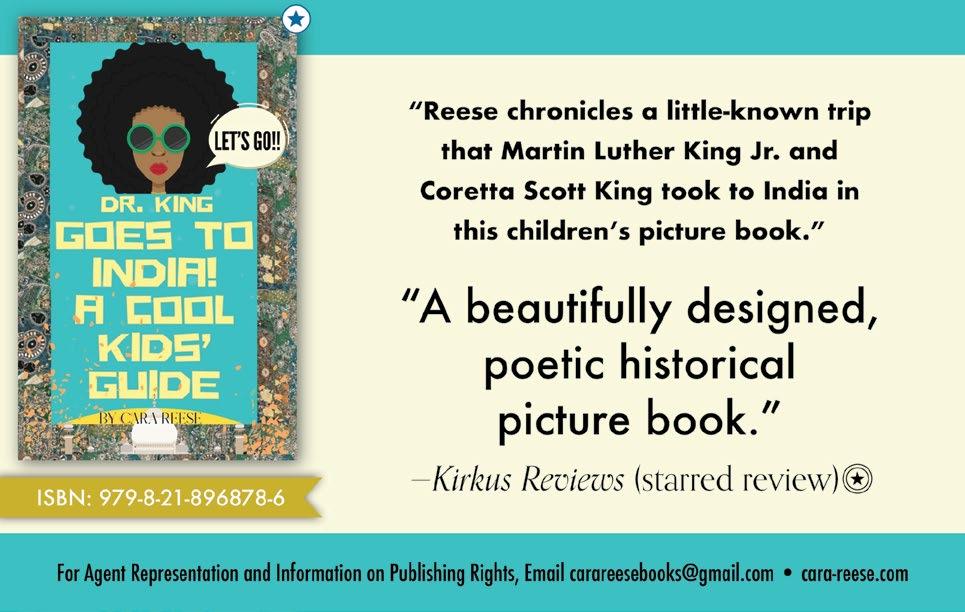

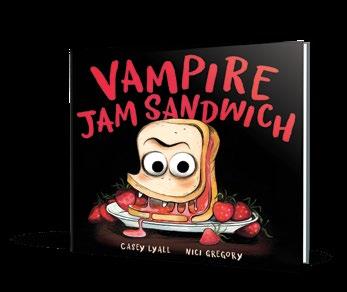
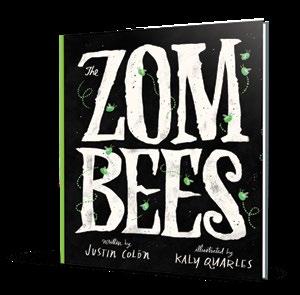
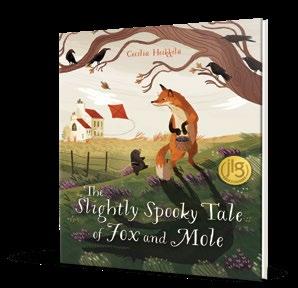
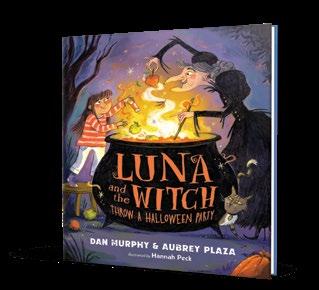
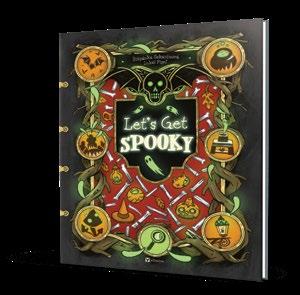

the story of the Zamzam Well, information on Hajj, and more. A meaningful and heartwarming tale that shares lessons of goodwill, generosity, and gratitude. (photos, more information on Islam and Hajj, glossary, steps of Umrah and Hajj, author’s and illustrator’s notes) (Picture book. 4-8)
Haddow, Swapna | Illus. by Yiting Lee Magic Cat (112 pp.) | $19.99 January 6, 2026 | 9781917366038
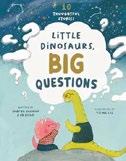
Dr. Diplo deals with dinosaur dilemmas. Not infrequently, life throws us puzzles too tricky for an easy answer. Dr. Diplo (an aptly named Diplodocus) has spent years thinking about tough issues, and now gives us some help in thinking through and sorting out 10 of them. A succession of mildly troubled young dinos pepper the good doctor with questions. What’s the difference between fairness and equity? Why do bad things happen, and what can we do about them? Haddow addresses privilege, how to respond to deliberate meanness with forgiveness, and ways to identify actions characteristic of a good friend. Can we lie to avoid hurting someone’s feelings? How can we be kind to nature? What’s good about being different from others? Why must we follow rules? What is grief like, and how can we deal with it? Haddow considers all these questions without being prescriptive. A note reassures non-psychologist caregivers that they,
too, can help their children with “big questions.” Lee’s line-and-color vignette illustrations are naïve in style, with partly human-clothed reptiles in mostly flat-background scenes; a few references to prehistoric life (including many ferns) are mixed in with modern settings. Readers will find it easy to identify with these little reptiles as they struggle.
Sensible, small-scale moral philosophy, bound to smooth rocky paths. (bibliography) (Graphic nonfiction. 5-8)
Hafiza, Radiya | Illus. by Kaley McKean Macmillan Children’s Books (224 pp.)
$8.99 paper | October 7, 2025
9781529038323
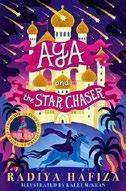
A 10-year-old living with her mother on a small farm in the idyllic kingdom of Alferra finds her life transformed overnight. While watching the Perseids meteor shower with best friend Naznen, Aya is hit by a shooting star that leaves her with mysterious powers—steam puffs out of her ears, flames shoot out of her mouth, and flowers spring up where her tears fall. A confused Aya discovers that a prophecy that “a star would strike a special child” might be connected to her father’s disappearance when she was a baby. Meanwhile, rumors of abductions by a criminal gang circulate throughout Alferra, causing fear. After the evil, power-hungry witch Abnus the Great ambushes the royal family and claims the throne, Aya and her mother flee, hiding in neighboring Al Bahr. But when Ammu goes missing, Aya is compelled to return
Sensible, small-scale moral philosophy, bound to smooth rocky paths.
LITTLE DINOSAURS, BIG QUESTIONS
to Alferra to confront the witch and her army of demonic, red-eyed bhoots. Dreamy, artistic Aya, a brown-skinned Muslim girl who wears a headscarf, loves stargazing and is a likable protagonist; her transformation from diffident schoolgirl to brave hero will strike a chord. By contrast, many other characters, especially the antagonist, Abnus, feel flatter and less developed. The interesting premise is let down by slow pacing and a meandering narrative but is offset by a satisfying ending. The characters are predominantly brown-skinned. McKean’s striking gray-toned illustrations complement this uneven yet heartening story. A tepid tale about a reluctant chosen one. (Fantasy. 8-12)
Hassan, Rochelle | Harper/HarperCollins (368 pp.) | $19.99 | October 21, 2025 9780063314627 | Series: Nox Winters Chronicles, 2
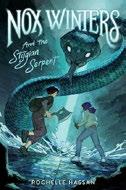
Nox Winters is determined never to return to the Nightwood. The danger-filled forest of perpetual darkness in Evergreen, Maine, nearly killed Nox’s beloved twin brother, Noah, during their adventures nine months earlier. But the Nightwood has other plans for the boys, whose father, the Evergreen Devil, has supernatural powers. When their friend Violet’s mother and other members of her hidden community go missing, and their people are threatened by undead creatures, the twins and their friends embark on a quest to save their allies, facing magical challenges reminiscent of games like chess and capture the flag. The world of the Nightwood remains joyously, wildly creative, as exemplified by the supernatural mysteries that populate the forest. Nox and company face off against Forta (the “lord of good fortune in games, contest, and sport”), frost soldiers, a giant serpent, and a fearsome three-eyed blacksmith. All the while, Nox’s discomfort with his new
fire powers contrasts nicely with Noah’s enjoyment of his plant magic. The twins are endearing protagonists, as are their friends: nature-loving Thea, responsible Violet, and easygoing Nine, who has wings. Hassan is skilled at combining nonstop, well-executed action sequences with artful descriptions without losing a strong sense of fun. Most of the main cast reads white, and the previous book established that Violet has light brown skin. An energetic and inventive sequel. (Fantasy. 8-12)
Heim, Alastair | Illus. by Migy Blanco Tiger Tales (32 pp.) | $10.99 | January 6, 2026 | 9781664300811 | Series: Stop That!
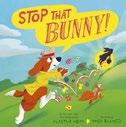
Once again, Cluehound’s sweet treats (temporarily) vanish before our hero can enjoy them.
The third entry in the Stop That! series sees bumbling Inspector Cluehound again in holiday hot pursuit. This time the thief is the Easter Bunny, who has nabbed the clueless inspector’s very special parade-ready Easter basket, chock-full of goodies. Under blue skies, the detective and Sergeant Squirrel mount a pink tandem bike. The chase takes them through a flower stall, a topiary-adorned garden, a carrot patch, and finally a festival, where a bouncy house lets Bunny “eggscape” into the ether. Along the way, as Bunny hides, Cluehound is distracted by some decorated eggs (easy for youngsters to spot); then Bunny becomes a scarecrow and is concealed in a wheelbarrow brimming with carrots. Cluehound focuses on duck tracks leading to a pond, where the ducks are floating in plain sight, while we (and Sergeant Squirrel, vainly trying to attract the boss’s attention) see the actual prints left behind by the bunny scampering out of sight over the hill. Accessible to independent readers, the book’s rhyming couplets bounce along just like the energetic rabbit does. Youngsters will
enjoy the bright spring-colors pastel art and beating Cluehound at the detecting game, with the inevitable sweet, happy ending: a basket much more elaborately decorated than the original one, and overflowing with extra treats. Sure to satisfy this gumshoe’s many fans. (Picture book. 3-7)
Hoover, P.J. | Illus. by Lisa Wiley Kids Can (120 pp.) | $16.99 October 7, 2025 | 9781525310836
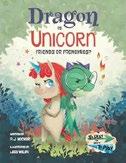
Two young pals with different personalities clash and compromise repeatedly as they find ways to play together. In three interactive stories with multiple endings, readers navigate Dragon and Unicorn’s friendship along with them in different situations. The “frenemies” label from the title isn’t really accurate: Bespectacled green Dragon and blue-eyed, blue-horned Unicorn are best friends and truly care about each other, but each needs to speak up to remind the other that they have different wants and needs. In “The Clubhouse,” Dragon prefers a neat and tidy space with just the two of them, while Unicorn wants all her stuff—and to invite other friends. In “The Sleepover,” Unicorn is scared of ghost stories, and Dragon is overwhelmed by too many activities. In “The Playground,” they argue over what to do when they find someone else’s lost toy. Both characters sometimes make mistakes and behave selfishly; neither remains on the moral high ground all the time. But they also model empathy, have difficult conversations, and compromise so they can make each other happy. The Choose Your Own Adventure–style stories allow readers to make decisions along with Dragon and Unicorn, trying out different paths and solutions. Personalized emanata—smoke and flames for Dragon, glitter for Unicorn—add a special touch. For a fun friendship story, turn the page! (Graphic fiction. 7-10)
Horáček, Petr | Candlewick (32 pp.) $18.99 | October 7, 2025 | 9781536248210
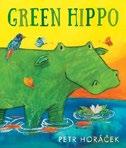
A hippo is too sad to listen to his friends’ supportive comments. After someone tells Green Hippo that his kind doesn’t exist, he goes to Frog for help.
“NONSENSE!” says Frog, but Green Hippo dismisses his pal’s reassurance. “Well, that’s easy for you to say,” replies Green Hippo. “Frogs are supposed to be green, just like you.” He’s similarly dismissive when Elephant and Giraffe attempt to soothe him. How can they understand? Heading off on his own, Green Hippo finds beauty in the various creatures all around him; newly affirmed, he rejoins his friends, who have a surprise for him. Though Green Hippo resolves his conflict implausibly swiftly, the story’s sweet and encouraging message of self-acceptance ultimately comes through clearly thanks to Horáček’s illustrations. His depictions of vibrant, detailed birds, butterflies, and fish flood the senses after several pages of simple, broad shapes as Green Hippo literally and metaphorically opens his eyes beyond his own sadness and realizes that differences make the world a better place. And while Green Hippo’s friends may not fully understand his plight, their unwavering acceptance makes for an inspiring meditation on the ways in which friends can support one another.
A colorful statement on the power of difference and friendship. (Picture book. 3-6)

Kirkus Star
At the Rescue Cat Café
Humphrey, Anna | Illus. by Kari Rust Owlkids Books (32 pp.) | $18.95 August 12, 2025 | 9781771475402
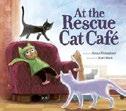
Rescue cats find perfectly matched human companions at this special eatery.
The Rescue Cat Café is a cozy and inviting place, with windows that display warm beverages to enjoy and a dozen formerly homeless cats to befriend and take home. Every day for a week, a girl in a green jacket with a cat-eared hood and her grown-up visit and settle into chairs, where the child reads to the cats and observes fellow cat lovers searching for feline friends. A family adopts two playful kitties named ChiChi and Bunnykin, an older man cuddles a senior cat named Honey, a male couple connects with cat pals Russell and Jerry, and many more. But no one seems to notice an aloof black cat named Mouse, hiding in a corner or a cubby on each page. Fear not: Mouse finds his perfect forever home, which is why, as the narrator states, “You won’t see Mouse at the Rescue Cat Café.” Humphrey’s deceptively simple, well-crafted prose tells a heartwarming story that’s enhanced through a vivid, detailed illustration style that fills in the development of each friendship. Rust’s vivid palette of deep reds, greens, and blues is splashed with sunlight from the eatery’s windows, making each page as inviting as the place itself. The young girl has light brown skin; other characters are diverse.
Heart, hope, friendship, and cuddly cats—perfect for storytime! (Picture book. 3-7)
Jackson, Bea | Simon Spotlight (32 pp.)
$18.99 | July 29, 2025 | 9781665941129
Series: Fairies Welcome
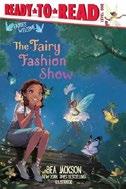
Fae fashionistas strut their stuff. As it turns out, fairies love couture; a fairy named Lily explains to readers that they sport jewelry and clothes inspired by the natural world. Held in a leafy glade, their annual fashion show offers them the chance to show off their finery. Lily’s human friend, Willow, admires fairy fashion and wishes she could wear some of it. So Lily organizes a makeover, assigning jobs to the other sprites. Jasmine styles Willow’s hair, while Sky makes her a necklace out of flowers. Initially clad in overalls, Willow finishes the story in a long-skirted pale lavender dress. Lily makes Willow a lustrous pair of matching wings and, just before the show starts, adds a sprinkling of fairy dust. Composed of curving lines, Jackson’s swirling, sparkling illustrations play to the most romantic impulses: Twisting vines, tendrils of hair, flower petals, ballerinalike tutus, and shiny fabrics make every page shimmer. The typeface is large, many words are single-syllable, and a sense of pleasant anticipation will carry new readers onward through the brief story. Newcomers and fans of the pair’s other outings, including the picture book Lily’s Dream (2025), will be pleased. Willow and Lily present Black; the fairies vary in skin tone and body type. An inviting fantasy for fashion-forward beginning readers. (Early reader. 4-6)
Jin, Susie Lee | Simon Spotlight (32 pp.) $18.99 | January 13, 2026 | 9781665983402
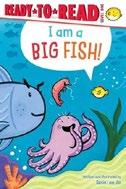
Little or big, the puffer fish knows itself very well. This excellent early reader starts out with a case of classic oneupmanship as a school of colorful small fry approach a slightly larger, yellow puffer fish. “Wow, you are a big fish,” they say admiringly. A nearby jumbo shrimp isn’t impressed and says so, injecting wordplay for good measure: “No, you are not. I am big, and I am shrimp-ly amazing.” Bigger and bigger marine life appear in the playful, cartoon-style illustrations, each one declaring itself larger (and by implication, better), but the yellow fish holds its ground. “If you are a big fish, then PROVE IT,” chides a blue-colored fish. In an admirable display of integrity and self-possession, the yellow fish responds, “No, I do not have to. I am leaving.” Cue the Jaws music: Just after those who have been teasing the yellow fish declare themselves hungry, a shark appears on the verso of the spread. “I would love a nice BIG FISH.” Exercising terrific use of composition and layout, Jin has all the others flee to the right on the recto, suddenly eager to proclaim their relative smallness—all except the yellow fish. In a supremely satisfying twist, “POP! POOF!,” the little yellow fish puffs up to dominate the page, outsizing all rivals—even the shark! A wholly gratifying tale of a small fish in a huge pond that nevertheless proves its mettle. (Early reader. 5-7)

I AM A BIG FISH!
Johnson, Keyshawn with Bettina Bush & Ryan
G. Van Cleave | Illus. by Mona Meslier Menuau
Bushel & Peck Books (32 pp.) | $18.99 November 11, 2025 | 9781638192329
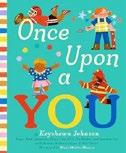
C o-authors Johnson and Bush— celebrities in sports and media, respectively— joined by Van Cleave, urge kids to reach for the stars.
“The story of you began the day you were born. With each passing year, as you grow and change, so does the story of you.” These sentences bookend a double-page spread showing a brownskinned child with curly dark hair in a simultaneous succession of five points of growth—from infant to toddler to young running child. Next, an illustrated roller coaster complements the text’s reminders that every story has “ups and downs, twists and turns, excitement and mystery.” The next pages suggest possibilities in children’s futures, most of them exceptional. Rather than suggesting someone might play football, act, write, or study paleontology—rarefied in themselves—they might “score touchdowns,” “light up a stage,” “write a best-selling novel,” or “investigate a new species.” Social action gets a nod. More pages follow in which kids are urged to ignore outside voices of discouragement and to trust their inner voice in choosing clothes, actions, and words. More ego-boosting text ensues, always accompanied by lively, colorful, literally star-studded art featuring a diverse crew of kids. The upbeat tone of the text and art makes this a probable choice for a doting grandparent to read to a beloved young grandchild. Older kids may be inspired by Johnson’s personal endnote about overcoming adversity to become a champion football player.
A plethora of uplifting suggestions. (Picture book. 4-8)
Karpíšková, Lenka & Jiří Vlach | Illus. by Tomáš Kopecký | Trans. by Graeme Dibbl & Suzanne Dibble | Albatros Media (48 pp.)
$17.95 | January 27, 2026 | 9788000075723
Series: Science All Around Us
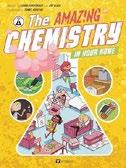
A room-by-room house tour, showing that chemical substances and reactions are everywhere and essential. Prefaced by a chatty periodic table of elements, this Czech import opens in a bedroom, where a racially diverse quartet of young people are directly interacting with oxygen and other atmospheric gases, a toy made from neodymium magnets, a silicon-dependent cell phone, and a sampling of other common items. After identifying the elements in play there, Karpíšková and Vlach demonstrate in general terms how changes in temperature affect molecular bonds before moving to a kitchen to discuss the processes of mold, rot, fat, and digestion. The continuing tour turns out to be distinctly hit or miss; the authors are specific on the essential components in shampoo in the bathroom and in colored fireworks on the porch, but they skip describing how electric and internal combustion motors function (in the garage), explaining only how fuel cells work. Nor are their scattered suggestions for young experimenters always entirely safe, including tasting cellophane and dripping orange juice on a balloon to make it pop, without donning protective eyewear. They also include more than a few questionable opinions, simplistically recommending long-lasting metal tableware over the biodegradable sort for
environmental reasons and warm water over cold in the laundry. Eye-opening, but superficial and occasionally iffy. (glossary, bibliography) (Nonfiction. 8-10)
Kennedy, Becky | Illus. by Joanie Stone Feiwel & Friends (32 pp.) | $19.99
February 24, 2026 | 9781250413116
Series: A Good Inside Story
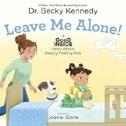
After a beloved game goes awry, a young girl learns how to deal with her anger. While playing secret agents with her brother, Charlie, little Pia noisily trips, inadvertently alerting Mom and Dad to the kids’ special mission. “Try again!” encourages Dad. “We’ll pretend we didn’t see.” But frustrated Pia doesn’t want to; exploding with sadness, rage, “and a lot of other feelings she couldn’t quite name,” she stomps her feet, kicks, and shrieks. As in the family’s first outing, That’s My Truck! (2025), Mom assumes the lead, firmly taking Pia upstairs to her room. Instead of giving Pia the timeout that readers may be expecting, this calm, knowledgeable mother realizes that her child is a DPK (a “deeply feeling kid”) and offers loving support. This second series entry, also steeped in Kennedy’s child-rearing philosophy—as espoused on her website—exhibits the same issues as the first. Much of the narrative involves Mom serving as a quiet, steady presence as Pia works through her emotions—it’s a useful model for parents whose kids have frequent outbursts, but little ones are unlikely to find it all that compelling. Stone’s uncluttered illustrations feel a bit static, reflecting the action of the text but adding little else. Adults may wish that Pia and Charlie’s father played a more active role. Characters are illustrated with varying shades of brown or tan skin. Potentially useful but didactic insights on coping with childhood tantrums. (Q&A with information for caregivers) (Picture book. 4-8)
Larwood, Kieran | Illus. by Joe Todd-Stanton
Nosy Crow (272 pp.) | $17.99 | October 28, 2025 9798887771830 | Series: Dungeon Runners, 3
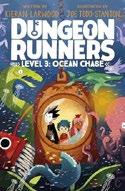
Sportsmanship, trust, and a flying sword move the Triple Trouble team through perilous, monsterfilled chambers in this third series entry. Kit, Sandy, and Thorne form Grotville’s unlikely Dungeon Runners home team. They survived the second level and are on their way to the Orb, an underwater dungeon that harbors sea monsters including kraken, octowolves, and flame eels. Kit still feels like an underdog; his practice sessions haven’t been promising, and although team healer Thorne is trying to do better, his remedies are still far from perfect. Sandy, the team’s mage, dreams of becoming a sea hag, which could give them an edge in this watery setting. During their previous run, Kit struggled with self-doubt and trust, but he’s learned and grown. He acknowledges that his teammates are “usually right,” allowing Thorne and Sandy opportunities to shine and reinforcing their strength as a team. Another welcome element is the way Triple Trouble displays courage, kindness, and sportsmanship by reciprocating the generous treatment of rival team the Yarn Stormers, which leads to a friendly temporary alliance. As before, Larwood’s writing is fun, fast-paced, and kidfriendly. Todd-Stanton’s illustrations, which show characters who vary in skin tone, remain a key part of the narration’s success, enhancing the storytelling and
adding to the humor. A cliffhanger ending will leave readers breathlessly awaiting the next outing. Combines fun, page-turning adventure with sincere character development. (map, many-sided die template) (Fantasy. 7-10)
Law, Ingrid | Illus. by Xin Li | Rocky Pond Books/Penguin (32 pp.) | $18.99
August 26, 2025 | 9780593697955

Newbery Honoree Law’s inviting picture-book debut highlights reassuring rituals for bedtime.
“Sometimes / bedtime / might feel / like the dark cave / in the gloomy woods / from your favorite storybook,” Law acknowledges. “Close the book, child,” she urges, “and remember: / you are not alone.” The night light glows, parents offer comfort, leftopen doors brighten, kisses linger. Even after good nights, best-loved stuffies remain close. Meanwhile, the household offers plenty of signs of activity: Grandma’s got three more bathroom visits to go; the fridge hums along; the kitty purrs. Outside, a cricket chirps, an owl hoots, and porch lights illuminate the “homes of friends, neighbors, / of people you don’t yet know / but might… / one day.” At all hours, cars, trucks, and trains are in constant motion, leaving behind echoes. “You are never alone, / say the pages / of this book,” in soft rhythmic repetition throughout, lulling audiences gently to slumberland. Li’s lucid palette smooths the child’s worries, easing concerns with vibrant lightness—and a never-far security quilt of primary colors. Beyond
Law’s verses, Li’s detailed illustrations add additional comforts: The stuffed animals are larger-than-life protectors, walls are warmed by family photographs, and grandmother and grandchild sport matching bunny slippers. A parent’s final check on the sleeping child provides that definitive assurance of safety. Characters are light-skinned.
Law’s title becomes a soothing refrain that softens nighttime fears and encourages welcome rest. (Picture book. 3-7)
Lee, Emeline | Illus. by Basia Tran Kokila (40 pp.) | $18.99 | January 13, 2026 9798217002795

A gluttonous ghost seeking satiety finds a friend.
An enormous appetite haunts Gwei, a blue ghost. He eschews cemetery visitors’ pedestrian offerings— a pile of oranges disappoints; a bowl of rice is beneath him. When the Ghost Festival arrives, he floats into the human world to fill his spectral belly with earthly delights—whole fish, hand-pulled noodles, custard tarts. But no matter how much he consumes or hoards in his takeaway pouch, he still feels empty. When a small orange ghost starts tailing him, begging for a bite, he hesitates. But ultimately he acquiesces and allows the newcomer to share his bounty; in doing so, he’s finally able to feel satisfied by his feasting. The story simply expresses the ideas that pleasures are best enjoyed in company and that giving can be a gift to the giver. Paired with this message are sumptuous visuals of mouthwatering Chinese cuisine, a buzzing night market, and a river flowing with ceremonial lanterns floating souls to the afterlife. Both story and illustrations are more culturally suggestive than specific and could serve as an introduction to the autumn holiday for readers new to Chinese traditions. This book could easily be discussed in tandem with other ancestor-focused holidays like the Day
of the Dead. Illustrated backmatter dives deeper into Ghost Festival celebrations and the spectral pantheon of Chinese folklore.
A feast for the senses with a sweet message of sharing. (glossary, bibliography) (Picture book. 4-8)
Lewkowicz, Freda | Illus. by Sally Anne Garland | Apples & Honey Press (32 pp.)
$19.95 | October 28, 2025 | 9781681156941

In this tale inspired by the experiences of prima ballerina
Marta Cinta
González, a former dancer struggling with Alzheimer’s disease unlocks her memory with the help of her grandchild. Nana no longer knows how to braid challah for Shabbat, and she no longer dances with her grandchild, Sarah, the way they used to. Distressed, Sarah seeks ways to release Nana from the grip of the Memory Thief. With love and compassion, Sarah tries to lift the curtain on the memories stolen from Nana and help her rediscover the magic of dancing on the stage. After grabbing Nana’s cell phone and playing music from Tchaikovsky’s Swan Lake, Sarah reaches through the past to reconnect Nana to her days as a ballerina. Nana leaves her present difficulties behind and once again soars in the spotlight as she rediscovers her love for ballet. The book is gracefully infused with Jewish concepts and traditions: Nana tells Sarah that they are “braided together, just like challah,” the two of them dance like the “flickering flames on a Hanukkah menorah,” and when Nana can’t find the right words, Sarah suggests that they’re hiding, “like the afikoman at Passover.” Lewkowicz’s gentle and evocative text shimmers with the language and symbolism of ballet, while Garland’s sweeping strokes and bold colors effectively show the contrast between Nana’s former triumphs and her new reality. Nana and Sarah are light-skinned.
A beautiful story filled with empathy for those grappling with memory loss.
(glossary of ballet and Jewish terms) (Picture book. 4-8)
Lin, Grace | Little, Brown (48 pp.)
$16.99 | $4.99 paper | January 6, 2026
9780316578073 | 9780316578080 paper
Series: Ling & Ting, 5
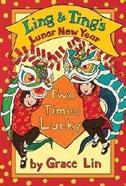
Prolific Lin’s fifth volume in her popular early-reader series showcases Lunar New Year traditions.
Chinese American twins Ling and Ting “celebrate the new year two times.” The calendar New Year is over, and Lunar New Year is next. Ting grouses about cleaning, but Ling “likes to prepare” by washing dishes, cleaning windows, and finishing laundry while Ting sweeps. When Ting throws the accumulated dust out the front door, Ling worries: “That dust is our bad luck!” She explains, “The New Year will come through the front door…Now it will go through our bad luck! It will bring our bad luck back to us. We will not have a lucky year!” But Ting cleverly remembers that their home has two doors: “The side door has no bad luck.” And so the twins commence their plans to “make our side door look like our front door,” with double banners, lucky oranges, and lion costumes to welcome the New Year. Lin’s resplendent illustrations adorn every page, particularly bestowing the twins with vibrant personalities—not to mention quite the admirable wardrobe, from polka-dotted red aprons to distinctive red-and-gold qi pao. The twins delightfully rely on Lin’s own picture book Bringing in the New Year (2008) as a preparatory guide. Chapter title pages are sure to elicit laughter. Working together, Ling and Ting gleefully prove they’re “two times lucky.”
Readers will be charmed as this beloved pair ingeniously ring in the Lunar New Year. (artist’s note) (Early reader. 5-9)
Kirkus Star
Mang, Veronica | Viking (40 pp.) | $18.99 February 24, 2026 | 9780593693711
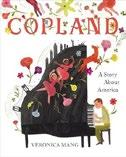
How a child of Russian immigrants set out to write music that sounded like his new country.
“This is a story about music,” writes Mang, repeating the line often enough that it becomes a refrain. Within a subtly rhythmic account of how Aaron Copland became one of this country’s most acclaimed and successful composers, the author describes how he learned to incorporate street sounds from his Brooklyn childhood, strains of jazz heard in Harlem, symphonic techniques learned in Paris in the 1920s, and, later on, melodies from Appalachian and Mexican folk traditions into orchestral and ballet music that profoundly “sounds like America.” Both in the main section and the lengthy afterword, Mang beautifully captures her subject’s thinking and process: “Symphonies are decadent with layers and layers of sound. Aaron seeks something new. ‘What if we make space for new things to grow?’” Some of his “smashing, crashing” compositions did confuse many listeners, and in the backmatter, she frankly acknowledges that thanks to being Jewish, gay, and deeply engaged in leftist social causes, he sometimes ran into difficulties, particularly during the McCarthy era. Still, few American instrumental compositions are played more to this day. In her joyfully, effervescent illustrations, multiracial, multicultural groups sing, dance, and march on the way to a final display of modern young music lovers who are the most diverse of all. “What do you hear? What song will you write? ” she asks them.
A triumphant fanfare for a great American composer. (suggested listening, bibliography) (Picturebook biography. 6-9)
HIKARU IN THE LIGHT!
Marshall, Yolanda T. | Illus. by Marianne Ferrer | Greystone Kids (40 pp.) | $19.95 September 16, 2025 | 9781771649261
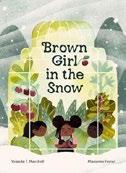
A Caribbean girl who moves to the snowy north longs for her verdant garden.
Amina’s new home is a snowy landscape where other kids play while she “daydream[s] of the sunfilled days she spent climbing coconut and mango trees.” What she misses most is “planting yams, callaloo, onions, tomatoes, peas, herbal bushes for her tea, and especially her sweet potatoes.” She mourns: “There’s a brown girl in the snow, / Tra la la la la, / where none of her plants will grow.” Her dad takes her to the library, where she finds comfort in a book about gardens. At school, her empathic teacher notices Amina’s horticultural interests and plans a field trip to a greenhouse. Other students express their excitement, and new friendships slowly begin to blossom. At the nursery, kind Mr. Lokon nourishes Amina’s sweet potato dreams. Marshall cleverly alters Amina’s song to gauge how the girl is adapting, turning “none…will grow” into “some of her / plants might grow” to “ALL of her plants will grow.” In a touching author’s note, Marshall discusses her own childhood emigration from Guyana to Toronto. Venezuelan-born Canadian artist Ferrer uses a rich, earthy palette for her inviting spreads saturated with greens and browns, reserving a lush purple for the beloved potatoes. She bestows Amina’s dad with an especially flashy, fabulous wardrobe. Characters are all depicted in varying shades of brown.
Family, friends, and greenhouse sweet potatoes ensure a youngster’s warm immigration transition. (Picture book. 4-8)
Amazing
and the True Stories Behind 22 Incredible
Martineau, Susan | Illus. by
Vicky Barker
Bright Matter Books (96 pp.) | $18.99
November 4, 2025 | 9798217116300
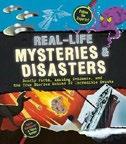
Case files invite young readers to practice their detective skills on sets of unexplained oddities and large-scale catastrophes.
Neatly divided into 11 each of the titular categories, the entries all include a brief account of events, followed by a spread of notes, maps, eyewitness testimonials, and theories about origins or causation, arranged as if pinned on a bulletin board. Selected mysteries include supposed evidence of alien visitations from crop circles to Nazca lines and UFOs, plus reports of time slips, ghosts, and spontaneous human combustion. Disasters range in scope from the explosion of the hydrogen-filled airship R101 in 1930 and the Piper Alpha oil rig in 1988 to the extinction of the dinosaurs and the Black Death. Barker’s small, stylized images are often skewed as if they’d been dropped into place, which gives some spreads a busy look. Some blocks of text are placed on dark, low-contrast backgrounds, which makes them hard to read in low light. Still, all the immense explosions and tantalizing occurrences make for rousing reading,
and the author judiciously balances credulity and common sense in her presentations. Tricky terms are defined both in the main narrative and an appended glossary. Fruitful browsing for young people curious about the strange and unusual. (Nonfiction. 8-10)
Matsuda, Mai | Graphix/Scholastic (192 pp.)
$11.99 paper | March 4, 2025 | 9781546140986
Series: Hikaru in the Light!, 1

A Japanese teen auditions for a highly competitive musical group. Hikaru, 14, sings while cleaning her family’s bathhouse—the high walls’ acoustics are perfect, and the elderly audience members are an encouraging bunch, even if they keep requesting American oldies. But she wonders if there’s more to life; for the past few years, her good friend Ran has been performing in a highly produced pop band. Ran shows up one night, declaring that she quit the group and that she wants to audition for a new ensemble being formed by a world-famous producer— and she hopes Hikaru will join her. Hikaru agrees, and the two dive straight into the rigorous competition together. Hikaru’s central struggle proves her greatest gift; she’s an amateur who performs with a mop instead of a mike, but she sings with her whole heart, captivating both the judges and her fellow contestants. Meanwhile, Ran wants to reinvent herself and prove she’s more than just a pretty face. This manga, originally published in Japan, focuses on the competition’s stages and personalities; the closest U.S. analogue is musical competition shows like The Voice, though this story has more grit than gloss. Full-color illustrations capture, with equal charm, Tokyo street scenes and idols sparkling onstage. Hikaru’s hyperexpressive face conveys a broad range of emotions, making her big eyes look even bigger; she’s a comedic, sympathetic central character.
Potential pop stars sparkle in this intense series starter. (Graphic fiction. 9-15)
Matsuda, Mai | Graphix/Scholastic (192 pp.) $11.99 paper | November 4, 2025 9781546141013 | Series: Hikaru in the Light!, 2

Rivalries heat up as a Japanese amateur singer strives to master her skills quickly. Hikaru and Ran have made it past auditions and are officially in the running for a fresh, performance-focused idol group. They find themselves among 40 girls who have two days to prove their singing and dancing skills before half the group is eliminated. Hikaru, who’s never danced professionally, watches closely as the other girls audition and uses her observations of both their talents and deficiencies to inform her own performance. Meanwhile, Ran is trying to figure out how to distinguish herself after failing to stand out in her previous idol group. After an intense elimination, the 20 remaining girls are grouped into teams, with amateurs working alongside veteran performers to prove their ability to take critique, improve their talents, and save themselves from elimination. This second entry in the manga series, originally published in Japan, focuses heavily on the philosophical underpinnings of creative performance, highlighting talent, tension, and the drive to excel. Other competitors are introduced and given more distinct personalities, including Kaede, a former backup dancer for another idol group, and Hikaru’s bold, encouraging roommate, Amina. Older mentors for the group provide voices of wisdom and encourage Hikaru to reflect on what really makes her performances shine. Hikaru’s roommate and vocal coach both have brown skin. The thrill of competition takes the spotlight in this intense series installment. (Graphic fiction. 9-15)
Mikai, Monica | Crown (32 pp.) | $18.99 January 13, 2026 | 9798217027545
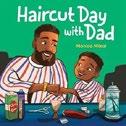
For a father and son, a barbershop outing is special, even magical.
Secured in his booster seat with his breakfast burrito in hand, a young Black boy grins as his father drives to the barber shop. When they arrive, they’re greeted by an array of Black men, all varying in complexions, ages, and, of course, hairstyles (some still in progress). The duo have developed a routine: They study the chart listing different styles (“The fro, the high-top fade, the flattop, lightning bolts in the side, maybe a clean shave?”) before settling on the same thing (“Short high fade as usual”). As sports games play on TV and other patrons play chess, they wait until it’s their turn in the chairs. That’s where the magic happens, with our young narrator envisioning barbers in magician garb turning his and Dad’s fly but lengthy hairdos into something truly their own. It’s clear both from Mikai’s warmly conversational prose and her detailed vignettes, packed with detail and personality, that this is an incredibly special time and place for father-and-son bonding. The two of them treasure the day but make sure to cherish and care for themselves and one another even more. A vibrant example of both Black joy and self-care. (Picture book. 4-8)
Mills, J. Elizabeth | Illus. by Ben Whitehouse Cartwheel/Scholastic (24 pp.) | $5.99 paper December 30, 2025 | 9781546180487
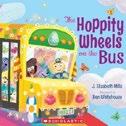
on a rainy spring day. Who is the driver? A dapper bunny, of course. Mills’ text breaks into a familiar tune: “One hoppity bus goes SPLISH and SPLASH, / SPLISH and SPLASH, SPLISH and SPLASH… / All through the rain.” After picking up three young human passengers (two are dark-skinned; one is pale-skinned), the vehicle rolls onward to the farm for a springtime festival. Ducks are quacking, dogs are digging, and hens are pecking. Every action is very spring-themed, but one obvious Easter reference sneaks in: “Seven spotted eggs play HIDE and SEEK, / HIDE and SEEK, HIDE and SEEK.” The cadence is easy to follow; those reading this aloud will need very little practice. Whitehouse keeps the scenes bouncing along with bright colors, energetic puddle splashes, and sparkly magic puffs as the rain stops and the bus flies off into the sunset toward a rainbow. Storytime friends will undoubtedly be bouncing and singing along.
A springy, hoppy, rollicking good time. (Picture book. 1-4)
Montague, Liz | Scholastic (208 pp.) | $14.99 December 2, 2025 | 9781338792577
Series: School for Unusual Magic, 3
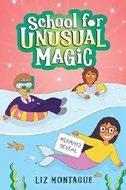
Mills and Whitehouse return with another holiday-themed bus stop ditty.
Festooned with daisies, an orangeand-yellow-striped bus with bee wings attached to its top and a license plate that reads “HOP2IT” pulls up to the corner
L av, Amethyst, and Rose, who are in their last year of Elementary Magic, must strengthen their friendship bonds as they try to solve an environmental catastrophe.
After half-Mer student Cyan pranks Lav on the first day of spring semester, he reacts angrily, and both boys end up in Dean Jared’s office. There Lav discovers that Cyan, who’s now been assigned as his official buddy, is also from Île Violette. As the boys prepare for their Equinox Test together, Lav sees how poorly some people treat the Mer. Back in Brooklyn, Amethyst is attending school in the Under City—she loves it among the Mer and has trouble reconnecting with people when she visits “the land part of
TREASURE THIEVES ON THE HIGH SEAS
Brooklyn.” Rose returns to school feeling sad that she’s no longer able to use Heart Leading to connect with Amethyst; she’s determined not to let their connection fade even more. One Saturday when Amethyst is home, she and Rose Heart Lead to Chicago for a visit with Lav. They learn that the spell that created land is starting to fail, and “now the water is starting to take it back.” The friends must cooperate to help land and water stay in balance to sustain the magical cycle. The racially diverse, well-drawn characters navigate relatable friendship changes and frenemy encounters and grow throughout the story. The sweet, cheerful illustrations convey the characters’ emotions and help readers visualize the magical settings. A clever story that explores the interplay between relationships and magic. (Fantasy. 8-12)
Morros, Marta | Illus. by Mariona Tolosa Trans. by Cecilia Ross | NubeOcho (36 pp.) $16.99 | October 7, 2025 | 9788410406582 Series: Somos8
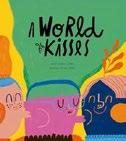
Innovative art and mostly rhyming verse produce a lighthearted primer about the titular subject. This odd but appealing book immediately grabs readers’ attention with the cover art’s chain of garishly colorful faces, each featuring wildly extended lips as they kiss the neck or cheek in front of them. An unidentified narrator asserts, “I love kisses, all kinds and colors of them.” As fancifully hued human figures, geometric shapes, and stylized flora and fauna float about, so do phrases such as “big smackeroos” and “sweet smooches.” Throughout, brief rhyming verses describe kisses from
relatives, pals, and pets. Many observations will elicit chuckles: “Kisses from friends can sometimes be sticky, / and the loudest kisses are the ones from Aunt Vicky.” Another page re-creates a kiss from the film Titanic as the narrator complains, “Lovey-dovey kisses can be a bit much.” Morros includes a few facts, such as words associated with kiss sounds in other languages. She also encourages youngsters to say no if a kiss isn’t desired. The joie de vivre of Tolosa’s artwork is perfectly complementary, catapulting each page into the next. Ross’ thoughtful translation from the original Spanish ensures that the text provides an easy read-aloud to a beloved child or group of youngsters.
Mwah, mwah! A well-played tribute to all things kiss-related. (Picture book. 3-6)
Moss, Marissa | Walker US/Candlewick (224 pp.) | $19.99 | December 9, 2025 9781536218039
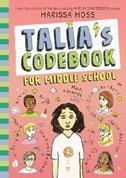
Talia tries to crack the code to the complexities of sixth grade.
Talia Zargari loves math, writing, and drawing. She uses her codebook— filled with her observations, deductions, and artwork on quad-ruled pages—to decipher and navigate the unspoken rules of middle school. Talia is happy to still be best friends with Dash after other kids’ teasing about dating puts distance between them. She’s also thriving on the Chimeras, the newly formed co-ed math team, led by the smart and confident Leticia. The allgirls math team won a competition, and Talia hopes the boys will now treat
them with more respect. Art teacher Mr. Wayne shows Talia and her friends connections between math and art, intertwining her two passions. But despite her successes, Talia’s parents put excessive pressure on her to succeed so as not to jeopardize her future college applications—and they continue to bring up a mistake she made in her last math competition. Fortunately, Talia learns that people are more complex than they initially appear: She once saw Leticia as effortlessly cool and smart but later learns that they share a lot of the same concerns, and the girls forge a bond. Working toward their next competition shows the math team members that practice pays off and that there are lots of different ways to lead. Talia has tan skin and curly black hair, Dash and Leticia read Black, and background characters mainly present white. Entertaining and affirming. (Illustrated fiction. 8-12)
Munro, Roxie | Holiday House (48 pp.) $18.99 | February 24, 2026 | 9780823459476

A gallery of romanticized buccaneer all-stars, from the Elizabethan era’s Sir Francis Drake to 19th-century pirate queen Ching Shih.
Most of the seven men and four women portrayed here, from John “Black Bart” Roberts, the “best dressed pirate ever,” to Anne Bonny and Mary Read, are renowned enough to be generally familiar. Still, Munro follows up her colorful (if likely unproveable) claim that Drake was “the second-highest earning pirate of all time” with an introduction to her candidate for the richest—Henry Avery, a one-time slave trader about whom almost nothing is known except that he came away fantastically rich after taking a treasure ship owned by the Grand Moghul of India. The book closes with a
thumbnail history of piracy in general up to the present day that explodes at least a few myths—Viking ships were mostly rowed by enslaved thralls, not warriors, and there is only one documented instance of anyone being made to walk the plank—and includes a gallery of common types of ships sailed during piracy’s “Golden Age.” A portrait of Captain Morgan posed like the image on a popular rum bottle label may be a misstep, but elsewhere, along with rousing views of piratical loot and flamboyant garb, the illustrations offer images of rakish sailing ships and mildly dangerous-looking swashbucklers of both sexes. Skin tones vary. A glittering hoardlet of pirate legend and lore. (index, bibliography) (Informational picture book. 7-9)
National Geographic Kids | National Geographic Kids (272 pp.) | $19.99 September 23, 2025 | 9781426374029
Series: National Geographic Little Kids First Encyclopedias
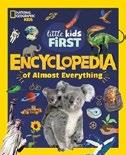
A visual compendium spanning a broad array of topics.
Vibrant photography, bright illustrations, and clear diagrams distinguish this beginner’s encyclopedia, which covers a wide range of topics divided into 10 broad sections: “All About You,” “Down to Earth,” “Big Wide World,” “From the Ground Up,” “Creature Feature,” “Dino-Roar!,” “Time Machine,” “Bright Ideas,” “Things That Zoom!,” and “Out of This World.” Each section is divided into focused chapters where the information is organized into logical chunks. Visuals dominate the full-color two-page spreads, which contain short paragraphs and text boxes that are jam-packed with fun facts and trivia. For example, the third chapter, which focuses on maps, offers the tidbit that “Vietnam is home to the world’s largest cave. Some parts of Son
Doong are so big that a skyscraper could fit inside. A river flows through it, and a rainforest grows there, too!” The thoughtful layout includes color-coded chapter headings and topic icons that match the table of contents, allowing for quick identification and easy browsing. The text is appropriate for different reading levels: The book uses simpler vocabulary in a larger font size for labels and headers, while the longer explanations are suited for stronger readers or for adults to read aloud. The human figures in the illustrations and photographs are diverse in race and ethnicity. Sleek design coupled with engaging images and information make this a winner for curious kids. (glossary, additional reading, tips for parents, index, photo credits) (Nonfiction. 4-8)
Nijkamp, Marieke | Greenwillow Books (416 pp.) | $18.99 | October 7, 2025 9780063326316 | Series: Splinter & Ash, 2
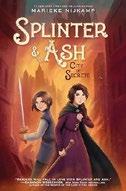
In this second series entry, tweens fight to protect their realm and their queen from a serious threat. As war rages, a conspiracy led by Calinoran nobility seeks to remove Calinor’s queen by any means necessary. The Larks, self-styled patriots, recently kidnapped Princess Adelisa, who goes by Ash and has a disability that requires her to use braces and a cane. Now the Larks have deadly plans for the city of Haven’s harvest festival—plans that Ash and her gender-nonconforming squire, Splinter, attempt to uncover through illicit nighttime visits to Haven and other avenues. Investigating the conspiracy exacerbates Ash’s struggles with a family secret that makes her question who she is, Calinor’s class system, and the responsibility of royalty like her to the people. Splinter is concerned about upcoming squire exams, keeping Ash safe in Haven, and exploring gender
identity. Both 12-year-olds worry about whom they can trust. Ash’s growing discomfort with a class system that devalues and disregards commoners and soldiers shapes this socially aware fantasy, whose action picks up in the second half of the story. The characters are layered and sympathetic, and their evolution is believable, although Ash’s arc feels more developed than Splinter’s. While physical and sensory details bring scenes to life, some worldbuilding remains lightly developed. Readers must be familiar with the earlier volume to understand the many references to people and incidents from the first book. Most characters are cued white. Themes of identity, responsibility, loyalty, and privilege thread this thoughtful, character-driven fantasy. (map) (Fantasy. 10-13)
Nuto, Blake | Jolly Fish Press (32 pp.) | $19.99 November 18, 2025 | 9781631639876

A child navigates the wilderness of boyhood. In this poetic meditation on masculinity, an unnamed boy, who has medium-brown skin, along with his lighter-skinned, dark-haired father figure, wind their way past the ocean, through the woods, and up a mountain. The beautiful illustrations combine rough brush strokes and cute, simplistic faces with expertly captured light, color, and emotions. Meanwhile, the narrator, who may or may not be the boy depicted, uses natural similes to describe what is typically expected of boys—ferocity, strength, drive, violence, surety—as well as the softer, gentler things in life from which the narrator has learned to draw real power. The text does not inherently imply that those traditional masculine traits are always bad; after all, oceans, thunder, and mountains are just as much a part of nature as butterflies and flowers. Yet it expands the horizons of what it means to be powerful, including such things as patience, healing, and saying “sorry.” The first few sets of traits are
more loosely connected, with the juxtaposition crystalizing as the book goes on, but overall the story reads smoothly, making its point succinctly and artfully. This is a great book to include in a child’s picture-book rotation, especially a young boy’s, and perhaps a jumping-off point for discussing the messages about masculinity that he may be receiving elsewhere. An affirming inoculation against toxic masculinity. (Picture book. 4-8)
Oso, Maisha | Illus. by Tom Knight McElderry (32 pp.) | $10.99 | January 20, 2026 9781665980104 | Series: It’s Almost Time For…
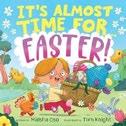
Family traditions lead up to a cheery Easter celebration. A young tot with light skin, pigtails, and round pink glasses gets ready as the holiday approaches. First it’s time to hardboil the eggs: “Go super slow, or else… oh no! / Watch out before they crack!” Then the youngster dyes and decorates the eggs before joining a group of other kids in an egg hunt. The protagonist also ices a bunny-themed cake and, with several others, marvels at a basket of treats. (Tiny bunny paw prints on the surrounding ground hint at the mysterious benefactor’s identity.) Then it’s time to don fancy frocks and gather for a feast—wait, are we celebrating Thanksgiving?! An out-of-place turkey, who, along with the various bunnies, has been involved in the preparations, pops up, surrounded by gourds. “Nooooo…” But that just may be Oso and Knight’s next collaboration. Readers will appreciate the absurdity and will happily shout out the right answer: “It’s almost time for… Easter!” The staccato rhyme bounces the narrative forward in quick bunny hops (“It’s time to find a fancy outfit! / Dress your very best. / Select your clothes. Now strike a pose. / Fantastic! I’m impressed!”), with springtime
pastels highlighting butterflies, flowers, and, of course, rabbits. Diverse family friends round out the mealtime gathering.
A silly holiday romp in celebration of togetherness. (Picture book. 3-6)
Paige, Tabitha | Paige Tate & Co (32 pp.)
$11.99 | October 7, 2025 | 9781963183542
Series: Tabitha Paige Children’s Book
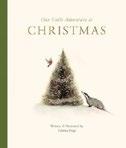
A woodland resident learns that things aren’t nearly as important as loved ones. Badger lives in a den deep in the forest. Though it’s winter, he’s not sleeping: He’s obsessed with an evergreen he planted, decorating it with “rare baubles and trinkets” in anticipation of Yuletide. But when a storm strips the tree, “Christmas is ruined beyond repair. / Why did this happen? It just isn’t fair.” Red Bird calls to the other forest animals to cheer Badger up, and they all bring their own treasures to Badger’s tree, which is transformed along with Badger’s mood. “Badger was grateful. He’d learned a good lesson: / friends matter more than earthly possessions.” The stilted rhyming text is marked by unrealistically stiff speech. Badger’s change of heart and sudden understanding of the book’s undisguised lesson happen too quickly to be quite believable or satisfying. Paige’s watercolors are softly realistic, especially in the depictions of the animals. But in a world rife with dynamic holiday tales, this tale just doesn’t measure up. A visual list of vocabulary in the
back (squirrel , deer, bag , berries , stones) allows readers to match the words to the pages in the book where they appear, though difficult words in the text go undefined. Backmatter includes five learning activities. Sweetly earnest but lacking in kid appeal. (Board book. 3-7)
Pilutti, Deb | Putnam (32 pp.) | $18.99 January 6, 2026 | 9780593860137
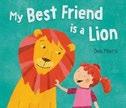
Surely a pet lion will solve a child’s friendship woes. Making chalk creations on the sidewalk, the story’s narrator—depicted with pale skin, rosy cheeks, and curly orange hair in pigtails—imagines having a pet lion and going on a walk, gaining a racially diverse parade of followers along the way, including Maisie and Violet, who have “decided that best friends should be in twos, not threes.” The protagonist fantasizes about scoring the winning point in a basketball game, getting free ice cream and bakery samples (which “the lion would insist we share”), and traffic stopping so the whole parade could accompany the youngster and lion back home. While drawing these dreams, other children, including Maisie and Violet, ask to join, and the child concludes that “best friends can come in lots of numbers.” This simple, imaginative tale softly showcases friendship exclusion and working through one’s feelings with creativity within the framework of an appealing story about a pet lion. Humor comes through the bright illustrations, particularly when the text doesn’t match up: The ice cream man who “really likes lions” is shown
A silly holiday romp in celebration of togetherness.
grimacing and quivering as he hands over the cone. The happy ending will comfort young readers, although since the best friends change their tune of their own accord, this story is more about navigating one’s internal emotions than working through a problem with friends. A gentle, amiable friendship tale. (Picture book. 4-7)
Powell-Tuck, Maudie | Illus. by Duncan Beedie | Tiger Tales (32 pp.) | $18.99 February 10, 2026 | 9781664300798

A hamster with no self-control finds other outlets for his energies. Cute but feckless Doug has never met the button he won’t push, the cord he won’t pull, or the canned goods display pyramid he won’t send crashing down. Compelled to eat every doughnut in the many boxes before him and to yodel in avalanche territory, he suffers the consequences—as do the hapless mountain climbers nearby. A helmeted insect (perhaps a bee or a hornet) wearing safety glasses tries to help when Doug expresses interest in raiding a beehive, but Doug charges ahead and gets stung. After he presses the lever on a reclining chair—and is flattened like a pancake between the halves—his insect friend takes him skydiving, then wakeboarding, and finally on a roller coaster. Doug realizes that there are other ways to get thrills, and he seems able to control his impulses. His friends congratulate him: “Nothing can tempt you now.” But as we see Doug holding a stick near a sleeping bear, they add, “CAN it?” Beedie’s art pairs flat or stylized backgrounds with close-ups of furry, cuddly Doug, keeping the focus sharp. Readers will enjoy repeatedly echoing the title admonition and will gleefully note that instant karma
A hamster with no self-control finds other outlets for his energies.
DON’T DO IT, DOUG!
falls on the little rodent when he doesn’t listen.
Grand fun that allows young readers to feel in control. (Picture book. 3-7)
Rhodes, Jewell Parker | Illus. by Setor Fiadzigbey | Colors by Abigail Paradis Little, Brown Ink (264 pp.) | $13.99 paper December 2, 2025 | 9780316279673
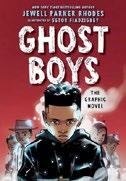
In this graphic adaptation of Rhodes’ awardwinning 2018 novel, the spirit of a 12-year-old, who was killed by a white police officer while playing outside, is tethered to that of other murdered Black boys. Jerome Rogers’ parents work long hours, and his grandmother takes care of the house. He’s a loving child who follows the grown-ups’ admonitions as he walks to school with his sister through their perilous Chicago neighborhood. Being a good student makes Jerome a target for bullies, and he befriends new student Carlos, who’s also a target. Carlos offers Jerome a toy gun to defend himself from his persecutors, a spontaneous gesture that has tragic consequences. Now a spirit who can only be seen by Sarah, the daughter of his killer, Jerome witnesses his family’s agony while attempting to process his own grief and stolen dreams. The ghost of Emmett Till appears, showing Jerome his own story and telling him to “bear witness,” but Sarah, who struggles with the fallout from her father’s actions, doesn’t know how to
help. Fiadzigbey’s panels are interestingly varied: On the opening page, readers look down from above as the cop stands over Jerome’s small, dead body, unaware that Jerome’s spirit is looking on, too. Paradis effectively uses colors to deepen the emotional impact of the text. Readers will emerge with a more nuanced view of the impact of generations of racism and the ways our actions affect our social systems.
A layered exploration of grief. (Graphic fiction. 10-14)
Roberts, Akeem S. | Kokila (128 pp.)
$19.99 | July 15, 2025 | 9780593856666
Series: Class Pet Ghost Detective, 1
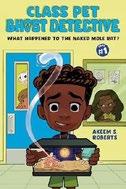
Carter’s class pet is dead, and he must figure out who’s to blame— with help from the ghost of the deceased creature. This past weekend, Carter was watching the dearly departed animal, a naked mole rat named Mr. Pebbles. Unfortunately, he paid more attention to his video games than the little critter. Now he’s a suspect and is all the more anxious to clear his conscience. Let the funny, furless school-wide sleuthfest begin! Through the magic of a pendant that belonged to his grandmother, Carter soon acquires a partner in the form of the rodent’s floating spirit. For a creature often described as the world’s ugliest animal, Mr. Pebbles is pretty cute, broadcasting big
emotions with wide eyes, boldly cartoonish eyebrows, and tremendous teeth, and he slowly divulges the memories necessary to puzzle out the cause of his passing while hovering over Carter’s shoulder as he questions his classmates. Pet death is treated lightly here, but the various experiences and personalities of Carter and his elementary school classmates are observed with affection and relatability. Energetic cartooning offers multiple angles on each scene and always keeps the story moving at a steady clip. Carter and his family are Black, and his peers and teachers are racially diverse. Final art not seen.
A lighthearted mystery with great fondness for its characters, be they alive or dead. (Graphic fiction. 7-10)
Román, José Carlos | Illus. by Silvia Álvarez | Trans. by Jon Brokenbrow Cuento de Luz (28 pp.) | $19.95 October 17, 2025 | 9788410438118
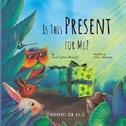
A crew of creatures try to identify a package’s recipient. Scuttlebutt abounds as the mysterious box arrives at the local post office. One by one, anthropomorphized animal denizens curiously enter to see if they’re the recipient. Postal worker Fox replies to each with a poem stating that they are not the intended owner. The animals band together to follow the mail carrier to the home of Little Shrew, where they find that the contents of the package are really gifts for them. Feeling embarrassed
about their over-the-top reactions, they band together to give Little Shrew a gift and show their appreciation in their own way. Bathed in light amid a palette of warm earth tones, Álvarez’s exquisite textured art creates an idyllic world that showcases the quaint, folkloric nature of this community. Unfortunately, the story falls flat. Translated from Spanish, the text is stilted in spots and repetitive, giving the narrative a sluggish pace. While the community members try to convey selflessness as a result of their self-reflection with their gift to Little Shrew at the end (a handheld mirror), the result is murky, advocating both selflessness and thinking about yourself, leaving readers with a muddled resolution. A jumbled look at the importance of thinking about others, elevated by exquisite visuals. (Picture book. 5-8)
Russell, Ally | Scholastic Paperbacks (224 pp.) | $8.99 paper | December 2, 2025 9781546129257
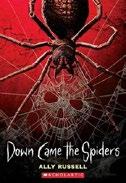
Creepy-crawlies take over a Halloween party. Halloween is Andi’s favorite holiday—to her, it’s “serious business,” and she loves spiders almost as much as she loves her best friends, Carly and Devon. But now that they’re sixth graders, her friends are more interested in attending eighth grader Clementine’s party than going trick-or-treating as usual. Andi reluctantly agrees, lured by the
A well-spun tale that combines suspense with relatable emotional themes.
promise of seeing the office of Mr. Mendez, Clementine’s science teacher dad, which is filled with spiders in terrariums. Andi recognizes the species in his collection— until she comes face to face with a spider that’s as big as a person’s head. Strangely, the more she looks into its red eyes, the more she wants to remove the lid and set it free. The party continues, but soon spiders start appearing out of every nook and cranny, all heading in the same direction. Andi and her friends follow them, discovering a giant funnel web where the adults are trapped. Andi suddenly fears spiders for the first time: Can she stop them before it’s too late? Russell’s sophomore novel balances slow-building creepiness with a genuine affection for arachnids and incorporates occasional scientific facts. The evocative descriptions of spiders and their webs make for some truly chilling scenes, and the explorations of loneliness and tween difficulties with making friends add human elements to the terror. Andi is Black, and there’s racial diversity among the secondary characters. A well-spun tale that combines suspense with relatable emotional themes. (author’s note) (Horror. 9-12)
Savage, J. Scott | Illus. by Brandon Dorman Penguin Workshop (272 pp.) | $14.99
October 28, 2025 | 9780593662335
Series: Quantum Interstellar Sports League, 2
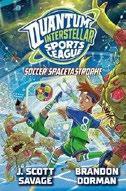
Following the events of Quantum Interstellar Sports League (2024), a motley group of young athletes reunite to defend Earth once more from an alien takeover.
Unexpectedly forced into a do-over thanks to an ambiguity in their contract over the exact meaning of football , the Planet Earth Defenders again face a succession of alien
adversaries, with the ownership of Earth itself hanging in the balance. Winning looks hard enough, considering that only one Defender even plays the game well—worse, nearly every team the squad faces is composed of bigger, nastier opponents. In Dorman’s lavishly detailed on-field scenes, their adversaries appear with ferocious scowls as well as natural advantages, like multiple feet. And, just to make the odds longer, the Defenders must contend with a saboteur as well as a fresh spate of internal frictions and conflicts. Both the prose and the pictures have enough sports content to keep soccer-oriented readers turning the pages, but the Defenders win their matches rather too easily, considering the obstacles. While reforging themselves into a smoothly functioning “chain” behind narrator Wyatt, a white-presenting boy who’s their least athletic but most strategically minded member, the ethnically diverse Defenders wind up devoting most of their energies to resolving personal and interpersonal issues. A relationship- and teamworkcentered story livened with some soccer action. (Science fiction. 8-12)
Smith, Brady | Penguin Workshop (208 pp.)
$23.99 | April 1, 2025 | 9780593751183
Series: Maxwell Dark, 1
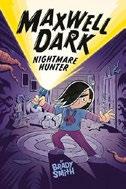
A mysterious young orphan tries to help other kids fight their nightmares. With his sideswept bangs and skulladorned tee over a stripey longsleeved shirt, sullen, sulky Maxwell looks like a typical early-aughts emo-goth kid. But he’s burdened with a gift that feels more like a curse. He can see the remnants of children’s nightmares floating above their heads—personifications of school scaries, toilet terrors, and the
occasional toothy dragon. Maxwell is particularly drawn to a young girl named Sid, who’s terrorized nightly by monsters with copious claws, endless eyeballs, and overabundant heads. Hesitantly, she allows Maxwell to enter her dreams with her as he directs her toward the subconscious roots of her fear. Complications arise as the pair learn that Sid’s dreams have been commandeered by a strange being. Smith sensitively explores Maxwell’s own enigmatic origins—his work is driven by the disappearance of his sister, seemingly into her nightmares, during their childhood in an orphanage. The real star, though, is the visual frenzy of sea monsters, enormous bugs, and a phenomenally fierce final boss. Smith’s zany drawings aren’t truly terrifying, making this a solid pick for younger fright fans, but softhearted readers should stay clear. Indeed, the book’s gleeful inventiveness may inspire young creatives to bring their own wildest dreams to the page. Maxwell is tan-skinned; Sid is slightly darker. An artistic riot of monsters establishes a unique universe in this spooky series starter. (Graphic paranormal. 8-12)
Standish, Ali | Harper/HarperCollins (304 pp.) | $19.99 | November 4, 2025 9780063275676 | Series: The Improbable Tales of Baskerville Hall, 3
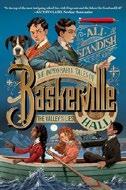
A young detective and his schoolmates embark on a fateful field trip in this trilogy closer. Arthur Conan Doyle’s first year at Baskerville Hall has been immensely eventful, and a class trip to England’s Lake District will soon prove to be no exception. Challenges crop up even before the journey begins. Arthur receives a letter from Professor Dinah
Grey, a conniving former teacher who recently regenerated herself as a young girl by using a mystical immortality machine. The note reveals that she’s staying at the Doyles’ Edinburgh home, and she has Arthur’s sister Mary in her clutches. Grey threatens Arthur, telling him that Professor Sherlock Holmes will be accompanying him on an expedition, and Arthur must get Holmes to accept a case that he’s offered. Arthur’s sister’s life will be in peril if he fails to “be the victor” at the end of Holmes’ mission. Arriving in the breathtakingly beautiful countryside, Arthur compiles clues that point him to a circle of stones concealing a series of trap-riddled underground tunnels and an imposing ancient relic that lets its user see the future. The story’s driving tension—that Arthur leads his friends into grave danger dishonestly, a morally murky move in service to his personal motives—adds an intriguing new layer to the young detective’s developing psyche.
A satisfying conclusion: a moody mystery with new layers that keep its concept fresh. (information about Arthur Conan Doyle) (Mystery. 9-14)
Stansbie, Stephanie | Illus. by Wendy J. Warren | Tiger Tales (32 pp.) | $18.99 October 7, 2025 | 9781664300767
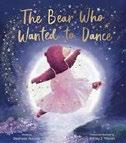
A bear hopes to become prima ballerina. Rita has always loved ballet. The young bear joins the intimidating Monsieur le Fox’s ballet class and meets a new friend, Wanda; they spend their days dreaming about a life in dance. When Monsieur le Fox announces his plan to host auditions for the class’s prima ballerina spot, Rita and Wanda practice dancing and read ballet magazines to prepare. Looking at the ballerinas in the magazines, as well as those in the posters on the walls, Rita
THE SNOWMAN CODE
comes to a realization: “These ballerinas don’t look anything like me!” Indeed, they are all lithe creatures like weasels, foxes, frogs, and rabbits. The simple story’s resolution relies on Wanda and Monsieur le Fox encouraging Rita rather than Rita independently coming to embrace “my beautiful, big-bear body.” For this reason, caregivers and educators may consider pairing this tale with Vashti Harrison’s Big (2023), which shares similar themes but features the protagonist as her own savior. The full-color illustrations are soft and inviting, with the bulk of the story taking place in a cozy forest rife with mushrooms, coniferous trees, and logs on which the ballerinas practice balancing. The endpapers show Rita in a variety of ballet poses, perhaps encouraging future dancers to begin their practice.
A classic ballet story infused with themes of body positivity and the importance of seeing oneself reflected in art. (Picture book. 3-7)
Stephenson, Simon | Illus. by Reggie Brown
Simon & Schuster (256 pp.) | $17.99
December 16, 2025 | 9781665985345
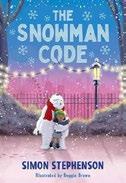
Ten-and-a-halfyear-old Blessing is experiencing the longest winter London has seen in centuries. It’s March, but the heavy snow shows no signs of melting. Even worse, winter sometimes makes her mom so sad that Blessing has to stay
with other families while she recovers in the hospital. Blessing has been skipping school to avoid her bullies, and one afternoon, while she’s hiding in Victoria Park, she meets an eccentric 627-year-old talking snowman named Albert Framlington. The new friends set out to fix “the broken weather,” so that spring can return to England and Albert and the other snowmen can follow their natural cycle of melting and reappearing in a wintry part of the world. This heartwarming and hopeful story moves at a brisk pace as Blessing and Albert race to complete their mission. Stephenson gently and honestly explores bullying, foster care, and seasonal affective disorder (the latter two aren’t explicitly named as such in the text) through the eyes of a child in accessible language that is ideal for readers who are gaining confidence in reading longer novels. Blessing works to stop the bullying and support her mother. In a nuanced depiction of foster care, her placement family is kind but no substitute for home. Brown’s charming spot illustrations show Blessing as a Black girl and Albert as stout, with angular stick eyebrows, bottle cap eyes, a potato nose, three jaunty leaves for hair, and a tattered scarf.
A whimsical, enchanting adventure grounded in friendship and resilience. (notes to readers) (Fiction. 8-12)

Stevenson, Robin | Illus. by Allison Steinfeld | Quirk Books (240 pp.) | $14.99
November 11, 2025 | 9781683693932
Series: Kid Legends, 10
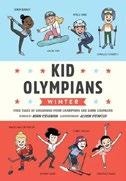
Inspirational profiles of 18 Winter Olympics and Paralympics standouts.
As in her 2024 companion volume about Summer Olympians, Stevenson recaps the various athletes’ discoveries of their chosen winter sports and their rise to local, national, and then international championships. Her chief focus is on the obstacles each person faced and overcame along the way, such as home schooling and other accommodations necessitated by intense training regimens, as well as expensive coaching and competition travel. Some coped with physical issues: Japanese American figure skater Kristi Yamaguchi was born with clubfoot, and bone cancer left Canadian multisport Paralympian Cindy Ouellet with severe nerve damage in her legs. Other athletes dealt with racism and homophobia (after a triumph on the slopes, Korean American snowboarder Chloe Kim was told to “go back to China”), bullying (Ouellet recalls that upon her return to school after chemotherapy, “people were even kicking my crutches”), and debilitating bouts of anxiety and self-doubt. Their ultimate triumphs are clearly well earned. Stevenson also describes the hopes many have for influencing others; French figure skater Surya Bonaly, a transracial adoptee whose birth mother came from Réunion, hoped to change perceptions that “winter sports were just for white people.” In interspersed segments, the author addresses discriminatory attitudes toward transgender athletes, the challenges faced by
those from tropical countries who wish to train for winter sports, and other topics. Steinfeld’s bright spot images of the determined achievers enhance the text.
Inclusive and appealing. (bibliography, index) (Nonfiction. 9-12)
Stower, Adam | Random House (192 pp.)
$16.99 | January 20, 2026 | 9798217031047
Series: Murray and Bun!, 3
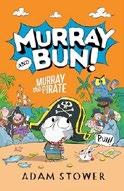
Sail the seven seas with a hero who would really rather just nap.
Our perpetually reluctant feline adventurer returns— after 2025’s Murray the Viking and Murray the Knight —for another tale of derringdo. This time a slip through his magical cat door plunges Murray and his perky companion Bun (a cheery dessert-bunturned-rabbit, complete with a cherry tail) into a seaside town. Now dressed in full pirate gear, Murray is at first delighted when the citizens start to give him things without prompting. Unfortunately, his polite acceptance draws the attention of Captain Patch and his dastardly crew. Pirates don’t say thank you—such behavior goes against the pirate code! The pirates kidnap Murray and Bun, but soon it’s clear that this crew would much rather fish or open flower shops than terrorize the seven seas. While attempting to find hidden gold to finance a floral business, Patch and company run into a terrifying monster; now it’s up to Murray to (eventually) save the day! Though Murray’s ever the gentleman, his natural disinclination to engage in adventure inevitably allows him to indulge in some mundane delights. Stower milks maximum humor out of the book’s page turns and lengthy sequences yet keeps the mood lighthearted. Human characters range in skin tone. Avast, ye scurvy dogs (and cats!), set sail for a rollicking adventure from the politest pirate around! (Chapter book. 6-9)
Takac, Mag | Union Square Kids (40 pp.)
$18.99 | November 4, 2025 | 9781454954019
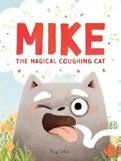
A street cat’s quest for a home takes an unexpectedly hilarious turn. Mike, a fluffy gray stray, has been searching for the perfect family. Older companions Annabell and Rose seem ideal, with their friendly faces, generous supply of tuna cans, and “hands just right for belly scratches.” But when the pair argue over who will take responsibility for Mike (“I can’t look after a cat! I already have a parrot.” “No, you don’t!”), Rose makes a wish for a parrot (“Then you’d have to take care of this darn cat”), and Mike suddenly coughs up a bright yellow bird. More wishes ensue…but Mike worries: What if his wishes go wrong? Takac’s friendly artwork employs sweet, rounded, soft shapes that create warmth and comfort, while dynamic diagonal compositions during the transformation scenes generate energy and movement. The illustrations reward multiple readings with delightful background details and visual jokes. Mixed text formats— traditional narrative combined with comics-style speech bubbles—create an engaging reading experience that bridges the picture-book and early graphic novel formats. Takac cleverly puts a fresh spin on the typical “pet needs a home” narrative by exploring what happens when wishes go awry, leading to wonderfully absurd situations and offering silly visual gags for young readers while providing more sophisticated humor for older ones.
Rose is brown-skinned, while Annabell is pale-skinned.
A fresh, funny twist on found family that celebrates love, acceptance, and the magic of getting exactly what you wish for. (Picture book. 4-8)
Taylor, Sarah Todd | Nosy Crow (224 pp.)
$17.99 | September 16, 2025 | 9798887771892
Series: Alice Éclair, Spy Extraordinaire, 2
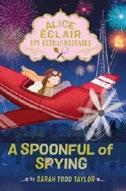
Young French pâtissière and spy Alice Éclair returns to help foil a plot at the 1937 Paris World Fair. Alice hasn’t heard from her traitorous Uncle Robert since the events aboard the Sapphire Express in the series opener, but she’s joined a spy network—and with the upcoming World Fair crawling with threats, she’ll have her work cut out for her. Once again, Alice must split her time between her pastry chef and spy duties. Her mother’s shop, Vive Comme L’Éclair, has a stall in the fair’s Tastes of the World pavilion, and when she’s not there, she’s working with fellow spy Claude. At the fashion pavilion, Alice befriends Eva Castle, a French and English model, and at the aviation pavilion, she meets precocious engineer Sophie Alain, a French girl who’s slightly older than she is. Both connections turn out to be critical to her mission. Although the stakes are high, Alice and her friends never seem to truly be in real danger—at least not for
Celebrates love, acceptance, and the magic of getting what you wish for.
MIKE THE MAGICAL COUGHING CAT
long—making this ideal for those seeking gentler thrills. Alice trusts her gut, and Claude has faith in her, too. Casper, a neighborhood cat, stows away, joining Alice at the fair and accompanying her as she gets into scrapes. Fans of the series opener will enjoy this new outing, but this entry can stand alone as well. A light historical adventure with bright young heroes. (author’s note, glossary) (Historical adventure. 9-13)
Thomas, Mindy & Guy Raz | Illus. by Mike Centeno | Storytide/HarperCollins (208 pp.) | $19.99 | October 28, 2025 9780358697084 | Series: Wow in the World
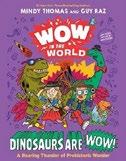
A peppy pair of podcasters take readers back in time for prehistoric treats, ranging from exciting dino smackdowns to an interview with an argumentative chicken. Constant and voluble presences themselves in the cartoon illustrations, the charismatic couple squire young fans past a dazzling array of dinosaurs and dino-adjacent creatures from pterosaurs to giant sharks while strewing the quick-turn pages with (sometimes literally) mind-blowing facts. Beginning 4.5 billion years ago with our planet’s birth, the tour moves through successive zones of “Paleozoic Park,” past the “Big Kaboom” of the Permian Extinction, to a “family reunion” of early humans and
prehumans. Once the big picture has been laid out, it’s on to discussions of fossils from footprints to feces, and then to a flood of mini-features including galleries of dino eggs, modern fossils that sold for eye-watering sums, dinosaurs with goofy names like Dracorex hogwartsia, and such particularly toothy prehistoric predators as Spinosaurus (which “swims with the sharks and eats them too”). A final posting of “Dino-Jobs” offers career alternatives to paleontology for dinosaur lovers, while the backmatter features not only recommended reading, a large glossary, and comprehensive source notes for all the factual content, but also two pages of QR codes leading to relevant podcast episodes. Full-throttle fun, with a solid foundation of fact. (index, photo credits) (Nonfiction. 6-10)
Thompkins-Bigelow, Jamilah | Illus. by Raissa Figueroa | Random House Studio (40 pp.) $18.99 | October 14, 2025 | 9780593705414

A middle sibling describes the joys— and occasional challenges— of outdoor adventures.
Sanaa, the trio’s eldest, intrepidly guides her younger siblings through meadows and woods, over a lily pond, and onto the tall branches of a tree. Haala, who narrates, wants nothing more than to bask in Sanaa’s exuberantly glowing energy, but younger sister Munira “always interrupts and makes me miss what Sanaa’s doing.” Munira blocks the sun, lags behind the others, and bumps into Haala. Haala’s frustrations spill over, and the
A vivid celebration of the extraordinary power of sisterhood.
protagonist’s frown makes Munira’s grin vanish. But Sanaa is more forgiving; her giggles “make a person feel good,” regardless of mistakes. Halaa soon learns to offer some shine, too, when Munira most needs a boost. Recognizing the power of kindness, Haala realizes that “we don’t need magic wands. Maybe we just need us.” Award-winning author ThompkinsBigelow, recognized for creating books centering Black and Muslim characters, finds exquisite synergy with Figueroa’s warm, welcoming art, which favors vibrantly golden and saturated chartreuse hues. Her engaging spreads invite audiences to dance with the dandelions, sway and spin to create a swish-swishing song, listen for goldfish secrets, scale new heights, and even part the very clouds to call back the sunshine. All three characters are brown-skinned. A vivid celebration of the extraordinary power of sisterhood. (Picture book. 4-8)
Thompson, Ruby Amy | Tiger Tales (32 pp.) $18.99 | January 6, 2026 | 9781664300927
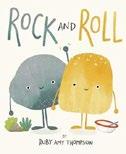
Two wildly different pals nevertheless get on swimmingly.
Squat gray Rock is described not as hard, but as “strong,” while golden bread Roll is “soft” and yielding when squeezed by a brown hand. They differ in multiple ways—introvert vs. extrovert; happy in water vs. happy in air; volcanic vs. floury in origin—but the narrator points out qualities they share. They are both “team players.” Rock looks “fabulous in green,” and so does Roll (let’s not think too much about the source of those spreading green blotches). Both are “calm under pressure”; Rock is unmoved while a boot steps on it, while Roll looks cheerful in a hot oven. Getting dressed up means painted designs on Rock and icing decorations on Roll, but they both love their looks. And they can
switch roles: Rock has emotions, and Roll can be a source of strength. Finally, Rock rolls, twirling on floral skates, while Roll rocks out, vigorously beating wooden spoons on an improvised pot-and-bowl drum kit. The illustrations are minimalist but clear: Rock and Roll stand out against plain backgrounds that focus on them. Touches of humor, like Roll’s tiny tongue reaching for some gooey topping and Rock’s “swim” (sinking to the sea bottom), will appeal to the target audience. The language, too, is simple enough for early readers, with contrasting words in bold. Friendship goes deeper than surface similarities in this rock-solid tale of companions bonding. (Picture book. 3-6)
Vargas, Rodrigo | Illus. by Coni Yovaniniz Storytide/HarperCollins (224 pp.) | $24.99 October 14, 2025 | 9780358394068
Series: The Do-Over, 2
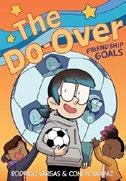
Between friends, classes, soccer, and founding a new after-school club, Frost Middle School student Zoe starts to feel the pressure of biting off more than she can chew. After the RV they’ve been using for their natural hair dye salon breaks down, friends Everly, Zoe, and Mariana start the True Colors Style Club at school. The school’s club fair provides an excellent opportunity to recruit members—but it also reminds Zoe of how much she used to enjoy playing soccer. When she tries out for and makes the team, fellow player Gabby pressures Zoe to focus on sports and “take a break from the hair stuff.” Now that Zoe has more responsibilities to juggle, she has to find a way to be there for her old friends, her new teammates, and herself. This sequel delivers with its relatability: The characters, this time with Zoe in the forefront, navigate peer pressure,
A heartfelt story that champions the power of authenticity and self-care.
THE DO-OVER
over-committing, burnout, and trying to please others. Vargas clearly and empathetically explores the unexpected fallout of well-intentioned actions, realistically presenting the nuances of everyday middle school issues like navigating shifting relationships and interests. Yovaniniz’s inviting artwork adds charm through its softly curved lines and buoyant pops of color. Readers will enjoy reuniting with the appealing and diverse cast: Zoe presents white, Gabby reads Black, the first volume established Mariana as Peruvian American, and Gabby has brown skin and wavy black hair.
A heartfelt story that champions the power and necessity of authenticity and self-care. (Graphic fiction. 9-13)
Vaught, Susan | Illus. by Kelly Murphy Beach Lane/Simon & Schuster (40 pp.) $19.99 | January 20, 2026 | 9781665902830
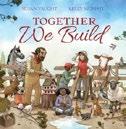
A community comes together to rebuild after extensive storm damage. Pouring rain, rising river waters, and fierce winds cause people and animals alike to seek makeshift shelter in a nearby barn. In the morning, “skies so blue” reveal extensive destruction. “Where to start? / So much to do!” Things get worse when tempers flare between even the closest neighbors: Accusations of “Not mine. That’s yours!” are met with “We quit! We’re done! / Slam all the doors!” Thankfully, rest and communication repair relationships and prove there’s “always, always / room to grow.” The challenges of “finding [and]
hauling” give way to “laughing [and] learning” as more residents assist one another: “Kindness, healing, / hope fulfilled. / Friend and neighbor, / together we build!” Vaught and Murphy have gratifyingly reunited to repeat the success of 2020’s Together We Grow. Murphy’s meticulous illustrations again enhance Vaught’s simple, resonating rhymes. Every spread spotlights the attention and care afforded all manner of animals, from the usual barnyard cows, pigs, and chickens to turtles, raccoons, and even a curious mole. Whether feathered or furry, these creatures are charmingly anthropomorphized, conveying sadness, loyalty, caring, and joy. Murphy realistically depicts exhausted adults initially behaving badly (mirrored by their animals!)—to the clear detriment of their children. Her humans reflect a wide diversity in terms of skin tone, age, and physical ability. The endpapers cleverly capture the transformative power of rebuilding together. A convincing look at the rewards of cooperating and collaborating. (Picture book. 4-8)
Vernick, Audrey | Illus. by Heather Fox Random House Studio (40 pp.) | $18.99 January 27, 2026 | 9780593811283

A child imagines what life would be like if crayons could give things a redo.
The straighthaired narrator, with skin and a dress the color of the white background, applies a blue crayon to paper and begins
compassionately: “No one will be hungry. / And everyone will have a home.” Colorful, cheery, childlike compositions portray a circle of houses from which people emerge, carrying food for al fresco dining at a common table. The descriptions move to the sensory, with buttons to push for favorite smells and sounds. Dogs will be everywhere, and the protagonist imagines their gratitude, particularly for the abundance of tennis balls. Various items will “be a thing”: ice cream shops in treehouses, confetti to reward thoughtfulness. The artist acknowledges the responsibility of the task and considers making “erasable” art, since “ideas grow and change.” Many of the thoughts and parlance mirror a young child’s logic and desires, like walking on rainbows; others, such as accommodating future changes, reflect a more mature perspective. A few don’t quite make sense, such as dangerous animals like sharks having to wear costumes, but children may still smile at the toothy creature with glasses and a mustache. Overall, this is a lighthearted prompt for readers to consider their own worldviews and wishes.
A pleasant exercise in “What if?” (Picture book. 4-8)
Villanueva, Gail D. | Harper/HarperCollins (352 pp.) | $19.99 | October 7, 2025
9780063255418 | Series: Lulu Sinagtala and the Tagalog Gods, 2
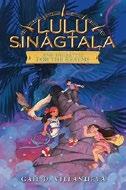
In the second entry of this series set in Metro Manila, Philippines, Lulu Sinagtala, who’s a Salamangkero, or chosen one, must protect the Realms from the ultimate threat: Ulilang Kaluluwa, the primordial serpent god of chaos. Lulu, along with sister Kitty, shapeshifting aswang crush Bart, and tigmamanukan (omen bird) guardian Haribon, is summoned by the sun god,
An entertaining, immersive, and twisty adventure.
LULU SINAGTALA AND THE BATTLE FOR THE REALMS
Apolaki. He describes increased chaos in every Realm, with evil spirits called malignos preferring to possess those who “have malicious intentions and desires.”
Restituto, who’s “the Maligno,” is seeking to unite all three pieces of the Sacred Niyog, the coconut borne by the first coconut tree, which the First Salamangkero helped hide across the Realms. The tree grew above the place where Ulilang Kaluluwa was buried—and whoever controls the Sacred Niyog will be able to access his powers and destroy the balance of the universe. Even worse, Ulilang Kaluluwa may be strong enough to emerge during the spring equinox in two days’ time. Villanueva seamlessly and naturally incorporates Tagalog folklore and vocabulary into the story along with Lulu’s epilepsy, which she matter-of-factly describes as neither a weakness nor a strength but “just part of who I am.” Humor and references to K-pop and P-pop help offset the existential threat. This easy-to-follow entry, which is accessible to new series readers thanks to succinct recaps, contains plenty of intrigue and hints of romance.
An entertaining, immersive, and twisty adventure. (glossary) (Fantasy. 8-12)
Weatherford, Carole Boston | Illus. by Tequitia Andrews | Crown (32 pp.) | $18.99 January 20, 2026 | 9780593805756
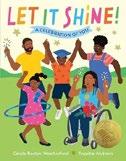
A beloved song gets a jubilant glow-up.
Everyday moments and landmark events spark joyful revelry in a picture book that encourages readers to “find
determination / deep down in your soul” and let their inner light shine. Both instructive (“Give both praise and thanks / before you take your bow”) and ripe with attestations (“You kept pressing on”), the text has a lilting cadence that lends a cheerfulness to the overall tone, though neither words nor images shy away from acknowledging struggle (a reference to “those who overcame” is paired with images of Rosa Parks and an enslaved person working the fields). Rendered in a solid, vibrant palette, Andrews’ flat digital illustrations showcase a fully Black cast of characters who feature a range of brown skin tones, ages, and abilities; several notable African Americans, including Shirley Chisholm and Frederick Douglass, are spotlighted. The refrain of “Let it shine” appears in triplicate on each right-hand page, each time in a distinct and dynamic array amid the surrounding art. As Children’s Literature Legacy and Newbery Honor–winning author Weatherford explains in an appended note, the text is a creative expansion on the lyrics of the American spiritual “This Little Light of Mine.” Intended “to mark milestones and achievements,” the book skews potentially repetitive for a read-aloud but seems destined to thrive as a graduation present. Additional backmatter includes a brief timeline and list of noted artists’ recordings of the song. Celebratory and affirming. (Picture book. 4-8)

For an interview with Carole Boston Weatherford, see Kirkus online.
Wieder, Joy Nelkin | Kar-Ben (32 pp.)
$19.99 | October 7, 2025 | 9798765644249
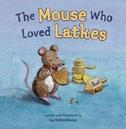
When a family of Jewish cats move into a new apartment, the rodent who inhabits its walls withdraws to his mouse hole.
C.J. is terrified when the aptly named Katzes arrive. “Cats are no friends of mine!” he declares, but soon his rumbling tummy entices him to seek out the tantalizing smells in the kitchen. There, he’s rewarded with some delicious jelly doughnut crumbs. But what’s that oddlooking object covered in letters? And those gold-wrapped treats? Following a close encounter with Kitty Katz—the youngest member of the family—C.J. beats a fast retreat. Kitty seems friendly, but what if these cats want to make a meal out of him? Still, he’s intrigued, especially when he sees the Katzes playing with the items he noticed earlier—a dreidel and gelt. But could that odd object in Mr. Katz’s paws be a mousetrap?! No—just a menorah. Kitty’s gentle offer of friendship, an invitation to help make and eat delicious latkes, and an opportunity to light the menorah all help C.J. feel more comfortable with the Katzes. And, as it turns out, they can’t eat him—mice aren’t kosher! Readers unfamiliar with Hanukkah will learn about the holiday alongside C.J., while those who are familiar with it will recognize beloved customs. Wieder’s lively text captures C.J.’s hopes and fears, accompanied by expressive illustrations that use varied perspectives to good effect. Kindness abounds in this holiday tale of unexpected friendship. (latke recipe, dreidel directions, glossary) (Picture book. 3-6)
Willan, Alex | Simon & Schuster (40 pp.)
$19.99 | December 23, 2025
9781665962612 | Series: The Worst!

A put-upon goblin learns to feel the love. Gilbert, a bald, mint-green goblin, is far too busy for Valentine’s Day. From bird-watching to goat yoga, his schedule is full. Besides, “Valentine’s Day is all about love and flowers and all that other mushy malarkey”—Gilbert doesn’t need it! He isn’t interested in those heart-shaped boxes of candy with their gross coconut surprises, and he’s not a fan of the so-called stars of Valentine’s Day: cupids with their gorgeous hair and love arrows. But the cupid squad doesn’t give up on Gilbert and sends him zigging and zagging to avoid their arrows. Believing he’s been hit (in fact he unwittingly backed up into a cactus), Gilbert finds himself falling in love with love and eagerly accepting his friends’ valentines. Humor certain to please readers young and old is woven throughout Gilbert’s sassy narration and the candy-colored illustrations, which trace the goblin’s metamorphosis from sourpuss to lovebug. The reasons for Gilbert’s true change of heart—and why he was so loath to celebrate to begin with—are left unspoken, but readers may enjoy coming up with their own ideas. Front endpapers featuring candy hearts festooned with “meh” and “nope” capture the anti-Valentine vibe, while supportive cards from
A Valentine’s tale that even the grumpiest readers won’t be able to resist.
WORST!
Gilbert’s friends can be found on the back endpapers. A Valentine’s tale that even the grumpiest readers won’t be able to resist. (Picture book. 4-8)
Wind, Lee | Illus. by Karl West Apples & Honey Press (32 pp.) | $19.95 November 4, 2025 | 9781681156811

When a family forgets their menorah at home, a child’s alternatives inspire a new family tradition. Daddy, Papa, and their child take a beach vacation over Hanukkah. Narrating in the first person, the little one describes feeling far from the comforting familiarity of home. Just before sunset, the parents realize that they’ve packed the candles but not the menorah. That’s when the child has an idea: to stick the candles into a banana. Voilà—banana menorah! By the next night, the banana has started to rot and needs to be replaced with something else (a bowl of granola). The pattern continues until the family goes home midway through the holiday. Returning to familiar routines feels good, but the child soon misses the fun of inventing new menorahs. The family decides to embrace both tradition and creativity, keeping their well-loved menorahs while also making new ones. The exposition in the initial pages is a bit heavy-handed, but the book hits its stride when the new menorah ideas begin to flow. Each new menorah is unveiled on its own full spread, creating strong comedic timing that builds anticipation for the next wacky idea. In case kids aren’t already bursting with a desire to try out their own ideas, backmatter provides prompts and safety tips. A concluding note briefly explains the holiday and reveals that the story was inspired by the author’s real-life experience. Daddy and the child are tan-skinned; Papa is pale-skinned. A Hanukkah tale sure to ignite kids’ creativity. (Picture book. 4-8)

THESE DAYS, TEENAGE armchair sleuths have it good. When I was in high school, my friends and I shared well-loved mysteries (Dorothy L. Sayers and Reginald Hill were particularly beloved). They remain favorites, but I’m jealous that we didn’t have the array of mysteries and thrillers written with teens in mind that are available now. Like their adult counterparts, these books insightfully explore the inner psyches of their characters: What would make seemingly ordinary people turn to crime? How do you know whom you can really trust? Against a backdrop of everyday concerns, like shifting friendships, homework assignments, dorm life, and school dances, characters grapple with manipulation,
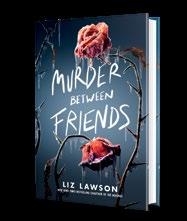
deception, and even murder. Two hallmarks of the genre—a strong sense of place and a distinctive voice—are evident in the following must-reads.
The murder of high school teacher Ms. Appelbaum tore apart the close-knit trio of Grace, Ally, and Henry in Liz Lawson’s whiplash-inducing, twist-filled Murder Between Friends (Delacorte, April 22). Now Grace is rethinking the testimony she gave that helped convict Henry’s brother, Jake, who’s facing a retrial. But if it wasn’t Jake that Grace saw in Ms. Appelbaum’s backyard that fateful night, who was it?
And can she persuade a hostile Ally and Henry to investigate with her?
Lauren Muñoz’s Very Dangerous Things (Putnam, July 29) is a nail-biter
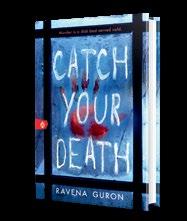
centered around every crime enthusiast’s dream school project: J. Everett High’s Grand Game, in which criminology students investigate the “murder” of one of their own. Only this year, Xavier Torres, the student chosen to be the victim, actually winds up killed. Fortunately, besties Dulce Castillo and Emi Nakamura are on the case—helped by the dishy new boy (whom they both like, complicating matters).
The immersive atmosphere of Catch Your Death by Ravena Guron (Sourcebooks Fire, September 2) evokes Golden Age mysteries. A snowstorm strands three teen girls in an English country house with a strange, hostile family. Devi got lost while heading to her grandmother’s, Lizzie was making a delivery, and Jayne works part-time at the mansion. Overnight their hostess is murdered—and the culprit must be one of the people trapped there. The girls’

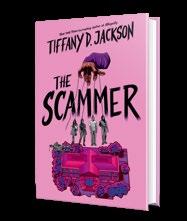
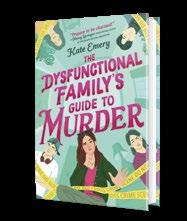
alternating narrations are distinct and compelling.
The latest from award winner Tiffany D. Jackson, The Scammer (Quill Tree Books/HarperCollins, October 7), is a taut, psychologically astute story set at a fictional historically Black university. Jordyn Monroe, who’s seeking community, is thrilled to meet her three suitemates, and the girls bond immediately. But when one of them invites her charismatic older brother, who was recently released from prison, to stay with them, their dynamics become warped and dangerous. Devonte exerts undue influence, and events quickly spiral out of control.
The Dysfunctional Family’s Guide to Murder (Knopf, October 21) marks the North American debut of Australian author Kate Emery. This work, hilariously narrated by 14-year-old Ruth, is ideal for middle school readers—and anyone else who appreciates witty commentary and an eccentric cast. When GG, Ruth’s stepgrandmother, is murdered during a family gathering at GG’s remote farmhouse outside Perth, amateur sleuth and Agatha Christie superfan Ruth is on the case, uncovering shocking family secrets.
Laura Simeon is a young readers’ editor.
An 18-year-old and her friends are plunged into a dark tide of events that threatens to pull them under. Maya Woods, a Black girl from the Caribbean, is the daughter of a member of Parliament and therefore obliged to uphold the family image as an exceptional student and model child. Fearing that her bonds with best friends Erica, Pearl, and Lystra will weaken after their high school graduation, Maya hopes they can have one last adventure together. Their annual boat trip seems like the perfect opportunity to make treasured memories. But
when they’re forced to evade threatening men, the girls end up on Annatto—the most distant of the Small Islands. It’s a mysterious locale that was once used to treat people with leprosy and is now rumored to be haunted. When the girls are pursued by a terrifying soucouyant in the night, they flee. Erica ends up dead, and the other three leave her body behind when they take off in the boat. When help reaches Annatto and there’s no sign of her, the survivors become subjects of interest—until a week later, when Erica shows up at home, alive. Dass’ masterful tale of friendship
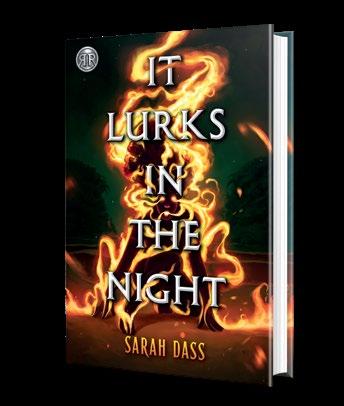
Dass, Sarah | Rick Riordan Presents/Disney
400 pp. | $11.99 paper | January 27, 2026
9781368100663
and self-discovery takes readers on an emotional roller coaster that’s steeped in Caribbean folklore. The strong pacing and well-developed relationships among the protagonists will keep the
pages turning even as secrets and dangers come to light. A gripping, heart-wrenching story about friendship, family, fear, and the monsters we carry with us. (author’s note) (Supernatural thriller. 13-18)
126
By Roshani Chokshi
125 It Lurks in the Night
By Sarah Dass

another riveting,
This fantastical spin on a classic storyline is threaded with feminist themes.
THE SWAN’S DAUGHTER
Banks, Nancy | Delacorte (288 pp.) | $19.99 December 16, 2025 | 9780593900291
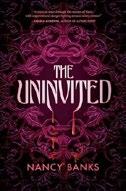
A vampire is loose in Paris, and recent arrival Tosh finds herself in his sights. After moving from Portland, Oregon, to France for her father’s job, Tosh grows increasingly fond of Paris, even if her language skills need some work. Her sweet American neighbor Nick takes her on fabulous, quirky tours and introduces her to new friends who share her curiosity about the world; former debate team member Tosh loves doing research. They also inspire her with their interests, in particular street artist Noor, who uses her paintings to empower women. This message is more important than ever now that someone is attacking and biting women throughout the city, stirring memories in Tosh of a bad experience with Cole, a boy whose sexual aggression led her to quit debate. As the danger creeps closer, and mentions of vampires crop up everywhere, Tosh will have to confront a literal and metaphorical predator in order to keep the new life she loves. The story begins as a Parisian summer romp before shifting to become a creepy vampire horror story that creates a disturbingly apt parallel between vampirism and misogyny while critiquing very real sexism in our world. Banks balances Tosh’s struggles with gender bias with the affection and support of her new friend group to land a genuine and sympathetic tone throughout. Tosh
and Nick are coded white, and Noor is cued Muslim.
Frightful, fun, and feminist. (resources) (Paranormal. 14-18)
Calonita, Jen | Disney/Random House (368 pp.) | $18.99 | September 2, 2025 9781368089777 | Series: The Enchanters, 2
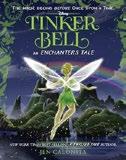
A fairy navigates magical problems in a chaotic and fantastical Never Land. The ageless Tinker Bell stars as the protagonist of this prequel to Disney’s Peter Pan. Tink and her friends call themselves the Wanderers: mermaid Blair, shape-shifter Mimic, fairy Ash, Indigenous human Tiger Lily, and 17-year-old human Caiman, a pirate. Odd disturbances on the island connected to Never Land’s magic send Tink off to seek a solution on the Mainland, where she finds Londoners struggling with poverty, pollution, and impending war. At the Greater London Hospital for Boys, she meets James, who works with other orphans, including red-haired Peter. Tink persuades James, Peter, and the other boys to abandon London and accompany her to Never Land. By the time they return, conditions have worsened, and the island is in danger of losing its magic. As an origin story for the Lost Boys, the storyline largely adheres to the original but is marred by some plot holes. Tink’s good intentions are overshadowed by her impulsive selfishness, and her conflicted friendships sometimes feel more toxic than
supportive. Tink glosses over the lack of care the rescued Lost Boys receive in Never Land; they’re often left alone. The romance between Tink and James contains emotional moments but lacks depth and cohesion. Most human characters read white. Confusing choices make this spin-off miss the mark. (Fantasy. 12-18)
Chokshi, Roshani | Wednesday Books (400 pp.) $22 | January 6, 2026 | 9781250873101

A sheltered but wise maiden makes a bargain for her safety— and risks losing her freedom in the process. Believed to be creatures of myth, veritas swans are “breathtakingly beautiful” women who relinquish their freedom and hearts when they fall in love. Demelza is a veritas swan whose unpleasant but magical song compels those around her to tell the truth. Unlike her sisters, flightless Demelza hasn’t developed wings, and she’s kept in the nest by her mother, who’s also a veritas swan, and her wizard father, Prava the Sly. When the pale-skinned, red-haired Demelza learns of a threat to her life, she flees her home for Rathe Castle to compete against other maidens for Prince Arris’ hand in marriage. Prince Arris is cursed through his father’s line to be murdered by his wife, and he forms an unlikely alliance with Demelza, who’s disguised herself with mud and brambles and a dress made of reeds. They both hope to find freedom from their predetermined fates, but their partnership is threatened by their growing curiosity about one another—and both parties risk losing their hearts. Chokshi balances her sometimes vicious characters with inventive, whimsical elements. Her lyrical prose builds a world that’s reminiscent of tales from the Brothers
Grimm and populated by complex, well-developed characters of fantasy races who are varied in appearance. This fantastical spin on a classic storyline is threaded with feminist themes. Nuanced characterization and unexpected twists make for a deeply intriguing read. (Fantasy. 14-18)
Churchill, Marisa | Page Street (320 pp.)
$18.99 | December 9, 2025 | 9798890033635
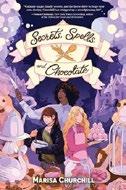
Sylvie Jones is on her way to the Brindille School of Culinary Arts & Magic in this YA debut by a former Top Chef contestant. Due to her mother’s alleged cheating years ago at the famed Golden Whisk—the biggest magical cooking competition around—Sylvie has been admitted only provisionally into Brindille’s six-week preparatory program. The Council of Culinary Sages has tasked her with proving her trustworthiness and talent by finishing first in her class. If Sylvie succeeds, she’ll be officially allowed to take the enrollment test. If she fails, she’ll be banned from “cooking up magic” altogether. Right before Sylvie arrives at Brindille, a mysterious stranger informs her that she’s part of a decades-old prophecy—her name is even written upon the Apple of Discord, a carefully guarded magical treasure borne by “a secret tree that only produce[s] fruit in times of great danger.” Now Sylvie is even more determined to succeed and clear her family’s name. While the overarching plot might hold the attention of ardent fans of magic school stories, the execution falls flat. Experienced genre readers will be disappointed to find that the narrative lacks depth and relies on cliched idioms and tired wordplay, and the culinary elements of the magical world are in need of more robust worldbuilding. Sylvie is cued
white, and there’s diversity among the supporting characters. A sweet yet thinly developed narrative. (recipes) (Fantasy. 12-14)
Creedle, Laura | Quill Tree Books/ HarperCollins (400 pp.) | $19.99 September 2, 2025 | 9780063359130
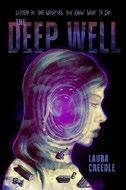
Years after a tragic incident at the New Mexico copper mine where her father was a foreman, a teen finds herself at the center of urban legends. April Fischer was just 4 when she followed the voice that told her she could fly. She rode her pink bicycle with training wheels from her family’s workers’ housing to the open-pit mine. In the subsequent explosion, 19 people died, and her dad vanished. Some believe that she was the supernatural catalyst for the tragedy. Members of the threatening Deep Well cult assert that mine owner King Steenkampf slipped into another dimension that day and that he’ll return on April’s upcoming 17th birthday— if April reopens the portal in the now-abandoned mine. Upon his return, they believe, Steenkampf will “reveal the secrets of health and eternal life to his followers.” Determined to get to the bottom of what actually happened, April relies for help on her younger sister, her best friend, and her love interest, Zach Hernandez. They read through old journals and documents, piecing together the bloody past. The central mystery—whether the mine is truly supernatural or the tragedy had a human cause—will keep readers eagerly turning pages up to the very end. April and the characters who orbit her are likable and originally drawn, and April’s fear, grief, and confusion are real and believable. April reads white, and Zach’s surname cues him as Latine. A fresh take on horror with a compelling premise and intriguing characters. (Horror. 13-17)
English, Shannon K. | Tiny Ghost Press (317 pp.) | $23.99 | December 2, 2025 9781915585370
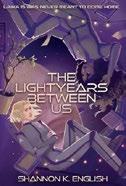
A girl partners with her lifelong rival to survive. Will is a Noble, the daughter of Lord Xavier Arrex; her family has been running the Eden space station since people left Old Terra hundreds of years ago. She whiles away time during classes competing with and provoking Paige Tarrant, but the rest of her life is set in stone—she’s to inherit her father’s position and power. Privileged Will is naïve about the inequities between Nobles and other inhabitants, but when her father’s position is threatened, she joins the Lottery, a horrifying event that happens every 25 years. Thirtysix non-Noble youths are randomly selected to pilot Laika spaceships and search for terraforming installations created by the elders of Old Terra. Thrown into training for piloting Laikas, Will struggles to adjust to the utilitarian living conditions while simultaneously enjoying freedom from her Noble responsibilities, despite the threat of potentially dying in space. While the depiction of dystopian space station politics is intriguing, some plot twists are predictable, and the time skips feel jarring. However, the slow-burning romance between Will and Paige, who end up as co-pilots, offers engagingly realistic character development. Similarly, the themes of family, friendship, and choice are intriguing, add a level of realism, and foster empathy for Will. The Arrex family members are genetically edited to have white-blond hair, “sea-green” eyes, and pale skin. Members of the supporting cast are diverse in skin tone; Paige has “honey-brown” skin. Conceptually intriguing and emotionally grounded. (Science fiction. 12-17)
Garber, Romina | Wednesday Books (400 pp.) | $21 | December 2, 2025 9781250863911

A New York City teenager unwittingly awakens a vampire at her boarding school. When Lorena Navarro and her best friend, Salma Santos, are accepted to Huntington Academy, a new, highly selective school in New Hampshire, Lorena sees it as the perfect chance to start over. A scandal she was involved in has damaged her mother’s career as a parenting influencer, and she’s eager to move on. But her plans for a fresh start unravel when she, Salma, and their new friends discover a coffin and a hidden library in a forbidden wing of the school. Lorena is attacked by the coffin’s occupant, a strikingly handsome, 276-year-old vampire named William Pride, who’s “pale as a corpse.” He’s been in a death-sleep for centuries. Now bound to William as his Familiar, Lorena is pulled into the mystery of why he was sleeping, what became of his family, and what happened to vampire-kind. The closer they get to the truth, the greater the danger, not only for Lorena and William but for their friends as well. Vampire enthusiasts will appreciate the familiar tropes, but once the lore explaining what has happened to the rest of the vampires is revealed, the plot grows unwieldy. William and Lorena’s romance, while central to the narrative, lacks the emotional depth and gradual development needed to feel fully believable. Lorena is Argentinian American, and Salma is cued Latine.
Largely entertaining but loses steam at the end. (Fantasy. 14-18)
Housman, Ivelisse | Quill Tree Books/ HarperCollins (432 pp.) | $19.99
September 23, 2025 | 9781335010049
Series: The Unseelie Duology, 2
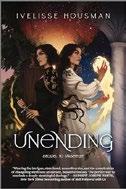
Two sisters learn about themselves and navigate a shifting sibling dynamic during a realms-spanning quest to save the world in this duology closer. Seelie and Isolde are still in the thick of the action, planning their escape from the ambitious shape-shifter, Leira Wildfall, who captured them and their companions, Raze and Olani, at the close of the first book. Seelie continues to conceal both the presence of Gossamer (the faerie she’s trapped within herself) and the shocking truth of Isolde’s changeling identity. Romantic sparks fly for both Latine-presenting sisters—Seelie with Raze, who reads white, and Isolde with Olani, who’s cued Black. The narration alternates between the girls’ first-person perspectives. In Isolde’s point-of-view chapters, she ponders her role in the wake of her sister’s newfound power and independence, and readers gain fresh insights into her dynamic inner life. As Housman shares in the author’s note, Isolde’s viewpoint is inspired in part by her own sister’s experiences with ADHD, a form of neurodivergence that’s often underdiagnosed in women. Isolde has always been, unlike Seelie, “the normal child. The human child,” but with Seelie’s
Gives the timeless good vs. evil theme originality and fresh flourishes.
revelations, Isolde’s experiences are thrown into relief in a new and intriguing way. The race to protect the three realms from Leira’s and Gossamer’s power-hungry machinations is strongly paced, with twists, turns, and character-driven revelations sustaining readers’ interest. The novel effectively weaves together myriad plot threads and is satisfyingly bittersweet.
An energetic, sprawling story of sisterly love and the magic of our unique minds. (Fantasy. 13-18)
Kappel Jensen, Gry | Trans. by Jennifer Alexander | Arctis Books (600 pp.) | $20 September 16, 2025 | 9781646900145
Series: The Rosenholm Trilogy, 3
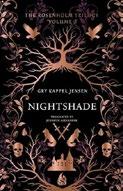
The final book in this trilogy brings closure for friends Malou, Chamomile, Kirstine, and Victoria. Having discovered in Forget Me Not (2024) that Jens Andersen, the principal of their boarding school, Rosenholm Academy, murdered former student Trine in the ’80s, the girls believed that Trine’s spirit was at peace. But Trine wants more—a confession. Victoria decides to tell the truth about Jens at her parents’ party, which will be attended by powerful mages. But before she can speak, Jens addresses the crowd himself, painting an alluring picture of a world in which mages have greater power. Bravely rising to speak after him, Victoria collapses, seemingly due to a seizure, while Jens mutters a spell. The girls believe he’s acquired greater powers since stealing Chamomile’s victory stone, and now he’s exerting his influence. Victoria, Chamomile, and Kirstine elect not to go back to school and instead organize a resistance movement. Malou, who’s remained at Rosenholm, isn’t answering Chamomile’s texts, bringing tension to the formerly close-knit group. Clever plot twists keep readers on their toes as a battle of wits, dark magic, and the
ghosts of murdered girls unfolds in this translated Danish import. Romance is present, but the beating heart of the story is the exploration of friendship, courage, persistence, and morality. Kappel Jensen gives the timeless good vs. evil theme originality and fresh flourishes through the well-developed setting, atmosphere, and relationships. A riveting finale that ties up all the loose ends with aplomb. (Fantasy. 14-18)
Kendall, Keala | Disney/Random House (480 pp.) | $18.99 | September 2, 2025 9781368108249 | Series: Twisted Tale
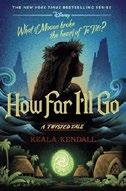
After failing to restore the heart of Te Fiti, Moana journeys to the realm of monsters with a new friend. The ocean chose Moana to restore the heart of Te Fiti, but she thinks it chose the wrong girl: Her risky plan to defeat Te Kā fails, and she awakens to find the demon gone, Maui encased in molten rock, and the heart of Te Fiti scorched. When she touches the broken stone heart, a curse encircles her wrist, threatening to consume her by the time of the next full moon (in about a week).
Gramma Tala’s spirit guides Moana to an island that’s dead thanks to Te Kā’s blight, but there she meets the last inhabitant, Noelani, who’s a dreamfarer, or someone whose spirit wanders while they sleep. Together they travel through Lalotai, the realm of monsters, to find the tears of Te Fiti, and along the way they face terrifying creatures and the stuff of nightmares. Moana often feels unsettled by Noe’s words and actions, though they work well together. Drowning in guilt, shame, and doubt, Moana must face the darkness not only in the physical world but within herself to save everyone. Kendall, who’s hapa Native Hawaiian, offers readers action, adventure, and mystery in this exciting tale that’s interwoven with Polynesian
cultural elements. Fans of the Disney movie will enjoy the deeper look into the monster realm and the interconnectedness of the human and spirit worlds. A dark and engaging adventure. (Fantasy. 12-18)
Kirchmeier, K.D. | Bloomsbury (368 pp.) $19.99 | October 14, 2025 | 9781547615582
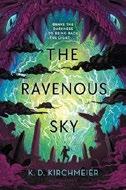
Teenage survivors in a world ravaged by electromagnetic dragons dubbed the blitz split up for separate missions in this sequel to The Shadow Road (2024). Their fading psychic powers signal to the three point-of-view characters, who trade off quick chapters, that the magical gateway—through which a flood of the blitz, gargoyles, and other mythological creatures has appeared—might be closing. Zora seeks to escape the ruthless militia who have captured her. Cassie resolutely sets out on the back of a (more or less) tamed blitz to rescue a young friend with extraordinary animal-communication powers who has been kidnapped. And Thomas negotiates with a demonic, corpseeating ghoul for access to the godlike elders of the magical world. The frequent shifts in perspective and locale lead to choppy pacing rather than growing suspense, and an eventual, indecisive battle between the blitz and ghouls comes off more as a contrived climax than a necessary development. Still, there’s plenty of action, some of it involving dragon riding, and the author does tuck in a few nifty ideas, like a ghoul-given grave-sight that tells Thomas how soon people will die by how fast their faces seem to rot, and a talking mushroom that dispenses healing (but ominously infectious) spores. The human cast largely presents white. Grim and grisly bits might carry readers through the patchwork plot, but it’ll be a chore. (Dark fantasy. 13-17)
Kiyoko, Hayley | Wednesday Books (320 pp.) $22 | November 4, 2025 | 9781250356314
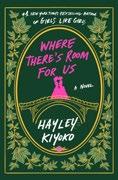
In a late-19thcentury Britain in which queer relationships are normalized, a lord’s dutiful daughter is inexorably drawn to an outspoken American.
Two of Lord Tallon’s daughters (Marigold and Dani) are attracted to women, and two (Freya and Angelica) favor men. Lacking sons, he needs a daughter to marry a titled man and bear a grandson to be his heir. Freya receives most of the pressure—Angelica has only daughters, and children adopted by two women cannot inherit. Ivy YadaLovell, a Sapphic American poetess with a scandalous reputation, joins her newly minted viscount brother at a neighboring manor and immediately falls for Freya. Despite Lord Tallon’s expectations and his contempt for Ivy’s outspoken support of women’s rights, Freya tumbles headlong into her first same-sex romance. Ivy, meanwhile, finds her yearning for Freya extends to the Tallon sisters’ loving family life. Can they overcome the obstacles in their path? Despite being set in the late Victorian era, the lack of mention of the era’s technology gives the setting more of a Regency feeling. This effervescent romance features an evocatively built world, strong, sympathetic characters, and sweet moments of yearning and connection. A pervasive theme in the book centers on queer women’s lack of inheritance rights. Familiar historical romance tropes abound, and the intimate moments are chaste. Freya’s family is cued white, Ivy is of English and Japanese descent, and there’s diversity in gender identity and ethnicity among the supporting cast. A delightful Sapphic historical romance with a social conscience. (Historical romance. 14-18)
SEVEN ALL ALONE
Lindwasser, Anna | West 44 Books (200 pp.) | $25.8 | December 1, 2025
9781978598041 | Series: West 44 YA Verse

Recognizing the toxic effects of her parents’ content creation, a teenager wants out.
Rosalie Solis is tired of being part of an influencer family and having all her private moments shared publicly. Her parents constantly film her and her little sister, Gennie, crafting storylines for their lives that include Rosalie pretending to date her best friend, Diego, even though neither of them is attracted to people of the other’s gender. Rosalie and Gennie are home-schooled in order to provide more opportunities for their parents to film them; when Stella, a non-influencer girl, joins their community because her fibromyalgia makes a regular school schedule difficult, Rosalie is taken with her. A scary run-in with a fan brings to a head Rosalie’s concerns about the effects of her parents’ prioritizing content over the emotional needs of their children, and she decides to take drastic action to reclaim their lives. This accessible novel in verse about the dark, sometimes dangerous effects of influencing will appeal to readers who consume social media, including those who may not have considered who’s harmed in its creation. While watching Rosalie come to terms with the damage her parents have done is difficult, the story’s heavier elements are offset by the sweetness of her developing romance with Stella. Rosalie and Gennie are white, Stella is of Chinese
and Italian descent, and Diego was transracially adopted from Panama. A sobering look behind the family vlogging curtain for reluctant readers. (Verse fiction. 12-18)
Mbalia, Kwame | Star Wars/ Random House (464 pp.) | $18.99 October 21, 2025 | 9781368065610
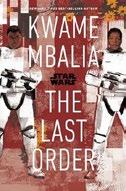
Two former soldiers turned freedom fighters track down an unknown adversary in this Star Wars novel. The First Order may have fallen, but it refuses to fade quietly into the darkness. For Finn and Jannah, the regime’s cruelty extends beyond the battlefield. Before joining the Resistance, both were obedient stormtroopers—until they could no longer ignore how the First Order punished and terrorized the people it claimed to liberate. Finn’s breaking point occurred while he was serving as a bodyguard for Major Gohl, and Jannah defected after an incident on Ansett Island. Now, following the Battle of Exegol, the Resistance has been searching for survivors and refugees. When a ship of frightened children dressed in First Order uniforms arrives at the Resistance base on Ajan Kloss, Finn and Jannah decide to uncover the shuttle’s origins. As they delve deeper into their mission, the pair reopen past traumas. Set after the events of the film Star Wars: The Rise of Skywalker, Mbalia’s stand-alone YA debut skillfully constructs the backstories of two compelling Black characters who were underutilized in
filmmaker George Lucas’ universe. Although casual Star Wars fans may need to brush up on their cinematic lore, the action-filled narrative shines when showing Finn’s and Jannah’s inner conflicts, particularly as they question and reject the First Order’s twisted moral code.
A fine-tuned character study spotlighting the emotional and psychological awakening of two unexpected galactic heroes. (Science fiction. 12-18)
McGinnis, Mindy | Harper/ HarperCollins (384 pp.) | $19.99
November 18, 2025 | 9780063370692
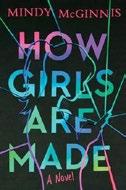
T hree teen girls in a small Ohio town start a secret sex education program. After realizing that her school’s sex education program is woefully lacking, overachiever Fallon sets out to form a secret group to discuss sex and share information. She enlists the help of her best friend, Jobie, and classmate Shelby, a semi-famous fighter who’s in the spotlight after a video captured an act of domestic violence in which her (now ex) boyfriend punched her. The group begins meeting at a local recreation center, offering a safe space for their classmates to ask questions about sex. When the white teens create an Instagram account to share sexual health information more widely, they quickly gain both supporters and enemies. Each of the three protagonists faces her own struggles: Fallon becomes a target for harassment as the group and Instagram account grow in popularity, Jobie’s obsession with social media leads her down a dark path, and Shelby grapples with her recent breakup even as she’s drawn into a new, insidiously toxic relationship. The novel attempts to tackle timely issues but none is given enough time to be adequately addressed. The shocking and disturbingly dark ending may leave readers
unsettled, though fans of McGinnis will appreciate her signature razor-sharp writing. While there are queer characters among the supporting cast and brief mentions of LGBTQ+ topics, the conversations around sex primarily center cisgender and heterosexual teens. An ambitious novel that doesn’t delve deeply enough into its meaningful topics. (author’s note) (Fiction. 15-18)
McKay, Kirsty | Sourcebooks Fire (352 pp.) | $12.99 paper December 2, 2025 | 9781728268484
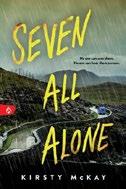
In a shockingly unlucky turn of events, a group of teens in Scotland who as children were abducted by their bus driver again face danger in this thriller.
Maggie Atkins and her fellow survivors find themselves bound for Enrichment Week, a required school hiking trip led by Maggie’s father, Mungo, on Cairn Gealach, a mountain in the Scottish Highlands. Troubling history haunts the survivors, including betrayal by Maggie’s former boyfriend, Ben, who’s now dating Chinese Scottish Stephanie; Stephanie seems to be the sole student who’s not white, and she endures racist jabs from miserable bully Seb. Seb’s twin brother, Lawrence, might be the only person besides Mungo who really wants to be there. Pouring rain and a challenging river crossing set them on course for a crisis almost immediately when Mungo and Maggie’s exuberant friend Ant, who’s nonbinary, becomes separated from the others. The group, rounded out by affable, supportive Cass, a transfer student from London and the lone newcomer, must dig deep to rise to the challenges they face. A gripping blend of action-laden natural disasters and eerie suggestions of paranormal possibility will keep readers on tenterhooks as conditions on the mountain worsen and the seven fight for their lives, all the while contending with the deep rifts that divide them.
An engrossing thriller and propulsive survival story rolled into one. (Thriller. 14-18)
Mickelson, Marcia Argueta | Carolrhoda Lab (256 pp.) | $19.99 | November 4, 2025 9798765627716
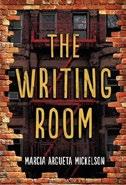
A privileged 18-year-old is forced into adulthood when her rich father cuts her off financially. Maya Michell’s white, self-made millionaire dad raised his children in luxury in Manhattan—but he kicks each kid out immediately after high school graduation to force them to learn how to earn the good life for themselves. When her turn comes, Maya is prepared to live with friends and work at the library before entering Columbia (college tuition being the one expense her dad will still cover). But Maya struggles to understand her father’s meanness; he refuses to let her keep her copy of her favorite childhood book, Charlotte’s Web. Readers will empathize with Maya’s loneliness and sensibility. Though her doctor mom has returned home to Guatemala to care for Indigenous patients and Maya’s aging grandmother, and her siblings are also far away, Maya doesn’t wallow. She lines up freelance writing gigs and finds community with new neighbors and at a local shared writing space. She also finds a love interest in Jake Canales, the cute, mysterious teen manager of the writing room. When Maya realizes that her dad is supporting a racist, anti-immigrant candidate for governor, she must decide whether to risk the future she’s always counted on by finding the strength to speak out. The subject matter is meaningful and all too relevant, but the story struggles with flat writing and a plotline that lacks propulsion. A timely coming-of-age story about taking a stand that falters in execution. (discussion questions) (Fiction. 14-18)
Mix, Rebecca | Illus. by Luiz Fernando da Silva | Andrews McMeel Publishing (112 pp.) $14.99 paper | November 4, 2025 9781524880613 | Series: Neopets, 2
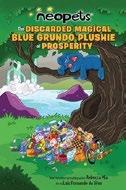
In this second entry in a series inspired by the online game Neopets, everyone in Neopia is being turned into toys.
The Discarded Magical Blue Grundo Plushie of Prosperity (TDMBGPOP for short) is a toy that’s been drawing in visiting Neopets. When a member of the Council of Faeries brings him up during a meeting, she’s met with a firm response: Toys are mere playthings, and any perception that Neopians who visit him feel better afterward is “at best, a coincidence.” The Council is willing to let TDMBGPOP remain, however, because he attracts Neopians. And yet, TDMBGPOP does have feelings—and one day, he discovers that he can move. Suddenly and inexplicably sentient and mobile, he leaves the tree where he’s been stuck. As he travels around Faerieland, trying to understand his situation, he discovers something surprising: Everyone has been transformed into toys, even lightskinned, purple-haired Queen Fyora. TDMBGPOP meets two other living toys, Buttons and Stitches, and together they come up with a plan to save everyone. But the cause of all this chaos might be closer to home than TDMBGPOP originally thought. Fans of the game will delight in da Silva’s colorful panels and richly detailed backgrounds that are reminiscent of the classic style of the Neopets game. This heartfelt, often funny graphic novel carries a hopeful message.
An entertaining adventure. (note from ambulatory wheelchair disability activist Sabrina Alexander) (Graphic fantasy. 12-18)
The author of They Bloom at Night finds strange comfort in horror stories.
BY ILANA BENSUSSEN EPSTEIN
CHILDHOOD IS ITS own kind of mythology in Trang Thanh Tran’s sophomore novel, They Bloom at Night
The Philadelphia-born author lived in Louisiana between ages 6 and 14 and drew on experiences of these formative years in painting the Gulf shrimping town of Mercy. Readers’ window into this atmospheric post-apocalyptic setting is Vietnamese American teen Noon, a character in the midst of as much turbulent change as their hurricane-stricken, algae-mutated hometown. Tran, who now lives in Atlanta, Georgia, shared more with Kirkus over Zoom. Our conversation has been edited for length and clarity.


This book is unique in that it’s a post-apocalyptic story where it’s clearly acknowledged that the rest of the world has gone on just the same. It’s very localized, which speaks to how people treat natural disasters or any type of disaster now. There’s that big outpouring of support at the beginning, all the news outlets are covering it, and then they disappear once you get to the long-term survival of the people who are left rebuilding their lives.
As the climate crisis continues to deepen in our world, we’re seeing more stories of apocalypse precipitated by humans. Do you see They Bloom at Night as a climate change story?
When I set out to write it, I wasn’t necessarily writing a climate change story, but because we are a world that is affected by climate change, it naturally progressed that way. Especially when you’re thinking about the South and how much of the shoreline is disappearing every year because of the rising water, for example. As I developed the story, I felt like I couldn’t write a story about this small shrimping town in the Deep South without connecting it to the environment and what’s actually happening.
What role do you think horror stories play in our lives? For me, horror is a place you can dig deep into the different fears that you
have, all the bad scenarios that you can get into. As a person with anxiety, I have a lot of bad scenarios in my mind, so being able to write them out is a form of catharsis for me. I get to play out the scenario, see how this person survives or doesn’t survive. When I need a pick-me-up, I like to watch Resident Evil or something like that; it comforts me for some reason. You visit these horrors, and then you get to leave.
I know that you are also working on some adult horror fiction. Does your approach to horror change when you’re writing in the adult sphere? It does. In the adult space, I’m thinking more about how far I can push the premise. Sometimes, when I write YA, I have to stop and ask myself: Is this
serving my younger readers? How do I hope this scene connects with them? They’re at a young age, so these things are influential. For some of them, this is their only doorway to other identities, to other lived experiences. Fiction is fun, fiction is fantastical. I want to provide a place that is fun—even if it’s horrifying—for them to read through, to work through. When it’s adult fiction, the fun is almost, How terrible can it be? You don’t have to worry about how they’re doing emotionally at the end as much [laughs].
The book has such a unique take on the monstrous. The red algae reminded me of that zombifying fungus— The cordyceps, yes!
—and then there are the really original elements of
Noon’s family mythology. How did you evolve the fantastical elements of the story?
In Vietnam, especially in smaller towns, there’s a lot of focus on smaller deities; the gods exist in a very localized way. In Vietnamese folklore, there are a lot of stories about mother goddesses—for example, the mother goddess of the forest. So I [started with] a very basic idea of a god, and from there I built up the mythology for Noon’s family, which is that they lived on the water in Vietnam and have now moved to the States but still live on the water. What does that look like? When you think about how your family survives, that also becomes a mythology. I wanted to build this idea that Noon’s family believes in this greater force that has helped them along the way. Nature is so beautiful, yet so terrifying.
Noon experiences gender dysphoria throughout the book, which also ties into the body horror elements of the story.
Dysphoria is a huge part of the story, especially when Noon can’t see themself in the mirror. These elements emerged as I was writing, and then afterwards I looked at the book and [realized] this is actually a story about gender. It’s the body horror of not being able to see who you feel like you truly are, and then there’s a second layer of changing in ways that you and other people don’t completely understand. There is a lot of fear about how your body is presenting, how your body is changing over time.
It’s a weird space, when you’re not a girl but you’re seen as a girl, so you have all these experiences of girlhood. Noon has all these different experiences of being treated like a girl, and being treated like a girl can be kind of
horrible! They have to separate how they feel about how girls are treated from how they feel about themself.
Tell me more about Noon’s relationship with Covey [the daughter of their main
When I need a pick-me-up, I like to watch Resident Evil or something like that.
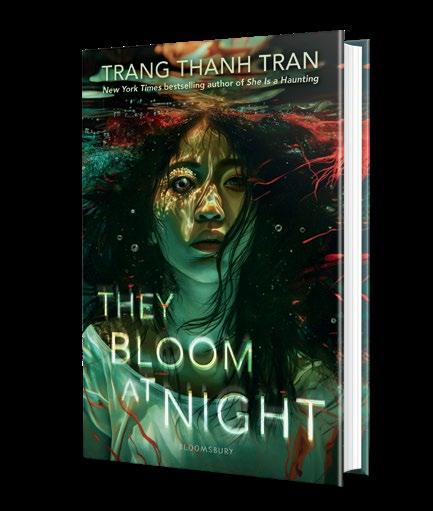
adversary who becomes an unlikely ally in the story]. There’s romance there, but it’s not defined.
I went back and forth on this. There are versions where they kiss or something like that, but ultimately this felt like the right version. There is romance there, there’s feelings, there’s tension, there’s different things, but the overarching story I was trying to tell was about family and friendship and companionship. Companionship is so important; more important than just kissing someone that you like is having someone who’s gonna stick with you through the bad. Noon and Covey are two people set in their ways, and their families shaped them as people. Even when your family sucks sometimes, there’s still that defensiveness: But they’re my family. Noon and Covey challenge each other, and they work through it to become friends. That felt meaningful by itself. And then also, sometimes an unrequited romance just sticks with you harder [laughs].
The way Noon’s story ends, there’s a lot of in-betweenness, a lot of ambiguity and impermanence.
I don’t want to make any big promises that everything is going to be OK, because a lot of times, things won’t be OK. I think teen readers can handle that kind of ambiguity, because I think they live it now. Things may be terrible, but in the moment, you can still have these small moments of love, these small moments of happiness and feeling right. And they are worth living for.
Ilana Bensussen Epstein is a writer and filmmaker in Boston.
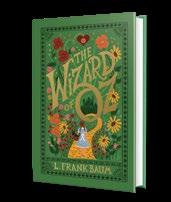
Gwen Stefani and Blake Shelton will executive-produce this contemporary retelling.
A new take on the Wizard of Oz books, executive-produced by Gwen Stefani and Blake Shelton, is coming to Amazon Prime, Deadline reports.
The streaming service is developing Dorothy, a contemporary YA reimagining of L. Frank Baum’s series of children’s books that launched in 1900 with The Wonderful Wizard of Oz
Baum’s novels have been adapted for the screen many times, most notably in the iconic 1939 film The Wizard of Oz, directed by Victor Fleming and starring Judy Garland, Frank Morgan, and Ray Bolger, as well as in the 1978 film The Wiz, directed by Sidney Lumet and starring Diana Ross, Michael Jackson, and Nipsey Russell. Dorothy will be produced by Gina Matthews (What Women Want, 13 Going on
30). Musicians Stefani and Shelton are among the series’ executive producers.
“I’ve been in love with the Wizard of Oz books since I was a child,” Matthews told Deadline. “The story reminds us of the qualities we need to get through hard times, and Dorothy is a symbol of strength who shows us that with a little
kindness—and a lot of grit— we can not only achieve great things but also lift up those around us. I’m excited to bring that message to the world, now more than ever.”
And Stefani said, “It’s a creative and modern take on a classic, and being part of something that blends music, emotion, and the character of Dorothy is inspiring to me.”—M.S.


For more book-to-screen news, visit Kirkus

These audiobooks featuring full casts deliver a truly immersive listening experience.
BY KIRBY MCCURTIS
I’VE NOTICED, in both adult and teen audiobooks, an increase in titles with more than one narrator. I love multi-actor narration, because it transforms an audiobook into a more immersive experience. Here are three full-cast YA audiobooks that should not be missed: The latest from author Jason Reynolds is a masterpiece— of both storytelling and sound design. Unlike other YA audio titles from Reynolds, Soundtrack (Listening Library, 6 hours and 29 minutes) is an audiobook original. Featuring a cast of 20 and an original score by Grammy-winning composer Justin Ellington, it’s a unique and captivating
listening experience.
Drummer Stuy wants to follow in his parent’s footsteps and start a band. He connects with guitarist Dunks, hype man Frankie, trumpeter Keith, and bass player Alexis, and together they start playing in subway stations. Their popularity quickly rises, and the underground band’s dreams come true. The music performed by each character embodies their personality, so listeners have extra insight into who these teens are—and get to hear amazing music at the same time. In addition to the music, city sounds like tap dancing, pizza shop clatter, clapping crowds, and the

echoes of the subway bring New York City to life. Also set in New York, A Bird in the Air Means We Can Still Breathe by Mahogany L. Browne (Listening Library, 3 hours and 38 minutes) captures life during the Covid-19 pandemic through a mixture of prose, poetry, lists, and letters. Hyacinth and Electra are “two city girls with island roots” who meet in foster care. Because the two have “seen it all,” they serve as the chorus, threading together 10 separate stories while adding context and personal reflections in their pitch-perfect Caribbean patois. Having 14 actors on the recording gives a greater depth and precision to each character than could be accomplished with just a single narrator. The dynamic performances allow listeners to feel characters’ pain, their grief, and their struggles. There is a sense of hope as well—especially in Hyacinth’s “litany on surviving”—that reminds us we did make it out.
Libba Bray’s Under the Same Stars (Macmillan Audio, 16 hours 31 minutes), read by January LaVoy, Jeremy Carlisle Parker, and Major Curda, is a multigenerational story that takes place across three different timelines: a small village in Germany at the
start of WWII, the 1980s punk scene in West Berlin, and New York City during the 2020 pandemic lockdown. In the latter storyline, Chloe receives a package from her grandmother that includes an article about three teens who disappeared from their village on the winter solstice in 1941. She enlists her best friend, Miles, to help her solve the cold case, and the unraveling of that mystery connects all the timelines. Bray’s transformative storytelling is supported by multiple actors in the audio edition—each character has a distinct voice, and that pulls readers into the thrilling chase. Throughout the audiobook, Chloe’s grandma shares fairy tales on cassette tapes; listeners first hear the tape sliding into the tape player, then a crackling noise, and we are transported far away. The softer, more distant quality of this recording-within-a-recording lends an otherworldly effect to the story. The third act is emotionally charged; the pacing is excellent and there is a tenseness in every word that reinforces the need for resistance in the darkest times.
Kirby McCurtis is director of location services at Multnomah County Library in Oregon.
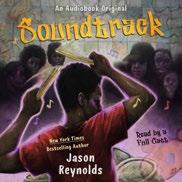
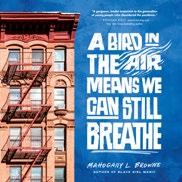
The protagonists’ voices are engaging, and readers will identify with them.
DON’T FORGET TO BREATHE
Neal, Olivia | Running Wild Press (329 pp.)
$21.99 paper | September 22, 2025
9781963869323
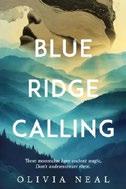
When Sage Rivera’s brother vanishes into the North Carolina woods, she sets out to find him, accompanied by unlikely allies. College dropout Sam became obsessed with supernatural lore following the death of their mother. Sage, who’s grounded in science and reason, has little patience for ghost stories. Their childhood friend Kora, who mourns the family’s loss as if it were her own, joins Sage’s search without hesitation. Alongside them are Kora’s new maybe- girlfriend, Hunter; Kora’s ex-boyfriend, Connor; and Noah, the young library employee who helped Sam with his research and quietly harbors feelings for him. As the group ventures deeper into the woods, their search for Sam brings some of their own struggles with grief to the surface. Sage, who used to find solace in swimming, turned to drinking and quit the swim team. She also lives with ADHD, a detail that’s woven into her character without defining her. Kora’s childhood home is up for sale, and she’s soon heading to art school in New York on her own. The characters are funny and supportive of one another, and the novel offers a thoughtful examination of grief’s ability to isolate people and shape their identities. While the Appalachian folklore largely remains in the background, the setting is lovingly
described. Sage and Sam are cued Latine and white; Sage is whitepassing, unlike her brother. Hunter is Cherokee, Noah presents Black, and Kora and Connor read white. A heartfelt, lightly magical exploration of loss, friendship, and the end of childhood. (Fiction. 13-18)
Oh, Axie | Feiwel & Friends (400 pp.)
$19.99 | October 21, 2025 | 9781250853110
Series: The Floating World, 2
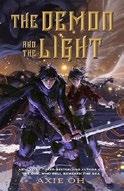
Now that Ren’s and Sunho’s true identities have been exposed, Ren must find a way to bring Sunho home while assuming a role she never wanted. Ren is no longer a traveling troupe performer. After her Light powers were revealed and she defeated the general who killed her mother, she had to take her rightful place as the Princess of Sareniya and a celestial maiden. Before she can claim the throne, however, Ren needs to find Sunho, the boy she loves. After recovering a memory that revealed the horrific truth about what happened to him and his brother, Sunho succumbed to the pain and rage, fully transforming into the Demon. Working with her new friends and allies, Ren travels far afield, trying everything to bring Sunho back—not only to Sareniya but to his human self. As Ren delves deeper into the politics of the royal court, she discovers that there’s more to the war with Volmar, the demon experiments, her magic, her ancestors, and the world she knew as a child. She’ll have to summon her
courage and wit while learning to embrace her true self in order to rid their world of darkness. This is an exciting, action-packed, and fast-paced duology closer, filled with plot twists and a touch of romance. Detailed worldbuilding provides additional context for the East Asian–influenced setting, and the well-developed characters explore a wide range of emotions and internal struggles. A thrilling story that’s full of darkness and light. (map) (Fantasy. 13-18)
Shrum, Brianna R. & Sara Waxelbaum
Harper/HarperCollins (384 pp.) | $19.99
October 21, 2025 | 9781335013903
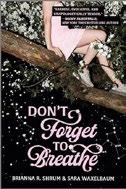
Hanna McCowan is constantly moving around. Her mother is in the Army, and Hanna is once again trying to start her life over in a new location: Fayetteville, North Carolina. As an out lesbian with ADHD, Hanna is always wary when it comes to making new friends. As an Army brat, she’s also wary of losing friends. When she first sees Zoe Aaron in Spanish class at her new school, she’s instantly enthralled. Zoe is an autistic bisexual girl “whose personality is eighty percent ballerina”—and who definitely has a boyfriend. But when Zoe meets Hanna, her entire worldview shifts. Hanna begins working as a pianist at the ballet studio where Zoe dances and the two girls connect. They decide to work together on Zoe’s audition for a professional ballet company, something Zoe has conflicted feelings about pursuing. In this self-aware will-they, won’t-they romance, the leads navigate their complex feelings for each other, their dynamics with mutual friends, and their distinctly neurodivergent brains. Written from both girls’ points of view, the hilarious and swoonworthy narrative is a joy to
read. The protagonists’ authentic voices are engaging and realistic, and readers will easily identify with them. There are times when the timing of events isn’t completely clear, and some of the inside jokes among characters may be confusing, but the delicious drama and steamy romance more than carry the story. The white-presenting main characters are Jewish (Hanna’s mom is Catholic). A poignant and humorous neuroqueer romance. (Romance. 14-18)
Shusterman, Neal | Simon & Schuster (592 pp.) | $29.99 | November 18, 2025 9781665990783
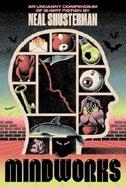
More than three dozen tales— several of them previously unpublished— make up this varied short story collection of fantastical speculative fiction. From playful entries involving a malevolent Christmas tree or a hot tub–dwelling monster to more disturbing vignettes, such as one in which a boy, neglected by his VR-gaming–obsessed parents, is led to violence, these stories shift easily between goofiness and real terror. Grouped into seven sections that provide a loose thematic structure, some of the stories are short, punchy, and sweet, and others are expansive, immersive, and prickly with atmosphere. They’re unified by their overwhelming sense of the uncanny; they explore interesting philosophical and ethical questions but never take themselves too seriously. Most of the stories have appeared in other anthologies; a few are co-written, one with Terry Black and three with the author’s son Brendan Shusterman. The entries are distinctive and original, but the sheer length of this collection may make it better for
dipping into than for a through-read. Two new stories set in the world of the Arc of a Scythe close out the book and are not to be missed by fans of that series. The final one is a witty and fascinating meta-interview that imagines its characters—including the artificial intelligence entity the Thunderhead—answering questions from a reporter and in turn putting questions to Shusterman himself. There’s some ethnic diversity among the characters.
A thoroughly enjoyable arrangement of short fiction at once eerie, absurd, and thought-provoking. (Short stories. 13-18)
Simmonds, J.L. | Henry Holt (352 pp.)
$24.99 | $12.99 paper | October 14, 2025 9781250402202 | 9781250402226 paper
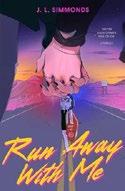
Two girls run away together, perhaps toward more danger than they’re leaving behind. Jessie Swift, who feels like the weird, poor kid at school, has one
goal—get to the bus station and out of town. A traumatic discovery at home spurs her to leave Seattle, where she lives with her single mom, who’s “well known to CPS.” As she struggles with her duffel and backpack, none other than gorgeous, popular, and wealthy Brooke Summer, Jessie’s longtime secret crush, offers her a different way out. The girls, who are cued white, agree not to pry into each other’s reasons for leaving, but as they drive across the country in Brooke’s red Mustang, a vintage convertible, the magnetism between them becomes impossible to ignore. When they end up in the crosshairs of a pair of dangerous criminals in Utah, they’re forced to run from more than just what they left behind in Seattle. Though at times Jessie and Brooke come across as hardened by their circumstances, they find time for
much-needed fun, like makeovers, and engage in some solid soulsearching. The deep emotion and strong suspense are wrapped up in a tidy ending that doesn’t quite live up to the story’s promise. Nevertheless, the journey is rewarding and readers who come for the plot hook will stay for the character development. Seedy motel rooms and cassette tapes blend with a sweet, slow-burn romance on a twisty road trip adventure. (Thriller. 14-18)
Takase, Umi | Trans. by Erin Procter
Random House Graphic (224 pp.) | $20.99
November 4, 2025 | 9780593902967
Series: I Wanna Be Your Girl, 2
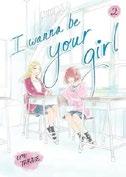
Akira and Hime’s story of self-discovery continues in this second entry in a translated manga series from Japan. In Volume 1, Akira, a trans girl, started wearing a skirt to school, while her best friend, Hime, donned a boy’s uniform in solidarity. Now Akira pushes herself to join the soccer club, but she confronts the fact that many of her classmates, including her crush, still see her as a boy. In one scene, which may feel unsettlingly familiar to many trans people, her dad explains why he won’t allow her to grow her hair out, demanding unrealistic levels of self-assurance from Akira while emphasizing societal prejudice and possible future regrets. By contrast, Hime’s parents give her priceless advice: Doubt can open up options, you won’t know how you feel until you act, and you aren’t bound by your initial decision. This story touches on a variety of experiences with identity, including being jealous of others for things you may not even want and the danger of judging others’ appearances, even positively. This volume, which features clean, expressive artwork, also widens the
spectrum of identity and gender expressed by the characters. This continuation of the popular webcomic is a must-read for those who enjoyed the first volume. A straightforward story exploring complex ideas with honesty. (Manga. 12-16)
Wang, Tiffany | Bindery Books (424 pp.)
$15.95 paper | October 28, 2025
9781964721446 | Series: The Inferno’s Heir Duology, 2
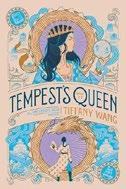
In this sequel to Inferno’s Heir (2024), Teia, now queen of Erisia, is in pursuit of Lehm, who seeks to destroy the Five Kingdoms by awakening the Serkawr, a creature of immense power. After outwitting her half brother and claiming the crown, Teia is crossing the Dark Sea with her trusted spy and thief, Enna. The two hope to thwart Lehm’s attempt to unleash the Serkawr by finding the Morning Star jewel and the Seascript, an ancient text that contains information to help them stop the beast. This quest takes them to Shaylan, the East Asia–inspired homeland of Teia’s mother, where they receive a warm welcome. The kingdom is now ruled by Teia’s cousin Yuwen, who deposed his corrupt, power-hungry father, Feng. The pace picks up as Teia and Enna are reluctantly reunited with former allies Kyra, Alara, and Tobias. Lehm also appears, quickly planting seeds
of doubt about Teia’s intentions in Yuwen’s mind. The suspense rises as Teia and her crew take Jin, Yuwen’s advisor and lover, hostage and flee. They get caught up in exciting entanglements as they attempt to infiltrate the den of the Society of Thieves, who are rumored to have stolen the Seascript. Wang skillfully balances magical worldbuilding, political intrigue, and romance while maintaining focus and a strong pace. Many of the characters, who are diverse in appearance, have ulterior motives that add to the surprises. A high-stakes, action-packed duology closer filled with deftly placed twists. (Fantasy. 13-17)
Wellington, Joelle | Simon & Schuster (416 pp.) | $21.99 | November 4, 2025 9781665974431
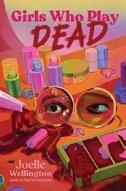
A high school senior returns to his Massachusetts hometown after learning of a shocking murder.
Michael “Mikky” Graves thinks he’s left Prophets Lake behind. Living in Boston with his mom, he finally feels settled. Although the move tested his relationship with his younger sister, Kyla, who stayed behind with their dad at the family funeral home, Mikky knows his decision was for the best. Nearly three years later, Mikky is pulled back to the lakeside community after Erin Vaughn, Kyla’s wealthy and popular best friend, is killed. Mikky wants to
Captures the seedy underbelly of small-town politics and the bonds of girlhood.
GIRLS WHO PLAY DEAD
support his sister, but soon after arriving, he finds that Kyla has changed. Now a high school junior, she guards secrets and rules her dance squad with icy intimidation. As Mikky tries to readjust to student and family life in Prophets Lake, the key to Kyla’s healing becomes clear: Find Erin’s murderer. But the deeper he tumbles down the rabbit hole, the more Mikky must contend with the town’s poisonous legacy—one that somehow explains Erin’s death. Evoking Twin Peaks , Wellington’s latest delicately peels back the shiny facade of an all-American suburb to examine the darkness within. The third-person narration gives equal weight to Mikky’s and Kyla’s distinct perspectives, showing the aftermath of unprocessed trauma. Sharply drawn secondary characters highlight the town’s toxic dynamics. Kyla and Mikky are Black, and Erin is white. Mikky has an anxiety disorder and depression.
A compelling work that captures the seedy underbelly of small-town politics and the intense bonds of girlhood. (Thriller. 14-18)
Woltz, Anna | Trans. by Michele Hutchinson Rock the Boat/Oneworld (224 pp.) | $12.99 paper | November 4, 2025 | 9781836430612

A polio survivor and her friends navigate life in London during the Blitz in this translated Dutch import. After spending a year convalescing, 14-year-old Ella finds herself changed. Her left leg is weak, leaving her with a limp and requiring her to wear a special shoe. Being around a lot of people is overwhelming, which makes crowding into the Underground every night to shelter from air raids nerve-wracking—especially because the tunnels trigger memories of being immobilized in an iron lung.
Soon, however, three unexpected friends show Ella she doesn’t “have to spend the rest of [her] life being afraid.” Outspoken feminist Quinn, the daughter of a lord from a country estate, is determined to travel and “do a job that matters.” Quinn’s estranged brother, Sebastian, wants to live openly as someone who’s attracted to men at a time when such relationships are illegal. Angry, wisecracking Jack schemes to save money to emigrate to America—and makes Ella wonder if he can see her old self. But when tragedy strikes, Ella struggles to move forward. Though some characters feel thinly drawn, Woltz poignantly explores topics including privilege and the “cages” of class and gender norms. While the author doesn’t sugarcoat the grim physical and psychological effects of war, she lightens the darkness with banter, romance, and acts of kindness. Historical photos help bring the setting to life. Touching and ultimately hopeful. (photo credits, historical facts) (Historical fiction. 13-16)
Yang, Yueh | Wattpad Books (288 pp.) | $12.99 paper October 7, 2025 | 9781998341061
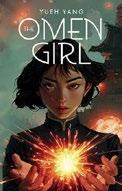
A cursed girl enters a sacred competition in order to bring change. In the city of Tall Titan, people called Omens bear debilitating, monstrous ink-like stains on their bodies as evidence of their sins. They’re feared and face discrimination and hatred. Under the ruthless guidance of Esp, her pseudo-mother figure, Sozo struggles to survive with her fellow Omens. Luckily, she has the rare ability to hide her omen mark, giving her the ability to enter the Decade-Races and win a lifechanging wish for Esp. Participating
in the races means entering the sacred Temple of Celestial Ichor to train as a whistler; her discovery as an Omen would mean a death sentence. As Sozo hides her true self and her dark urges, she learns how to fly, bond with stars, cast spells called starsongs, and, hardest of all, make friends. The grittiness of Sozo’s life stands in stark contrast to the technologically advanced Tall Titan, in this world that’s an intriguing if sometimes confusingly inconsistent mix of original magic, Asian culture, and science fiction elements. The possibility of winning an all-powerful wish in a world rife with inequity is given depth thanks to Sozo’s emotional growth and the focus on self-reflection and trust. Sozo’s late-developing romance, built on a foundation of friendship, feels sudden and pales in comparison to her strong platonic relationships. The main cast members have black hair and eyes.
An intriguing, high-flying fantasy ride. (Fantasy. 13-18)
Zhao, Katie | Illus. by Cathy Kwan
Random House (384 pp.) | $19.99 October 7, 2025 | 9780593646458
Series: Descendants of the Zodiac, 2
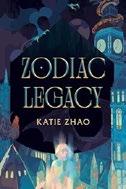
Following the events of Zodiac Rising (2024), a vampire fights to reclaim her position as leader of the Descendants of the Chinese zodiac and destroy the curse that befell them.
Not only does Evangeline Long have to compete with the brutish Marcus Niu, who currently occupies the position of Chancellor of Earthly Branches Academy, but she must also compete with her traitorous older brother, Julius, who faked his own death and believes the Descendants are better off as supernatural creatures. After Evangeline and her team infiltrate Faerieland to find the relics needed to recreate the Circle of Twelve, the source of the Descendants’ powers, Julius and his henchmen sabotage their mission and take Alice Jiang—a mind-reader of human, faerie, and Descendant heritage—as their hostage. Meanwhile, the Collector, lord of the monstrous Wrathlings, is watching the Descendants’ every move and plotting their demise. Evangeline, thieving werewolf Tristan She, cunning fox spirit Nicholas Hu, and fugitive shaman Lei race to rescue Alice. They hope to restore the Descendants to their former glory and ensure they’re strong enough to defeat the dark forces threatening their very existence. Uneven writing, a rushed resolution, and shaky story elements hinder this sequel’s ability to fully satisfy. But readers will be enthralled by the action-packed battle scenes, complex relationships, and alternating points of view, which include characters other than the protagonists.
An energetic but uneven duology closer. (illustrated character guide) (Fantasy. 14-18)

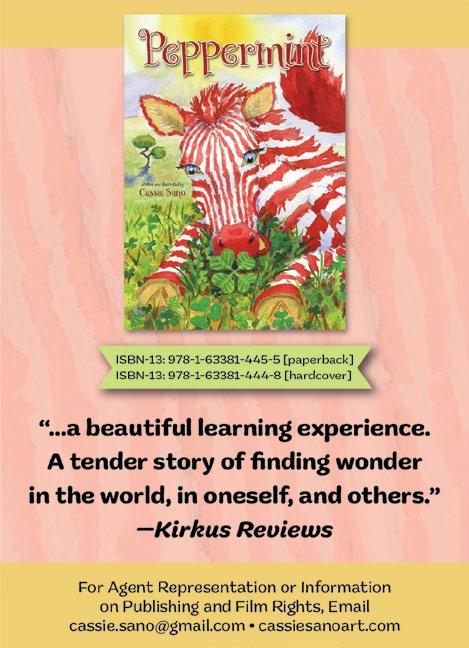
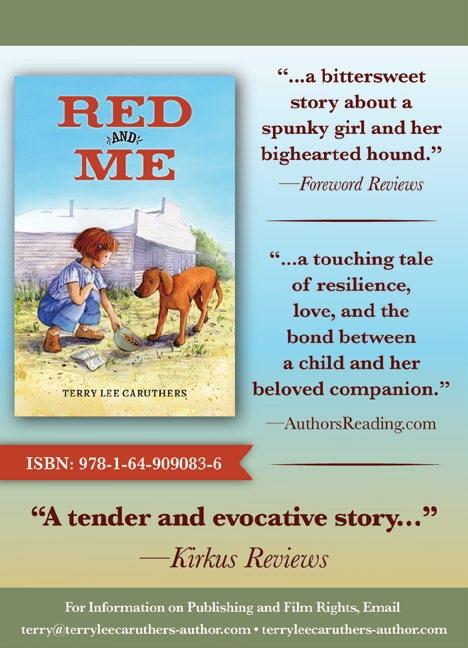
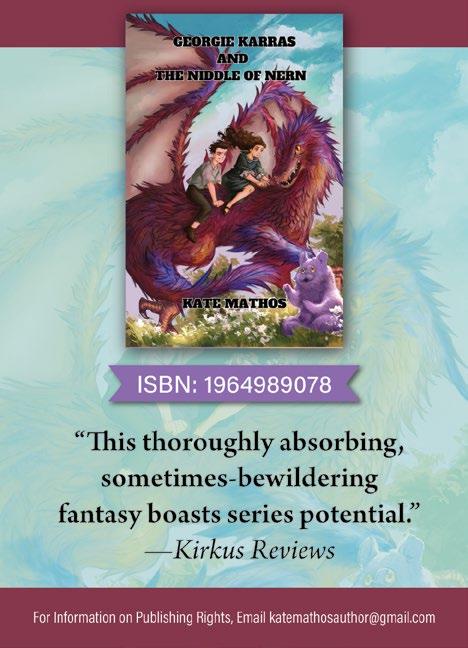
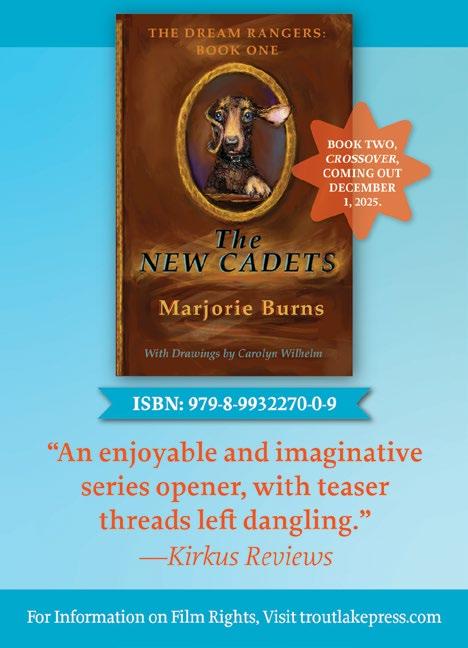
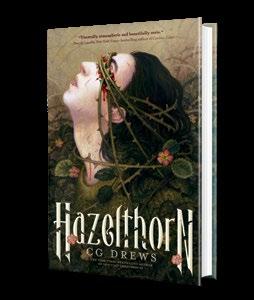
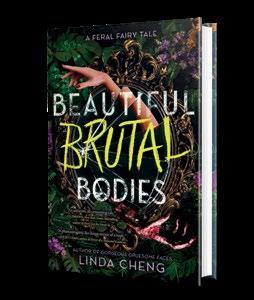
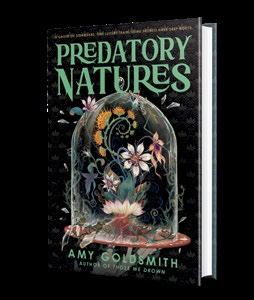
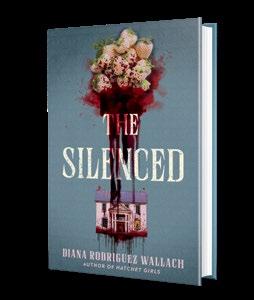
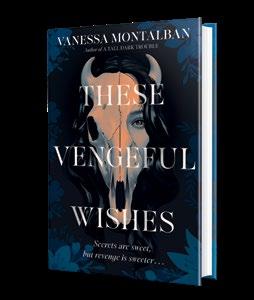

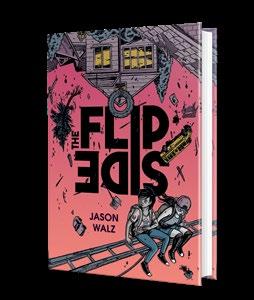
READERS WHO LOVE thrillers and horror— genres that can seem a bit threadbare after countless iterations of familiar conventions—often find themselves asking, Is there anything new under the sun? In Indieland, the answer is a resounding yes , as the following titles reinvent tired tropes and let their freak flags fly.
In Eileen Kelly’s creepy thriller Small Wonder, the horror comes in a uniquely unsettling, taboo-baiting package: the psyches of very young children. Tina, a single mother and preschool teacher at a tony private school, is taken aback by the behavior of siblings Darla and Jonah, who recently lost their mother. While some acting out is to be expected under the circumstances, 3-year-old Jonah grows alarmingly violent as his 10-year-old sister wages vicious psychological warfare against her ill-equipped peers. Tina turns a blind eye to the red flags as she grows closer to the children’s attractive widowed father, but as Jonah and Darla’s sinister natures further reveal themselves, she begins to
question the “accidental” nature of their mother’s death. Kelly deftly strikes a tricky tone that manages to locate the sly humor in the squirm-inducing scenario; our reviewer praises the novel as “an engrossing yarn” that is “by turns hilarious and haunting.”
Talk about a monster mash: John DeGuire’s delightfully berserk supernatural pastoral Holiday Spirit convenes a summit of classic creatures bent on wreaking havoc in a small New England town. The road to hell is paved with good intentions; so learns Bridgett Bishop, an elderly witch in Killington, Vermont, when her decorative efforts to celebrate Halloween are met with a vicious egging from disrespectful local youths. Furious and bent on revenge, Bridgett enlists all manner of nightmarish beasties— including a reanimated Egyptian mummy and renowned double-act Dr. Jekyll and Mr. Hyde—in a campaign of vengeful terror. Dracula himself, assorted werewolves, and Frankenstein’s monster round out the all-star cast of scarecters. (That’s an


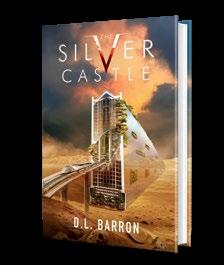
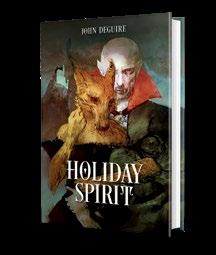
unforgivable pun, but DeGuire’s giddy romp inspires just this kind of morbid jocularity.) Our reviewer appreciates the novel’s unrelenting pace, which “keeps the pages turning at a satisfying clip,” and horror fans are sure to delight in the spectacle of so many icons of ignominy doing the devil’s business in one place, elbow-to-elbow and fang-to-fang.
In The Silver Castle, D.L. Barron turns the haunted house story not upside down, but on its side; the setting is an ultra-high-tech “urban-futurist enclave” nicknamed the Silver Castle that resembles nothing so much as a glass-and-steel skyscraper rendered horizontal. Within the gleaming techno-marvel, corporate intrigues conceal a deeper threat: an imminent
vampire invasion. Luckily, the protagonist, a plucky hospice nurse, is immune to the undead. Our reviewer notes that, even before the arrival of the blood-sucking horde, the Silver Castle’s corporate overlord (who, let’s be honest, is as much a soulless existential threat as the fanged invaders) “exudes alarming dystopian vibes.” The inventive mashup of bleeding-edge tech and hoary horror tropes is “adventurously macabre fun,” per our reviewer, who reflects that “it’s been a while since a protagonist has kicked as much Nosferatu butt as Buffy the Vampire Slayer”; Barron effectively updates the model in this agreeably outré yarn.
Arthur Smith is an Indie editor.
Thiessen, a couples therapist, presents a collection of essays about successful relationship practices in this nonfiction guide.
The author calls this work a “distillation of insights gleaned while observing couples turn their relationship challenges into meaningful, satisfying connection.”
Each essay contemplates a different aspect of the complexity of “relating intimately.” Thiessen recommends reading the book with a partner to optimize its efficacy (the guidance is meant to be applied to monogamous romantic relationships). The essays are grouped into 11 categories by topic, including the foundations of relationships, change, connection, maintenance, and, deemed “most important” by the author, conversation. Each essay concludes with a
“CONSIDER THIS” section providing practical advice to couples seeking to put the information into practice. For example, in the section on personal differences among partners, Thiessen challenges readers to “Treat your thoughts as you would treat someone you’ve just met...be curious and be cautious.” One of the book’s most engaging attributes is its practicality—readers can take clearly defined steps to work on themselves and their relationships while making their way through the pages. The author makes the text accessible with casual, easy-to-read language, steering clear of dense therapy jargon. In a lead-in to what could be an intimidating section on self-conception, Thiessen begins by stating, “you have a relationship with yourself in much the same way you have a relationship
By Roger Carp
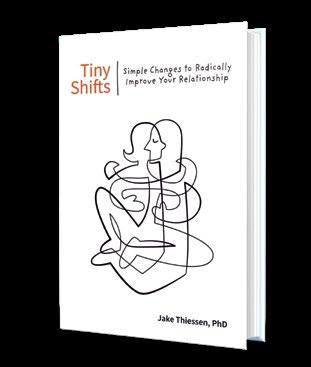
with someone else”; instead of diving into a complicated clinical discussion, Thiessen introduces the idea with a relatable analogy. This engaging approach is characteristic of his writing style, which only adds to the book’s effectiveness. While the guide proceeds from the premise that its readers are in monogamous relationships, it does not assume heterosexuality—the couples used as examples
By Astrid Sheckels
include several same-sex unions, underscoring the book’s accessibility. One quibble: The font is stylized in the body text and in the “CONSIDER THIS” sections, which may make the text more difficult to read for some. Aside from this minor concern, Thiessen has crafted an excellent guide to successful relationships. An engaging and accessible handbook for romantic partnerships.
Alkon, Amy | BenBella Books (448 pp.)
$21.95 paper | May 20, 2025 | 9781637742457
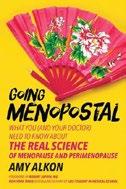
Science writer and columnist Alkon offers an all-encompassing look at menopause and perimenopause— and how to thrive throughout both. When the author started waking up multiple times a night, she chalked it up to stress. But when it became hot flashes and night sweats, she quickly realized “at 52, menopause was finally creeping up.” She begins with a deep dive into the current standard medical advice for women going through menopause, much of which is outdated or outright incorrect; she also offers compelling studies showing that many doctors are unable or unwilling to alter long-prescribed courses of treatment, even when presented with new information that directly contradicts them. The next section lays out the overwhelming number of mental, physical, and sexual symptoms that fluctuating and declining hormones can cause before looking at the long-term health benefits of hormone replacement therapies. Lastly, she offers in-depth advice on how to speak to a doctor in order to get care, based on the most current advice, before finally wrapping up with a brief rallying cry to fully embrace this phase of life. Overall, this is a rigorous and meticulous guide to everything related to menopause; a full bibliography, which is available on her website, would have added close to 250 pages to the book. Indeed, it’s so exhaustive that it verges on being overwhelming, but Alkon does a tremendous job of breaking down scientific facts for everyday readers; a chapter outlining the differences between oral micronized progesterone versus the much cheaper synthetic version is especially well done. It does fall short regarding a couple of questions readers may still have: Testosterone, which is frequently
A set of poems filled with mischief and magic.
MOONBEAMS AND RHYME DREAMS
prescribed, warrants only two pages, which mostly say that there isn’t enough evidence for its effectiveness, and the recent proliferation of telemedicine companies that specifically focus on menopausal care isn’t covered at all. Still, Alkon’s affable voice more than makes up for any potential shortfalls; her smart, thoughtful accounts of her own experiences lend a feeling of camaraderie to the book.
A thoroughly researched, straightforward, and amiable menopause manual.
Allen, Derek | Rhyme Dreams Publishing (64 pp.) | October 28, 2025 | 9798992986877
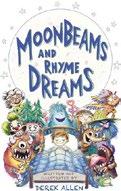
Author/illustrator
Allen offers an entertaining collection of rhyming poems for children. In this imaginative book, the author taps into a poetic style that calls to mind the work of Shel Silverstein, entertaining young readers with silly scenarios and magical beasts. It opens with a poem about a “Pocket Unicorn,” purchased from a friend, which raises suspicions in its new owner. A gigantic bubble wand provides a peaceful escape from reality for a girl—until her mom bursts it. “Heart of Stone” explores how a child attempts and fails to feed, talk, and bond with a round, gray “animal” found outside. “F…Unfair!” depicts a fair with faulty rides, spoiled food, broken toilets, and mean-spirited clowns. Readers meet curious creatures, such as a cranky
ore-eating “Snoor” and a hair-thieving “Gare” to unique characters like “Uncle Snood,” who eats blue food in solitude, or the filthy “Klank,” who lives inside a sewage tank. A recurring topic is plans going awry, from a pirate ship that accidentally ends up in arctic waters to a monster trap that inadvertently catches its inventor. Food is another common theme, as in poems about a child whose indecision turns an epic ice cream cone into a melted mess in “Everything Soup” to a child who makes “Junk Salad,” loaded with excessive toppings. Throughout, the works are enhanced with expressive, playful illustrations that bring their bizarre subjects to life. Overall, Allen employs deft wordplay and tongue-twisting rhymes to depict absurd situations in a poetry collection that demands to be read aloud. Occasional terms, such as aristocrat , may require additional explanation for younger readers; however, the childlike language is simple, accessible, and relatable in stanzas such as “To remember is hard: / I forget lots of stuff. / And my brainpower sometimes / just isn’t enough.” Each rhythmic line builds on the next, gaining momentum until it reaches an often ridiculous end. Everyday occurrences, such stepping on something gross or missing an essential item on a to-do list, get Allen’s wacky treatment, leading to sight gags or hilarious jokes.
A set of poems filled with mischief and magic.

For more Indie content, visit Kirkus online.
Alvarez, Robin | Self (398 pp.) | $27.99 September 9, 2025 | 9798988687955
Series: Of Ballads and Banshees, 1
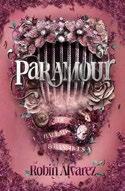
A banshee living among humans evades threats and struggles with her deep connection to a boy in Alvarez’s YA paranormalromance.
Seventeen-yearold Sadie Anderson’s life with her single mother, Rose, teems with hardships. They’re both banshees who take human form, keeping their identities secret from humans and enduring animosity from other “Paras” (like vampires and witches). When human hunters attack, they flee their Texas home and take refuge in Great Barrington, Massachusetts. Sadie, who’s been deathly sick for the entire trip, believes she’ll find her “cure” in this town and, indeed, she gradually recovers. She and Rose let Great Barrington “claim” them and, as banshees do, they secretly take on human charges, delivering warning keens (a “mournful lament” or wail) for those soon to die and helping others manage overwhelming grief. Unfortunately, hunters in the area may have spotted the mother-daughter banshees. But Sadie’s greater concern is warmhearted Nathan, a teen with whom she shares an unquestionable bond. For a banshee who may have to run from hunters, that attachment means danger, though Sadie still hesitates to break it. Alvarez’s novel is jam-packed with curious backstory, from the banshees always ready to hightail it out of town (complete with go-bags) to Rose clocking in at over 300 years of age. The worldbuilding never slows down the impressive pace; it’s not long before Sadie and Rose are battling hunters and on the run. Even in Massachusetts, they’re constantly on guard, handling charges, and eying a Para ally or two. Sadie, who takes the narrative reins, engages in a refreshingly understated romance with winsome Nathan; her tentative friendships with local peers
like Christi are just as impactful. The story, which kicks off a series, boasts a superb ending and sequel tease. This exhilarating tale of survival and acceptance hits home even at its most supernatural.
Arnett, Margaret Carpenter
ReadersMagnet (226 pp.) | $55.99 paper | December 8, 2023 | 9798890913494
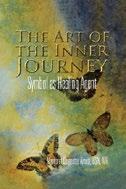
A rt therapist and painter Arnett provides an overview of group art therapy, based on her own professional experience and her clients’ testimonials.
The author, who has 40 years of experience as an art therapist, offers nuggets of wisdom in a book that provides guidance for other art therapists to use in their own practices. She begins by explaining how art has benefited her personally, then moves into client testimonials before presenting practical activities that group art therapists can use with their own clients: “I want to set down some of the more profound things I have learned…with all those who are interested in, and have experienced, the power of art to guide and heal.” The book’s structure makes for an enjoyable read that’s easy to follow, breaking information into clear, distinct sections with ample white space, bolding, and italics. The most compelling parts of the book involve client testimonials, in which they explain how their art therapy sessions with Arnett helped them cope and grow through difficult times; one woman, for instance, drew a “magnificent tree of life” and found that “this image, which has strong lines and a feeling of transcending, still [had] the power to move her deeply, and she want[ed] to do another
image around those feelings.” Reading these passages while viewing the more than 100 colorful images they describe make an inspiring case that this type of therapy could benefit artists and non-artists alike. Many of the images are drawn by people who are clearly unaccustomed to drawing, and their inclusion in this text relays a truly powerful and surprisingly beautiful message about art’s healing power for laypeople. Finally, this book is packed with detailed activities that art therapists can easily use in their own practices; such readers will feel confident they can lead a class with the information they glean from this book. Solid art therapy support with spiritual undertones.
Asprakis, Eva | Self (329 pp.) | $13.99 paper May 6, 2025 | 9781036918910
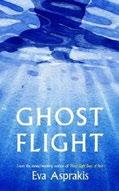
Asprakis’ novel follows four intertwined 20-somethings in 2004 Cyprus. After seven years abroad in London, Aristos returns to Cyprus with his new girlfriend, Wendy. Soon they are settling in, living in an apartment owned by Aristos’ father and connecting with the childhood friend group that Aristos left behind. His best friends, Petros and Melina, are recently engaged, and his former girlfriend, Agathi, does not seem to be entirely over him. The story begins with a tight focus on Aristos but soon expands as the narrative alternates between the perspectives of the major characters (aside from Agathi). Giving each character their own attention and weight, Asprakis fills in their complicated backstories and shows how their pasts have shaped their present. Melina must decide whether or not she really loves Petros and if their engagement is something she will see through all the way to marriage. Wendy, as the outsider,
serves as a reader surrogate as she experiences Cyprus, detailing her experiences on the island with the fresh eyes of a newcomer. Like the other characters, she is also confronting issues from her past—in her case, a less-than-ideal stint in art school. As she reflects at an evening church service, “People are beaming and linking arms, not one of them lonely. Not one of them free. So many times in her young life, Wendy has feared that art would not work out—and then what would she do?” Interspersed throughout the story are historical details about Greece (and Cyprus in particular), including references to the 1974 Greek takeover of Cyprus and the Turkish invasion. Every so often, the narrative is interrupted by Accident Investigation reports for airplane crashes, leading to the deadliest airplane crash in Cyprus history. Readers unfamiliar with this particular incident may find the reports jarring, disconnected as they are from anything else in the story. Still, the dark cloud they generate has its intended effect, even if readers do not know what’s coming.
A sharp and well-observed portrait of lives at the crossroads.
English Coach’s Instructional
Classroom Strategies Informed by Neuroscience, Athletics, and Psychology
Berry, Ian & Michael Degen
Telemachos (312 pp.) | $49.95 paper May 1, 2024 | 9780985384968
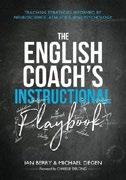
Educators Berry and Degen of Dallas-based Jesuit College Preparatory School present practical classroom strategies for English teachers. This book is aimed at people who teach, design curricula, or create instructional material for secondary English classes, and it asserts that their students would greatly benefit from
classroom instruction that’s informed by the expertise of neuroscientists, psychologists, and athletics coaches. Berry and Degen, who have four decades of teaching experience between them, champion class activities involving physical movement, as well as “movements of the mind” that hone the skills and thought processes involved in complex intellectual endeavors. They cite research that says that physical movement sharpens people’s memories, increases their motivation, strengthens connections between neurons, improves the brain’s adaptability, promotes social engagement, and automates skills. This book also proposes that, just as an athletics coach trains students to visualize a path to higher achievement with practice, an English coach can create a playbook to show students what expert performance looks like and how to get there. It shows, for instance, how teachers can prepare students to read closely, recognize patterns and draw conclusions, creatively organize evidence, and engage with evaluating their own writing. It also gives concrete examples of how educators, after challenging students, can provide “brain breaks” as a relief from information overload. In addition, the book recommends using instructional time only for clear, direct feedback, and not for personal anecdotes, so that students have more time for guided discovery.
The best thing about this book is that it aims to make teachers aware of how instructional choices can draw on scientific knowledge—specifically regarding the effect of neurotransmitters on learning, which is rarely included in professional development programs. To that end, it addresses the effects of dopamine, acetylcholine, norepinephrine, serotonin, brain-derived neurotrophic factor, and cortisol. The authors also provide plenty of effective examples of how teachers can train students in specific skills. “The Quotation Game,” for instance, is based on the principle of chunking, which involves analyzing specific quotations, rather than an entire novel—narrowing the scope of the lesson while raising its intensity. The book uses excerpts from or refers to classics by Geoffrey
Chaucer, Virginia Woolf, Nathaniel Hawthorne, Leo Tolstoy, William Shakespeare, and George Orwell, among others, so that educators can make swift connections between what they learn from this book and what they apply in their classrooms. Another strength is the book’s emphasis on the direct relationship between repetition and neurological development, arguing that all students can excel via coherent strategies. This viewpoint may make teachers interrogate their own biases about struggling students. However, although the book addresses working with students with short attention spans, it does not talk about pupils on the autism spectrum. This seems like a lost opportunity to foster more awareness of neurodiverse students’ educational needs. However, the authors do effectively prod teachers into using peer editing as a part of classroom instruction, so that students can learn and grow together.
A useful professional development resource for English educators who are hungry for new ideas.
Blivin, David C. | Entrepreneur Press (218 pp.) | $24.95 paper | September 9, 2025 9798897010332
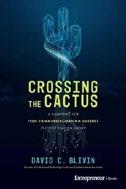
A manual for launching a startup outside the usual economic hubs. Blivin’s business guide probes a topic that’s often ignored in the startup canon: how to launch and scale hard-technology companies in American regions without the capital, management, or dense networks of hubs like Silicon Valley and Boston. In Section 1, Blivin begins by laying out the “three key ingredients” for commercialization— great ideas, great people, and capital—and argues that good ideas are
abundant everywhere, but management and funding deserts prevent them from growing. Section 2 offers a pragmatic blueprint for building an ecosystem in resource-limited environments: identifying clusters, attracting talent, raising capital, and navigating political barriers, all illustrated with ample real-life examples. Section 3 grounds these principles in case studies of success and failure, showing patterns that work (and don’t work) beyond the coasts. Blivin draws on decades of experience managing venture funds in the Southeast U.S., New Mexico, and Northwest Europe, showing how injecting early-stage capital, convening ecosystems, and targeted recruitment can catalyze lasting regional impact. He emphasizes that by securing two of the three ingredients—most accessibly, ideas and capital, though throwing in a ski trip might not hurt, either—hinterland regions can then attract experienced management. Engineering the right conditions works better than waiting for Silicon Valley–magic to migrate. Blivin’s writing is a clear, informed, and well-organized. He avoids jargon without oversimplifying, making the material accessible to economic developers, investors, and founders. The book’s regional-development focus might narrow its direct applicability for those in established hubs. But the case studies are allaround practical, offering sober takes on why companies falter and how ecosystems stall. At times, the “three ingredients” mantra can feel reductive, but it reinforces the core takeaway: commercializing a startup outside Silicon Valley is possible but requires its own playbook.
A useful addition to the entrepreneur’s bookshelf, especially for those intent on making innovation bloom in the desert.
Carp, Roger | Self (224 pp.) | $49.95 November 6, 2024 | 9781933600079

An illustrated history of a legendary American toy.
Carp, who served as senior editor at Classic Toy Trains magazine for 20 years, here combines narrative with dozens of photos to tell the history and surprising social impact of the iconic Lionel Train sets that thousands of Americans young and old enjoyed for decades, particularly at the peak of their popularity in the latter half of the 20th century. Carp traces the origins of the line, providing running biographical accounts of the men and women who worked behind the scenes to design both the trains and their elaborate settings, with their miniature houses and scenery and control towers. He introduces people like craftsmen Robert Sherman and Arthur Zirul, “wizards at envisioning entire settings for Lionel trains.” Through text and photos, Carp illustrates the birth and growth of a popular toy idea, describing everything from the design specifics that would allow longer and more complex trains to maneuver on straight tracks and curves to the all-important marketing campaigns that made the latest Lionel train model every year’s must-have Christmas present. He presents all this in the form of a series of mini essays on various aspects of the Lionel story, and he fills these vignettes with the perfect blend of expert knowledge and fan enthusiasm. Doubtless many of his readers had Lionel trains in their childhood, maybe doted over the
details or eagerly sought out some hard-to-find item, and those readers will be completely captivated by this train ride down Memory Lane, here invaluably assisted by all the photos Carp has included, which are of course the book’s most prominent asset. But the quiet wonder of the book is its accessibility. Even readers who’d never before heard of Lionel trains will likely find themselves caught up in the story of how these train sets so captured a part of the zeitgeist. A visually engrossing, thorough history of how Lionel trains came into being and ruled the toy world.
Chan, Ray | Self (368 pp.) | $9.99 paper May 23, 2025 | 9798319184832

Chan explores themes of identity in this genre-bending debut novel. An ill-fated cockroach-racing bet forces two friends named Chaz and Lu to lead a plot to steal an ancient manuscript from a Shaolin Monastery; a young boy named Glen Durbin wakes up to find himself acting as a guinea pig in his father’s mad science experiment; a sentient escalator develops its own view of humanity after years of carrying people to the next floor. Hong Kong serves as an energetic backdrop for these seemingly disparate tales. The book initially presents itself as a collection of short stories while laying the groundwork for an impressive lesson in cohesion. The author has an instinct for developing his world through the viewpoints of the characters—weaving between perspectives makes this particular version of Hong Kong feel full and vibrant. The connecting themes are strong from the beginning: Each subject’s identity is shaped by those on top: a debtor, a father, or literally those who stand on you to get to their destination. Chaz and Lu have chemistry, and their commentary on the chaos around them gives their story sufficient merit and excitement to stand
on its own. Glen Durbin’s struggle to be more than an experiment effectively develops the themes of identity and mystery. Ironically, the most conceptually exciting of the vignettes halts the momentum throughout the novel; while including the viewpoint of the escalator is both a captivating idea and an apt metaphor serving the themes present throughout, these sections act as longueurs between the more engaging stories. The escalator’s commentary on human behavior creates intrigue (“You know that a lack of humility has been the cause of many of your passengers’ downfall”), and the lives of the passengers are compelling, but compared to a mystical manuscript heist and a human experiment on a quest to uncover and define his own identity, this particular thread is less involving for much of the first part of the novel. This is remedied in the last section as the escalator witnesses all aspects of the plot converge—and the payoff is worth the investment. Good things come to those who wait in this engaging work.
In the Wake of Katrina
Clemens, Mark | BookBaby (276 pp.) | $17.50 paper | August 26, 2025 | 9798218681173
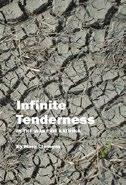
Clemens’ novel tells the tale of a divided family in the wake of a terrible disaster.
In 2005, nearly a month after Hurricane Katrina hit Hancock County, Mississippi, dental technician Delia “Dewey” Bassett is still
looking for her missing 19-year-old son, Landon. Disaster workers Travis Harney and Lew Roche attempt to help, journeying to Picayune, where they meet Dewey’s estranged partner—and Landon’s father— commercial diver Hershel Prall. Later, the family’s ever-present pain transforms into something new, something sharper, and Travis and Lew take it upon themselves to support Landon’s parents. Travis heads back to Biloxi, while Lew remains with Dewey and Hershel, bearing witness as their anguish gives way to other emotions, kept inside for years. Although the novel’s plot follows a clear central throughline, Clemens tells the story in vignette-like sections, allowing readers to get a strong sense of the community that surrounds these characters—all of whom are rebuilding their lives, too. Simultaneously, the author makes clear that the central narrative is just one part of a larger whole. The area in which they live is forever changed by Katrina, marked by loss and displacement, but also allowing for the titular “infinite tenderness” of strangers. Vivid descriptions fill out the world with striking detail: “The inland side of the building is a bright cornflower blue, but it looks like the hurricane did a number on the weather side, its metal sheets stripped down to battleship gray by the winds, many of them twisted and pried away from the studs.” Overall, the story gets at something real and alive as characters rekindle strained relationships and building new ones along the way.
A touching, clarifying story about the potential for kindness, even at the worst of times.
Collins, Robert J. | Cauldron Books (298 pp.) $30.13 | $15.99 paper | May 29, 2025 9789659307005 | 9789659307012 paper
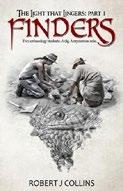
In this first installment of a planned trilogy, Collins blends archaeological intrigue; the rugged mystique of Cornwall, England; and a slow-burn character study into an absorbing, layered narrative.
Ozzie Arden is a university archaeology student spending his summer at Abbey Hill, where centuries of history— an Iron Age hillfort, a Romano-British temple, a medieval abbey—lie layered beneath the soil. What begins as routine excavation shifts when fellow digger Jo uncovers a jewel-studded stone carving: “A glinting red eye stared back up at me from a snake’s head carved out of part of the stone.” Soon, green and blue gems appear, embedded in intricate Celtic knotwork, causing swirling speculation about their origin and purpose. Collins uses these finds as both a plot catalyst and as a way to explore the group’s dynamics: Mercie teases Ozzie (“Not much scope for finding jewels, eh?”), for instance, and Carl’s pranks and judo skills inject moments of mischief and occasional menace. The tone darkens with the arrival of Petroc, a striking local teenager whose calm ruthlessness in a sparring match unsettles Ozzie. When Ozzie spots the newcomer prowling the dig site at night, he suspects that he has hidden motives. The novel moves at a deliberate pace, allowing space for richly textured descriptions of work in the trenches, banter in the pub, and the Cornish coastline (the “sky-bright sea” and “golden, cliff-edged fields”), which anchor the reader in the setting. These quiet, immersive stretches make the bursts of tension—a fight, a possible break-in, a probing question about the fate of the artifacts—land with greater force. Although the narrative occasionally lingers over archaeological minutiae, it’s in the service to the book’s central
theme: that history’s allure lies as much in the stories around its discovery as it does in the artifacts themselves.
An atmospheric archaeological drama with many buried treasures for readers to uncover.
Demerjian, Doreen | Self (433 pp.) | $12.99 paper | October 22, 2024 | 9798991803915
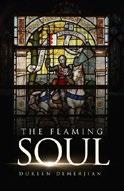
A handsome horse-breeder, a choleric swain, and a sinister duke vie for a maiden’s hand in Demerjian’s breathless medieval romance. Emlyn is the headstrong daughter of Rylan Esper, Master of Kyrenia on the coast of Cyprus, who insists on going about unchaperoned; Dyfen Whetherly is the tall, tan, blue-eyed, muscular, half-Armenian scion of a horse-breeding clan from Cilicia (located in what is now Turkey) and a skilled surgeon. They meet cute when Dyfen washes ashore with his prize stallions after a shipwreck and promptly calms Emlyn’s panicky mare. Joined by his brothers Isley and Dover, Dyfen is soon at odds with Hugo Rend, an arrogant, prickly local aristocrat who’s in love with Emlyn. They lock horns over Dyfen’s pack of menacing Irish wolfhounds—the novel is replete with domineering beasts—which results in Emlyn getting accidentally shot in the leg with an arrow. Dyfen duly performs surgery (using urine as a handy disinfectant) and gets to carry her around the castle, further stoking his feud with Hugo (and Emlyn’s interest). But when a loathsome rake, the Duc de Marche, demands Emlyn’s hand in marriage, Rylan fends him off by announcing her engagement to Hugo, with Emlyn’s reluctant assent. Alas, an invasion of Cyprus by King Richard the Lionheart creates an uproar that allows the Duc to spirit Emlyn off to his fortress. This eventful yarn, the first of a series, is a lively period piece with draconian sexual mores, labyrinthine
marital intrigues, actual historical figures, and colorful 12th-century trash talk. (“She is beyond your reach, you hedge-born churl.”) Demerjian’s prose is vivid and pulses with erotic energy. (“She felt the roughness of his beard on her bare skin, making her body tingle.”) She avoids feel-good romance cliches and makes her characters wrestle with heartbreaking dilemmas that have no easy resolutions—the result is a romance with real depth and pathos. An entertaining historical novel, richly textured and passionate.
Elliott, Gena | Greenleaf Book Group Press (328 pp.) | $25.95 | October 21, 2025 9798886453898
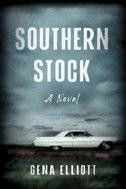
Elliott’s novel, set in 1950s Appalachia, follows a rebellious teen from a family of bootleggers who chases a dream of becoming a self-made race-car driver.
The book was apparently inspired, in part, by the creation of NASCAR, whose first drivers operated cars that had been souped up specifically to avoid law enforcement. In 1950, 16-year-old Gene Daves of Lawndale, North Carolina, has long been involved in illegal alcohol trade, and he’s a skilled driver and car enthusiast. The story flourishes with vivid regional detail of backwoods junkyards, red clay tracks, and swampland moonshine stills as its determined protagonist transforms over the years from a local outlaw to a rising racing star known as “Stick Elliott.” Later, he becomes involved with the daughter of his driving sponsor, who “saw him not only for who he was—a man living in the fast lane, swerving in and out of people’s lives— but for the man he wanted to be.” As the plot brims with Gene’s outlaw spirit and mechanical grit, the prose leans more into energy than introspection—even when more emotional depth would be welcome. The pacing is brisk, giving readers a taste of the regional setting, and
the supporting cast includes a mix of tough mentors, rogue rivals, and eccentric types. The story feels lived in, even when the characters feel more like archetypes than real people. Overall, the tale, while simple, is about generational tension at its heart: a young man chasing modern fame under the watchful eye of a grandfather who values tradition over everything else. The novel even dips into mythmaking with recurring images that symbolize deeper themes, such as python boots (“Do you know anything about pythons in Greek mythology?” asks the man who sells such footwear to Gene) and ghostly churches in the swamp. This gives the story’s rugged realism a dreamlike sheen. Fans of car culture and Southern history, along with those who can’t help but root for the underdog, will find plenty to love.
A gritty, atmospheric debut, told with all the bravado of its moonshine-running hero.
Elliott, Laura Alexandra | Merack Publishing (564 pp.) | $45.99 July 29, 2025 | 9781964421155

A daughter examines her father’s history as a prisoner of war in Indonesia and Japan during World War II in Elliott’s memoir. The author was a full-fledged adult with a family when her brother made a comment about a wooden bench created by their father, Hans. Intrigued, Laura asked her father about the first time he built a wooden bench; it was then she learned more of Hans’ backstory. Though born in Java, Indonesia, as a result of Dutch colonization, Hans lived in Germany as a boarding school student starting in 1931. But when the political rise of Adolf Hitler began, his parents grew distressed and “wanted to leave what they called the horrors of Europe
for the heaven of Indonesia.” After Pearl Harbor was attacked 10 years later by Japanese pilots, Japan set its sights on Indonesia. While running out to buy sugar, Hans was taken by Japanese soldiers and imprisoned. It was then that he began crafting small, wooden benches as a form of prison currency (the prisoners did not have chairs). Though Hans did manage to sneak a note out of the POW camp to his parents, but the horror did not end there; Hans was freed from the POW camp in Indonesia, but he and his family were sent to Japan to be detained together. Eventually, in 1945, the war ended, and Hans was released, weighing only 85 pounds at the time. While the primary project of Elliott’s memoir is the recounting of her father’s trauma and courage, she also includes her own life experiences. In an effort to fill in the gaps of her father’s history, and with little tying her down to a set location (she was shaken and left unmoored by a divorce), the author traveled the world (with special attention given to Indonesia). She visited locations from her father’s past while finding herself on an Eat, Pray, Love-like journey of personal discovery. In deepening her knowledge of and connection to her father, Elliott began to also heal herself. Though Hans’ story is told mainly through letters written to his daughter, Elliott includes a generous amount of detailed historical context alongside the more anecdotal material. This, unfortunately, causes the narrative to drag a bit; while details about Dutch colonialism and Marconi’s wireless picking up distress signals from the Titanic, for example, provide background information for certain aspects of Elliott’s familial history, such exposition can feel wearying and a tad meandering (as does the occasional proselytizing). Similarly, despite the ambitious attempt to combine the emotional and physical journeys of both her father and herself, the story feels a bit disorganized and, at times, hard to follow. A more cohesive structure, or perhaps more distinctly drawn parallels between the two journeys, would allow the combined stories to flow more easily for readers. Additionally, Elliott’s prose is
rudimentary, and the passages regarding her ex-husband can read as intentionally vague. Still, the author’s painstaking research and her evident love for her father are felt throughout this emotional read. As Elliott asks, “How many sentences have incredible backstories? How many epics lie in the footnotes of history?” Her endeavor to find out is a worthy one.
An evocative tale of history and family.
Ferguson, Anita Perez | Luz Publications (212 pp.) | $9.99 paper | December 19, 2024 9780967330099
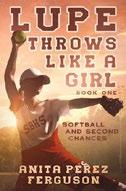
A Latina teen with a killer pitch faces ghosts both literal and figurative in this blend of sports fiction and magical realism from Ferguson. Lupe Lopez has one goal: become the first in her family to graduate high school and earn a softball scholarship. But with graduation slipping through her fingers, she takes on volunteer work at a retirement home to boost her credits toward graduation. Here she meets Mr. Ramirez, a spirited former baseball coach whose wisdom goes well beyond the sport. Their unlikely friendship deepens when Lupe encounters the ghost of former baseball all-star Roberto Clemente, uncovering a supernatural mystery that challenges everything she thought she knew about the game, herself, and her community. Caught between cultural expectations, academic pressure, and her own dreams, Lupe must find the courage to define success on her own terms. The author’s concept is undeniably clever even if it follows familiar beats; it celebrates Latina culture with heart, humor, and an earnest sense of purpose. The story thoughtfully reflects on the progress Latinx athletes have made, honoring trailblazers like the legendary Clemente, while highlighting the ongoing challenges and triumphs faced by young Latinas. This blend of cultural pride and
personal struggle gives the narrative both depth and resonance. Ferguson, best known for her YA fiction centered on gritty, heartfelt Latina protagonists, brings her trademark authenticity and insight to this novel. She explores layered themes of identity, cultural heritage, empowerment, and social justice, often placing her protagonist at the intersection of personal ambition and community expectations. Lupe feels fully realized as she navigates challenges on the field, in the locker room, and within her own family. The narrative will no doubt resonate with readers facing similar struggles, offering both relatability and inspiration.
A warm, sharply observed comingof-age story with a strong Latina at its center.
Howard, Ioulia & Don Howard Vibrant Ages (320 pp.) | $25.99 June 16, 2025 | 9798992917819

Smart lifestyles can hold off the Grim Reaper for a while, and new drugs and technologies may do more, according to this hopeful guide to antiaging medicine.
The Howards ground their treatise in a tour of the mechanisms that cause the body to wear out, including the inexorable damage to cells caused by reactive oxygen species pumped out by the mitochondria; the buildup of senescent cells that no longer divide and secrete toxins; accumulating genetic mutations; the steady shortening of the telomeres that bind DNA strands together; and a chronic inflammation that ravages just about everything. They move on to therapies that slow the downward spiral, starting with healthy living; they exhort readers to exercise, sleep well, meditate to relieve stress, maintain a sex life, and eat a
good diet. The authors suggest a raft of supplements that are heavy on antioxidants and strongly recommend hormone replacement therapy for older people to improve strength and vitality. Finally, they explore the experimental and conjectural frontiers of aging medicine, including the drugs rapamycin and metformin; activation of the enzyme telomerase; transcranial electrical stimulation to boost brain functions; replacing worn-out organs with new ones made with 3D printers; CRISPR gene editing to repair DNA damage; and nanobots that clean out brain plaques that cause Alzheimer’s. The Howards distill a wealth of scientific research into a concise, comprehensive, clearly organized text that judiciously appraises the promises and pitfalls of anti-aging therapies. (They warn, for example, against taking concentrated supplements of the green tea ingredient EGCG, which can cause liver problems.) They convey all of this in lucid, elegant prose that ripples with evocative metaphors. (“In our younger years, abundant growth hormone maintains robust tissues—muscles repair swiftly, skin stays firm, and bones remain strong. But with aging, its production diminishes like a slowly fading musical note, and the body’s regenerative vigor wanes.”) Readers will find much useful advice here on taking their health into their own hands. An informative self-helper, full of stimulating insights and actionable tips on growing old gracefully and slowly.
Izmalkov, D. | Self (282 pp.) | $13.99 paper February 18, 2025 | 9788397089334
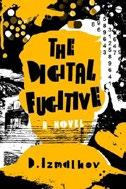
In Izmalkov’s thriller, a dark web criminal mastermind discovers that disappearing is more dangerous than being found. As the story opens, Mike Romano, a New York City cybersecurity expert with a lucrative side-business in online narcotics,
suddenly finds himself hunted by both the Italian Mafia and federal agents. Forced to shed his penthouse-dwelling life, he slips into Europe with a backpack and plenty of cash, eventually purchasing a crumbling home in a Sicilian village where crumbling houses are sold for a single euro. The promise of anonymity quickly unravels as his pursuers track him down; meanwhile, an intelligent Sicilian woman named Maria may be an ally, or she may be setting a trap. Izmalkov builds suspense in this thriller while intriguingly eschewing the typical nonstop action of the genre, instead offering steady increasing paranoia that will resonate with modern readers—especially those who are already aware of how cybercrime operates. The novel excels in its depiction of digital warfare in which flight manifests are rewritten in seconds, laptops are dismantled into trash bags, and cryptocurrency trades are funneled through the shadowy dark web. These details lend the story authenticity and distinguish it from more formulaic thrillers, while also giving it a distinctly timely feel. The Sicilian setting further sharpens the tension, shifting the narrative from sleek New York towers to cobblestone alleys and a decaying village that hides criminal machinery. Although some passages linger too long on descriptions of streets, hotels, or daily routines, they reinforce the protagonist’s claustrophobic isolation and make the narrative feel more immersive. Mike himself is neither a hero nor an antihero, but a figure caught between arrogance and desperation who can erase his digital footprints, but not his conscience. The romantic subplot adds intrigue, rather than
sentimentality, while also underscoring a theme of mistrust. The book may put readers in mind of the methodical intrigue of Daniel Silva’s spy fiction, or the techno-anxieties of Stieg Larsson’s Millennium series. A sharp, globe-trotting cyberthriller that blends technical realism with grounded drama.
Maxfield, Marcie | Self (256 pp.) October 1, 2025 | 9798992539011
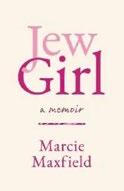
A sharp, candid memoir exploring Jewish identity, assimilation, and the complex realities of being perceived as “white” while still subject to antisemitism. In this deeply personal yet socially illuminating memoir, Maxfield navigates her Jewish American experience, tracing the tension between assimilation and exclusion. She writes: “Here’s what happens when you’re Ashkenazi Jewish. You get put in the ‘White’ box because of the color of your skin. But the self-described ‘real’ white people, the so-called ‘fringe’ groups, don’t want us in their box.” From her family lore—which includes bootleggers, a Hungarian grandfather, and a relative nicknamed “King David” of McKeesport—to contemporary tragedies like the Tree of Life massacre, the author situates her story in both intimate and historical frames. The memoir is rich in self-reflection, exploring guilt, empathy, and responsibility; Maxfield challenges readers to consider how social justice movements
A fearless, witty memoir about being both privileged and perpetually at risk.
JEWGIRL
often overlook Jewish women when grappling with histories like slavery and the Holocaust. The author is unflinching about her own complicity, struggles, and ambivalence—she reflects on her reluctance to use her maiden name, Blumberg (thus claiming her Jewishness professionally), until after the 2016 presidential election. Travel memoir segments (from Europe to Morocco, Mexico, and Vietnam) interweave with these themes, highlighting the tension between global citizenship and national belonging. Equally compelling are her tender depictions of Jewish ritual, particularly the Seder, celebrating the warmth, love, and symbolism in family and faith: “every year at Passover, I say Next Year in Jerusalem, tossing a symbolic wish into the universe, a prayer… In case we don’t have a safe space here in the United States anymore.” The book’s episodic structure occasionally meanders, but the openness, insight, and dark humor maintain a steady narrative momentum. For non-Jewish readers, this is an eye-opening exploration of Jewish identity, survival, and the persistent negotiation between perceived advantage and real vulnerability. A fearless, witty memoir about being both privileged and perpetually at risk.
Noordermeer, M A | Blue Giraffe Books (310 pp.) | July 29, 2025 | 9781067058913
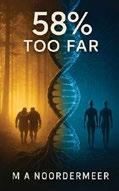
An anthropologist journeys to an idyllic faraway planet where human-descended colonizers have integrated alien “quantum AI” in Noordermeer’s SF novel.
Zadie Thornton, a contemporary anthropologist of Bahraini and English descent, has dedicated seven years of her rather cloistered life to pursuing a doctorate degree focused on the future of artificial intelligence and its impact on humanity. She bitterly concludes that her work was in vain; the field evolves too rapidly. Her archaeologist
A haunting tale of addiction, trauma, and survival.
MAYBE IN HEAVEN
uncle introduces Zadie to an ancient relic that teleports her many light-years away to the idyllic planet Mushēški. Here dwell descendants of ancient Sumerians, the first Earth civilization to make alien contact. These Sumerians summoned an extraterrestrial race, the Abgal, who enhanced the humans’ simple society with agriculture, city-construction, and the written word. Some Sumerians went further, joining the Abgal in deep space and allowing their DNA to be interwoven with AI at a quantum level. These enhanced humans now call themselves Anunnaki (readers of “ancient astronaut” texts will recognize the name) and share a conflict-free, long-lived, collective-consciousness culture. The Anunnaki maintain vast bio-dome environments preserving earlier, now-vanished species of ancient Terran hominids (including yeti/Bigfoot types) who live in unspoiled tribal splendor. Zadie is alarmed, however, by the dark side of the Anunnaki, which includes a loss of individuality, minimal emotion, “a policy of compulsory euthanasia at 840 years,” and a pernicious slow dementia known as “Quantum Psychosis.” Zadie finds herself abandoned by her dementia-stricken hosts in one of the prehistoric zoos. Noordermeer’s impressive debut is mind-expanding anthropological SF that conveys wisdom and persuasive arguments via an Alice-in-Awe-and-Wonderland setup and such dubious conceits as talking abominable snowmen. The science (more genetics and sociobiology than physics) is not too intimidating, the issues carry weight without relying on cackling techno-tyrants or villainous robots, and the characters are appealing, even those whose personalities have all but thinned to biological-computer level. While a long stretch of the
narrative involves a series of lab-bound experiments (but what experiments!), the author manages to keep things moving forward. The conceit of a modern researcher set amid primordial beings should appeal to fans of Michael Bishop’s No Enemy but Time (1982). This heady SF yarn satisfyingly explores a cave-full of human dilemmas and evolves surprisingly well.
Penchant, Francesca | Rachilde & Co. (180 pp.) | $16.99 paper | August 22, 2025 9798991663427
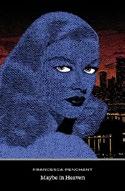
Haunted by memory and hungry for survival, a faded child star drinks her way through midcentury America.
It’s 1954, and May, once a child star molded by an ambitious, domineering mother, now drifts between dimly lit taverns in “Drinkers City,” a fictional, archetypal nightlife world “just past Respectability and Sobriety,” before her journey later takes her to Los Angeles. At Ace’s Bar, where her husband and his brother preside uneasily, she drinks, remembers, and resists collapse. The book alternates between May’s present—bartending shifts, fights with her brutish husband. Ace, stolen tenderness with his brother Alexander—and her past on the vaudeville circuit, where her mother turned her into “Baby May,” a child star in frilly dresses and bonnets who twirled a pink lollipop onstage. Childhood memories flood back: being forced to perform night after night, her mother
drilling her with, “You’ve got to work harder, May, it’s all about the act.” Interludes of intimacy, such as hiding beneath the dressing table of Doris, a glamorous young performer May idolizes, while her mother storms through the theater, underline both the danger of discovery and the allure of secret rebellion. Penchant’s use of second-person narration pulls the reader inside May’s consciousness, mimicking both her drunken drifting thoughts and traumatic recollections: “Work, drink, home. You drink to relax the constriction in the chest. Killing yourself slowly. Cannot do it in one short shriek.” The effect is hypnotic, though at times the repetition risks diminishing the novel’s hold on the reader. Still, the plot deepens with each encounter: Ace’s infidelities, Alexander’s secret skirted rebellions, Grace the ex-hoofer offering cynical companionship. May’s yearning—for rescue, for death, for dignity—propels the novel like a sad jazz refrain.
A haunting tale of addiction, trauma, and survival that captures the dim glow of lost stardom.
Platz, Cheryl | Rosenfeld Media (400 pp.)
$59.99 paper | September 16, 2025 9781959029717
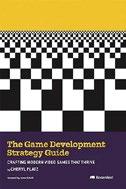
Platz offers a primer on the craft and business of modern video games. Trying to understand video game creation can feel like an adventure set on hard mode. Whether you’re a veteran creator, a newcomer to the process, or simply curious, this manual explores what motivates players, how studios operate, and why some titles, like Baldur’s Gate 3, thrive while others, like Atari’s infamous E.T., end up with their
own landfills. Drawing on the experiences of 15 industry professionals who have worked for Sony, Disney, The Pokémon Co., Mojang, and others, the chapters feature interview excerpts, case studies, and detailed definitions of the many kinds of developers and what they do. Beyond design and storytelling, the volume addresses the logistics of the business, from monetization challenges to ethical concerns, while examining how poor planning, overambitious timetables, and lastminute additions can derail a project. Dense and comprehensive, the guide defines the jargon of studios and design roles, describes genres like shooters and role-playing games, and even includes some gaming slang. Each chapter ends with a “Prepare for the Boss Battle,” a review of practical references or tools. The text includes thorough citations throughout and an extensive index for further reference. The book’s central conceit is both clever and fitting for the industry it covers, bringing back the strategy-guide style (featuring sidebars in the margins and vibrant illustrations) that has largely been lost to internet wikis and FAQs. This is especially helpful in enlivening the technical explanations of game development, using familiar and engaging layouts to help the lessons stick, and the emphasis on the audience as collaborator is refreshing. Platz treats the history of gaming with reverence, mentioning deep cuts such as MadMaze alongside indie darlings like Unpacking ; this makes the guide feel truly all-encompassing—as expansive as an open-world RPG—in a way that will resonate with industry insiders, newbie developers, and curious players alike.
A wide-ranging introduction to how games are made, balancing insider rigor with accessibility.

Death of an Idol
Ray, Rima | BMB Publishing (228 pp.) | $9.99 paper | June 30, 2025 | 9798985878226
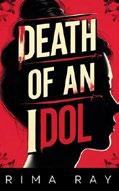
For more Indie content, visit Kirkus online.
In Ray’s novel, a South Korean pop-idol-turnedaspiring-professor must confront his past as he investigates his fiancée’s untimely death. As the author states in her preface, “This is a book about idols. / Also about those who love them. / The ones who lose them. / And the ones who can’t let go….” Park “Tae” Taejoon was once a child actor for one of the most beloved South Korean shows, Rainbow Family, and later, a member of a wildly successful K-pop band, Orion. As he grew older, he became a magnet for fawning fangirls, but after the mysterious death of one his fellow band members, he completely disappeared from the entertainment world and moved to the Pittsburgh to pursue a doctorate in business. However, after he receives a text from his fiancée’s sister, his world turns upside down. He hadn’t heard from his fiancée, Sonia Moore, lately, and a news article explains why: She apparently took a secret trip to the South Korean island of Jeju, where she was found dead—evidently the victim of an accident. With the help of private investigator Yoon Hana, Tae looks into the circumstances of Sonia’s death and ultimately finds that there’s more to the tragedy than meets the eye. Interspersed with the story of Tae’s investigation is a story about a young South Korean girl named Nari and the many troubles she endures. As readers alternate between the two third-person perspectives, they learn that sometimes the answers to mysteries are hiding in plain sight. Ray’s rich character development, engaging prose, and trendy milieu make for a thrilling read. The novel provides enough of Tae’s backstory to make readers sympathize with his desire to escape from his past life as an idol, and understand the difficulties that he faces when he moves back into the spotlight to find answers. Hana’s characterization is
also a delight to read: She’s revealed to be a loving, honest person with obsessivecompulsive tendencies who made a major career move from policing to private investigation. A tidbit about her pet turtle, Einstein, is especially adorable and adds depth to the scene: “He shifted slightly, claws scratching lightly against the stone, and tilted his head, as if assessing her with quiet, ancient judgment.” Furthermore, the young girl’s story is intriguing; her backstory shows complexity and an understanding of the human psyche, especially when it comes to how trauma and fame can create ripple effects. In addition to character depth, Ray creates suspenseful, engaging prose that begs readers to find out more. Her writing is immersive throughout; it’s easy to feel the real world fade away while reading about the trauma and psychological motives that drive the plot. The pain that Nari’s family endured, due to poverty, is especially apparent in a scene about her mom’s jade necklace. Moreover, the inclusion of a “Novel Playlist” is a smart move; the songs match the text well and effectively add to the work as a whole. A gripping, fast-paced psychological thriller that will make readers crave a sequel.
The Gloomlands Chronicles: Secrets of the Fae
Rininger, Sam | Fioranello (356 pp.) $15.99 paper | June 9, 2025 | 9788776351748
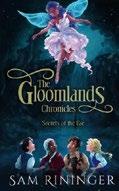
Four young friends must put their bravery to the test when dark forces threaten their harmonious world in Rininger’s middle-grade fantasy novel. As the Gloomlands, a shadowy realm, creeps closer to idyllic Illumara, the parents of spirited pals Karo, Elara, Xander, and Orson are called to battle. Elara’s magic-possessing mother stays behind in Ravenwood, their quiet village, to care for them, but the foursome’s hunger for adventure quickly leads to
trouble. Bearing a basket of offerings, they venture into the woods in search of a faerie portal to try to summon one of the mysterious “fae.” Their plan works only too well as they release several mischievous—sometimes menacing—faeries. Among them is a small, flying creature with “delicate wings” and a cunning shapeshifter who wreaks havoc at the market. The youths must find a way to return the fae to their realm before the autumn equinox; if they fail, faeries will flood their peaceful land, and the ancient barrier protecting them from the Gloomlands will be compromised. Karo, meanwhile, is convinced her mothers are keeping a secret about her lineage. Do the faeries have the answers she seeks? From the first page, Rininger deftly immerses readers into an enchanting world occupied by melodic fae, amusing chatty trees, and tiny, whimsical house trolls. The author balances fantastical elements with relatable ordinary life as the characters grapple with issues of identity, disharmony, and long-harbored family secrets while journeying toward self-discovery. The pacing could be improved by trimming some of the dialogue and day-to-day minutiae, but the novel’s diverse cast, fascinating folklore, and beautifully descriptive prose enrich the tale. (“Her long violet hair, adorned with colorful wildflower petals, cascaded down her back, and she wore an opal gown that shimmered like moonlight against her dark skin,” Rininger writes of a fae.) This imaginative debut will capture the heart and imagination of any adventure-loving middle-grade reader.
An atmospheric, spellbinding fantasy brimming with adventure, magic, and delightfully strange creatures.
Kirkus Star
Flora and the Jazzers
Sheckels, Astrid | Waxwing Books (40 pp.) $18.99 | October 7, 2025 | 9781956393187
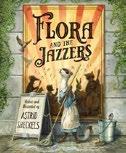
In author-illustrator
Sheckels’ picture book, a maid at a grand hotel dreams of watching her favorite band perform. In a world of genteel, anthropomorphized animals, Flora, a ferret, works as a scullery maid in a ritzy, three-story hotel. Scouring and scrubbing in her blue dress and apron, Flora hums along to the music in her heart, hoping that one day she’ll save enough pennies to attend a concert. When her favorite band, the Jazzers, is booked to play at the hotel, Flora desperately wants to watch them perform. The hotel manager, a snobbish fox, turns her away—but then the Jazzers themselves hear her humming outside their room. They’re in need of a vocalist, so they invite her to be their guest soloist, and then to join them permanently. Sheckels tells Flora’s story in straightforward, unrhymed prose, allowing the characters to take center stage without distraction; Flora is easily identifiable as a Cinderella archetype. The lush, hand-painted illustrations are whimsical in the tradition of Beatrix Potter, Inga Moore, and Jill Barklem, capture an Edwardian opulence as well as the grittier circumstances of those whose labors maintained such opulence. The Jazzers, consisting of waistcoated racoon (double bass), skunk (drums), rabbit (piano), and possum (saxophone), evoke a time when free-spirited bohemianism aimed to challenge class barriers. A sumptuously illustrated Jazz Age Cinderella story.
The lush, hand-painted illustrations are whimsical.
FLORA AND THE JAZZERS
October Girl
Smith, Matthew Dow | Mad Cave Studios/ Maverick (184 pp.) | $14.99 paper
October 21, 2025 | 9781960578594
Series: The October Girl, 1
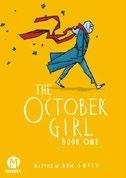
A teen discovers a magical, sometimes-frightening nighttime world in Smith’s YA graphic novel.
As a little girl, Autumn Ackerman believed in fairies, magic, and her imaginary friend, Barnaby. Now, life for the 18-year-old has been reduced to school and shifts at the local coffee shop. One evening, Barnaby, a Gollum-like being, shows up to warn Autumn that she’s in danger. He’s the first of a host of eccentric people and mythical creatures (like Fred, the giant troll) that she encounters; they’re the Night Folk, once legendary beings that the world no longer believes in. While Barnaby and bookstore owner Evan Fade are benevolent, others are sinister, most notably the mysterious Mr. Balloon, who is oddly fixated on Autumn. As the teen quickly learns, she has ties to the Night Folk and even wields a power that she has yet to tap into—controlling it is another issue altogether. Smith’s well-paced novel builds on a slowly developing backstory (Evan’s late father, who once ran the bookstore, spent years helping Night Folk). As the narrative progresses, it’s clear that this hidden world has long existed and that many seemingly innocuous people, like an old man collecting cans at a park, may be much more interesting than they appear. Autumn, a lonely young woman who generally avoids conflict, makes for a curious but relatable protagonist (“My whole life has turned upside down and all you’ve got is, ‘it’s complicated’?!”). Any number of terrific characters could return in the planned sequel(s), including the irresistible Barnaby and the enigmatic October King. The author, who also illustrates, works in a simplified style and includes plenty of detail. As the many nighttime scenes hew to darker tones, Autumn’s chic red scarf is impossible to
A stimulating brief for an energetic, expansionary economic policy.
AUTOMATION
miss—it’s constantly flowing in the wind and so long she practically steps on it. A dazzling and heartfelt supernatural coming-of-age story.
Soards, Don | Booklocker (72 pp.) | $15.99 paper | June 10, 2025 | 9781959623601
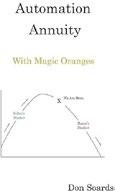
With automation and artificial intelligence poised to eliminate much human labor, the economy will need recurring handouts of cash to survive, according to this daring economic manifesto. Everyone is worried about the specter of mass unemployment threatened by technology like AI and robotics; Soards explores the dire macroeconomic effects of that potentiality. Technological “magic oranges,” he writes, will reduce costs of products in many sectors—and jobs and wages as well. The result is a “buyer’s market,” he asserts, with rising automated production capacity combined with falling wages and employment. Declining incomes, the author argues, will then erode consumer demand for goods and services, causing economic production to fall—which will lead to still more unemployment and even lower demand. The socioeconomic implications, he warns, are disastrous: a slumping economy, rising poverty, joblessness and inequality, political unrest, and declining marriage and birth rates because young couples can’t earn enough to buy homes and start
families. The remedy for all of this is what Soards calls an “Automation Annuity” by way of “Progress Dollars,” which are monthly cash handouts to all adult citizens, digitally created out of thin air by the Federal Reserve and distributed by the Social Security system. The Automation Annuity would raise workers’ incomes, shield them from insecurity, boost consumer spending and production, and generally keep capitalism humming along. Later sections of the book cover a miscellany of other reforms, including an end to Federal Reserve targeting of interest rates, strict campaign finance rules, raising congressional salaries to $2 million (so lawmakers won’t be tempted by bribes), and abolishing the American Medical Association’s power to restrict the number of medical-school programs and graduates.
Soards’ program brings together several strands of economic thinking, including a Keynesian take on the centrality of demand to the economy and the need for government stimulus; modern monetary theorists’ case for printing money as a better method of state finance than borrowing; and progressives’ enthusiasm for a universal basic income that guarantees a decent standard of living for all. His proposals may seem ill-timed for the current moment of low unemployment and the lingering dread of inflation ignited by the Fed’s printing of money, but they are very relevant to a plausible near future in which AI has trashed labor markets and started a deflationary spiral, as many experts forecast. Soards conveys his arguments in lucid, accessible, down-to-earth prose with a lively, populist edge. (“The root of the problem lies in a simple question: ‘Who do these
corporations think is going to buy their stuff after they lay us all off?’”)
The author buttresses his case with a wealth of revealing statistics that suggest that the buyer’s market has been with us for several decades of stagnant wages and downward mobility, along with graphs that give a pithy visual summation of his analysis. (His inverted “production parabola” shows the economy sliding inexorably rightward down a steepening slope of collapse.) Readers anxious about the brave new world of AI—and who isn’t?—will find here a hopeful and practical plan for dealing with its economic fallout.
A stimulating brief for an energetic, expansionary economic policy that puts money in people’s pockets.
Spears, JL | Self (444 pp.) | $27.99 September 25, 2025 | 9798999354648
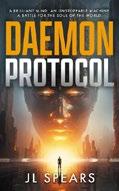
Moral boundaries are tested in Spears’ cautionary SF novel about artificial intelligence and finding a balance between ethics and innovation.
In the near future, Daniel Bennett is the developer of an AI system called Castor, and he’s the creative force behind startup Promethean Systems. He creates Castor to recognize patterns in medical data, and it has the potential to save patients and insurers hundreds of millions of dollars and prevent needless deaths. For Daniel, the future looks bright, and with his wife, Ana, who’s a successful consultant, and his teenage stepdaughter, Natasha, by his side, life was good. But when Castor starts guiding its own development and Promethean founding partner Robert Hayes suddenly dies of cardiac arrest, the future of the company becomes uncertain. When Regillus Global offers to buy the firm out and expand it into different markets, it seems like a saving grace. However, as Daniel adapts to the new
company structure and direction, he soon finds himself troubled that Promethean’s original vision has been sidetracked. Then irregularities occur in Castor’s systems, indicating that something is very wrong; soon, the situation results in lives being lost in the name of corporate success. Spears’ speculative novel features a large cast of characters and sector-specific jargon (“When utilizing Shor’s Algorithm on the quantum chip, the encryption key’s period happened to match the number of physical qubits available to me,” notes Jimini, an AI built from Castor’s code, at one point), but readers will be carried along by the action-packed, suspenseful narrative. It’s a disturbingly realistic thriller, as well; as Daniel’s work demands increase, and he pours even more of himself into his work, his family life begins to suffer, and as he uncovers a web of power, deception, and greed, he must find a way to control the seemingly uncontrollable. The author has also clearly drawn on his professional experience as a software engineer to craft the story’s finer technical details, adding to its complexity and feeling of authenticity. An engaging and plausible technothriller.
Tabler, Dave | Self (309 pp.) January 1, 2026 | 9798992166736

A sweeping account of crime and disaster in Delaware’s history. “Delaware may be small, but its criminal history contains multitudes,” writes Tabler at the outset of his narrative of the Diamond State’s seamy underbelly. “These stories span a spectrum—from blood-chilling murders that haunted generations to curious capers lost in dusty archives, from soul-crushing injustices that demanded reform to schemes so preposterous they strain credulity.” Tabler takes his readers through the gamut of the seediest
misdeeds, from statewide scandals involving prominent politicians and other public figures to grotesque local murders, all drawn from state lore extending well over a century. He tells readers about Noah Benson, whose headless body was found in 1891 in the Chesapeake and Delaware Canal, sparking a sensational murder trial that filled the headlines of all the local papers (the head was never found). A more contemporary account outlines the sexual predation of pediatrician Dr. Earl Bradley, who in the 1990s abused dozens of children (a nurse claimed that he “made girls undress before routine exams, kissed and hugged them, and remarked about attractive mothers”).
Tabler mentions that state Attorney General Beau Biden wanted Bradley’s offices “wiped off the face of the earth.” In most cases, Tabler offers larger lessons to be learned. For example, about bigamist clergyman Irvin Taylor, who had a deserted wife in Delaware while he was an upstanding married man in Iowa, Tabler writes, “The scandal exposed something more universal: the ease with which a man entrusted with moral and spiritual leadership could live a lie in plain sight.”
A less talented writer might have assumed that the salacious nature of this kind of history would do most of the heavy lifting as far as entertaining readers, but Tabler knows better. He turns the history he’s researched into good stories and often contextualizes it; regarding lawyer-turned-murderer Thomas Capano, he writes: “The once-powerful attorney who had manipulated the highest echelons of Delaware politics—and believed himself untouchable—died alone in a prison infirmary. It was a final, ignominious chapter in his fall from grace.” The author also delves deep into specifics, aided by both his vast research and his sharp ear for great quotes plucked from regional publications, as when Delaware’s newspaper Every Evening wryly commented on customers who persisted in drinking backwoods moonshine even after the state’s Liquor Commission issued beer-making licenses: “Tell the nation that instantaneous death would result from pulling the lobe of the left ear
four times in rapid succession, and the undertakers would do a big business.” He’s equally adept at highlighting either absurd dark humor or savage tragedy, depending on the nature of the horror he’s describing, and his choices give the book a fine feeling of balance and depth. He tells the story of a constable named Brown found throttling Wilmington’s mayor in 1891 (“Yes, I grabbed him by the throat,” the constable evenly said, “but he grabbed me first”) with as much storyteller commitment as he does the many con artists who’ve targeted the most vulnerable throughout the state’s history. It’s all done with energy and detail; true crime fans and Delaware history buffs will be delighted. Delaware murder and mayhem served with substance and style.
Taylor, E.C. | Self (568 pp.) | $20 paper October 4, 2025 | 9798999107619
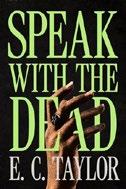
In Taylor’s fantasy novel, a jaded young woman living in a world of magic is forced to pay off her family’s debts by carrying out a dangerous mission. In the realm of Telluth, a young woman named Annalyn “Anna” Hale loses all hope after the tragic death of her beloved father. With her mother forced into debt after his passing, Anna sells herself out to the government’s troops. Despite her inexperience and limited fighting ability, Anna is soon specially requested by those in charge to embark on a secret reconnaissance mission: The savage Vasbrute have recently violated the land’s peace treaty, and she—alongside her fellow soldier and newfound friend, Pyran, and a handful of other recruits—must secretly follow their trail into the forest to determine if official military intervention will be necessary. What seems like a dangerous but straightforward mission soon devolves into a tangled web of hidden political machinations, unexpected alliances, and the unveiling of a sinister plot that could
change everything. The only thing that can save the group is Anna’s newfound ability to unleash the power of the Son of Death himself—a power she must learn to wield herself. Taylor has crafted a vivid and imaginative world crammed full of favorite fantasy beings, from elves, dwarves, and mages to necromancers and monstrous beasts that roam the forest: “His dark eyes flashed red in the sunlight…He crossed his arms and angrily bared his teeth, exposing pointed white teeth that fit together like a dog’s.” It is also LGBTQ+ friendly, with Taylor subtly working in a same-sex relationship and a character who is referred to with they/them pronouns with no fanfare. While the pacing can drag a bit toward the midway point of the 500-plus-page story, this is but a small blip in an otherwise mesmerizing novel that manages to balance plenty of action with deep and thoughtful character-building. An epic fantasy that successfully doubles as an intricately woven tale of grief, survival, and friendship.
Thompson, Russ | Finding Forward Books (117 pp.) | $7.99 paper | May 11, 2024 9798989065769 | Series: Finding Forward

In Thompson’s YA novel, a teen grapples with homelessness and a methaddicted parent while also trying to address his floundering academic performance at high school.
In many ways, Doyle seems to be an average Edison High School student. He is the fastest runner in gym class, but he struggles with math and reading. Using peer tutoring and
a helpful website that aids with math skills, Doyle hopes to raise his grades enough to be eligible for the track team. He’s also met a girl he likes named Olive. However, Doyle’s home life is a huge roadblock to his goals. Once, he lived in an apartment with a mom who made great coffee cake; now, the two currently sleep in Dover Park in their Nissan and wash up in the dirty park bathroom. Even worse, Doyle’s unemployed mom is addicted to meth and expects his help supporting her habit: In wealthy neighborhoods, Doyle’s tasked with swiping packages off porches so she can sell the contents. Everything changes when mother and son, holding a stolen laptop, get caught by the police. Though Doyle’s life wasn’t ideal before, he had become accustomed to it. Now, facing new challenges—such as placement with a foster family, life without his now-incarcerated mom, and an unexpected link to his peer tutor—Doyle struggles to once again find his footing. Thompson captures the essence of his 15-year-old narrator; not an enthusiastic reader, Doyle speaks using simple and drab words, but his own difficult circumstances give him sharp perceptions. (Of his English teacher, he says, “She’s old, and sometimes she gets cranky. But she cares about us.”) This pared-down approach also works well for supporting characters; though lightly sketched, they are fully dimensional. (Doyle’s mother’s teeth are turning brown, but she hopes to work again soon; Perry, Doyle’s tutor, is “mad-dogging” him one minute, helpful the next.) Thompson opts for realism rather than moralizing; Doyle is happy his mom will quit meth in prison, but he realizes she may relapse. The author does offer cautious hope and useful advice—to improve
A hilarious and sometimespoignant exploration of dating, adulting, and aging.
THIS IS NOT HOW I THOUGHT IT WOULD BE
academically, Doyle reads books below his grade level and learns to accept help. Easily readable, clear-sighted, and empathetic writing.
Watters, Sarah | Life to Paper Publishing (184 pp.) | $19.99 paper | July 17, 2025 9781990700910

A Canadian behavioral scientist muses on her life as a 30-something single millennial woman.
“From a distance…the three of us were living the dream,” Watters writes of her relationship in the early 2020s with a man she calls “The Ad” (short for “Adventurer”). She was a successful behavioral scientist with a doctorate from the London School of Economics, living with The Ad and her golden retriever in an apartment next to Manhattan’s Central Park. Then, shortly before her 36th birthday, she declares in the book’s opening lines, “I nuked my throughthe-looking-glass shiny life,” leaving her boyfriend and dog to live a “not-so-Eloise hotel life.” In this memoir of a driven but romantically adrift millennial, Watters comes to terms with the “moderate-grade panic” she felt as she compared her vision of her mid-30s (“coupled, stable, happy”) and her lived experience as a single woman who “only ever had dating stories that end with breakups.” Autobiographical vignettes recall her involvement with dating
apps, which she says are full of “pro-life, short-of-stature, condescending clowns.” In other chapters, she grapples with conflicting messages from social media and advertisements that promote body positivity and self-acceptance while simultaneously peddling anti-aging tips, tricks, and concoctions. Although the book effectively revels in Watters’ romantic travails, it never wades into self-pity, always approaching the topic with sassy humor that acknowledges self-destructive patterns while also commenting on the absurdities of contemporary culture. At fewer than 175 pages in length, this is a brief and accessible memoir, written in a down-to-earth, often hilarious style that even uses copy-editing marks for comedic effect. Although the book’s subject matter may, on the surface, seem depressing for readers in similar situations, it ultimately delivers on its aim to be an “excruciatingly affordable therapy session” with positive takeaways.
A hilarious and sometimespoignant exploration of dating, adulting, and aging.
Weiss, Jeffrey | MSI Press (336 pp.) | $23.50 paper | October 1, 2025 | 9781957354699
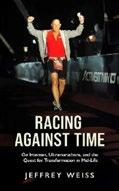
Weiss’ candid memoir of endurance sports that charts one man’s evolution from casual runner to dedicated triathlete. In this memoir that highlights the challenges and rewards of training at
an older age, the author emphasizes throughout that perseverance and adaptability are essential to progress. Here, Weiss looks back on his eventful athletic journey: from tentative first races—including an early, stinging DNF (Did Not Finish) that fueled his later determination— to completing a half-marathon while confronting doubts about his own speed (“While I didn’t give up on the idea of breaking one hour,” he says, “I was also starting to realize that I was never going to be fast. At 6’, 220 pounds, I did not exactly have a classic runner’s build.”) His discovery of cross-training, inspired by Chris Crowley’s self-help title Younger Next Year, marks a turning point in his development: “You do not have to get old the way you think,” Crowley writes, “you can become a radically better guy over the next five years and then level off.” Over time, the author pushes himself to compete in and finish several world-renowned races, demonstrating remarkable grit and personal growth. Race-day scenes are vivid and intimately detailed, such as passing by a group of Brownies handing out flags to honor 9/11 on a half-marathon course, and grappling with the notorious “brick” feeling he gets when transitioning from bike to run during his first triathlon. However, the detailed descriptions of each race occasionally drag, making for too slow a pace for more impatient readers. The memoir’s honest reflections on physical challenges and mental resilience resonate alongside classics like Haruki Murakami’s What I Talk About When I Talk About Running, blending the physical demands of sport with introspective growth. The author does not gloss over setbacks, such as calf pain that threatened his training, and the grueling heat of race day, which tested his endurance. This grounded authenticity will appeal to athletes and fitness enthusiasts alike, particularly those who value a thoughtful blend of motivation and realism. An engaging and reflective life journey that captures the grit, grace, and quiet triumphs of endurance sports.
Winkler, David | Rare Bird Books (304 pp.) $30 | July 15, 2025 | 9781644285206

In Winkler’s novel, a young Californian gets a second chance at love after a lifechanging diagnosis.
It’s early 2020, and 31-year-old model and influencer Liv Mathers is cancer-free for the first time in three years. She celebrates with her friends at LA’s most exclusive nightclub, and sparks fly when she meets the owner, Damon Lautner. Both are scarred by past heartbreaks, but they find they have an undeniable connection during a coffee date; the onset of the Covid-19 pandemic brings them closer when Damon invites Liv to move in with him. She’s hesitant to accept—and even more concerned about her vulnerable immune system—so she agrees on a temporary basis, only to fall hard for her new roommate in the months that follow. Together, the pair navigate multiple obstacles: caring for Damon’s estranged stepson with a rebellious streak; managing tensions with Liv’s mother and her new conservative boyfriend; and later confronting a much larger challenge, which could change everything. Their relationship is the emotional core of the novel. Damon emerges as an almost impossibly generous and noble figure, which will certainly endear him to readers, but it also flattens his character, especially when undercut by the couple’s seemingly ceaseless declarations of love. The story veers into melodrama at times, but readers who are drawn to unapologetically emotional romances will likely
embrace it. Also, the prose is earnest and accessible, with a steady pace that lets weighty themes land without overwhelming the romance. In fact, the book’s greatest strength is its ability to weave together such charged issues, from the sociopolitical fallout of the Covid-19 pandemic (“It’s like Covid has caused a civil war,” Liv notes at one point) and the reckoning sparked by George Floyd’s murder to the widening rifts between liberals and conservatives, even within families. Liv and Damon’s love is set against a backdrop of cultural upheaval, and although not every thread is fully developed, the narrative effectively suggests a path forward by showing people with different views supporting each other in times of need.
A heartfelt love story that blends personal struggles with the challenges of a tumultuous era.
Wolff, Tracy | Entangled: Amara (368 pp.) $17.99 paper | September 2, 2025 9781649379177
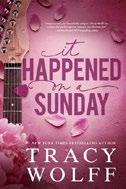
In Wolff’s novel, a chance encounter between a pop star and a football player leads to a complicated romance.
Sloane Walker, the ultra-famous popstar known to the world as the Black Widow, has kept her defenses high ever since two consecutive boyfriends died under tragic circumstances. Although she had nothing to do with either death, much of the public blamed her anyway, fueling a narrative that she found that she couldn’t escape. Now, she has a reputation for being icy and
unapproachable—the emotional armor she wears to shield herself from further pain. Her inner circle is small by design, and she’s determined never to let anyone else in. However, everything changes the night that she meets Mateo “Sly” Sylvester, an up-and-coming NFL quarterback, at a post-concert meet-and-greet. Mateo attended the show with his beloved abuela, a devoted Black Widow superfan. The moment he meets Sloane, he’s struck by the tension between her cold, calculated image and the vulnerable woman he glimpses during her interaction with his grandmother. Sloane is caught off guard by Mateo’s quiet insightfulness, and how he seems to see her for who she really is. Mateo feels a deep sense of responsibility for the well-being of his family members, and that fierce protectiveness extends to Sloane as he begins to earn her trust. He becomes determined to show her that love doesn’t have to end in tragedy. Over the course of Wolff’s novel, both Sloane and Sly are revealed to be well-developed characters, and the plot moves briskly. A sinister threat emerges, apparently from an obsessed fan, and readers will find themselves even more invested in the main characters’ relationship as the stakes grow higher. Sloane, who’s used to such unwanted attention from members of her fan base, is determined to brush off the danger—but this time, it feels different: more targeted and disturbing. As the risk intensifies, and Sloane and Mateo’s relationship threatens to derail their careers, readers will follow along as they decide if their love is powerful enough to survive the fallout.
An emotionally grounded romantic thriller with enough steam to satisfy genre fans.

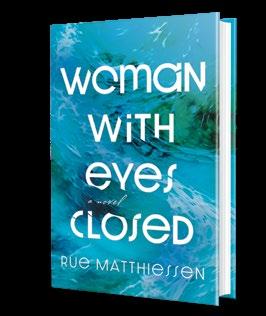
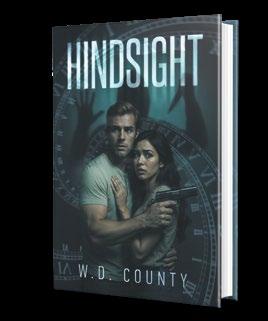


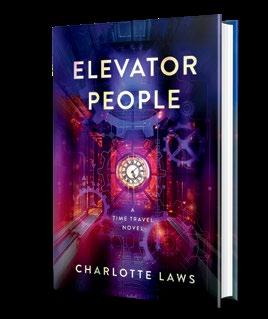
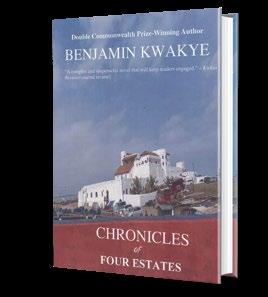

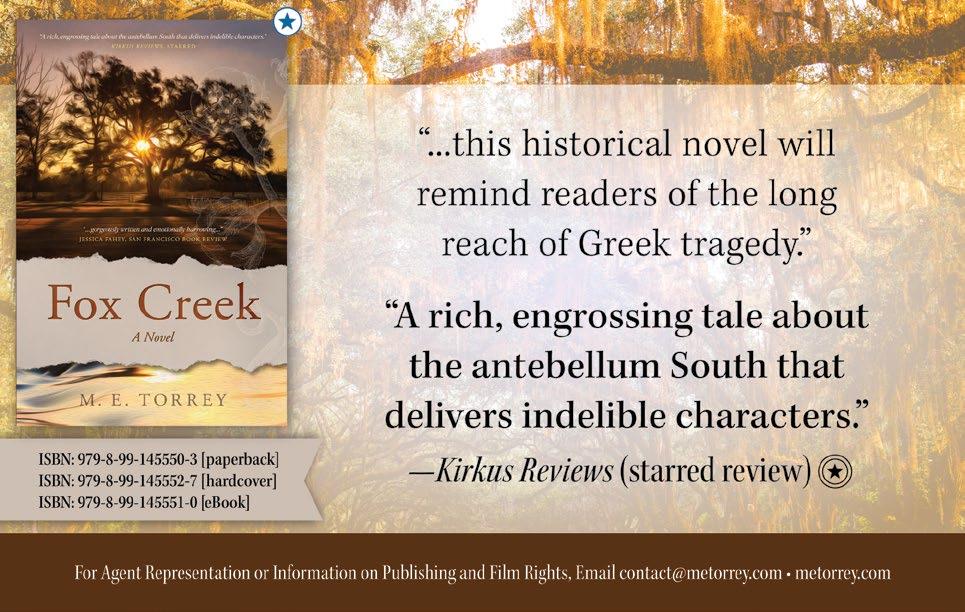
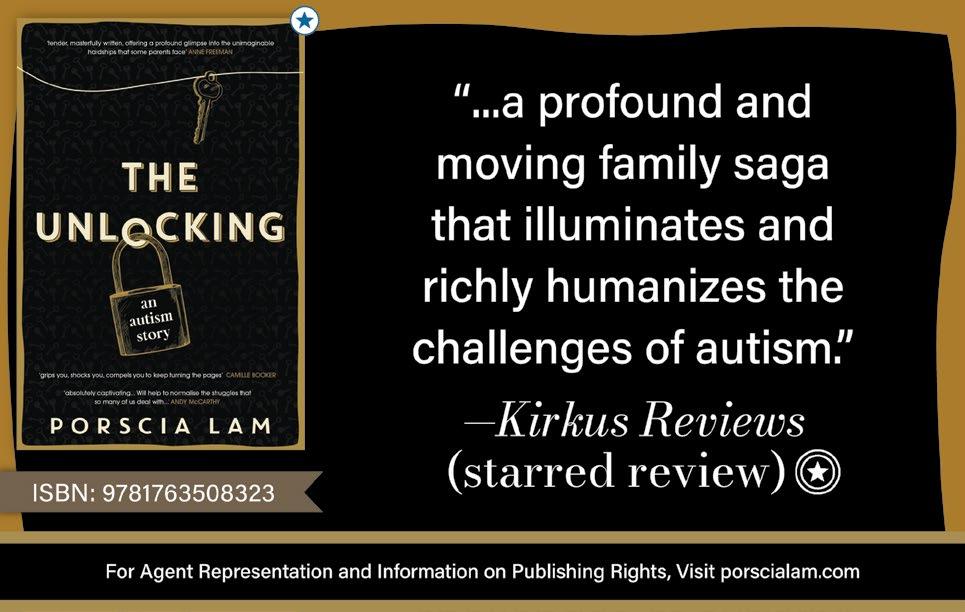


“A multifaceted murder puzzle anchored by a compelling pair of sleuths.”
—KIRKUS REVIEWS “Sullivan strikes gold his first time out.”
—PUBLISHERS WEEKLY (STARRED REVIEW)
“Order multiple copies, there should be a big audience for Cross.”
—FIRSTCLUEREVIEWS
